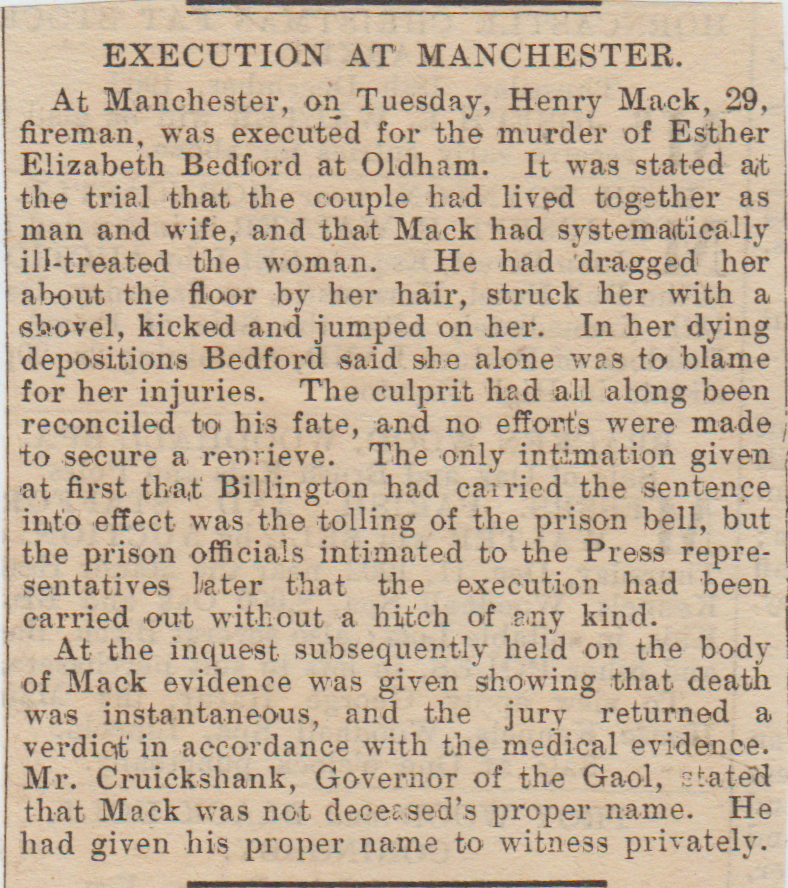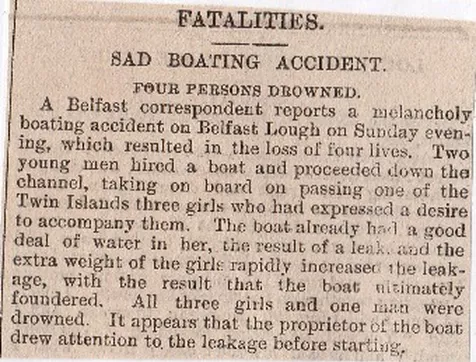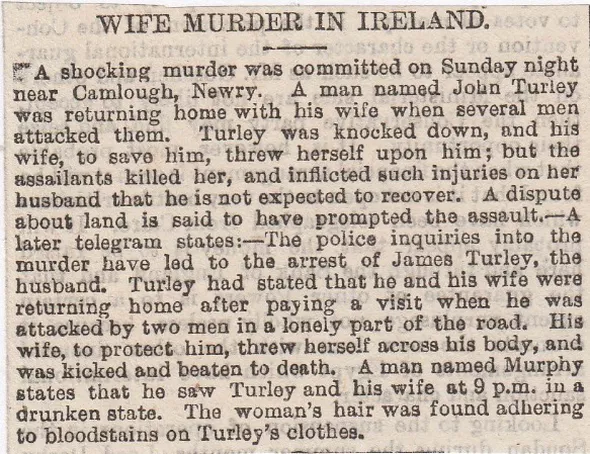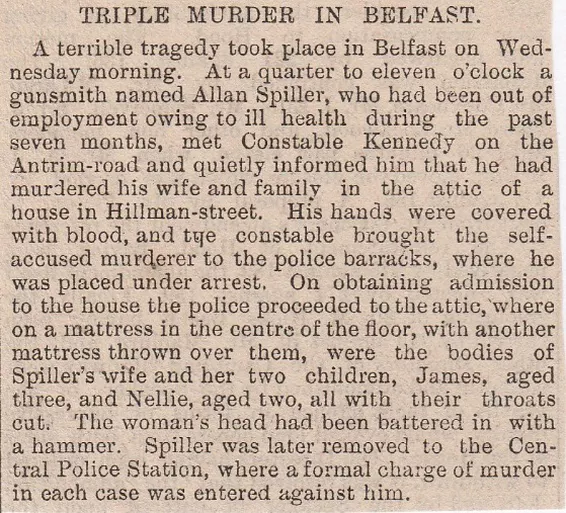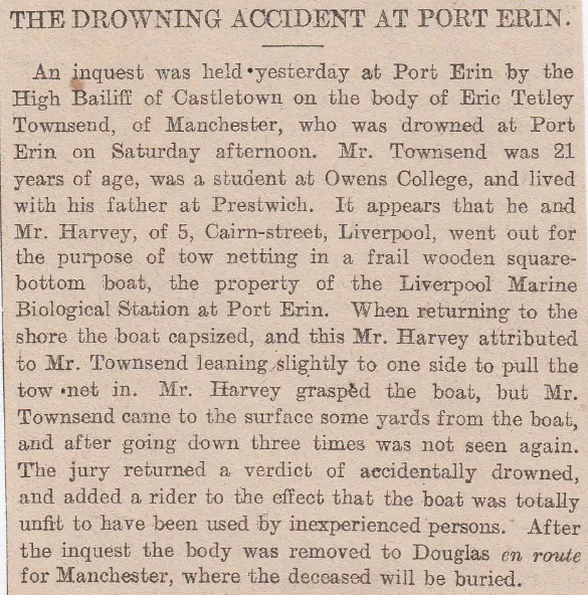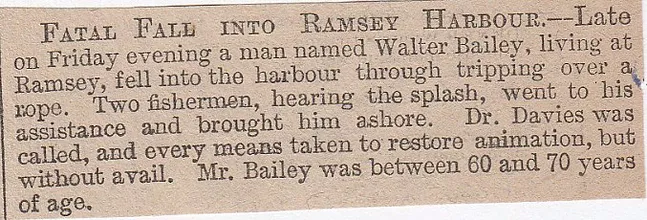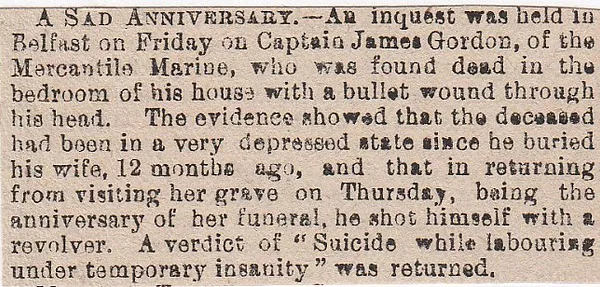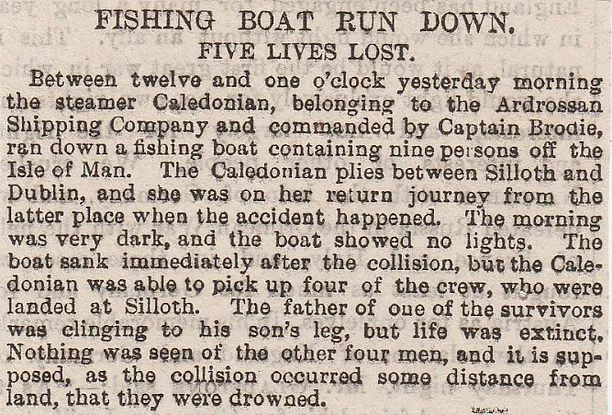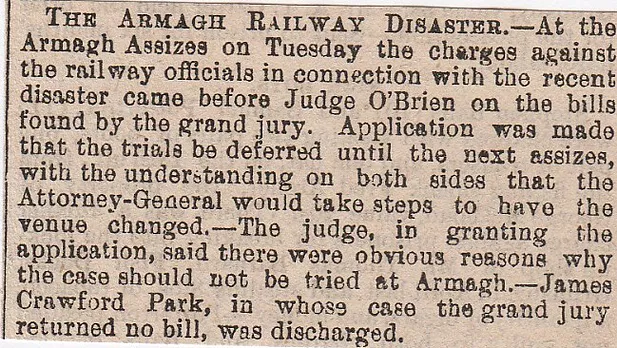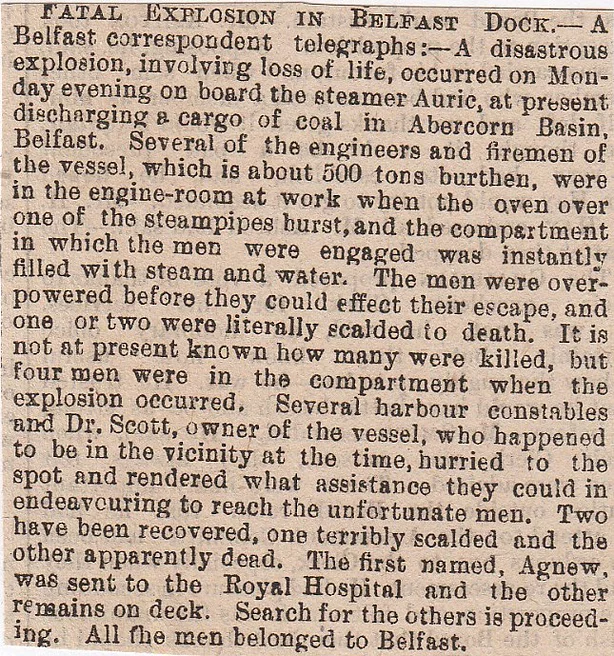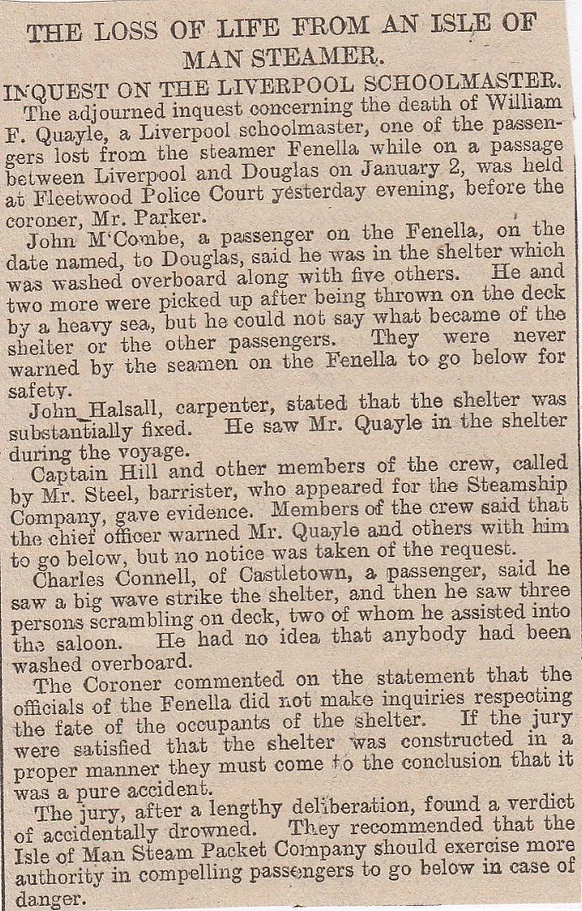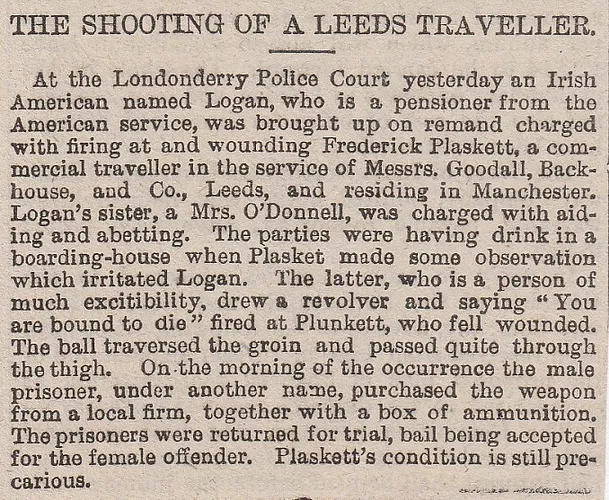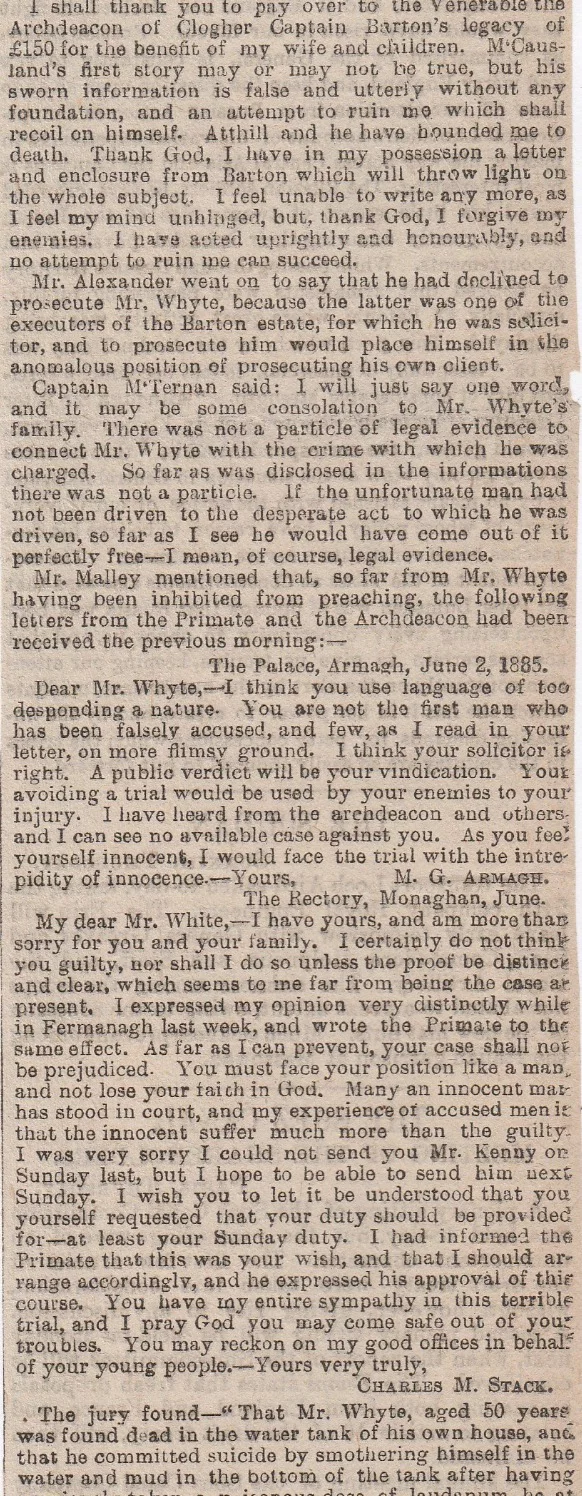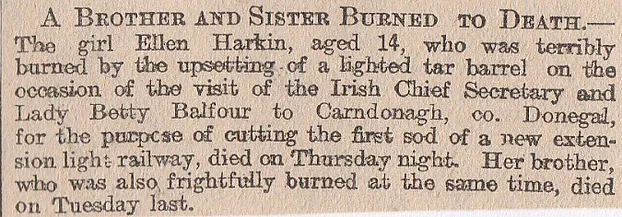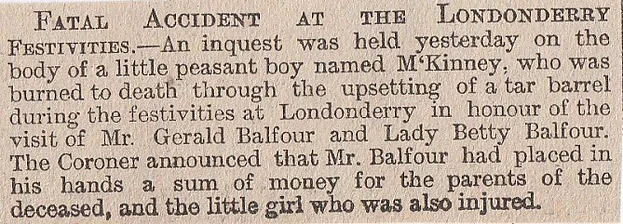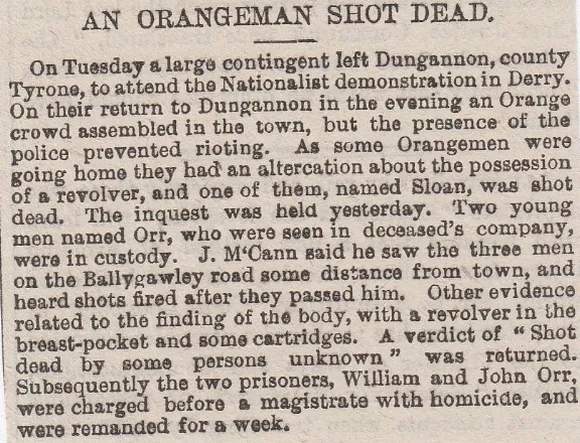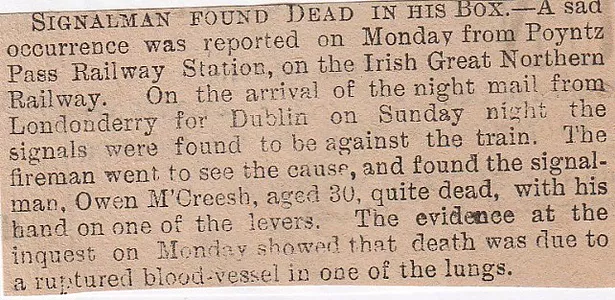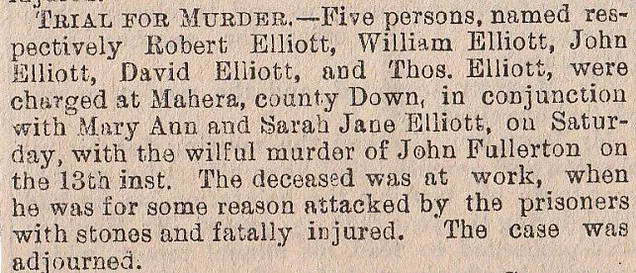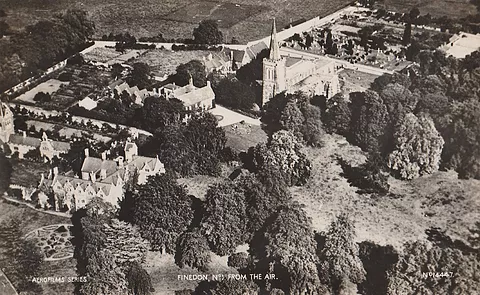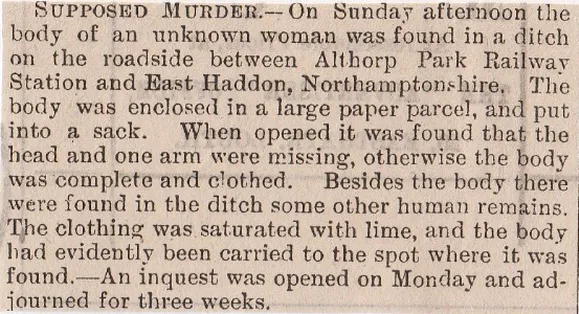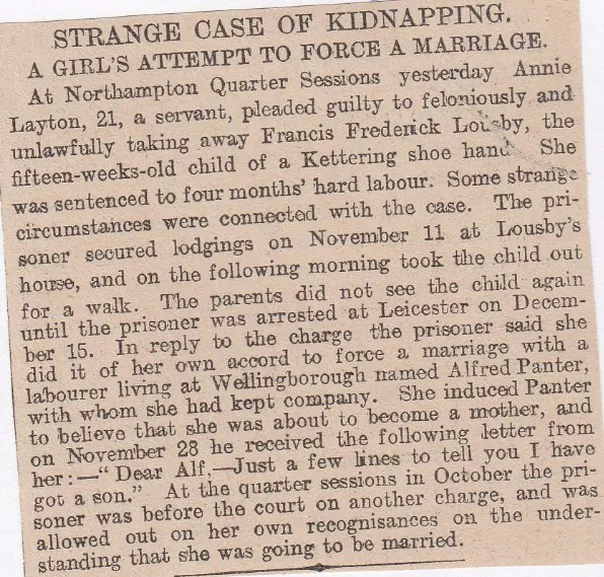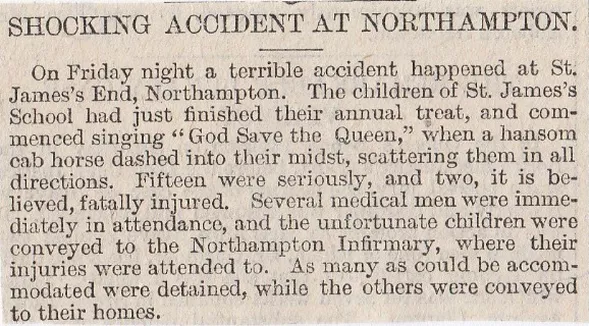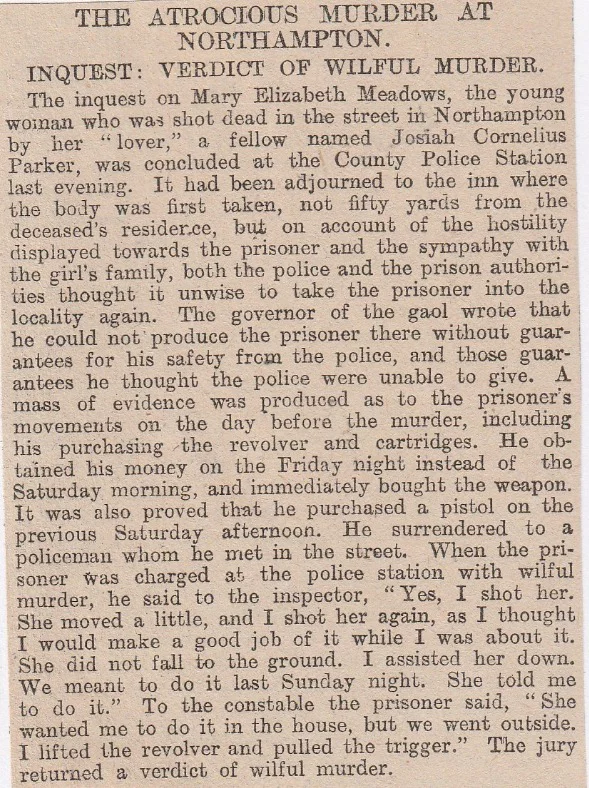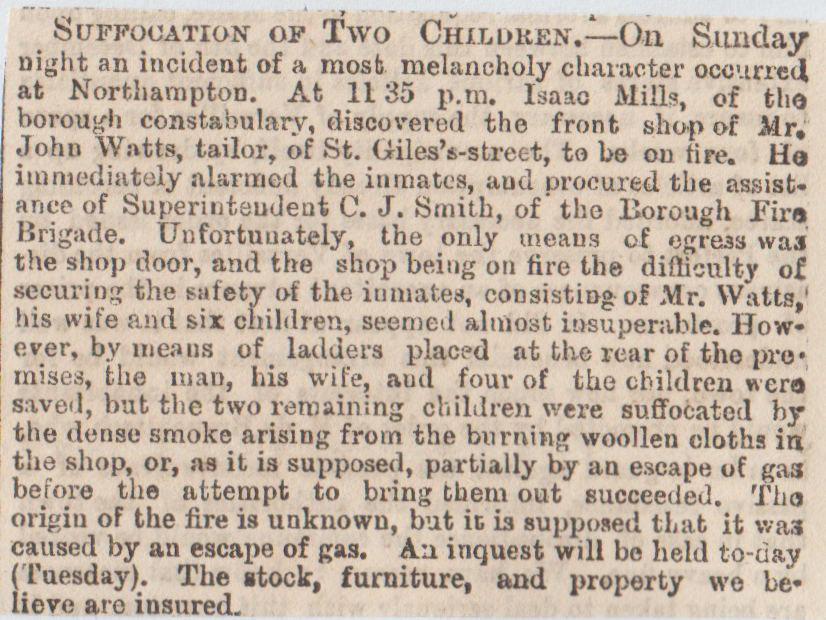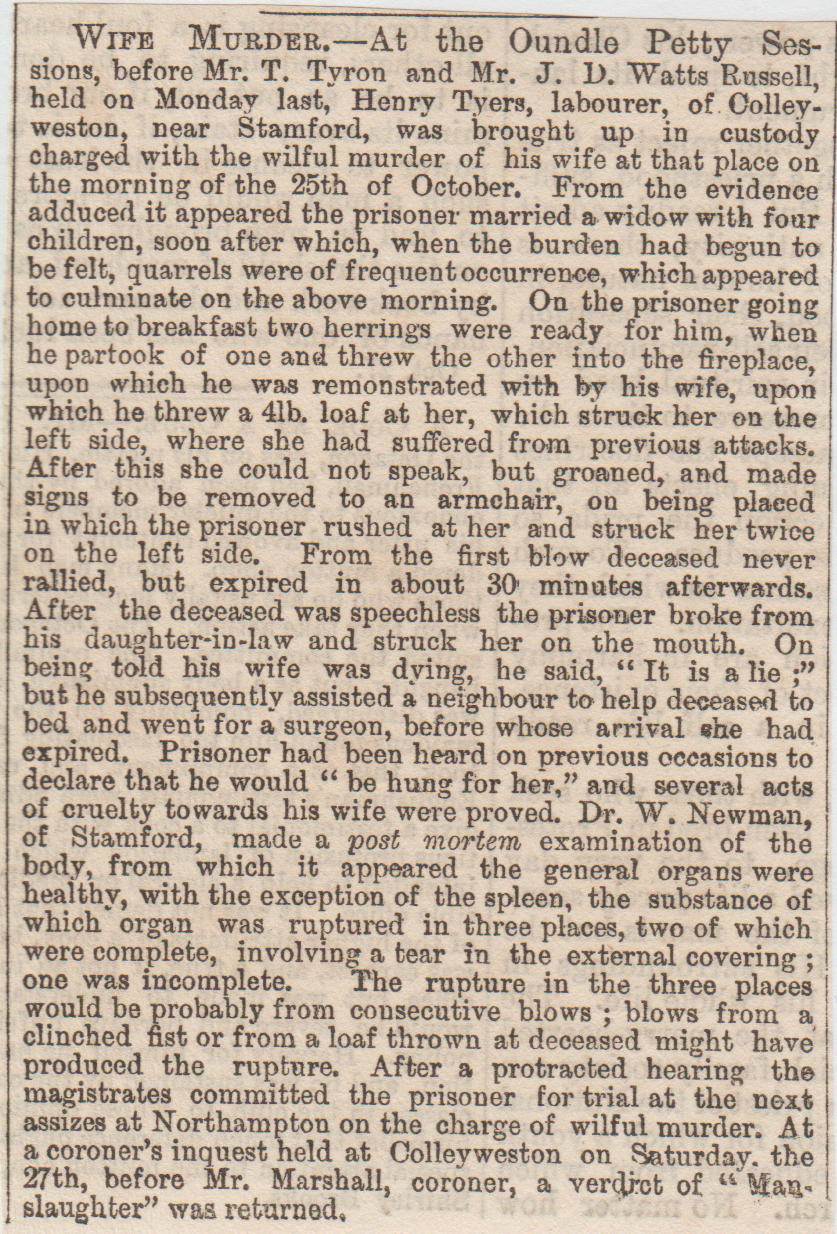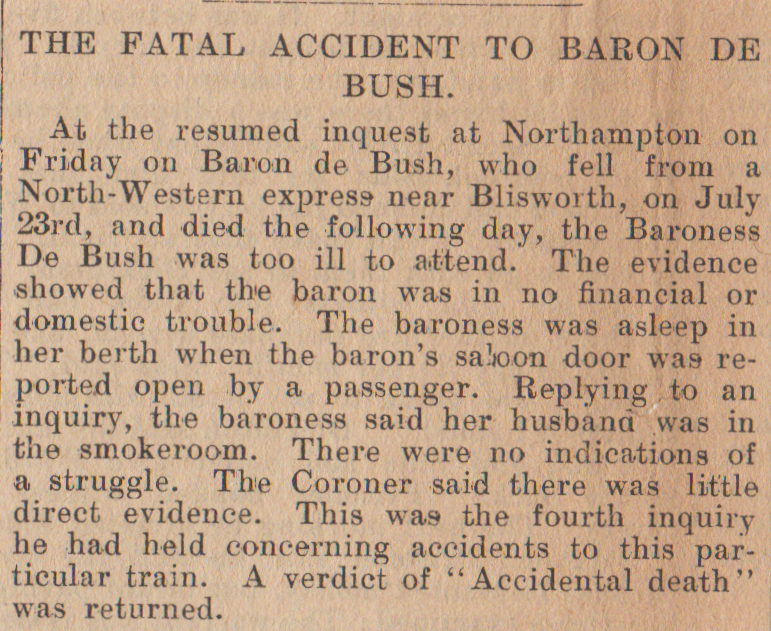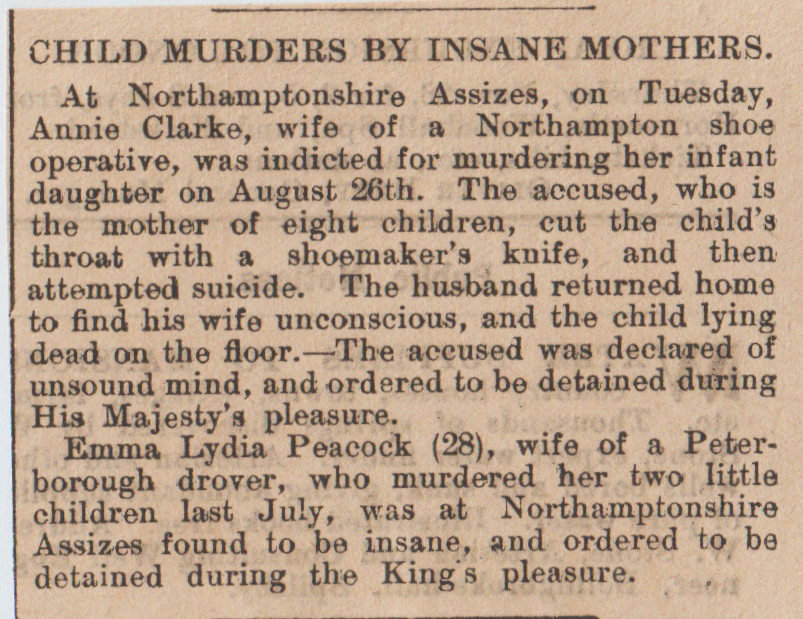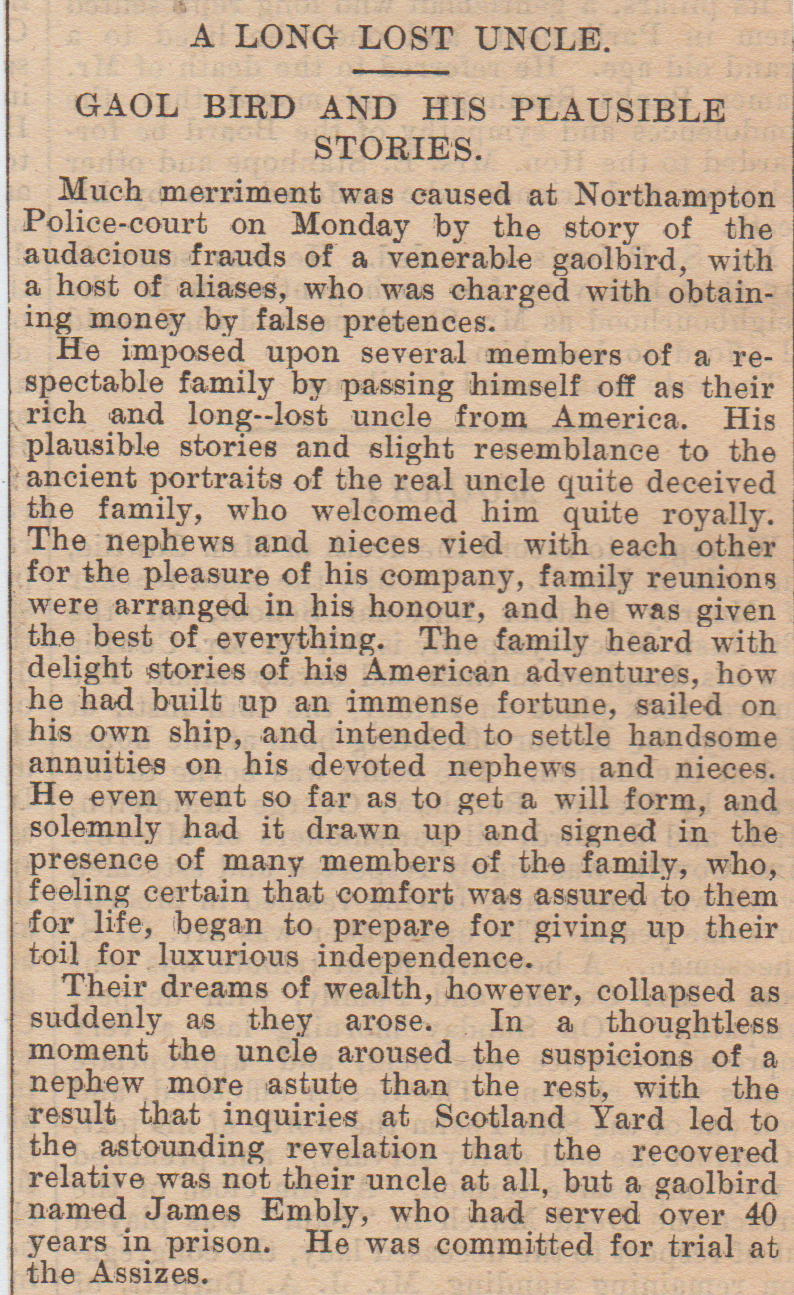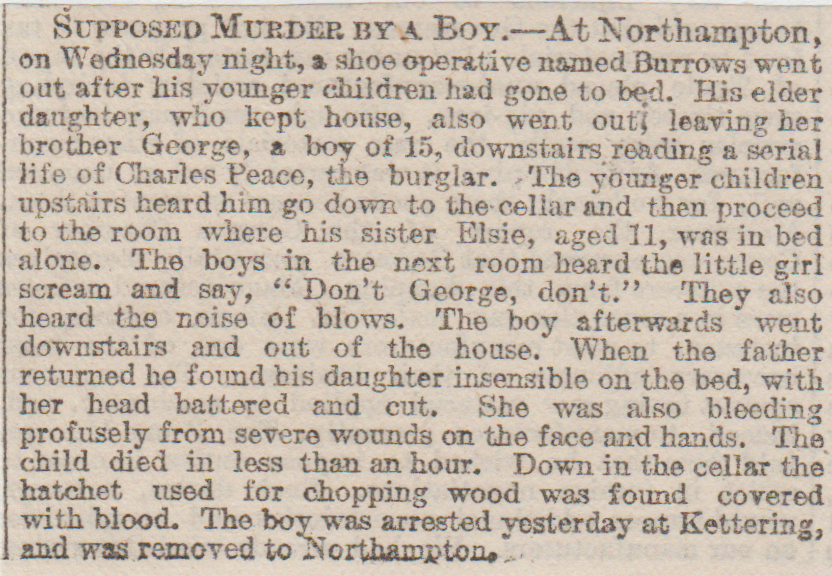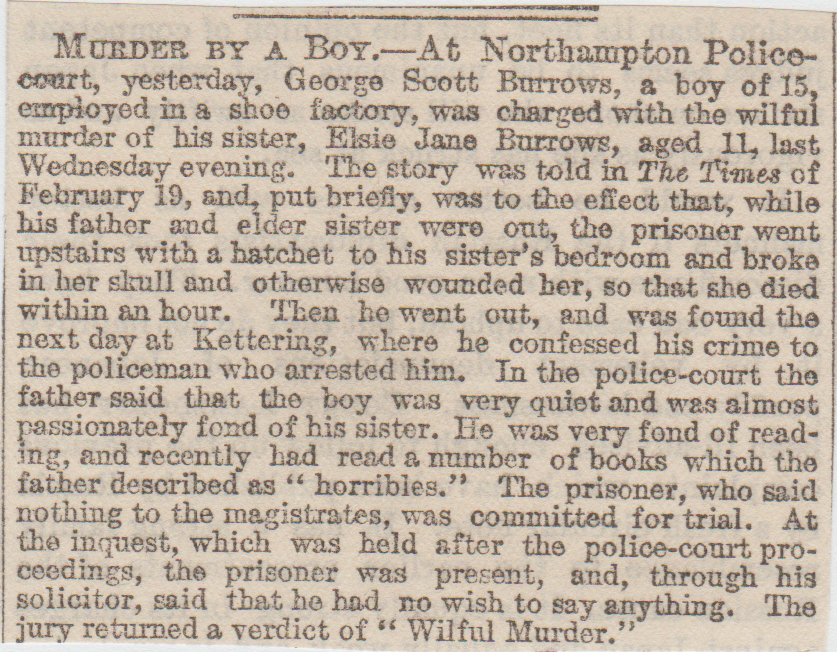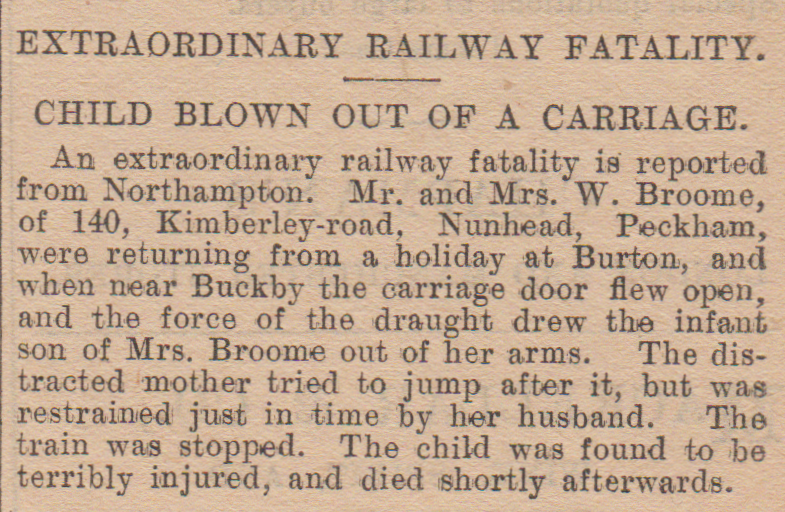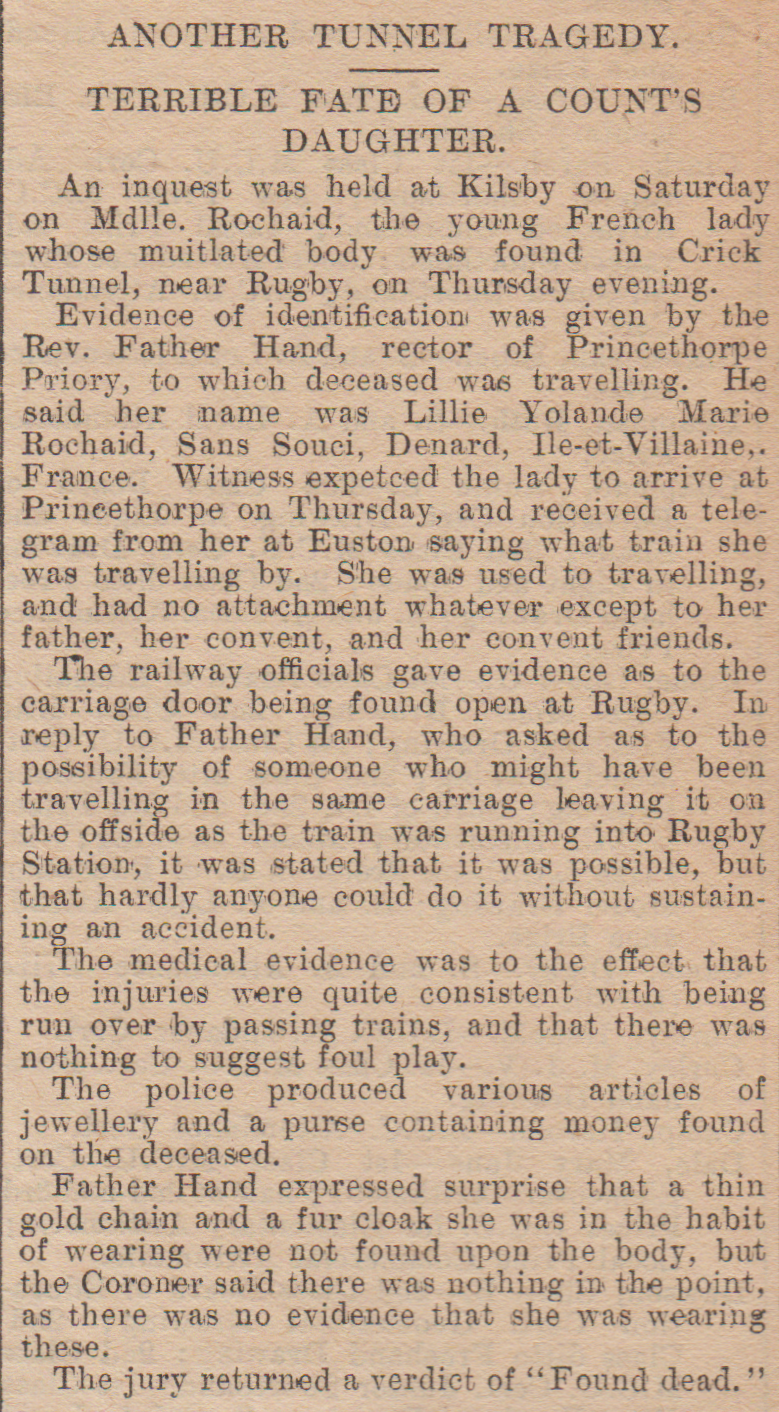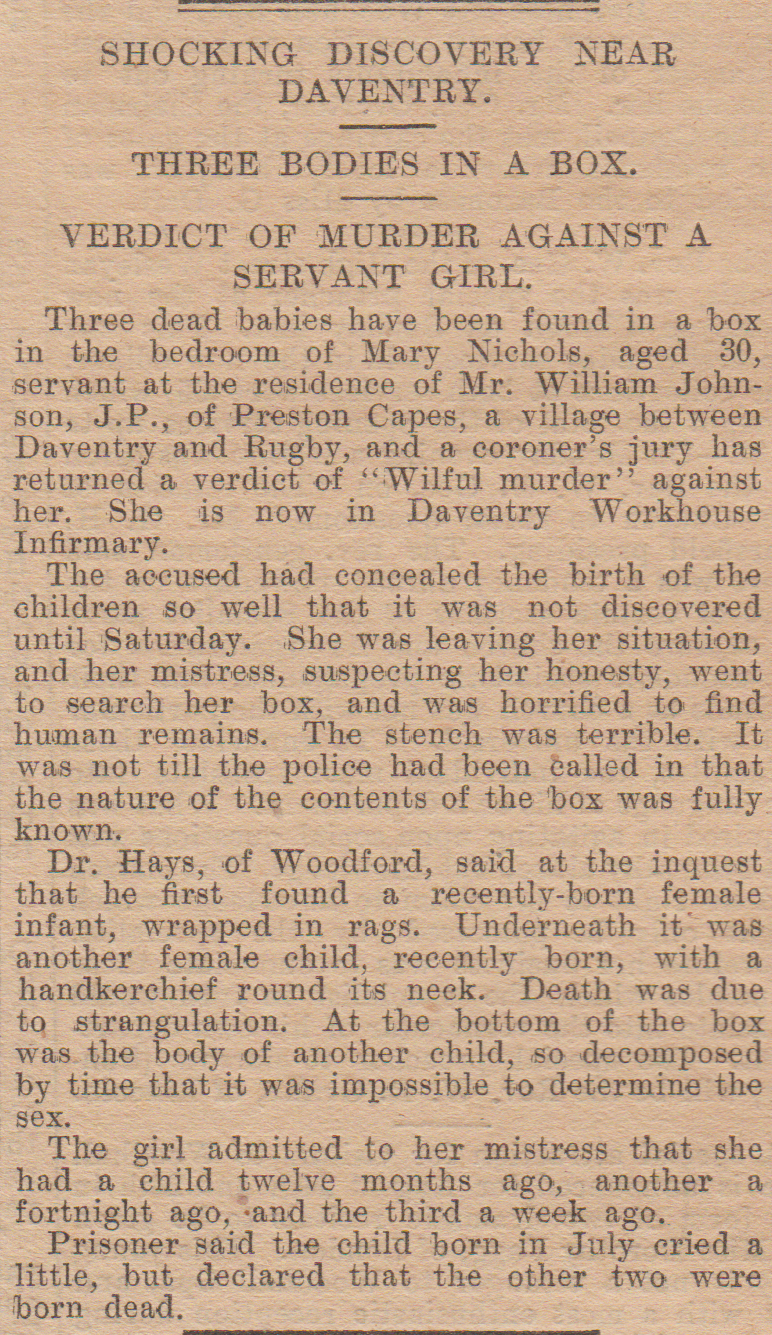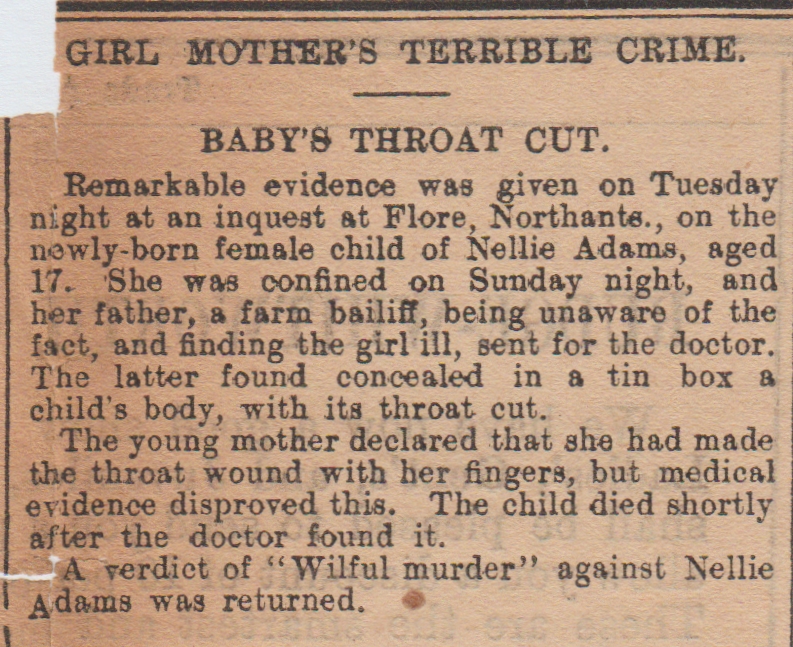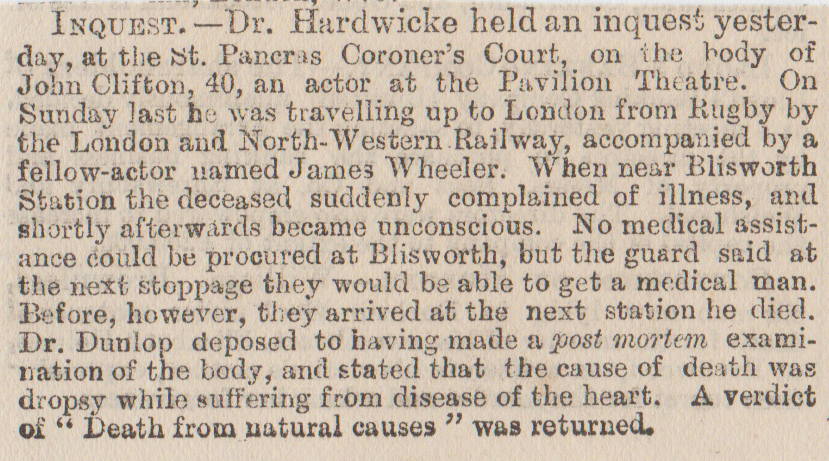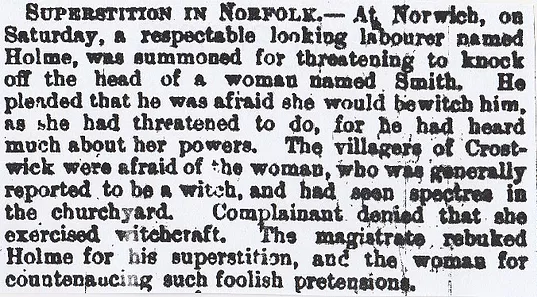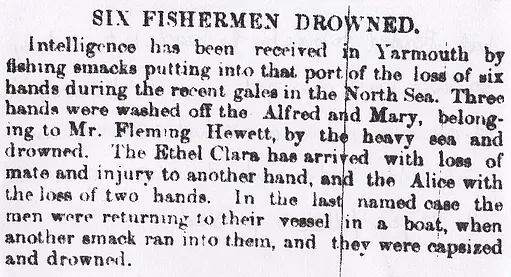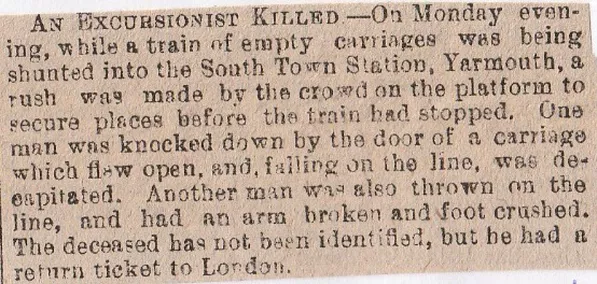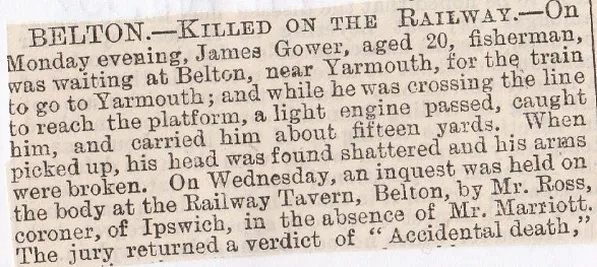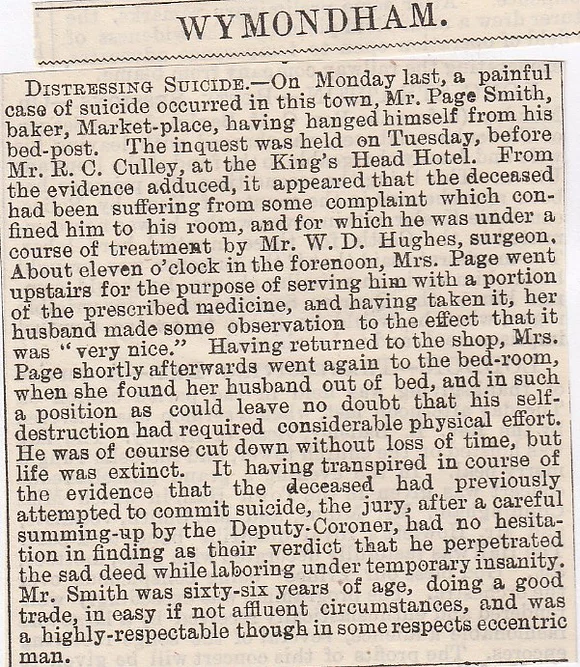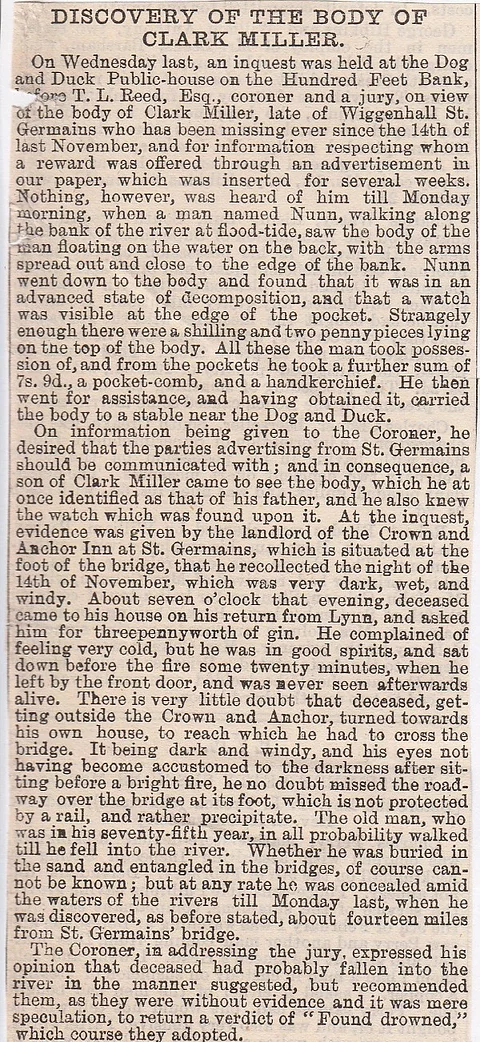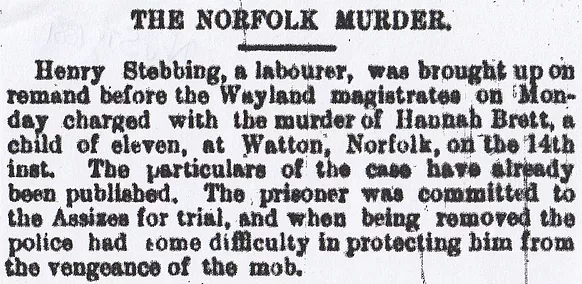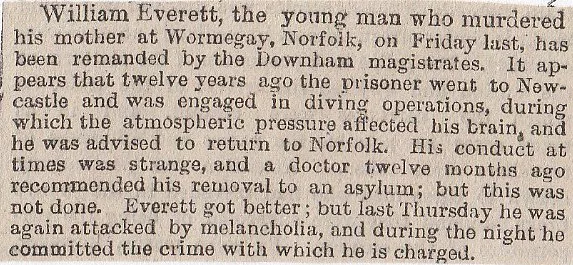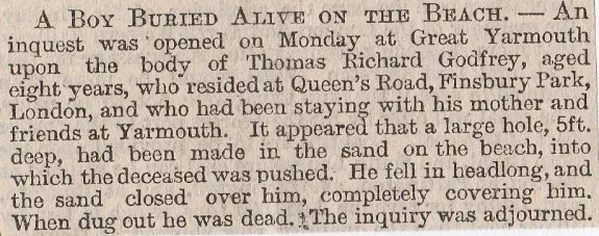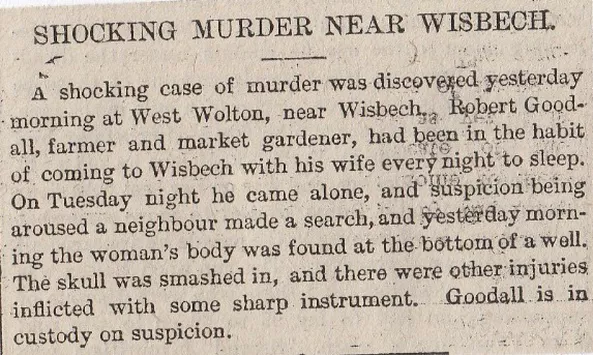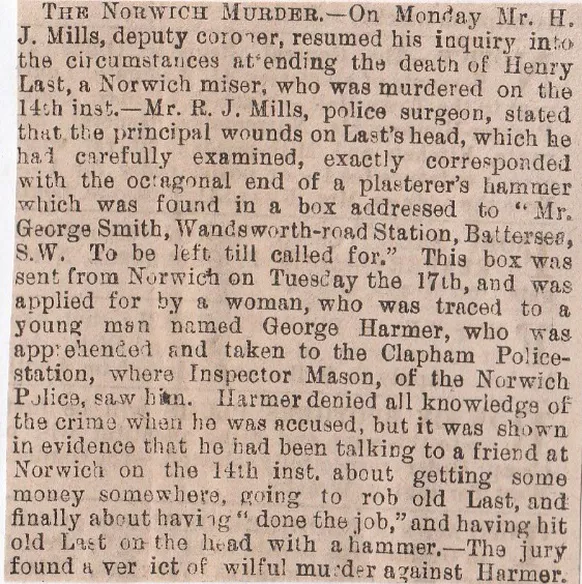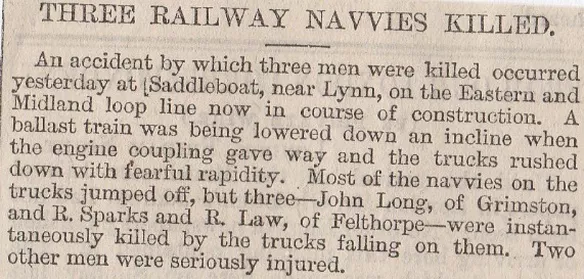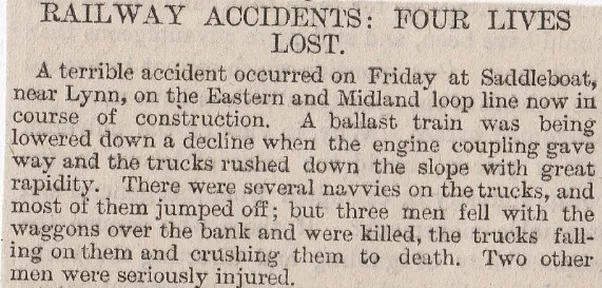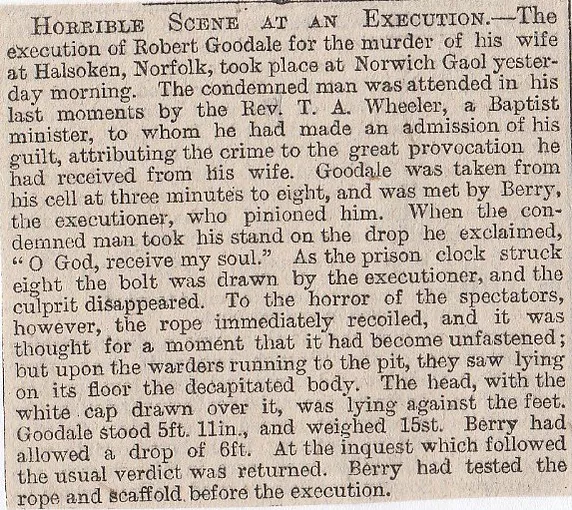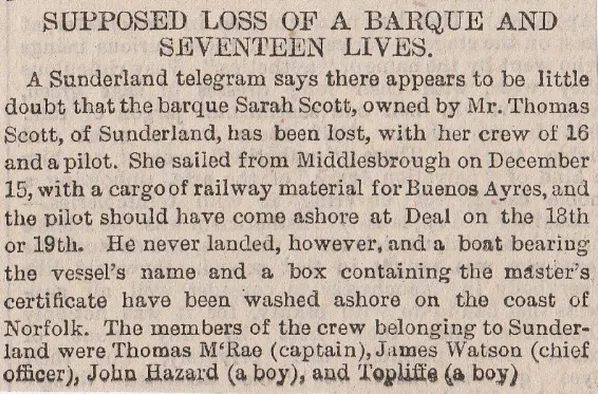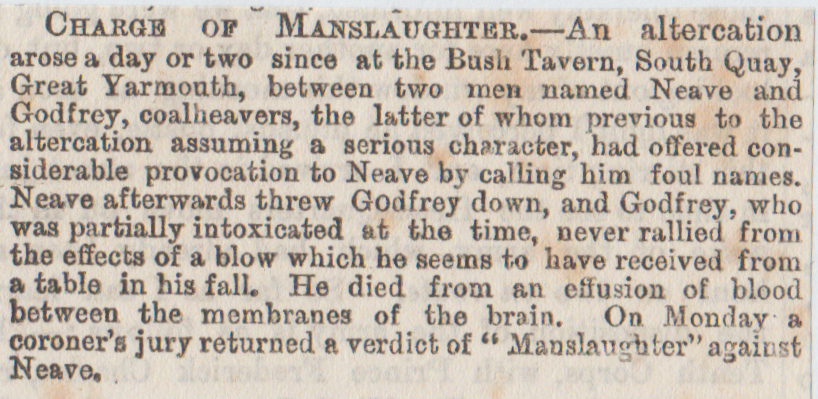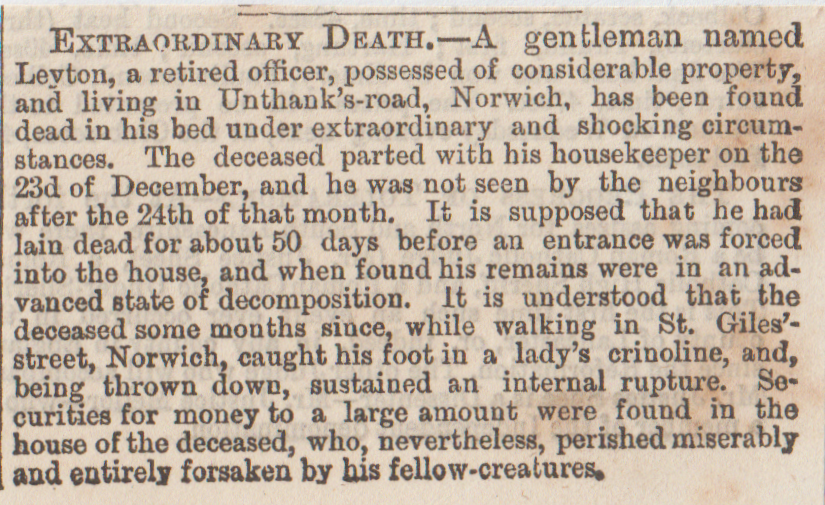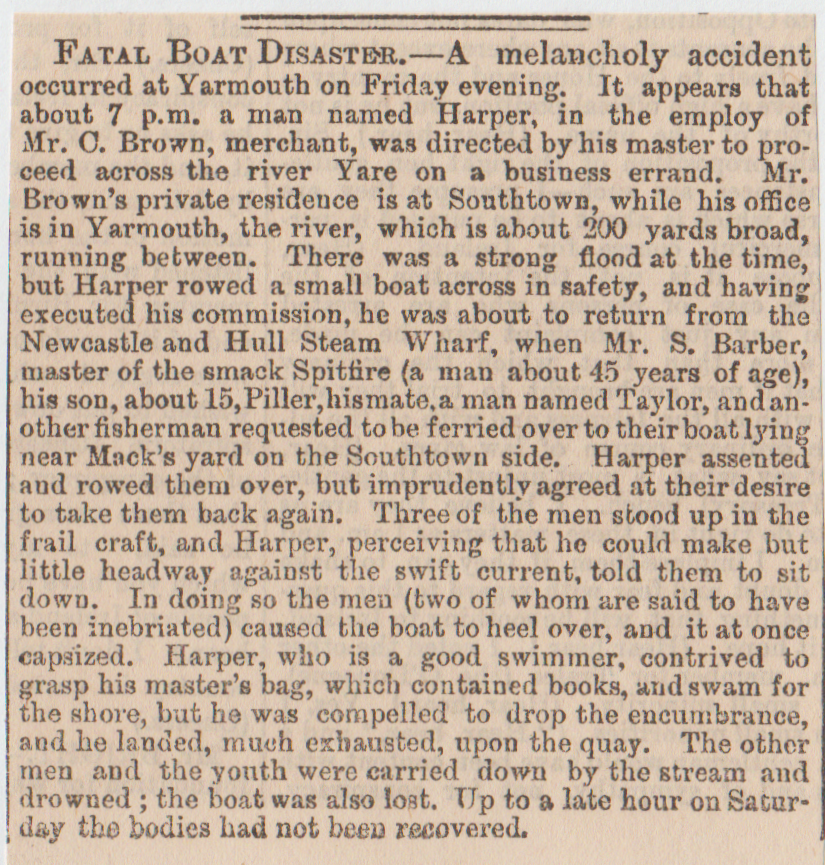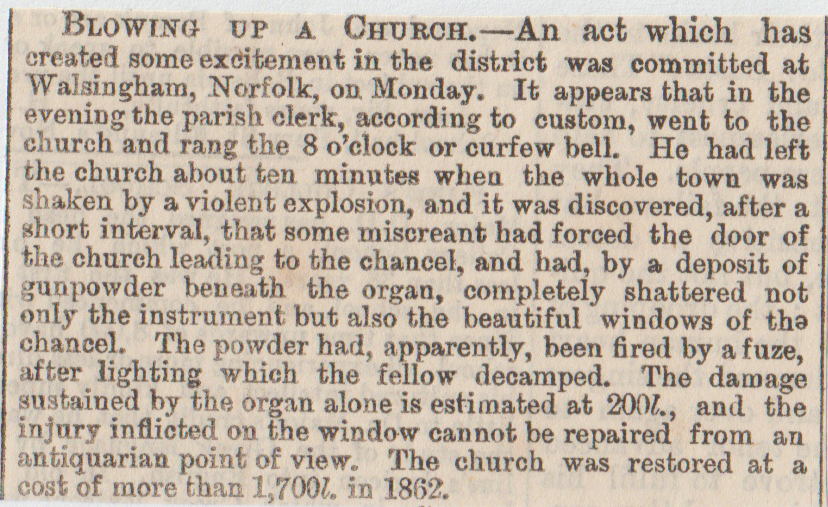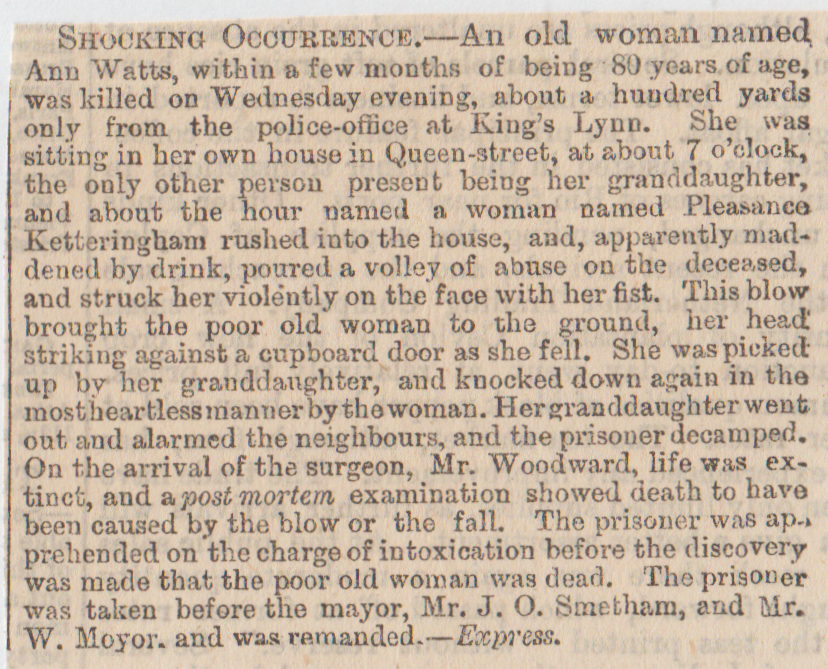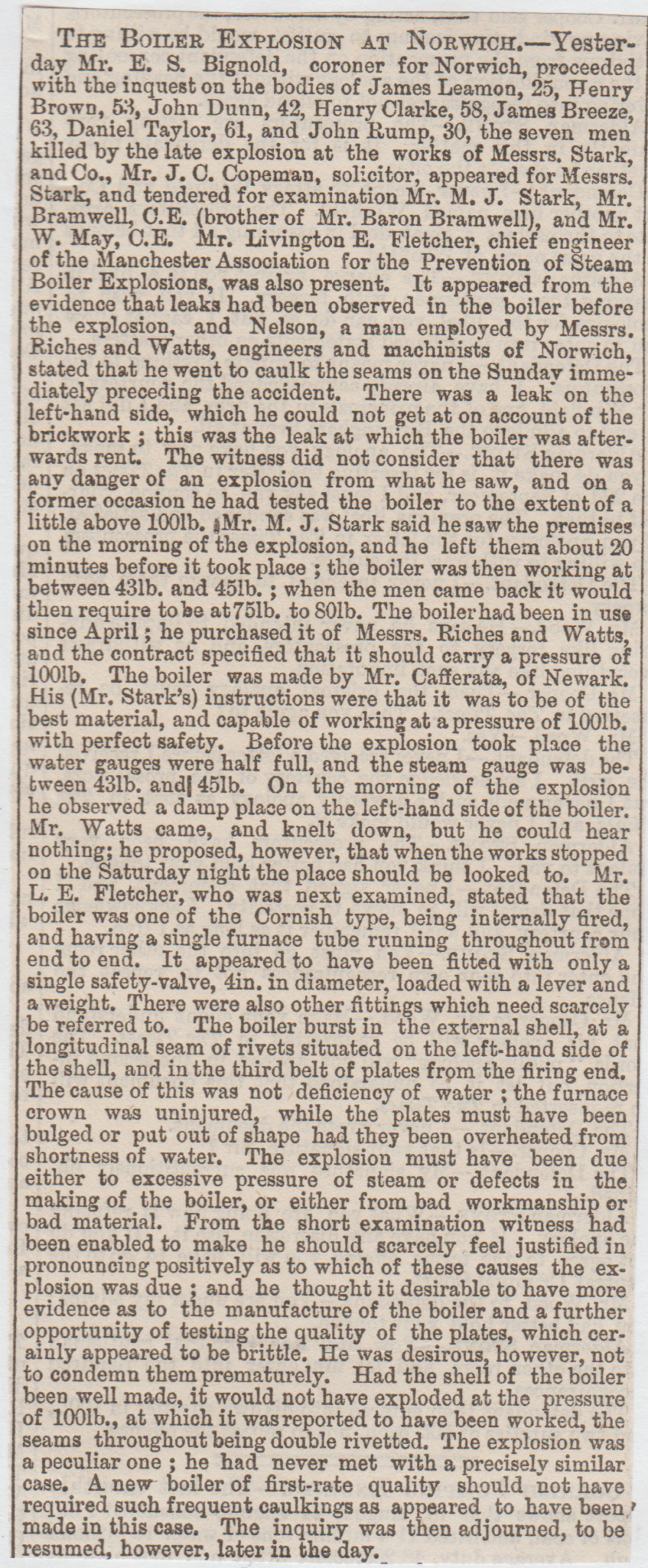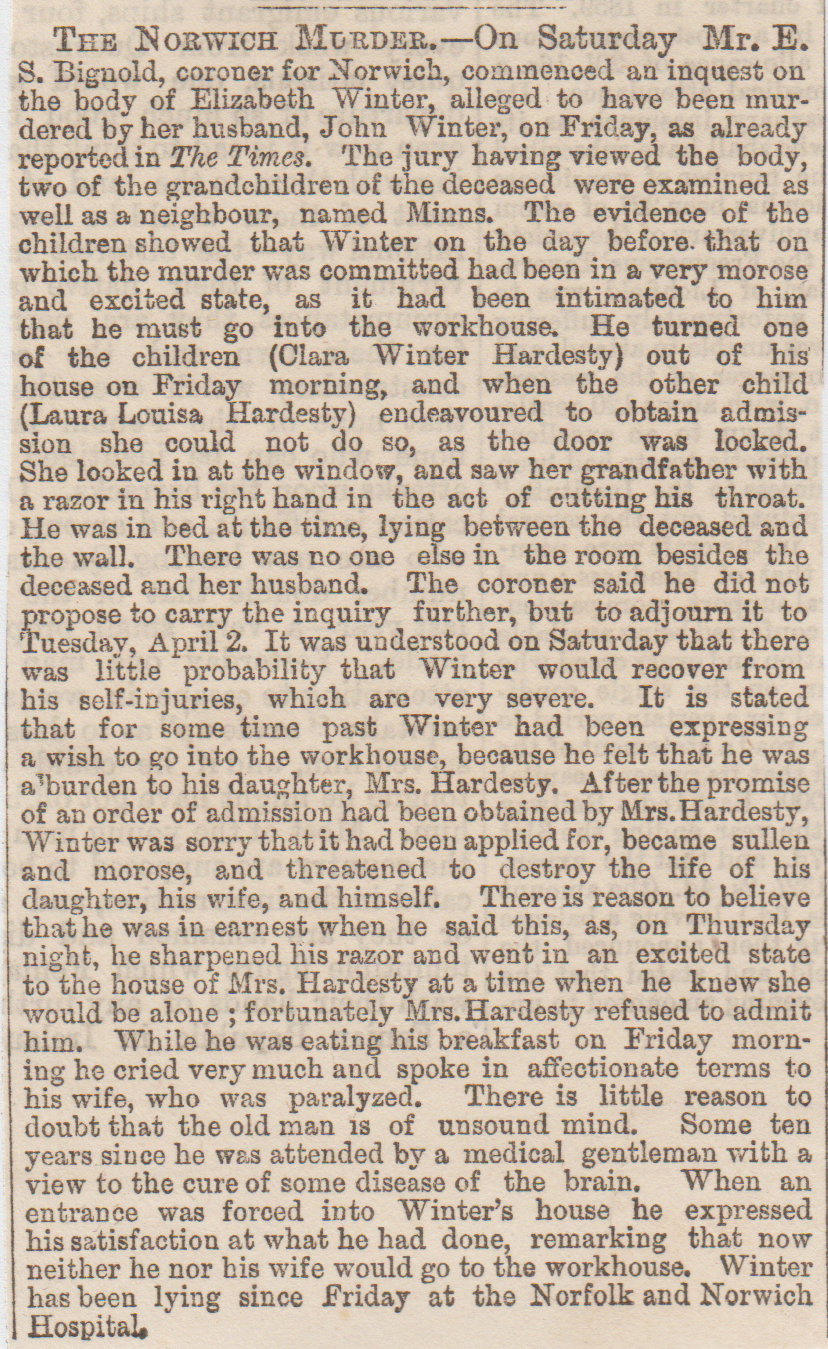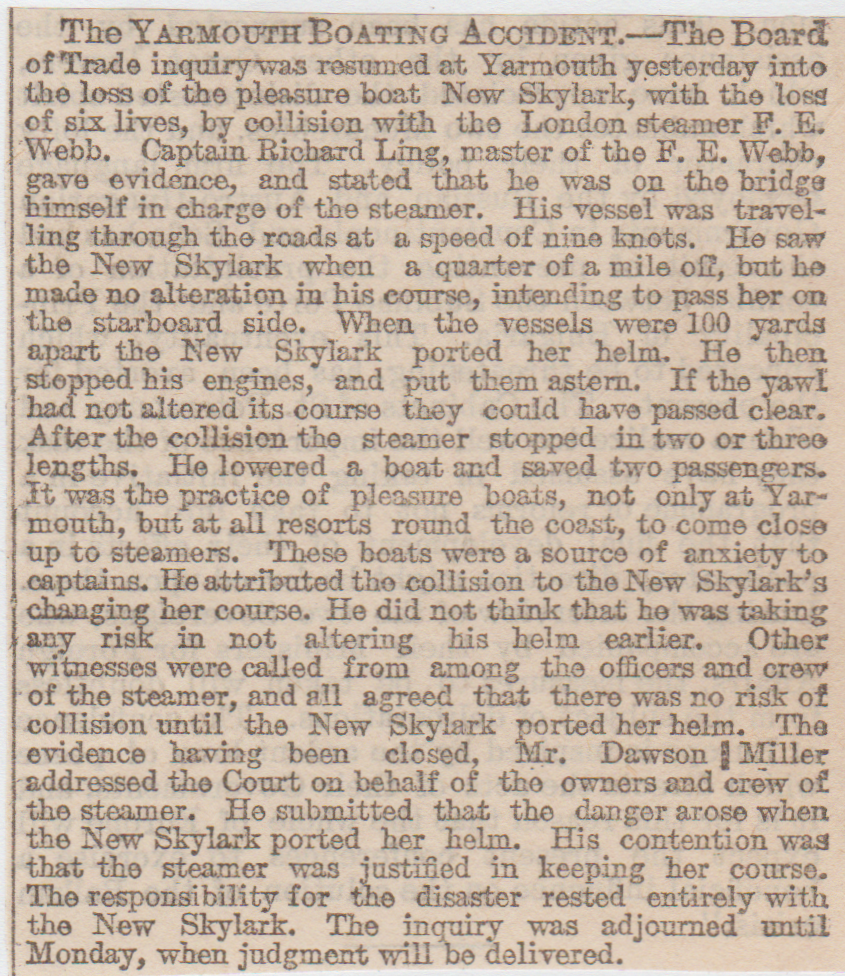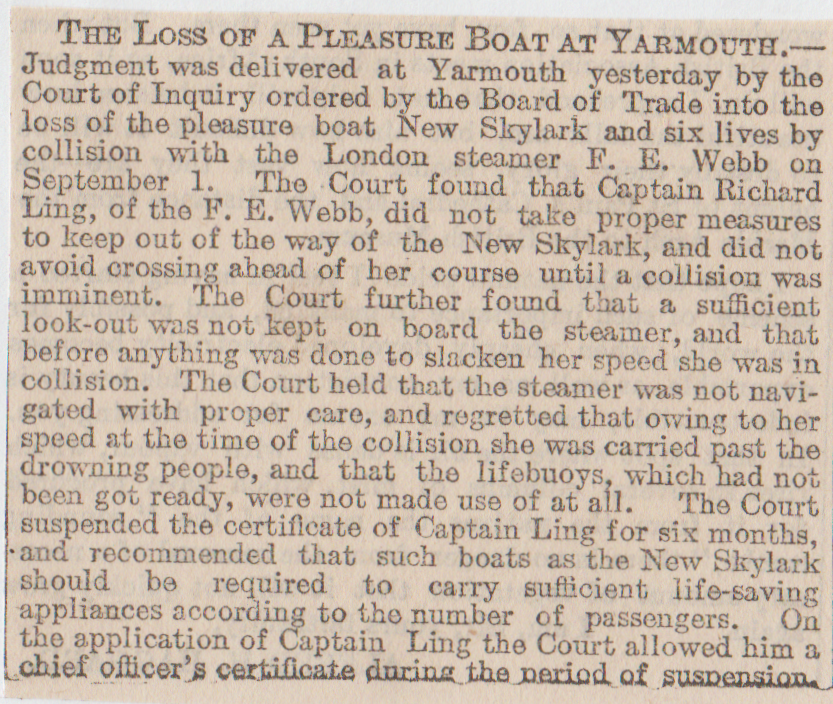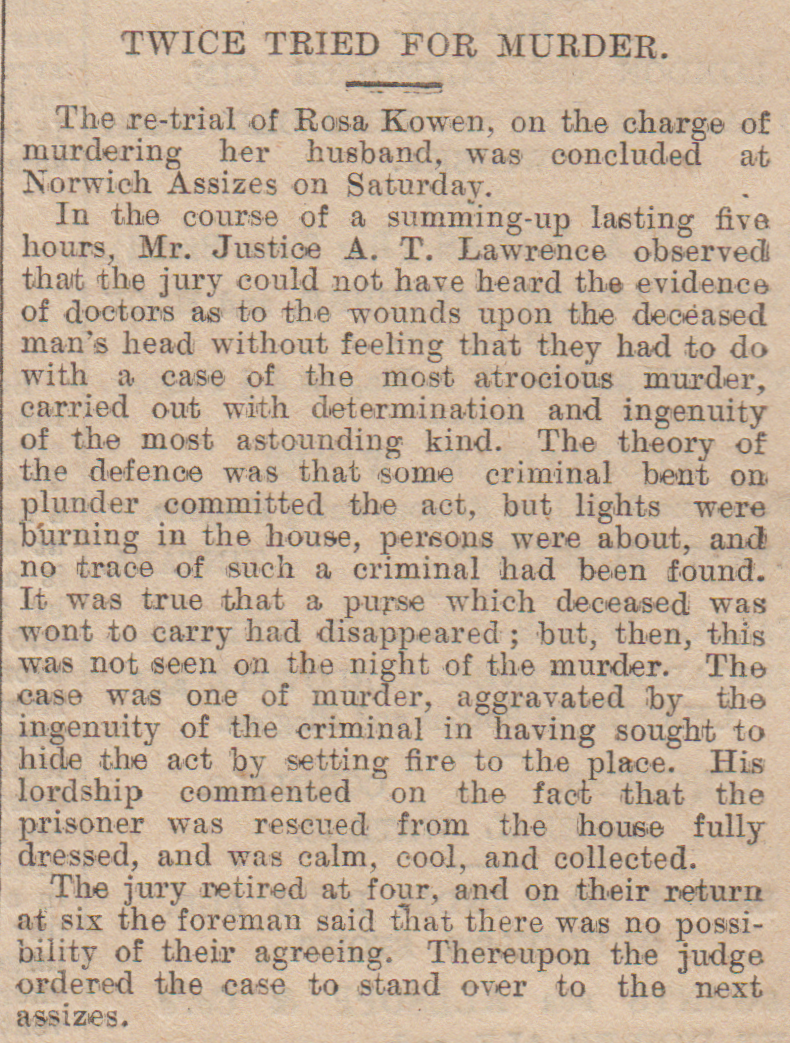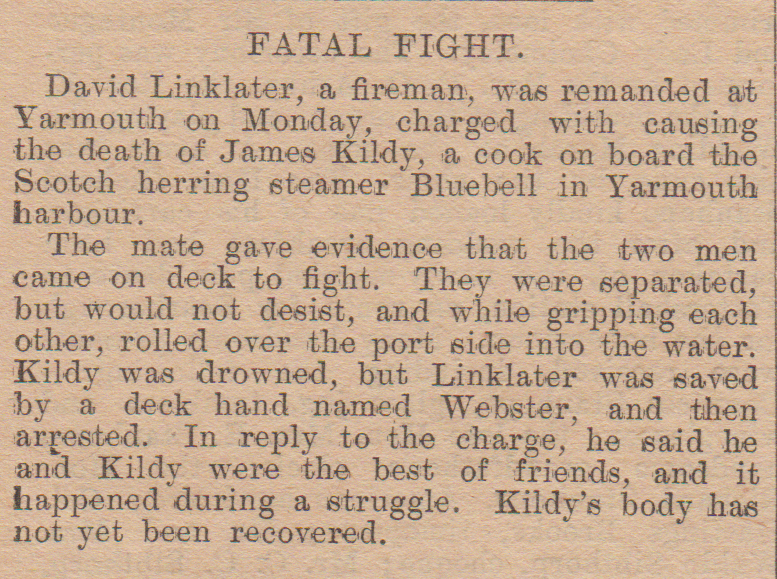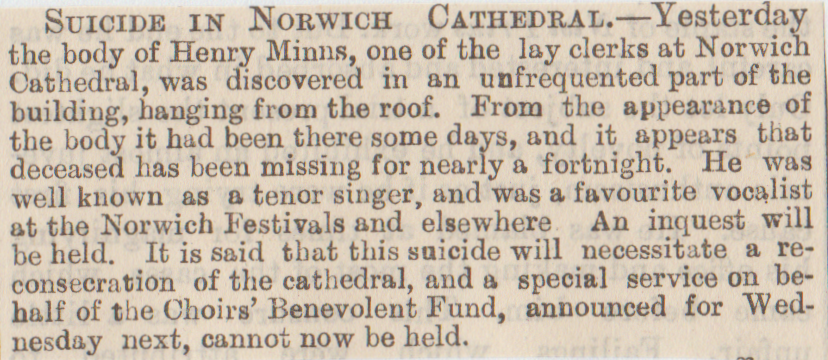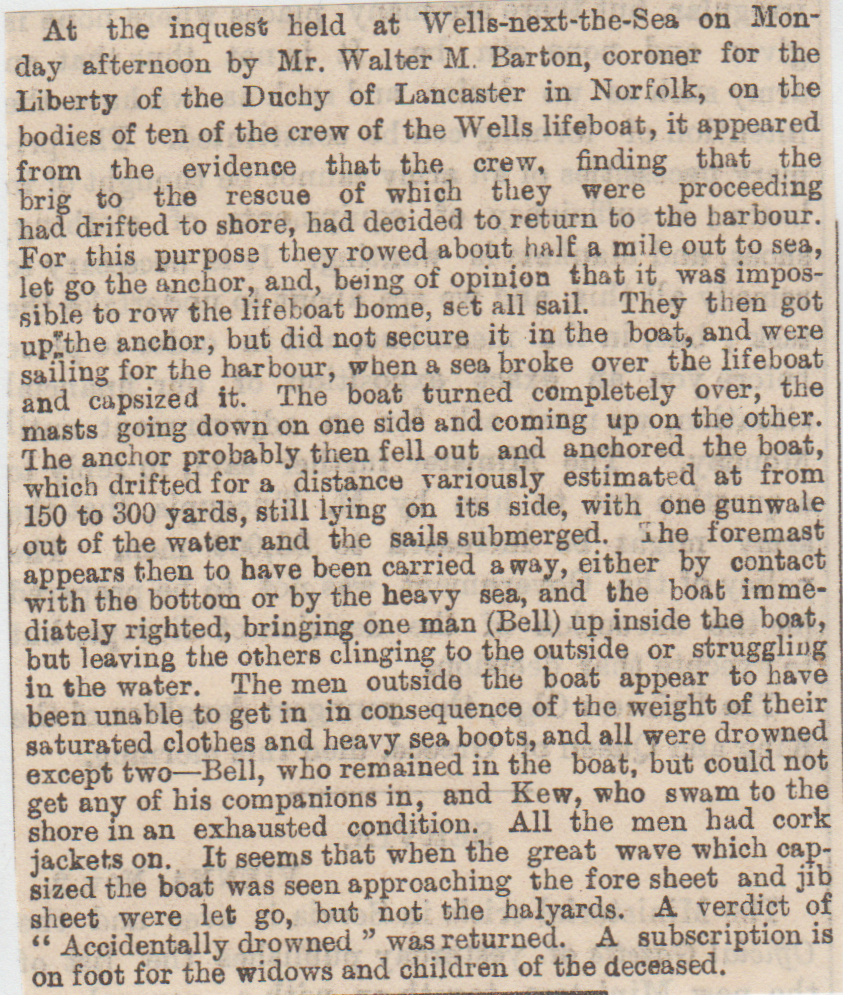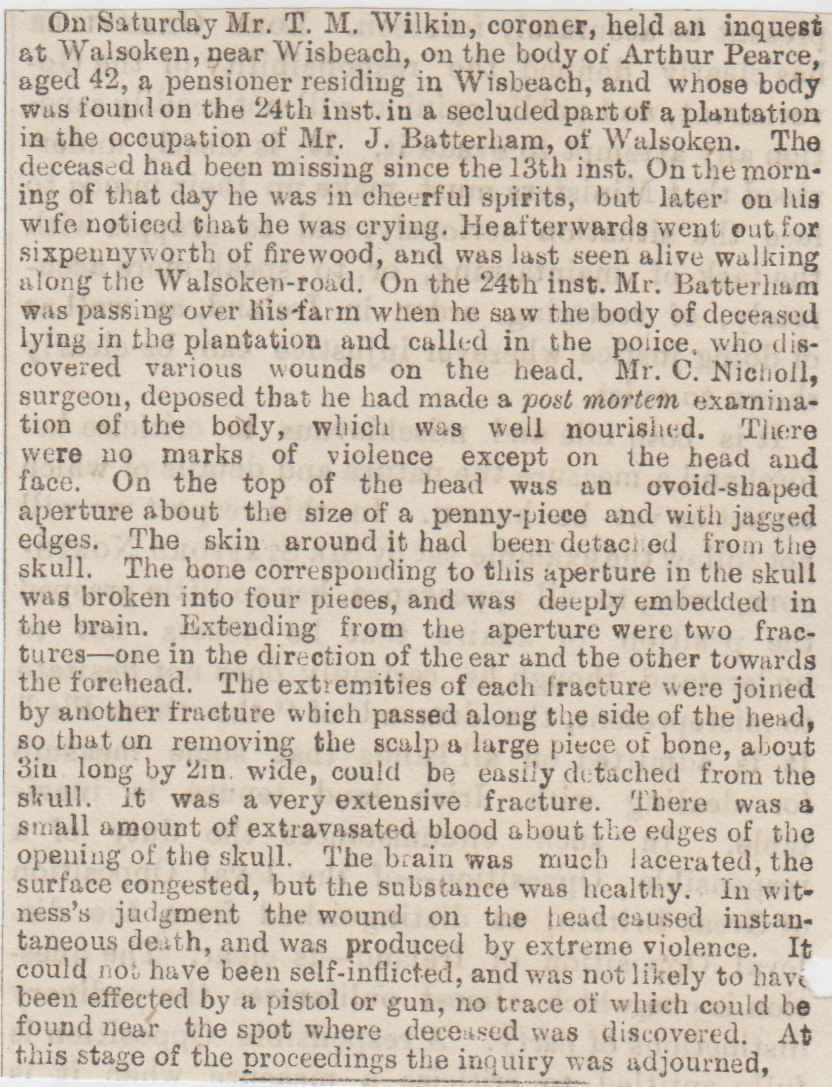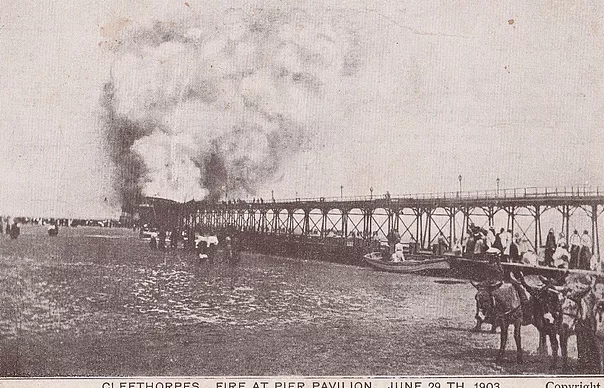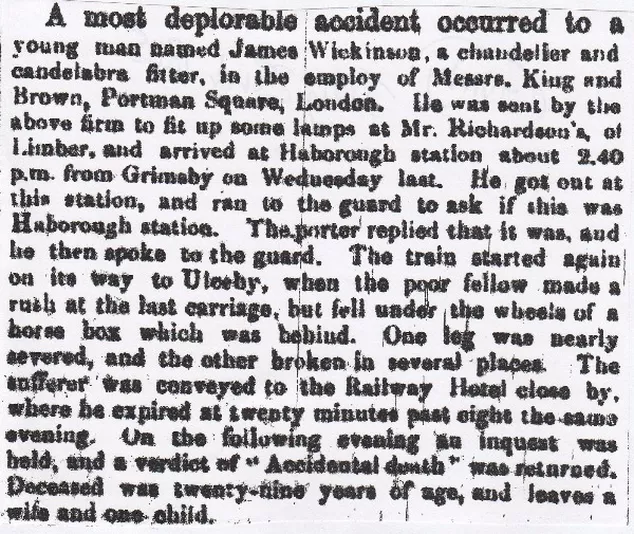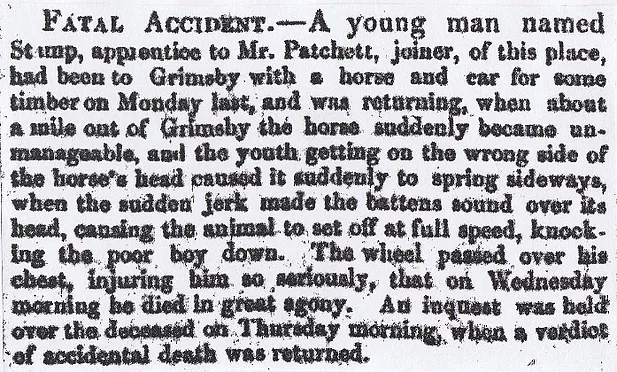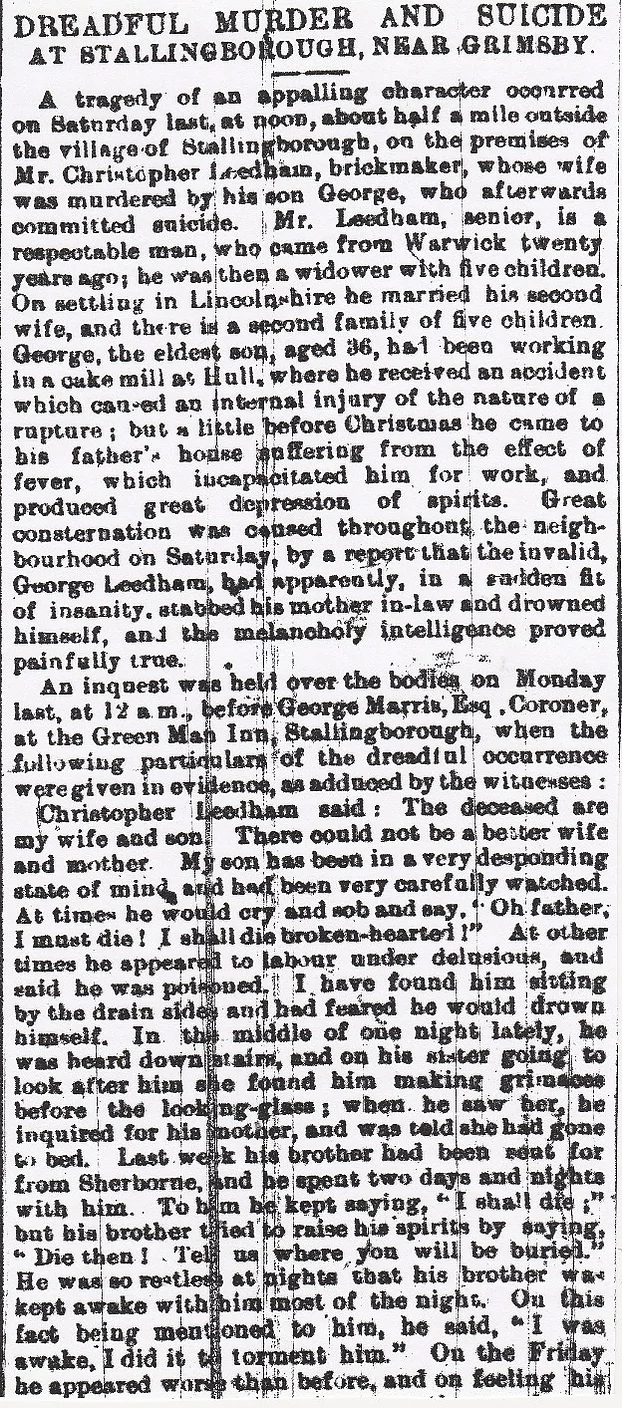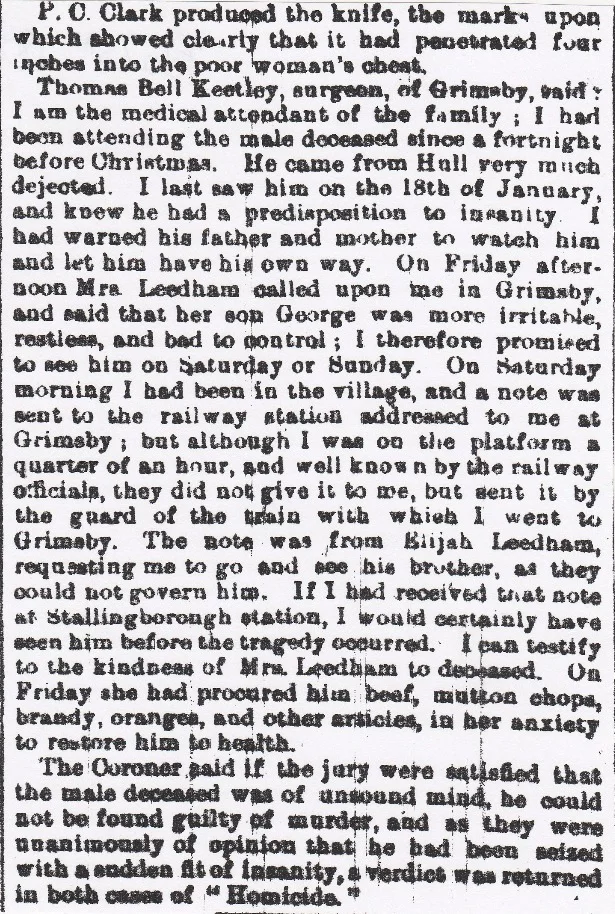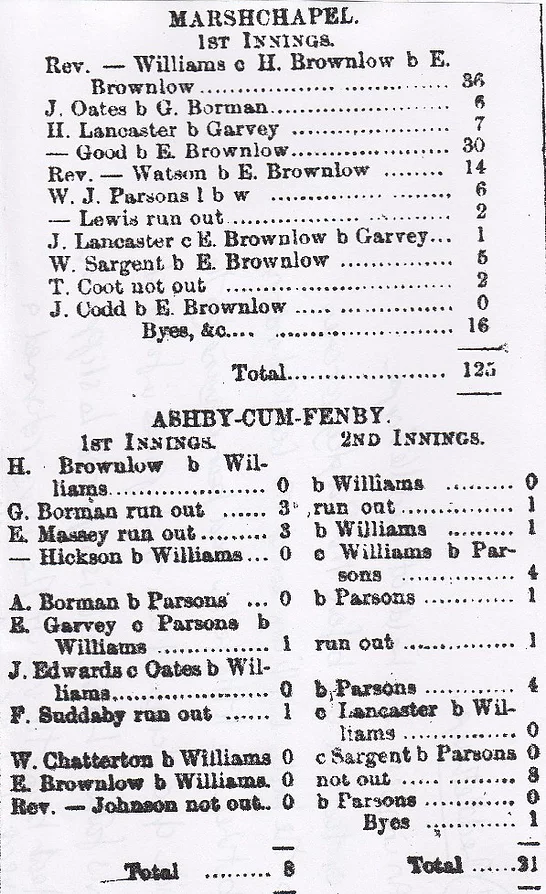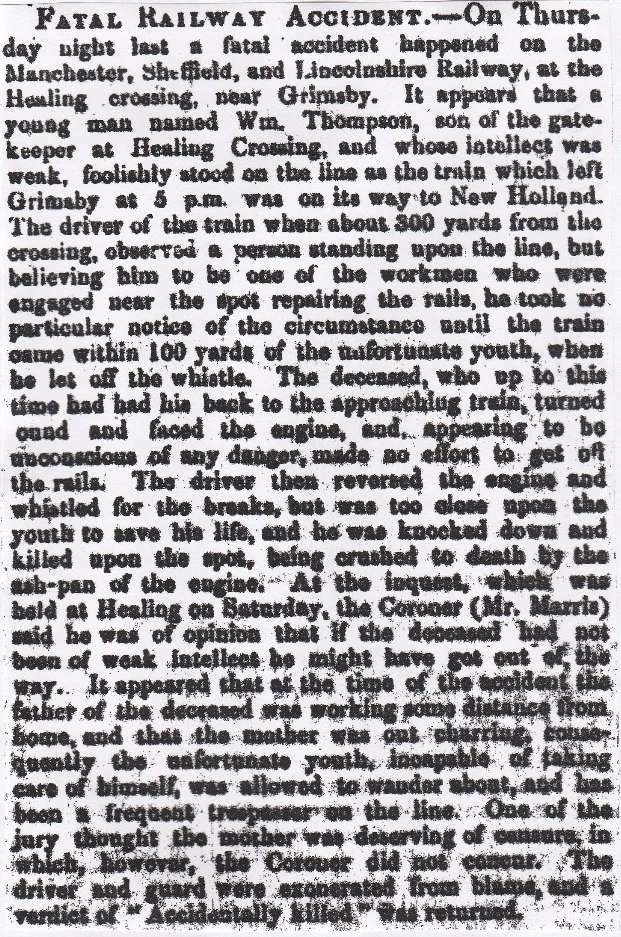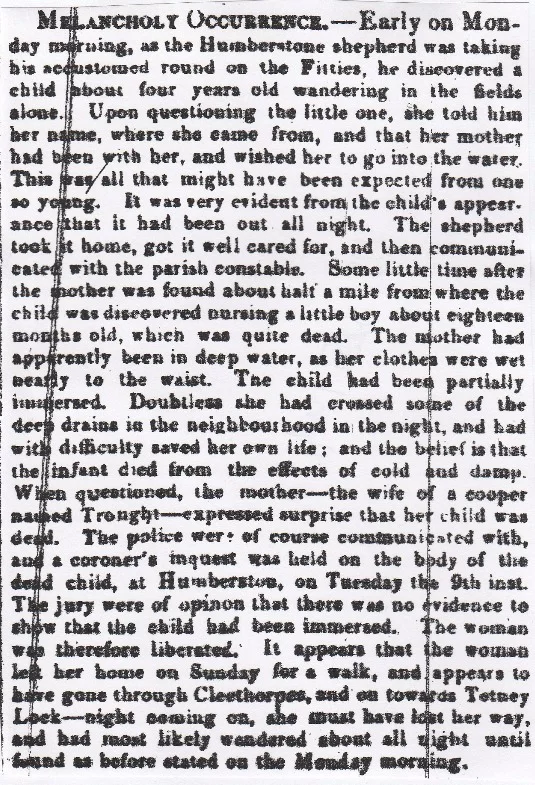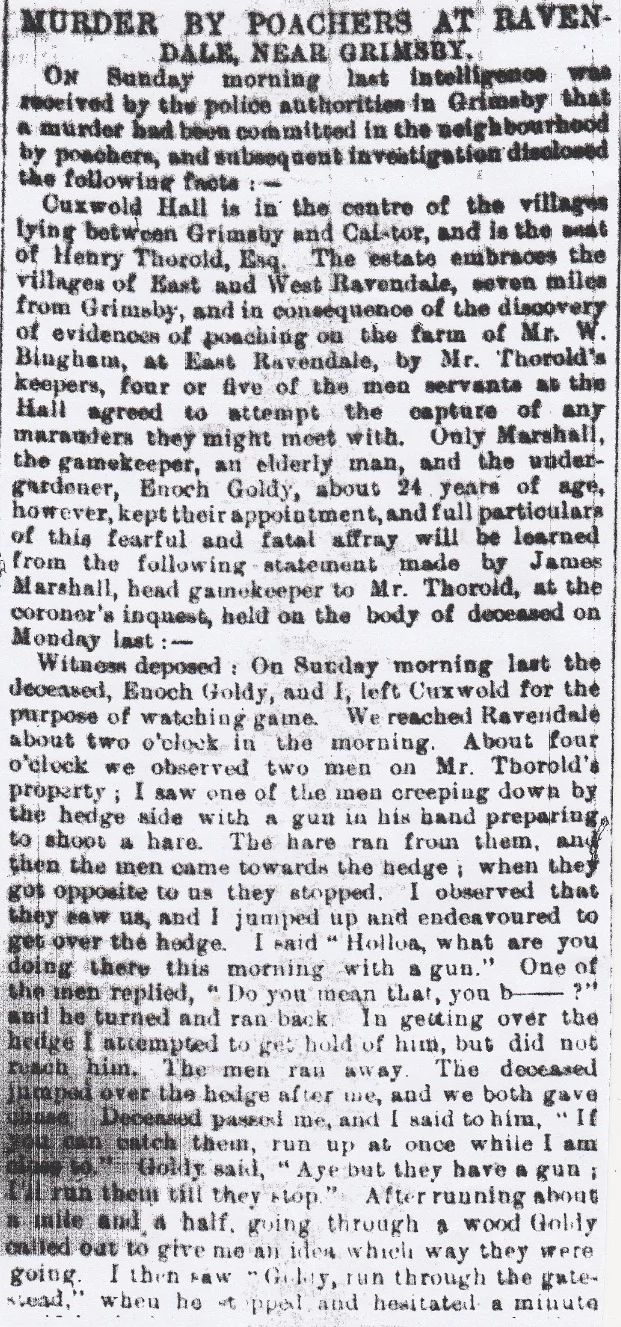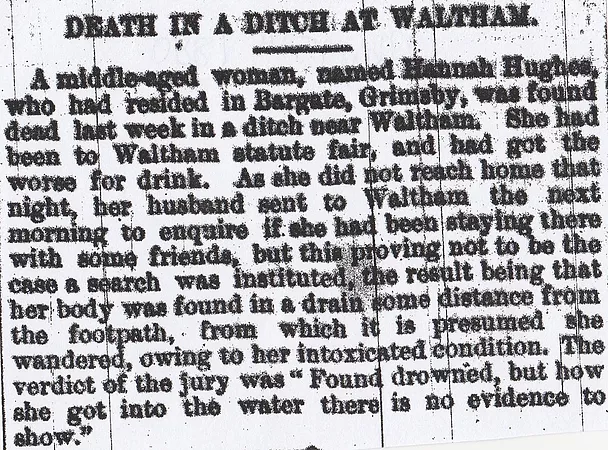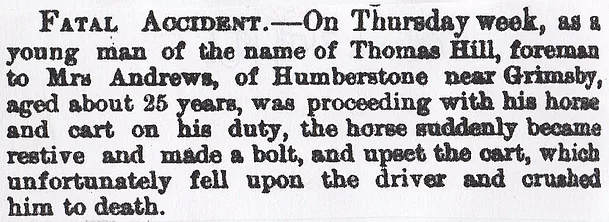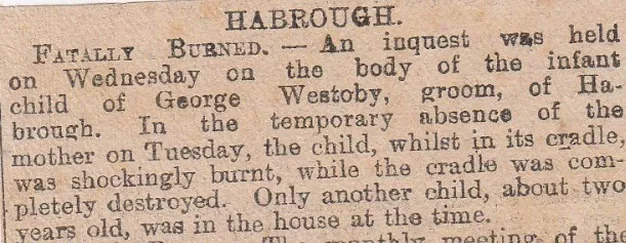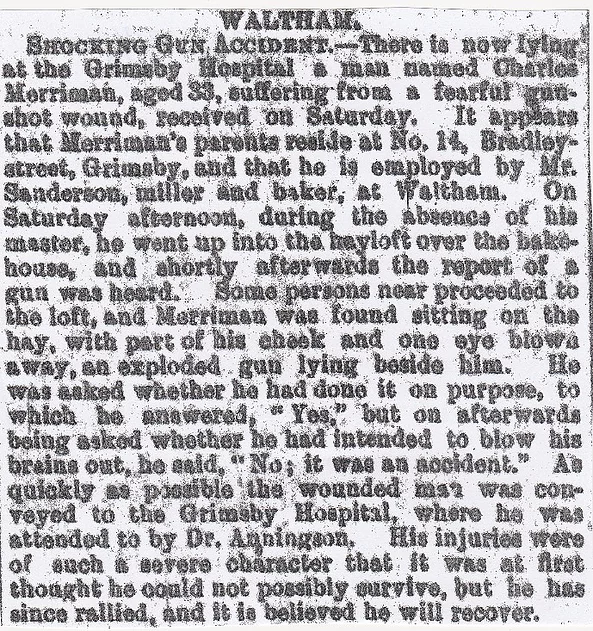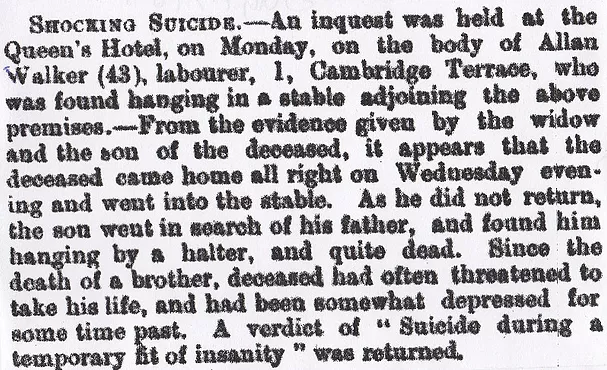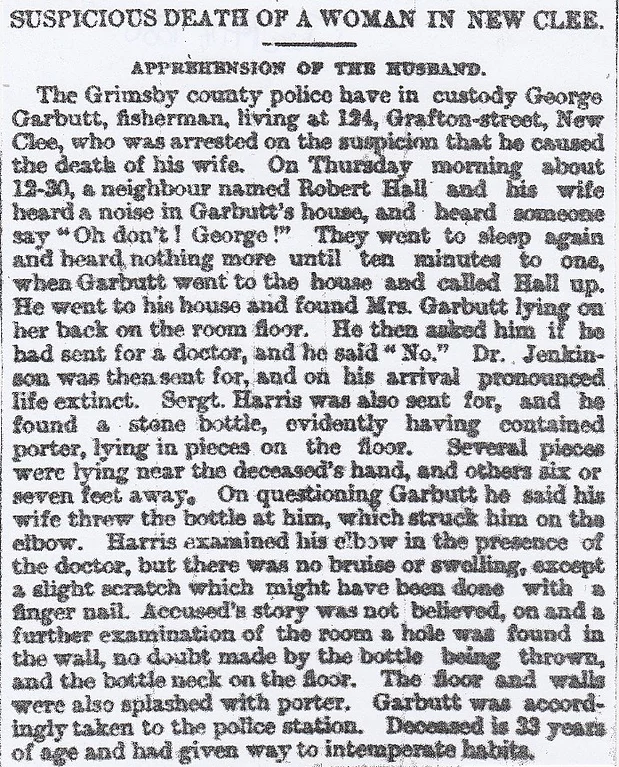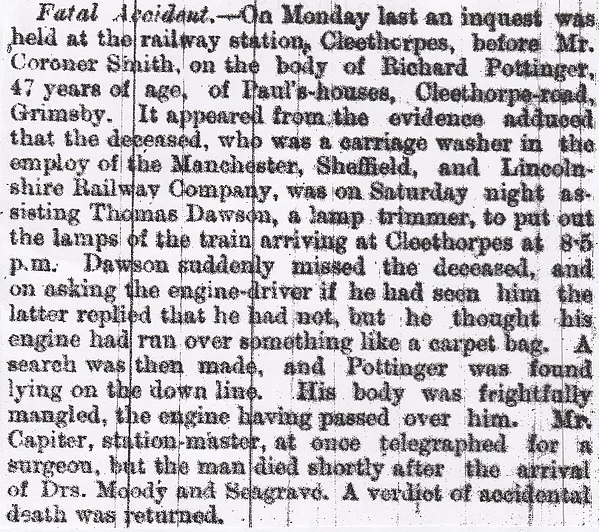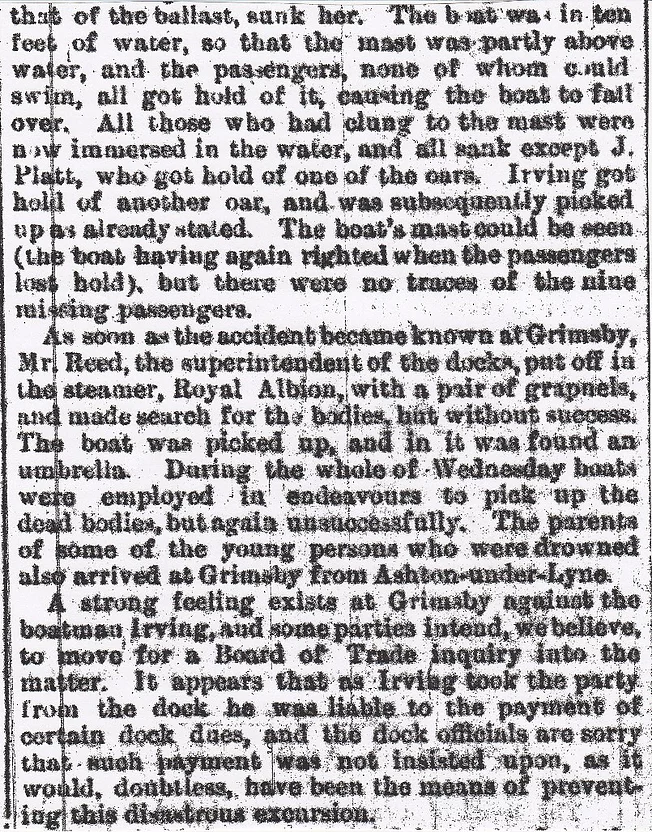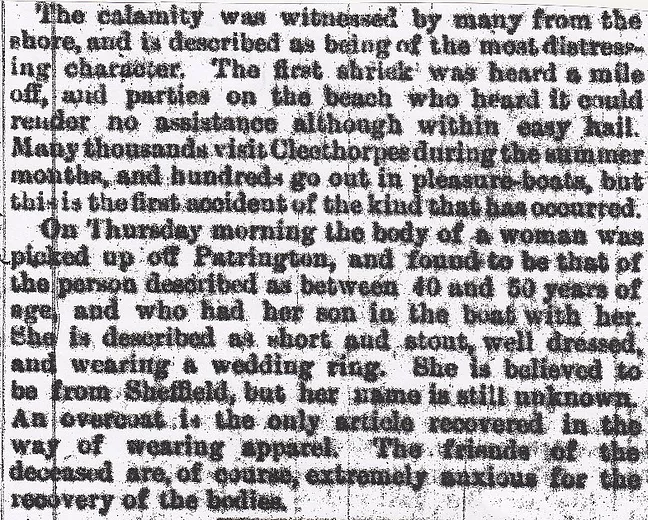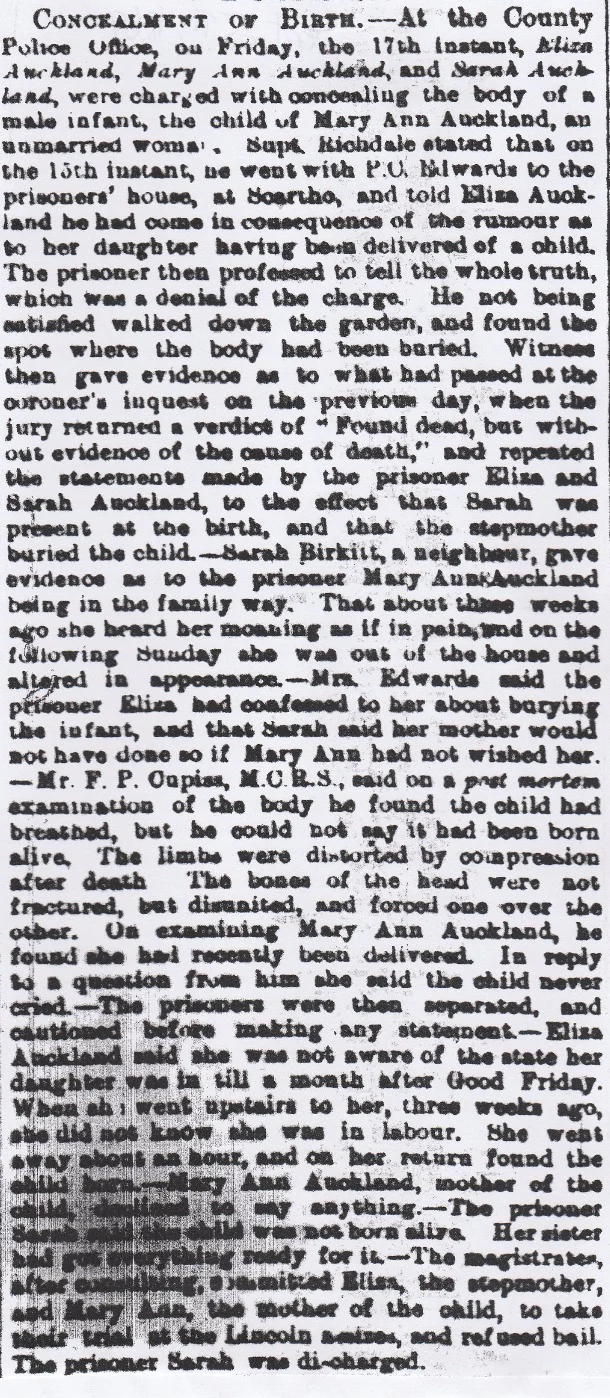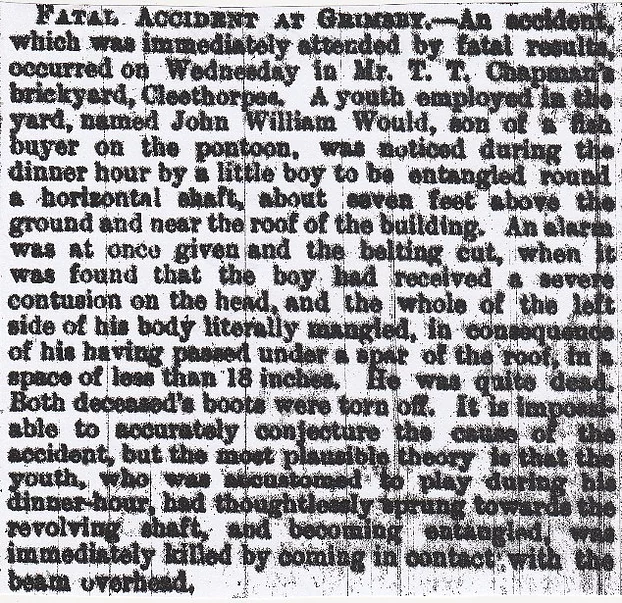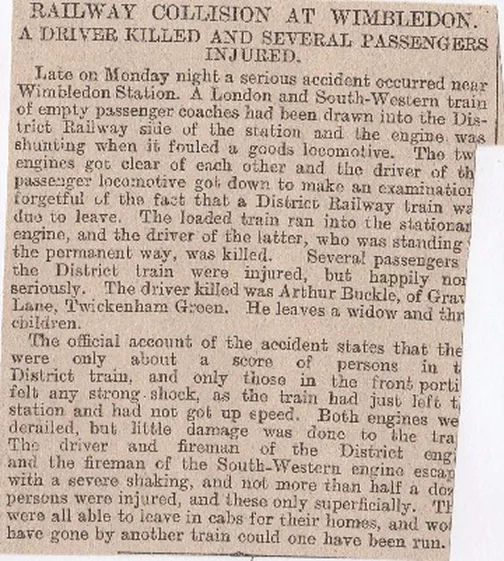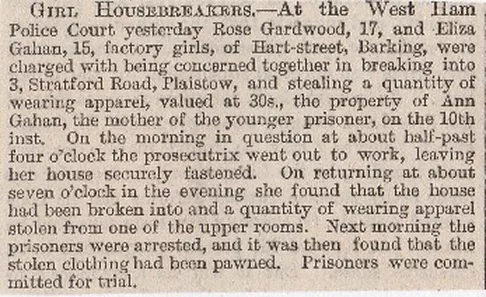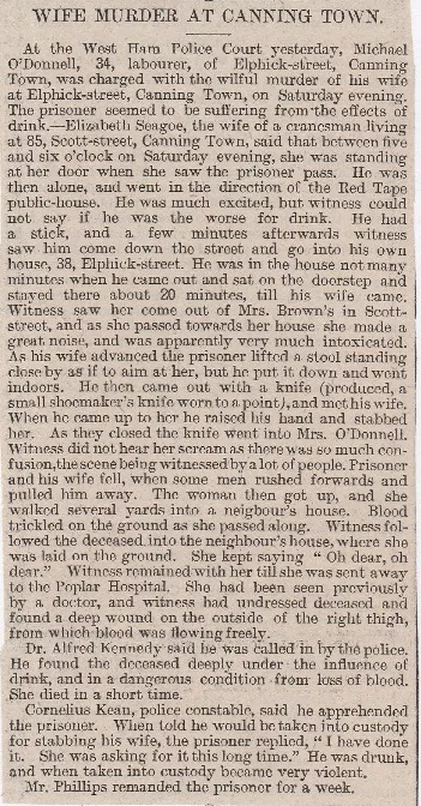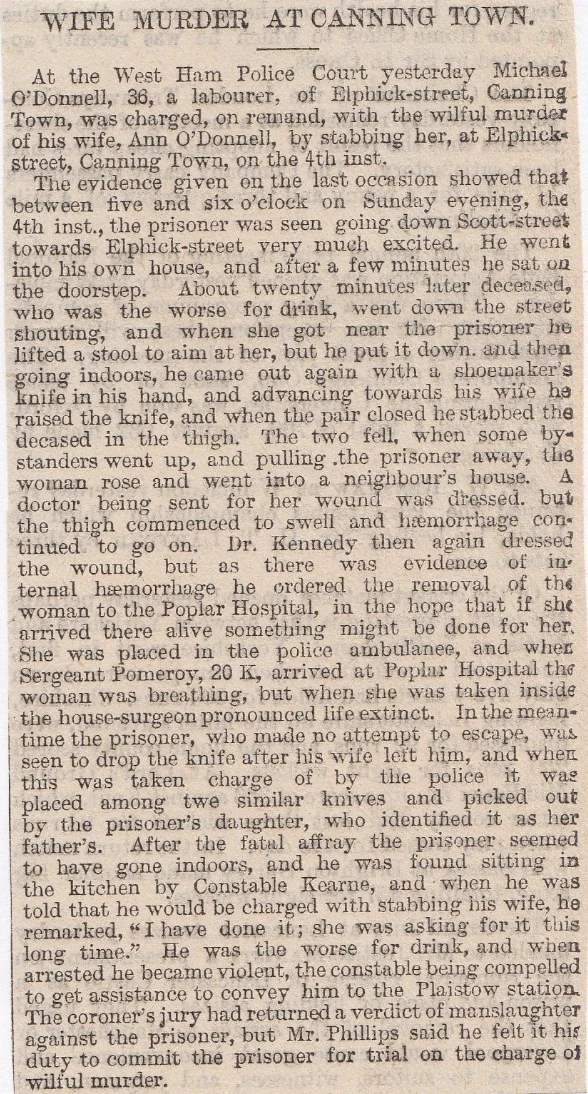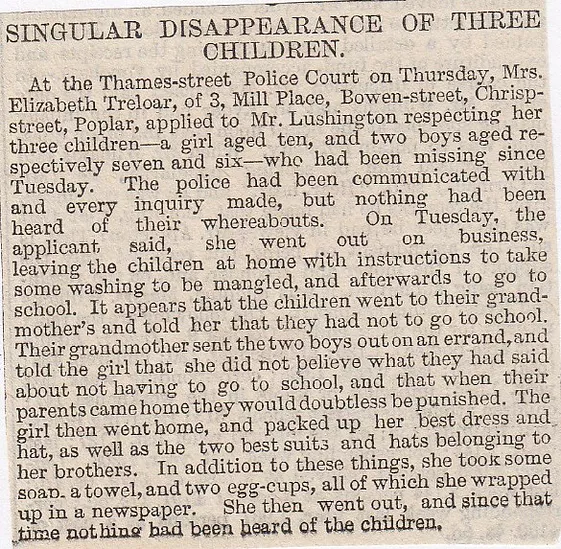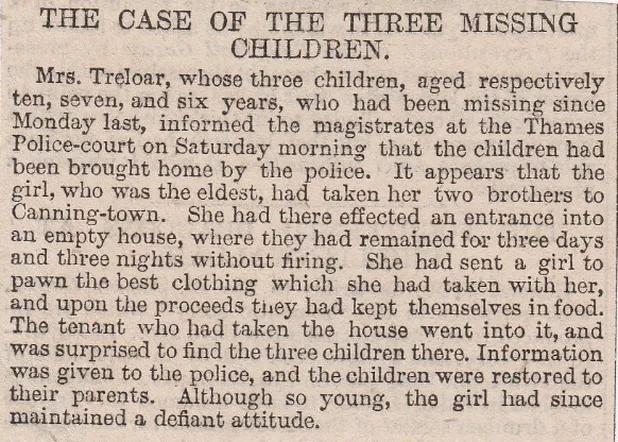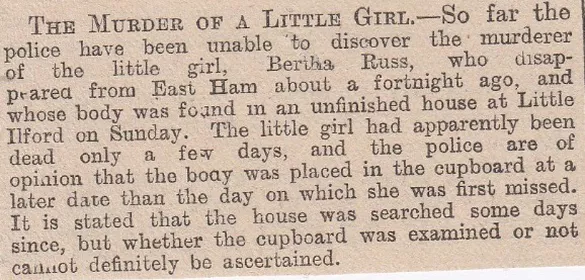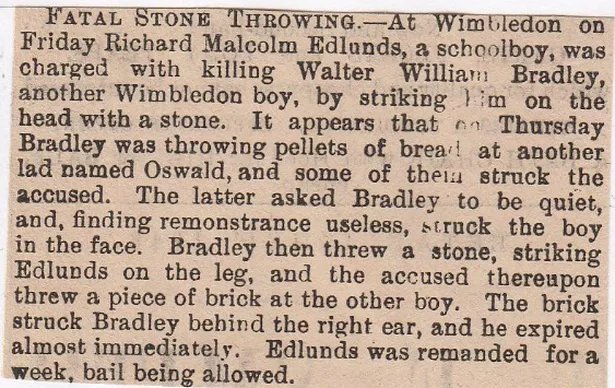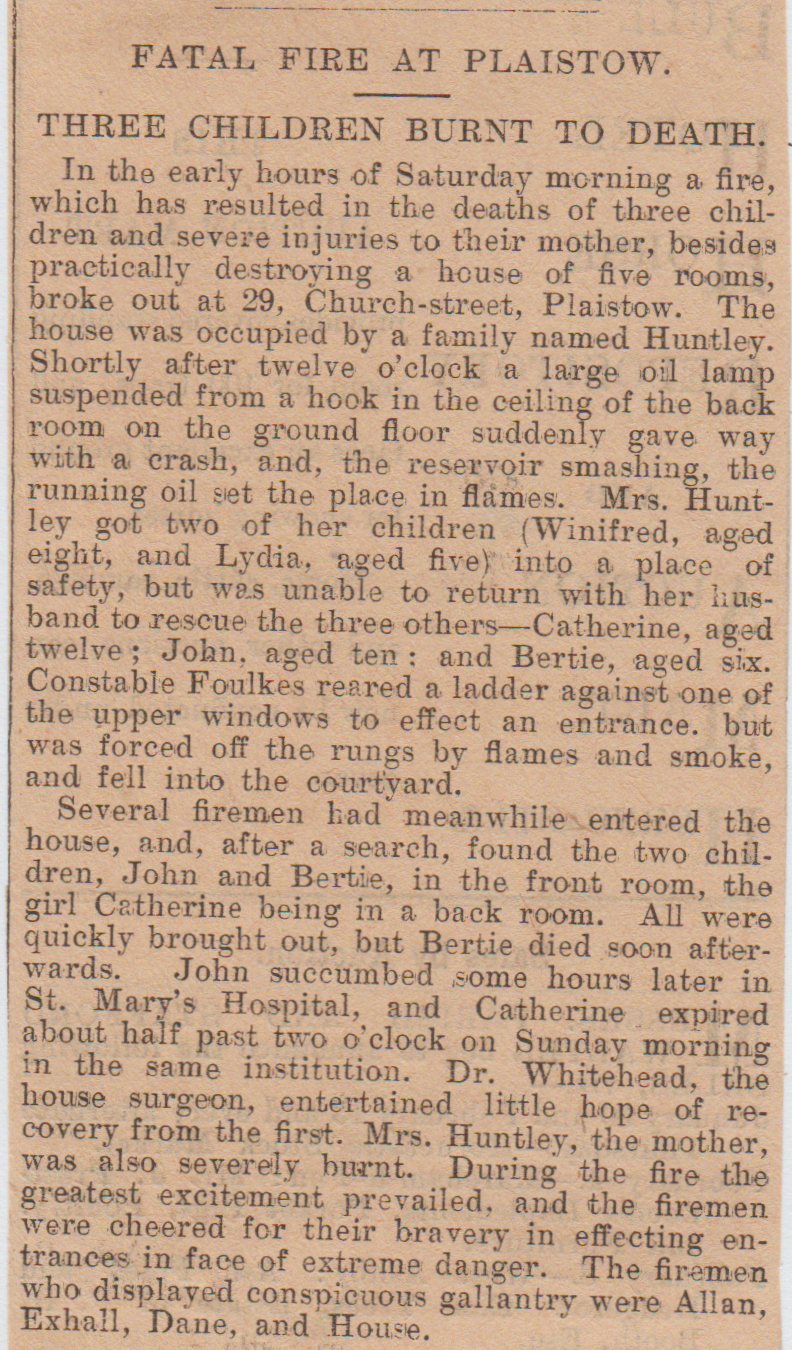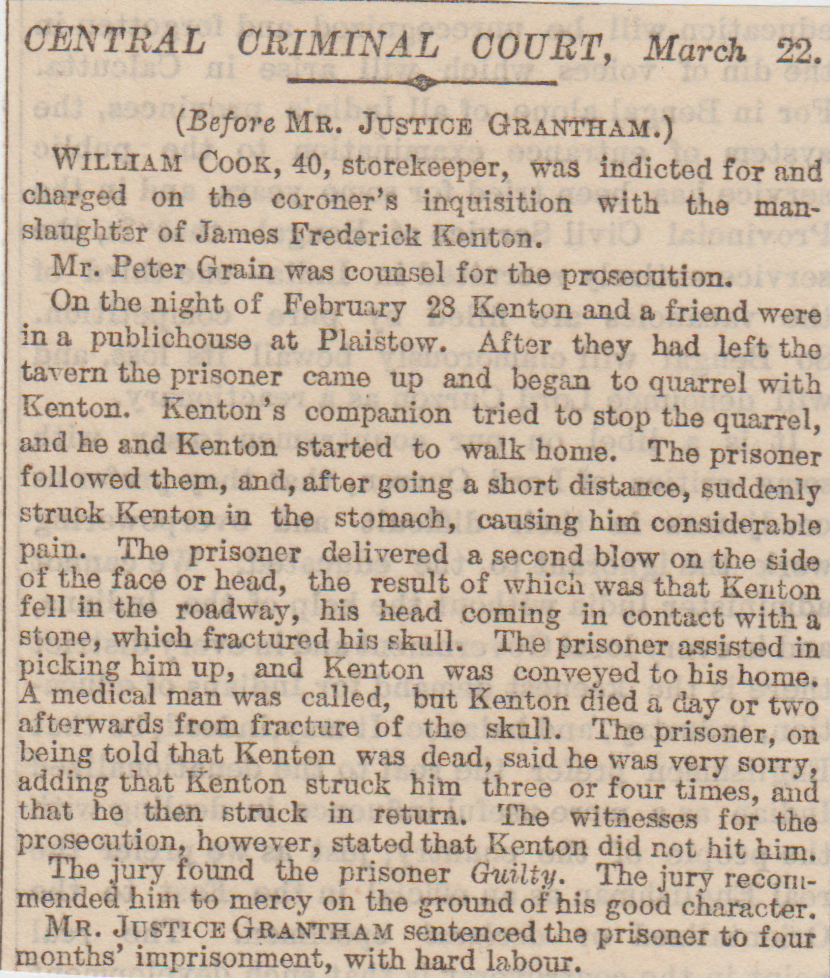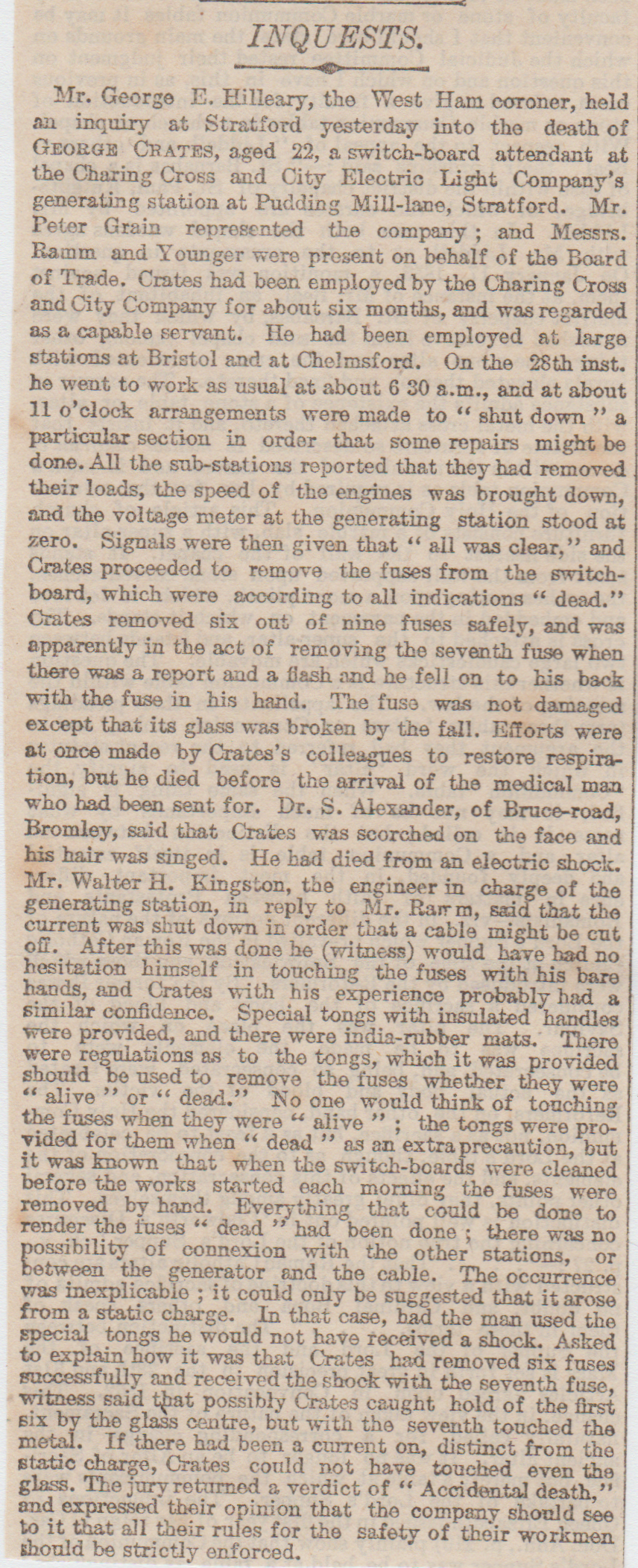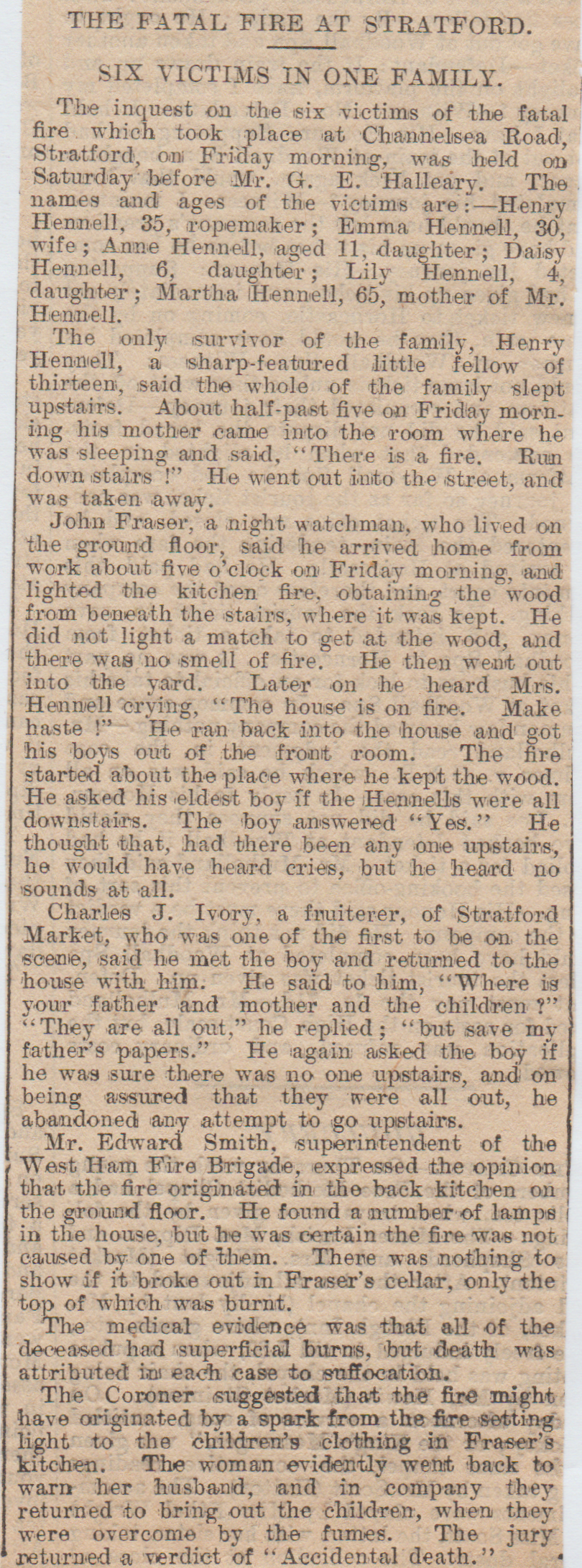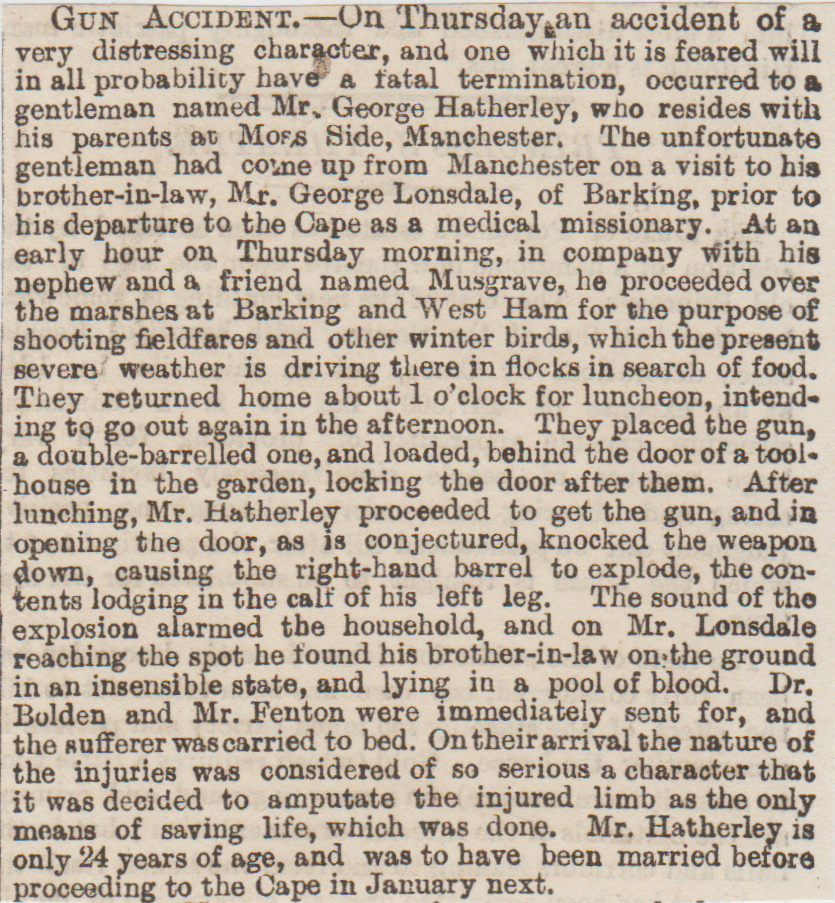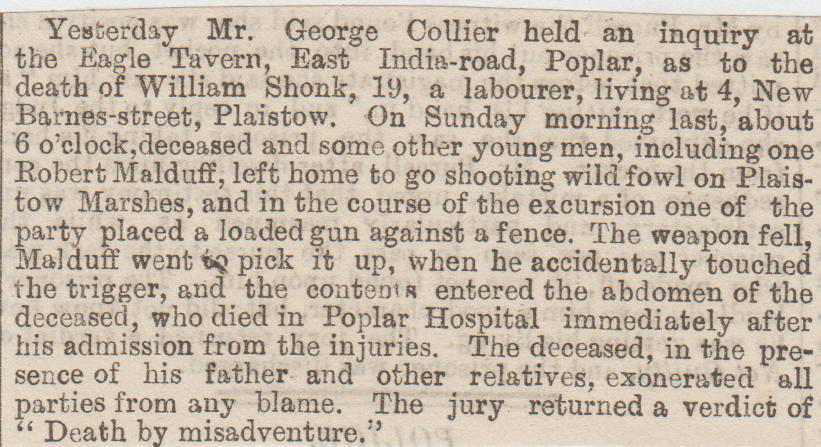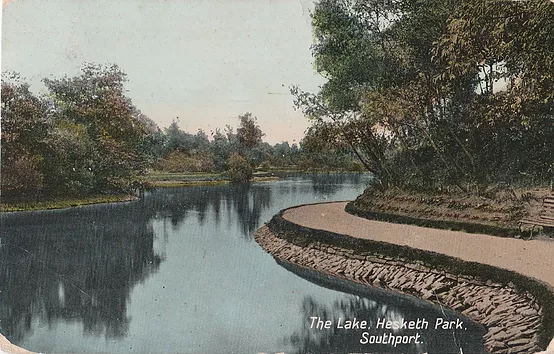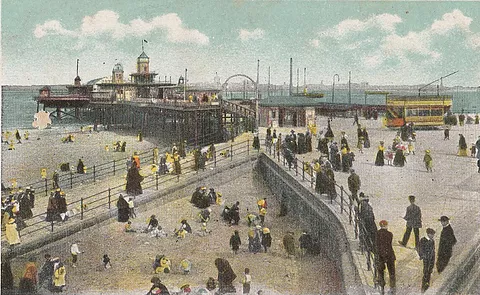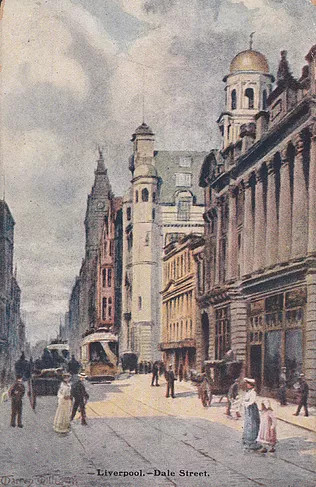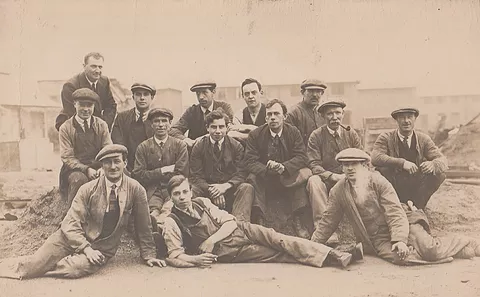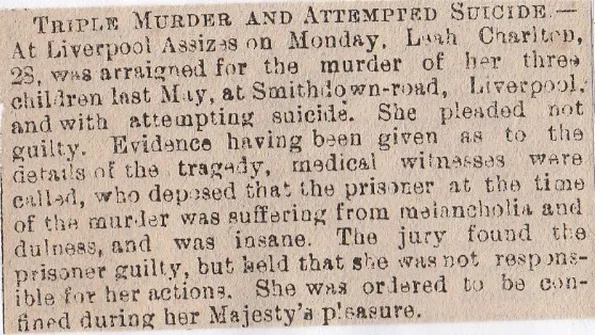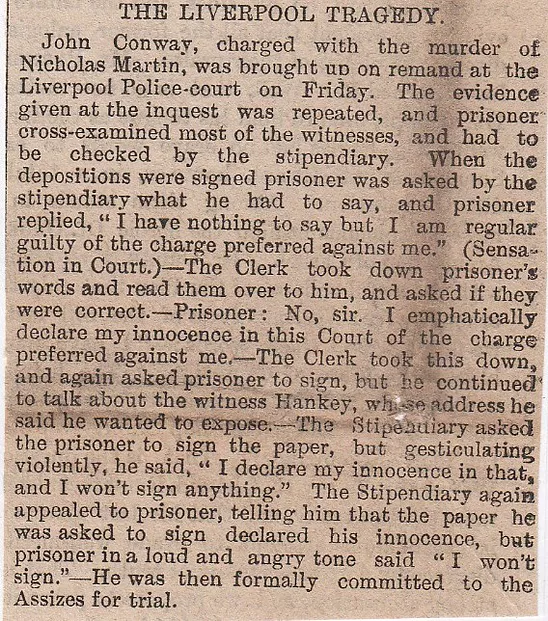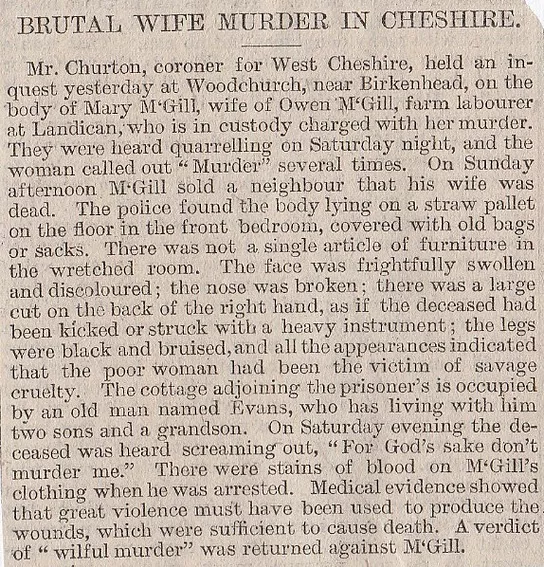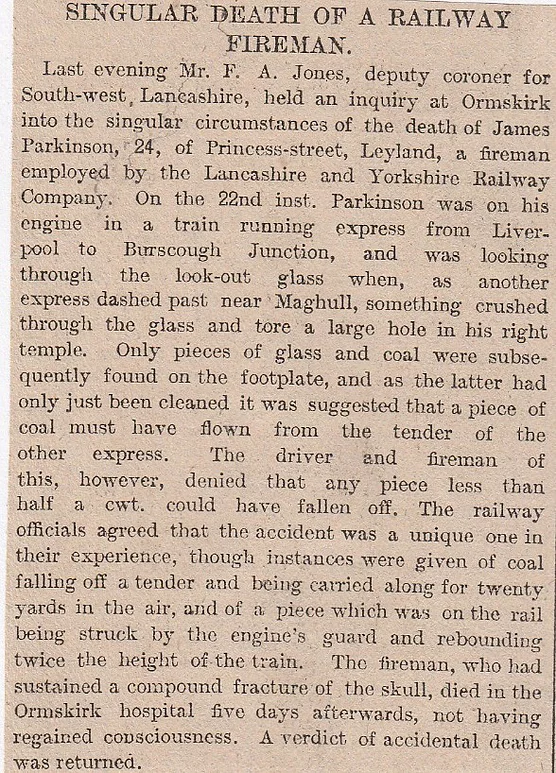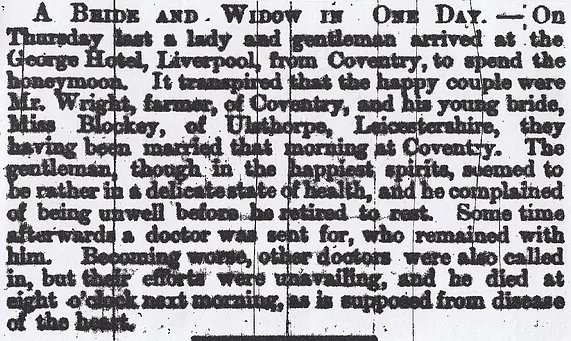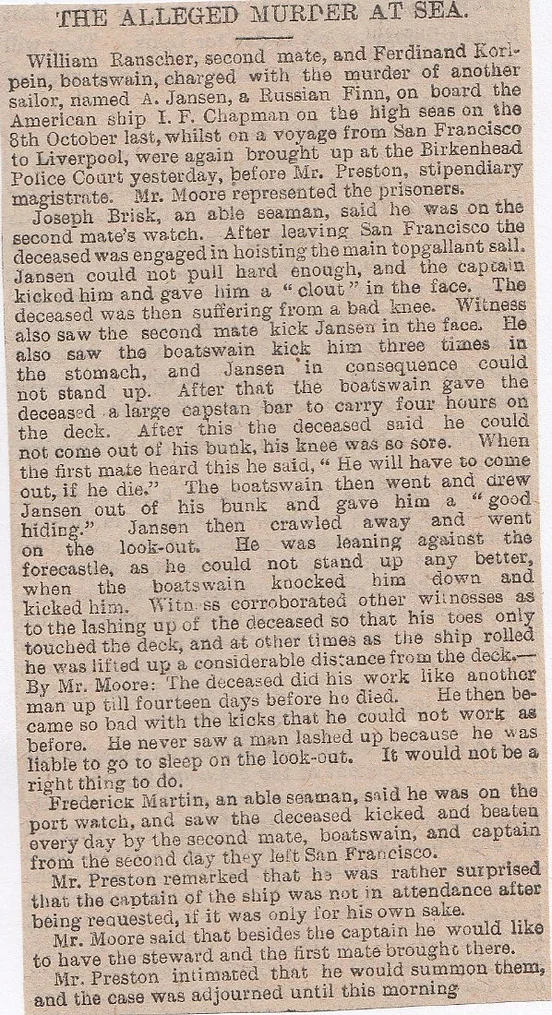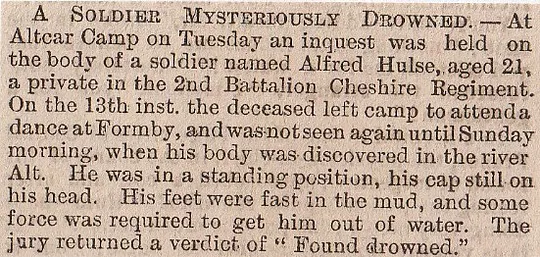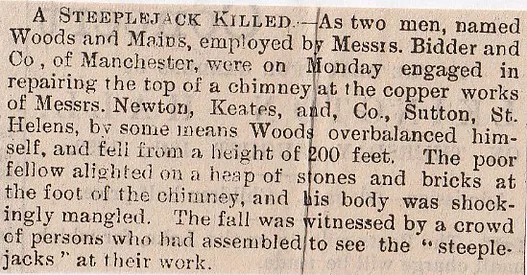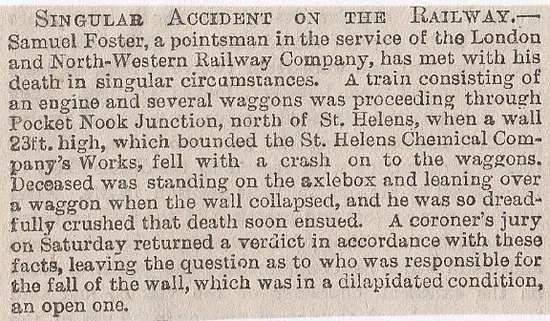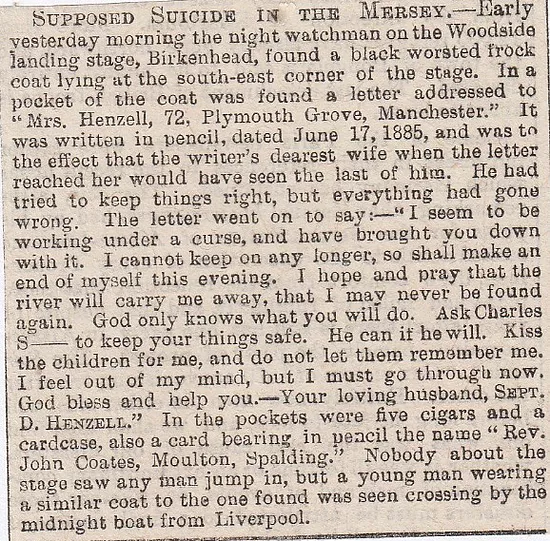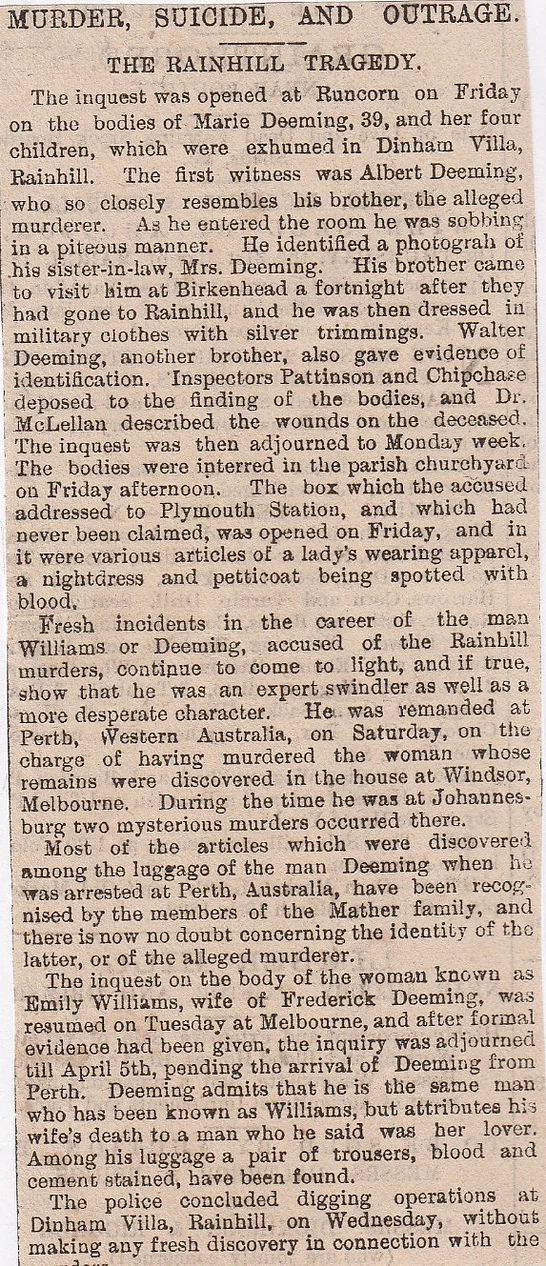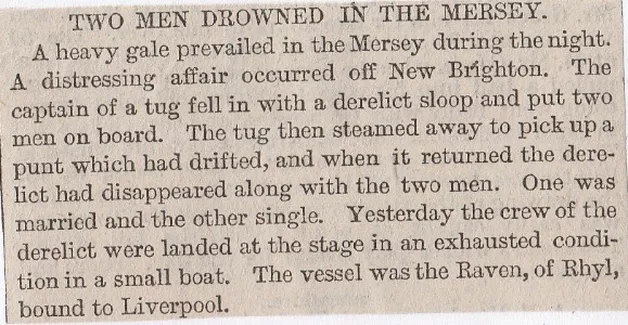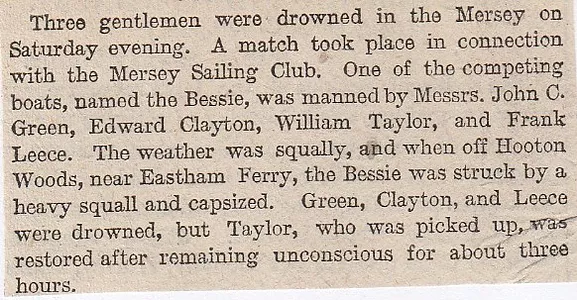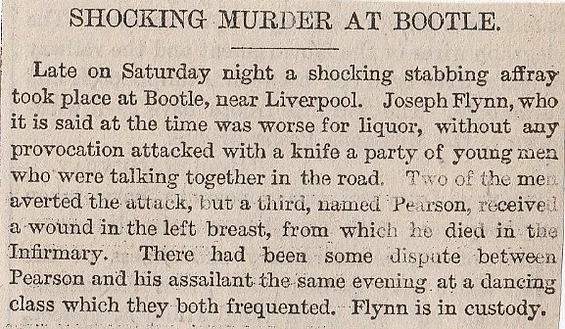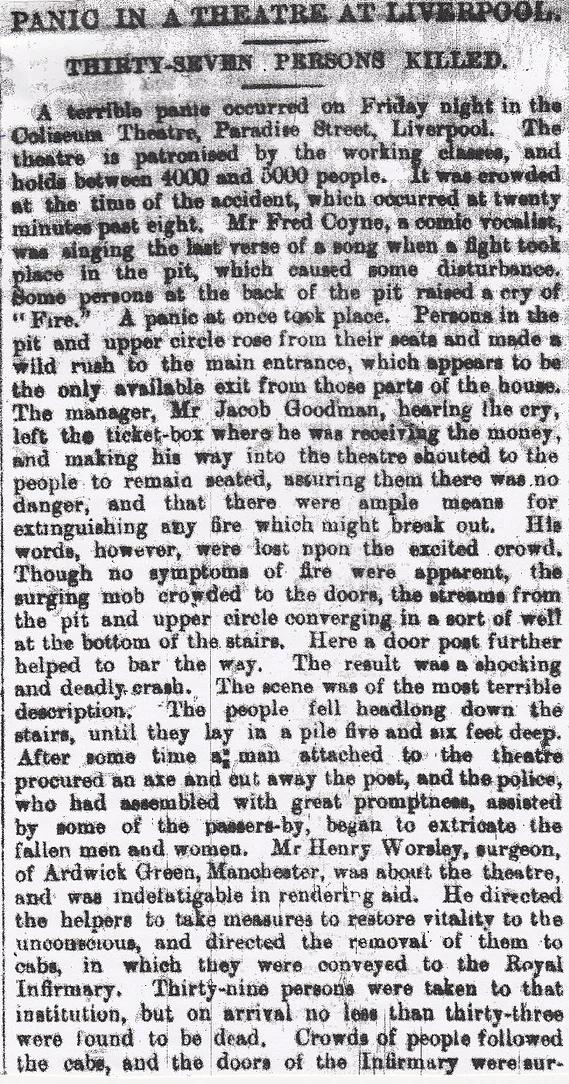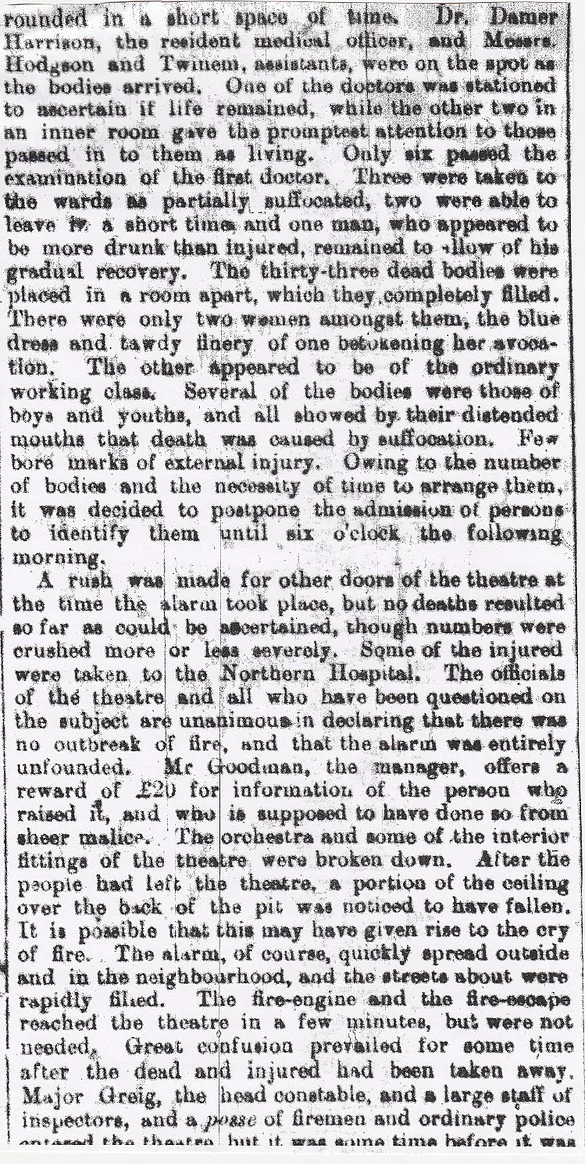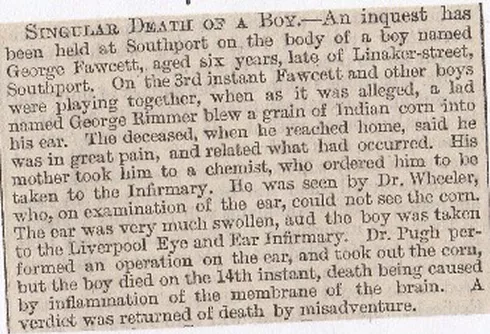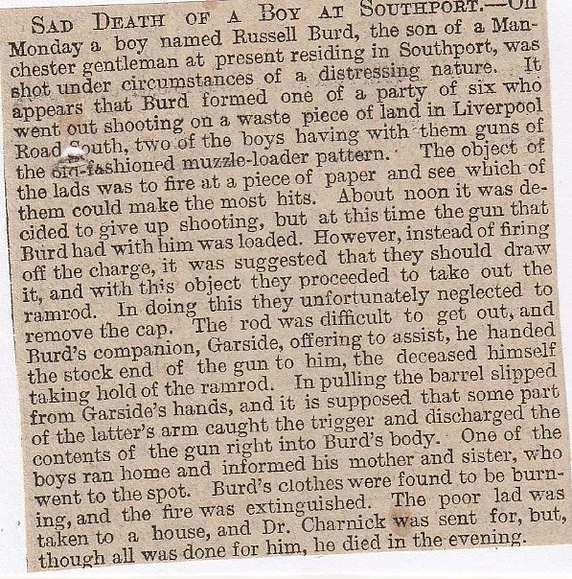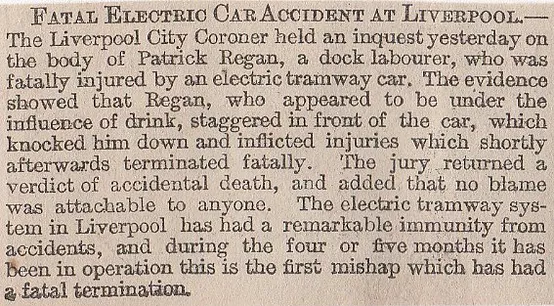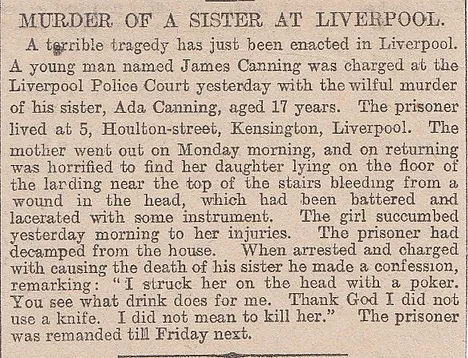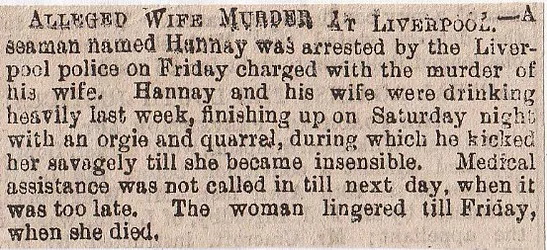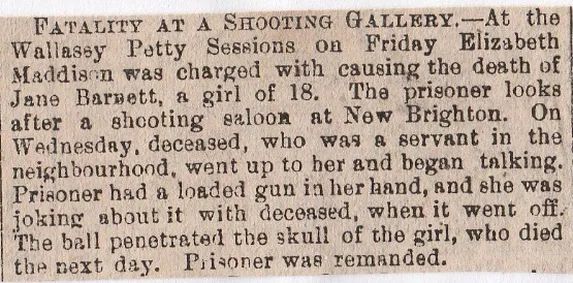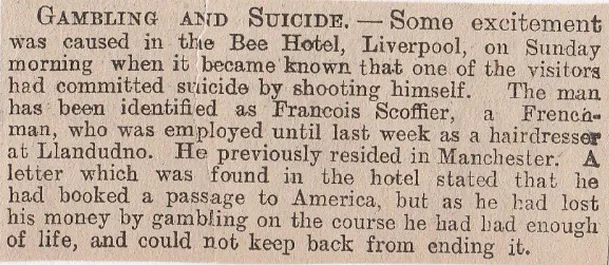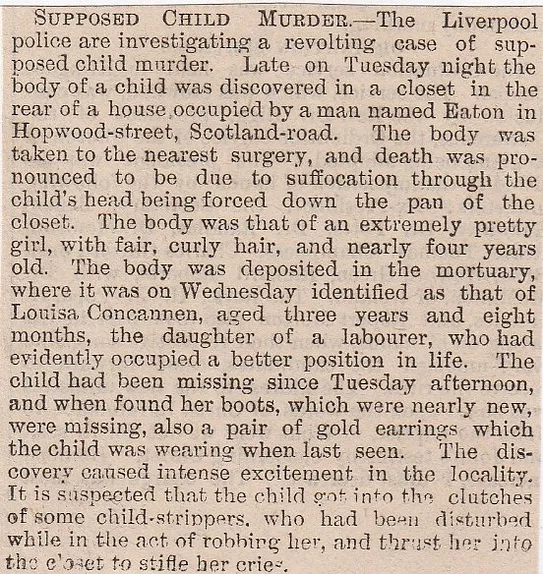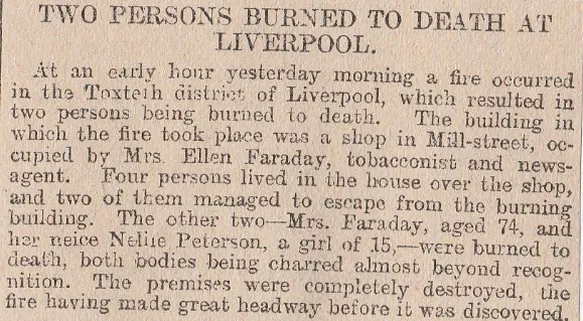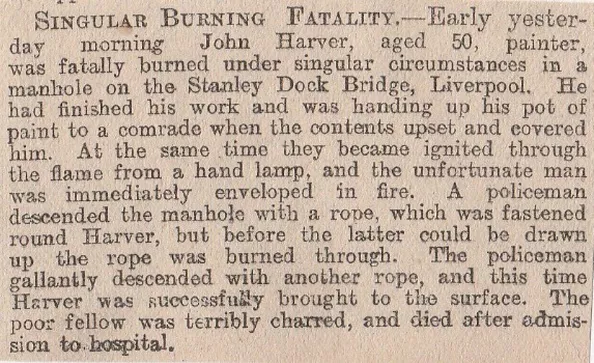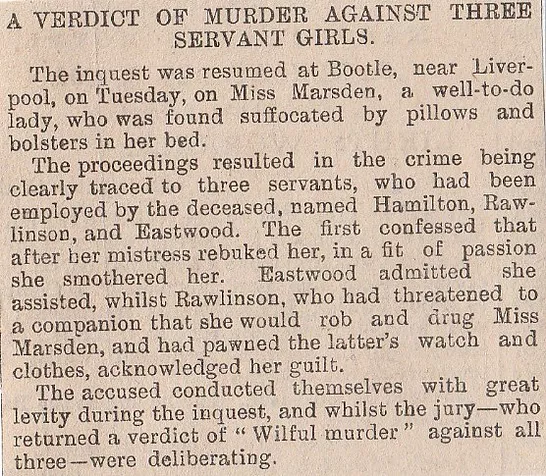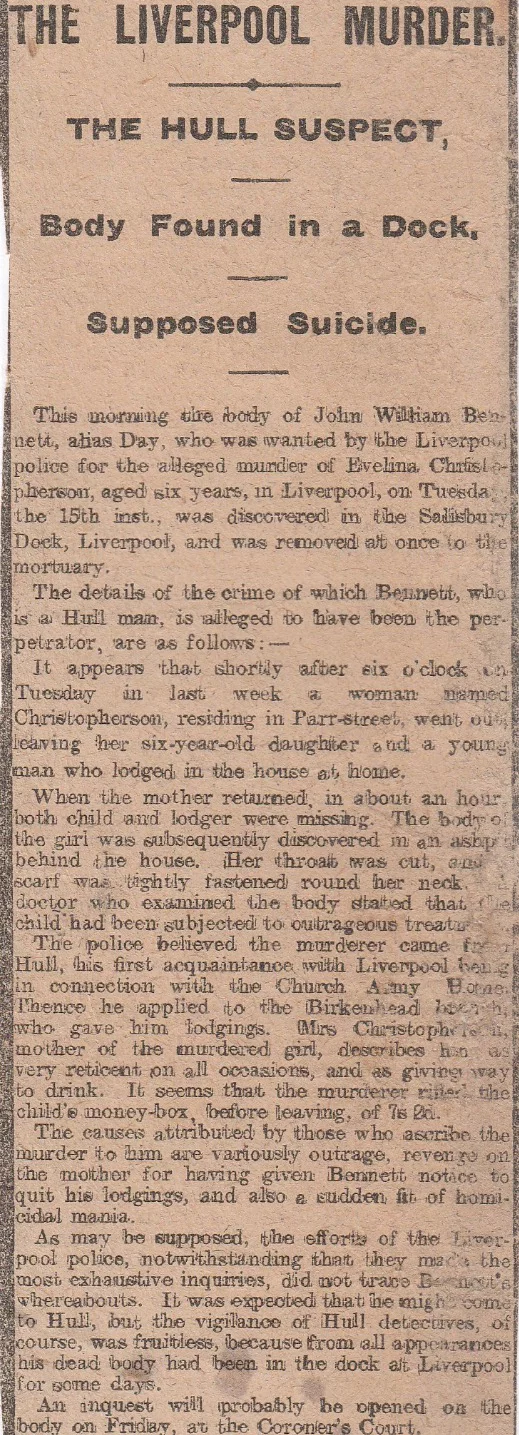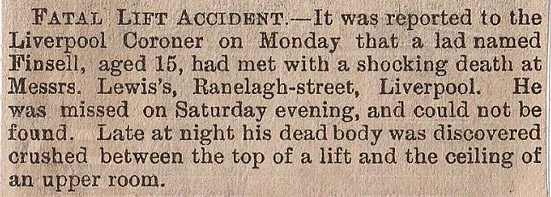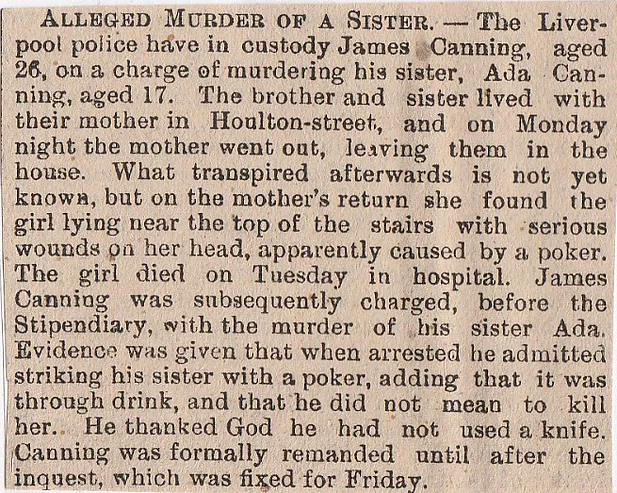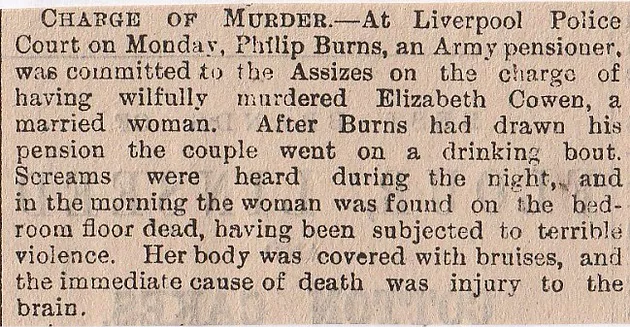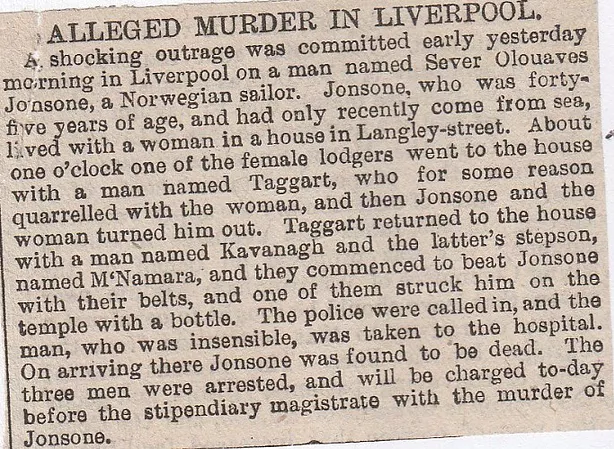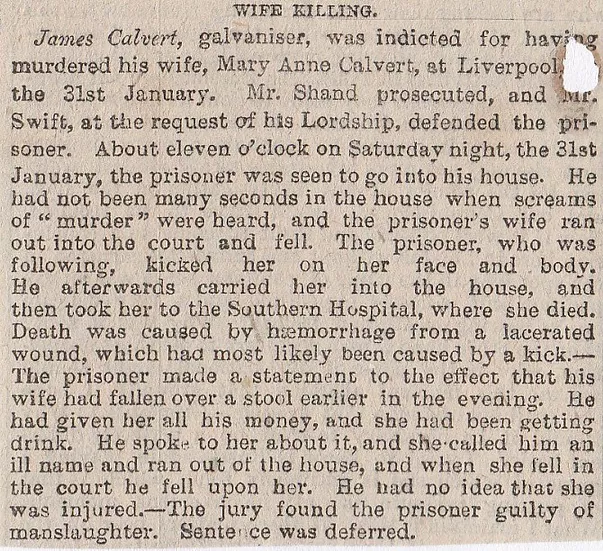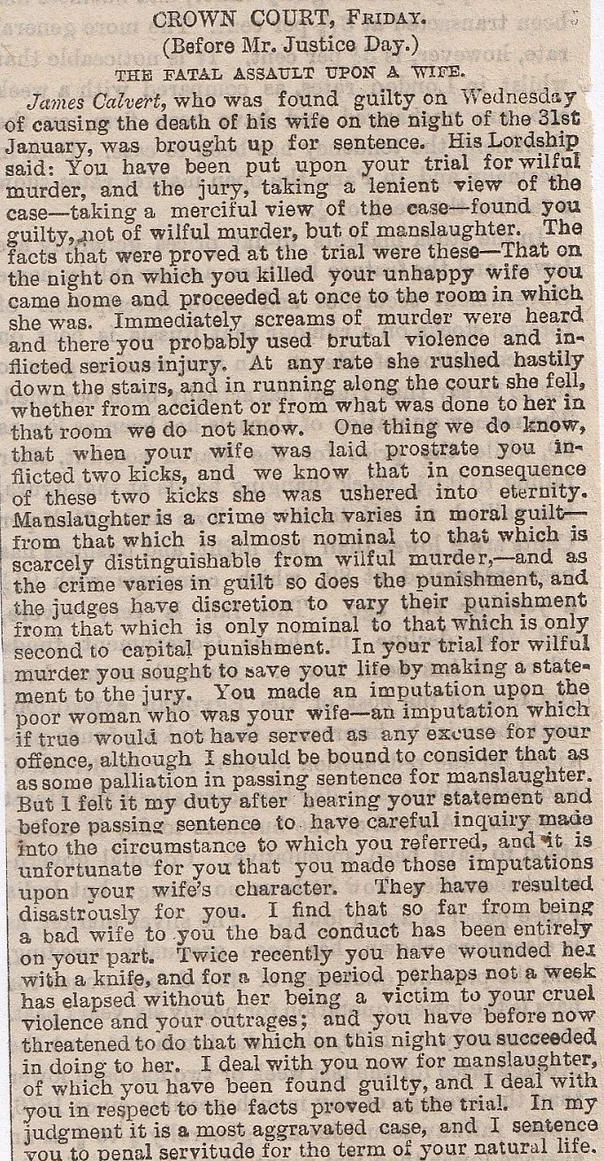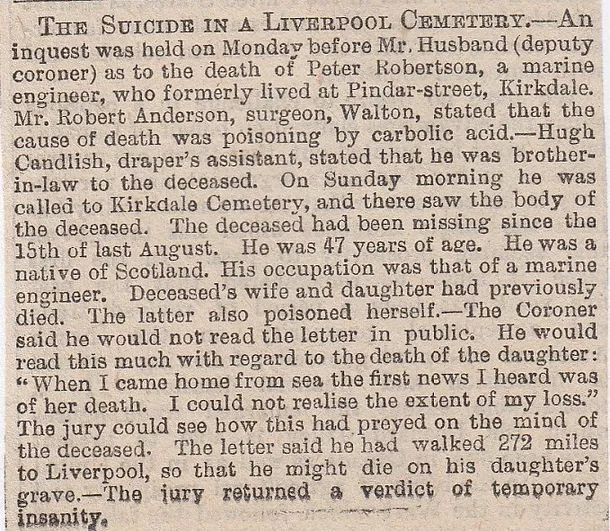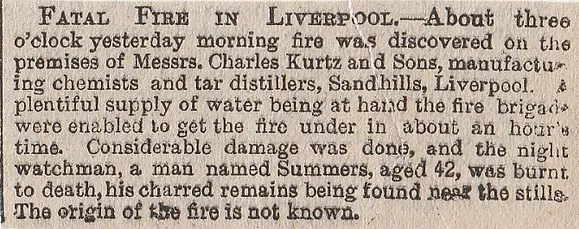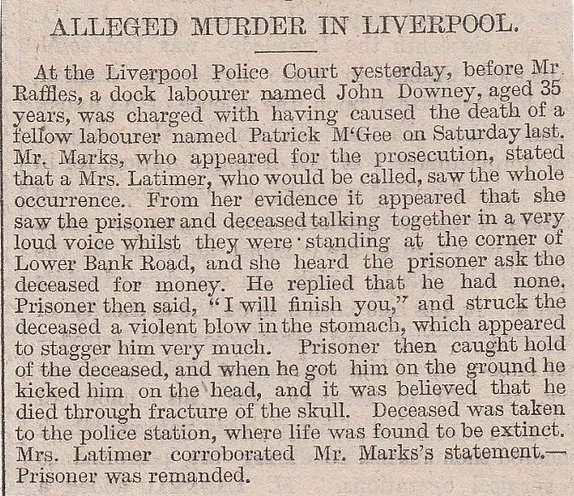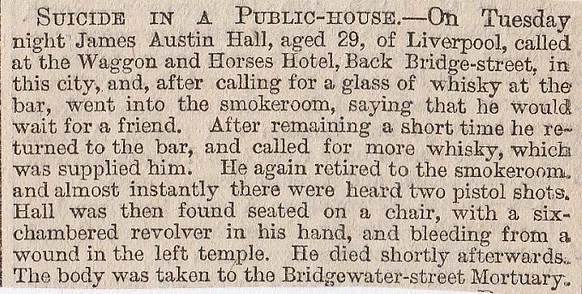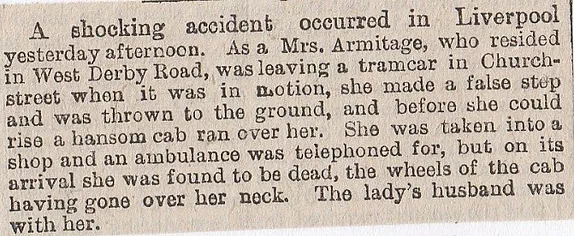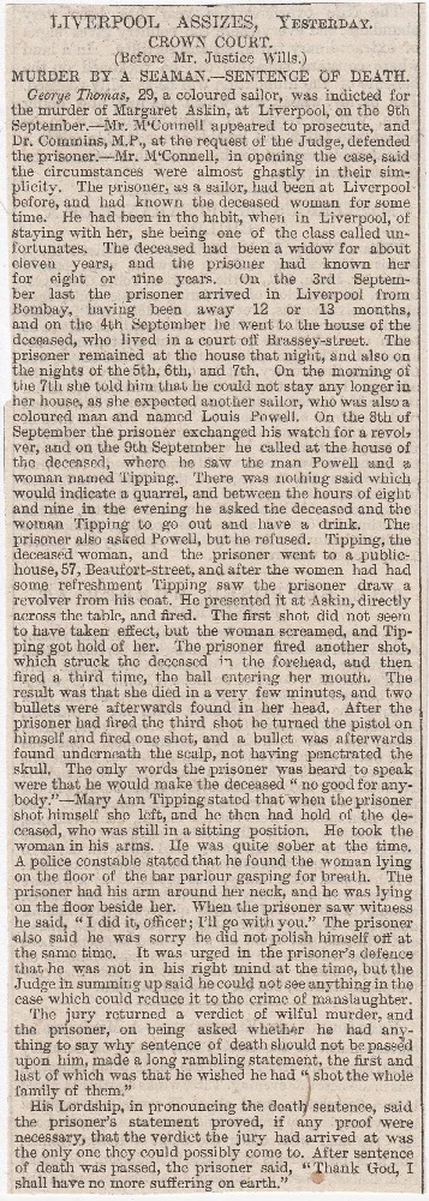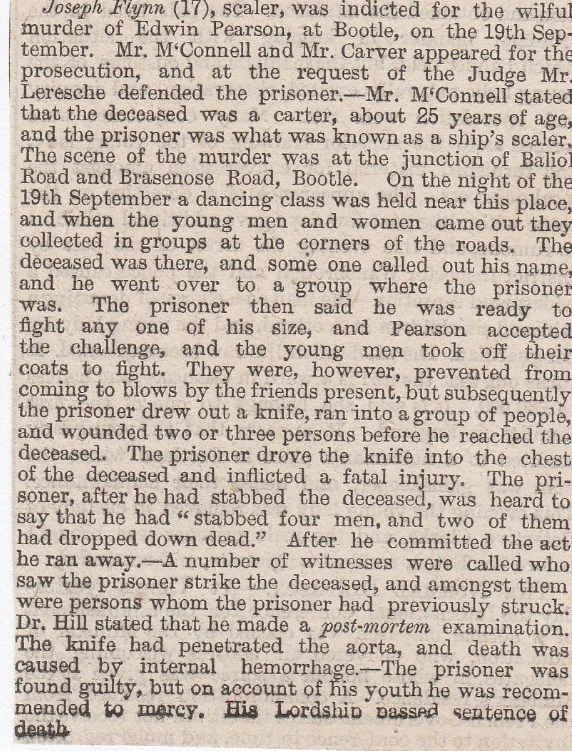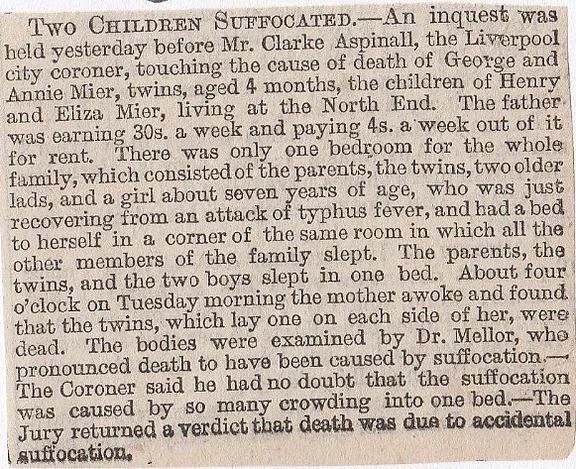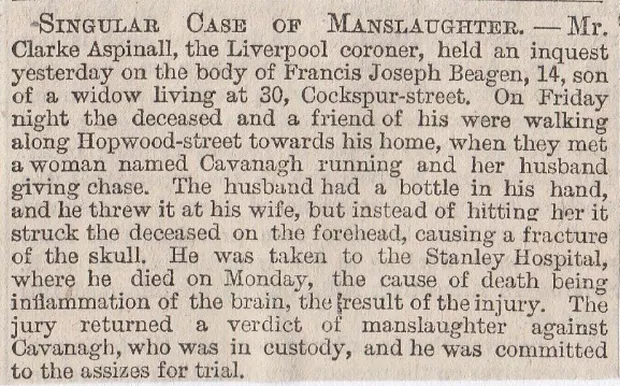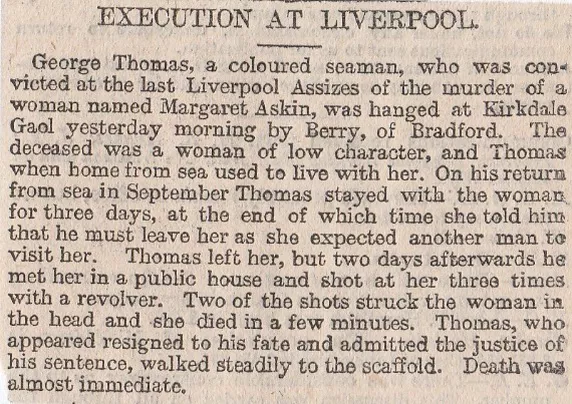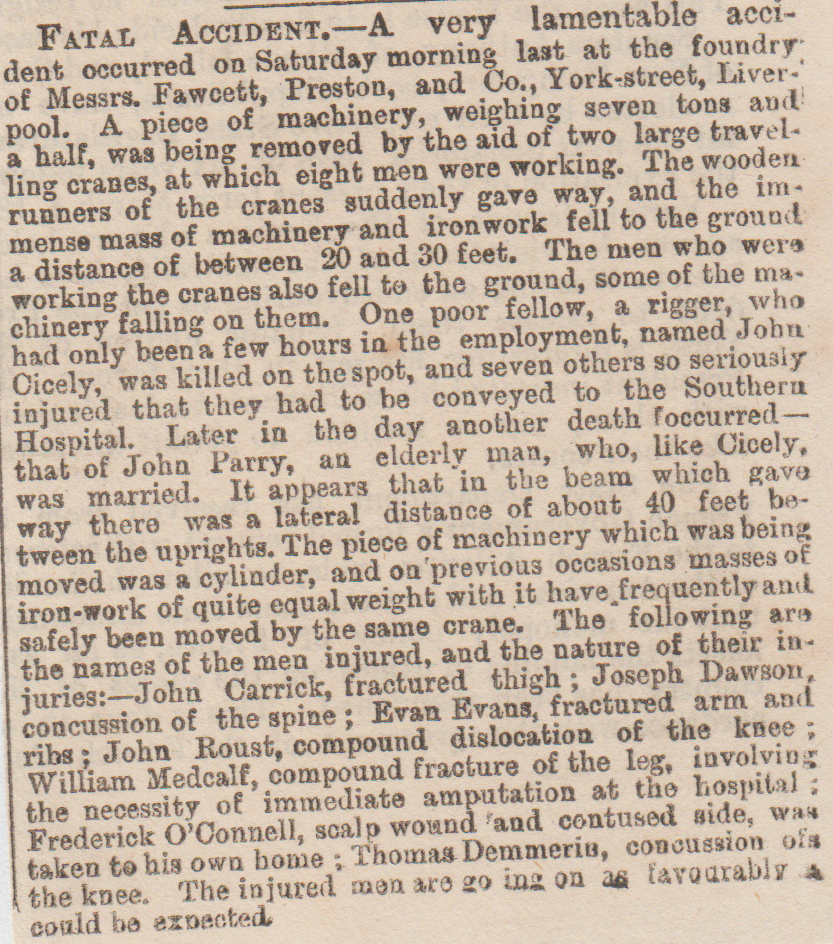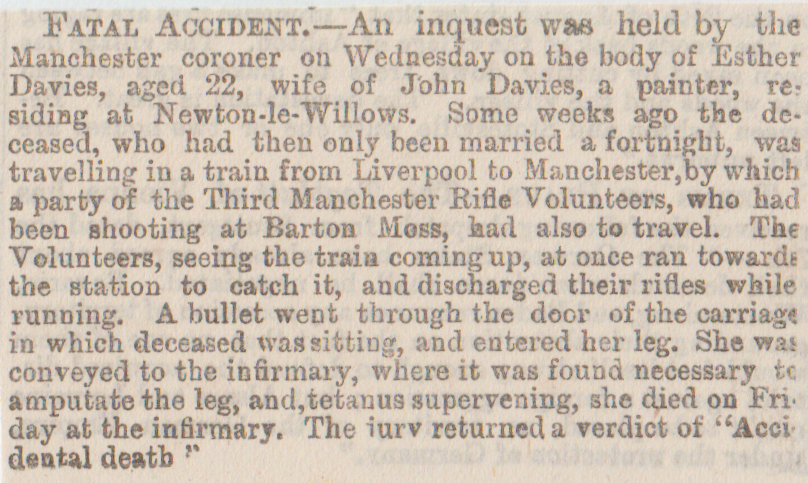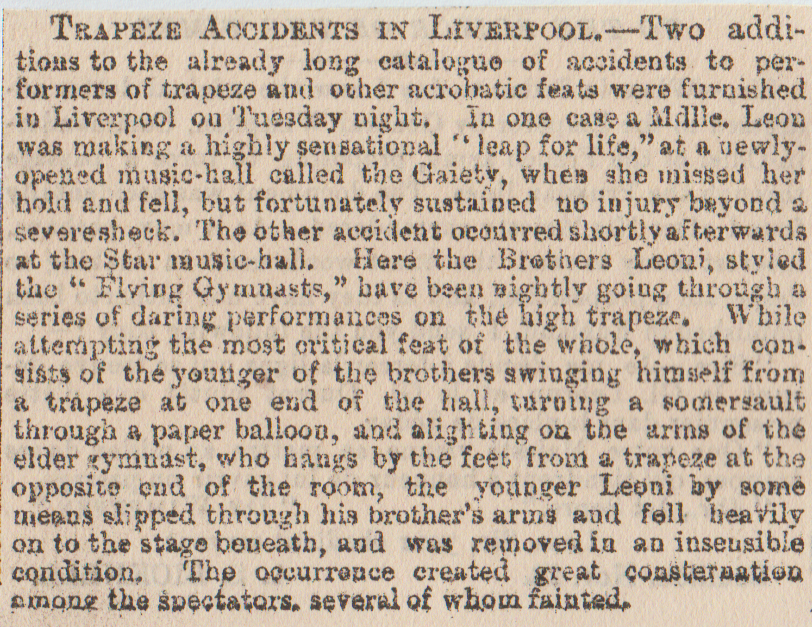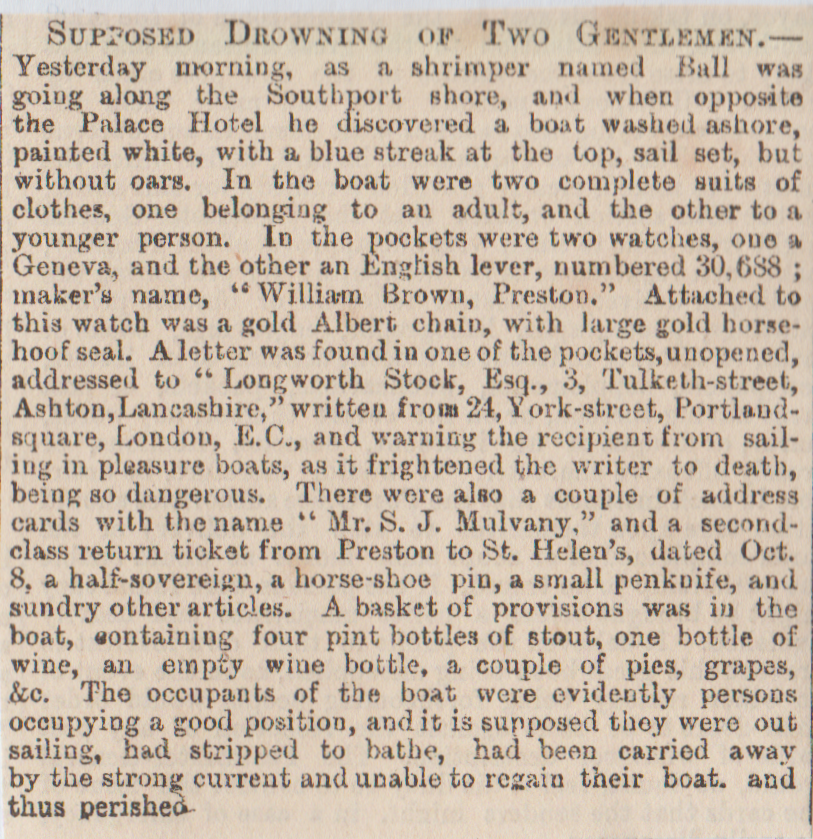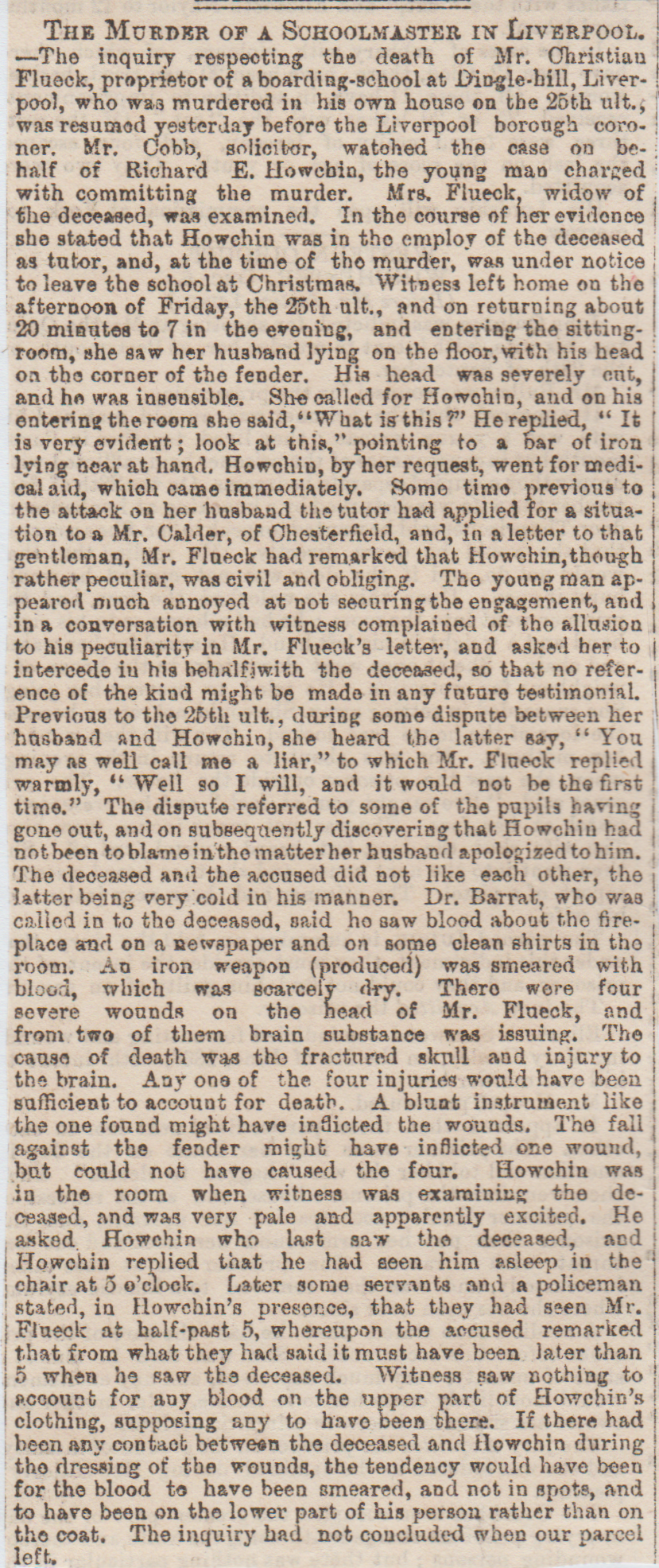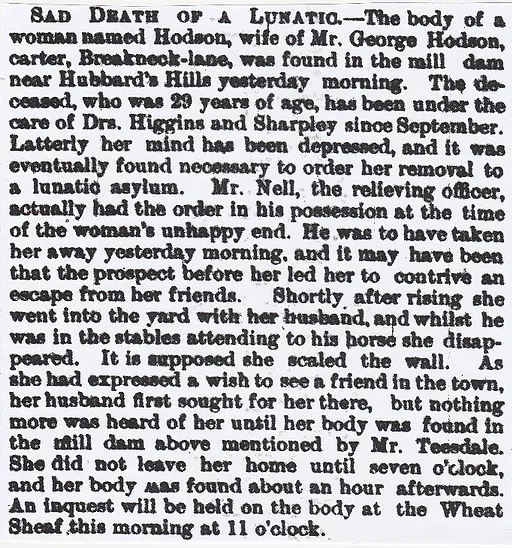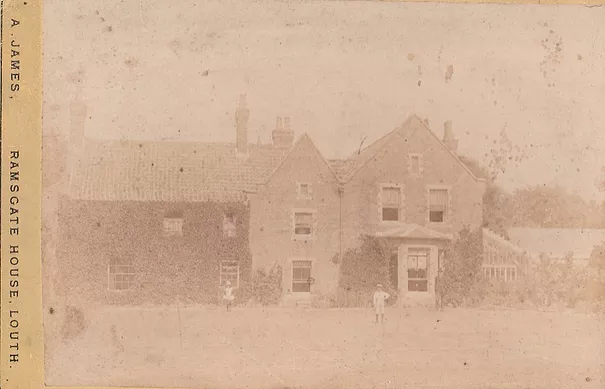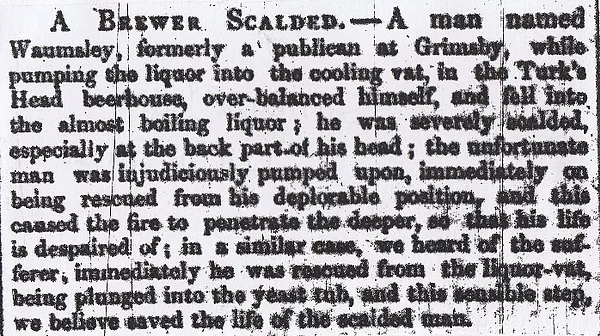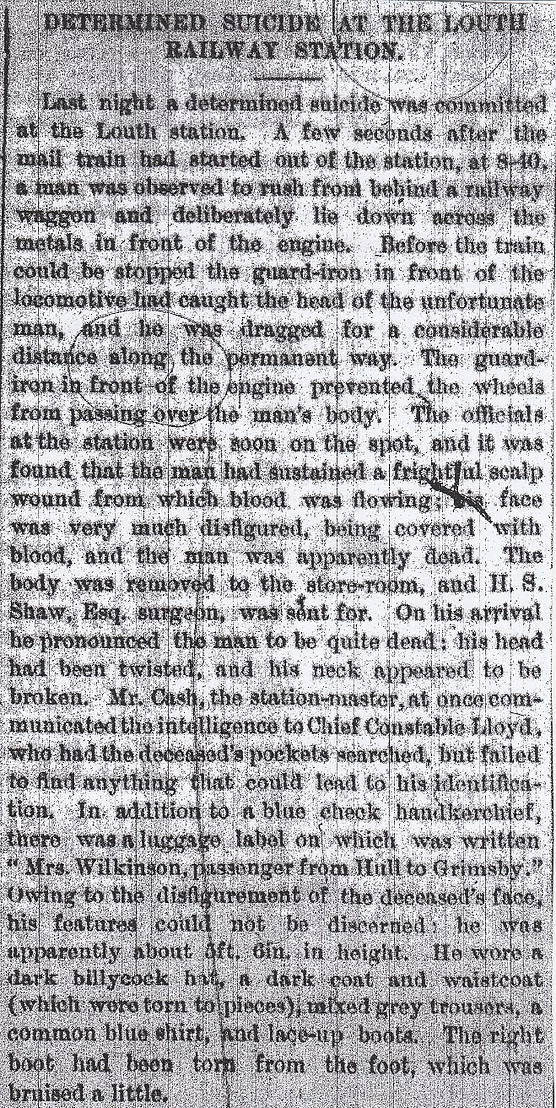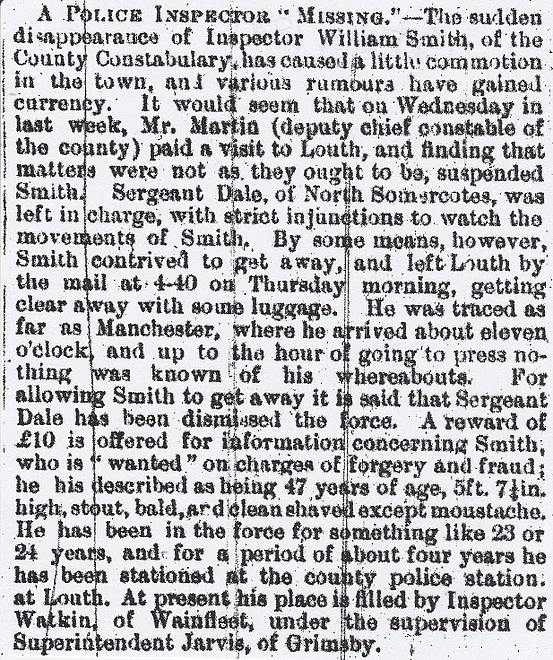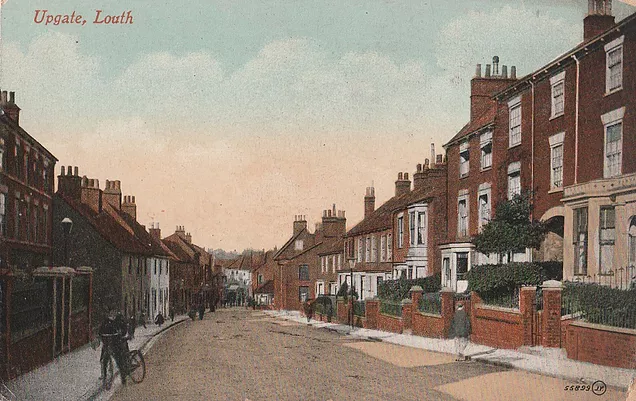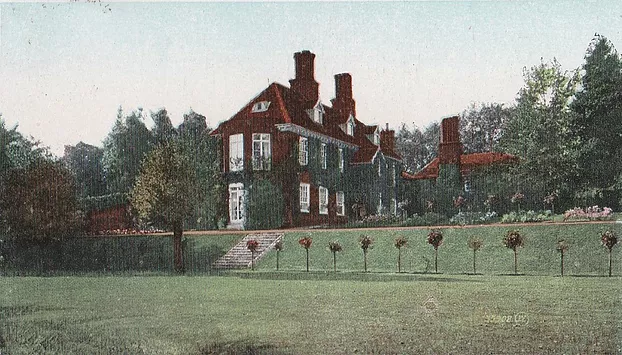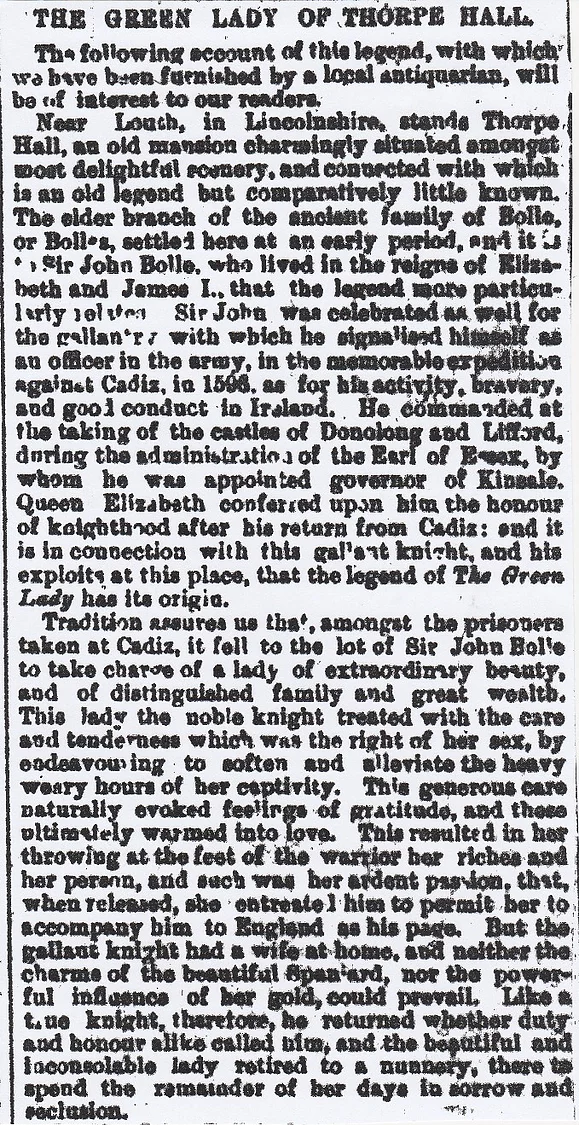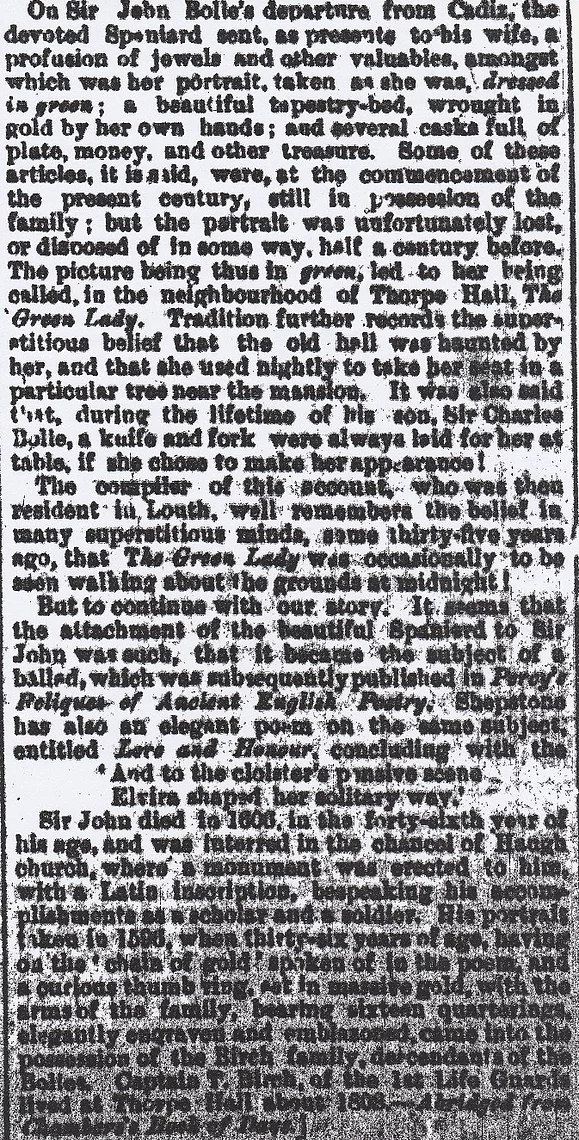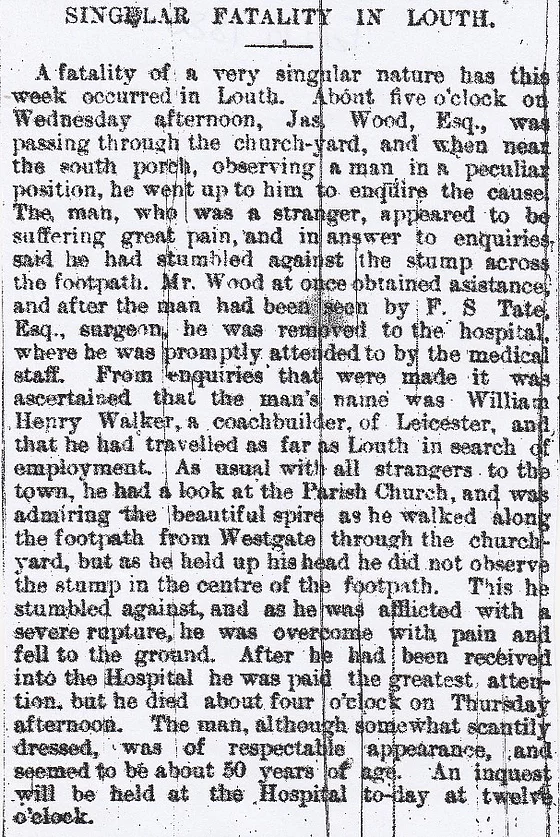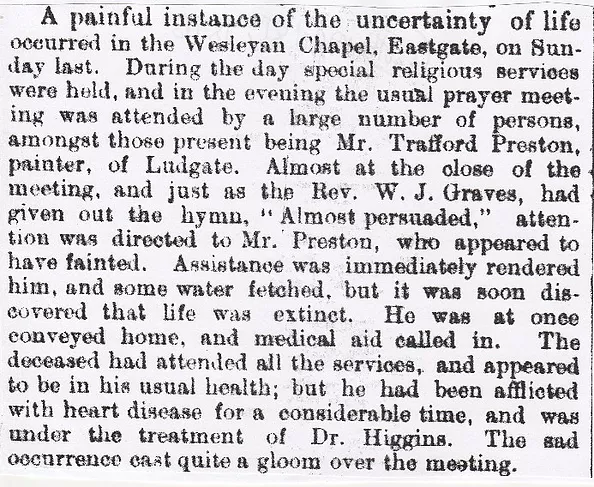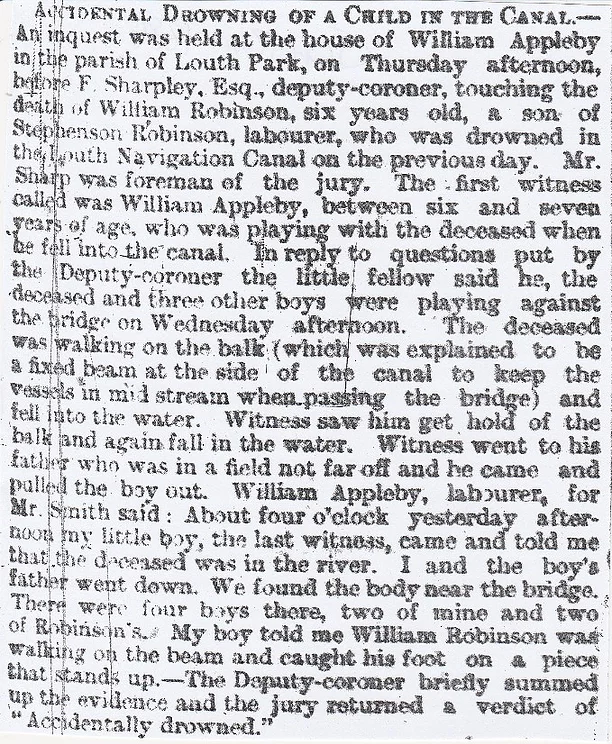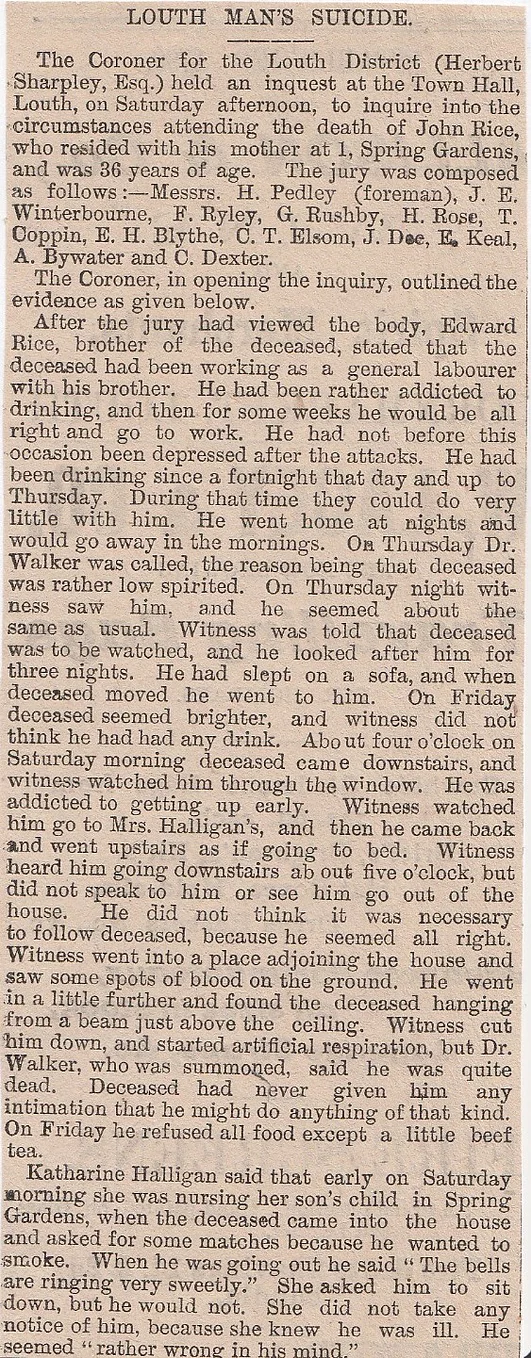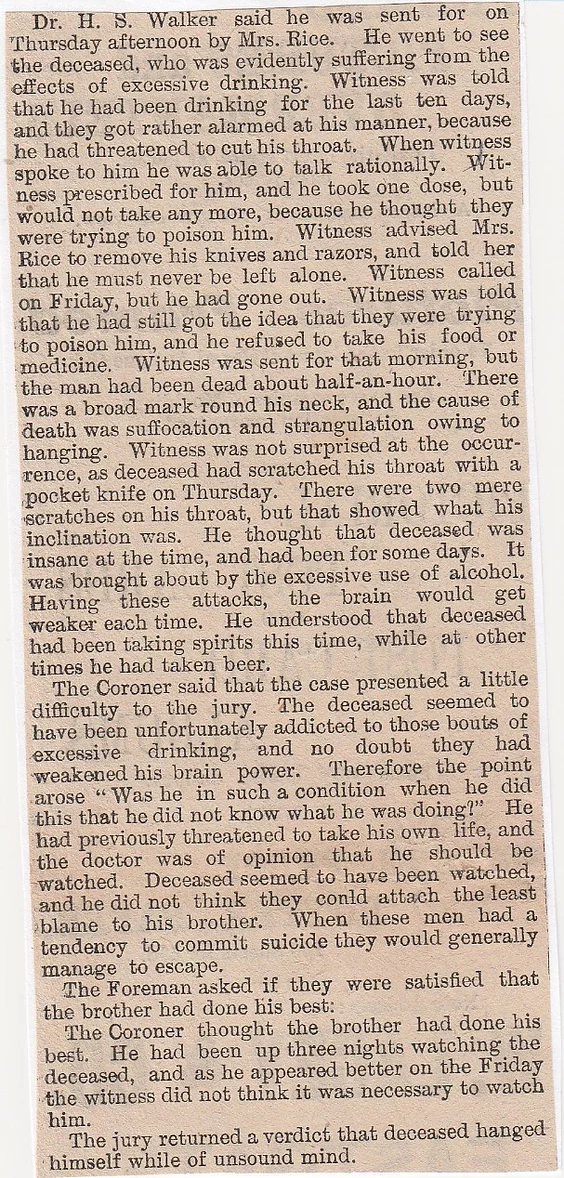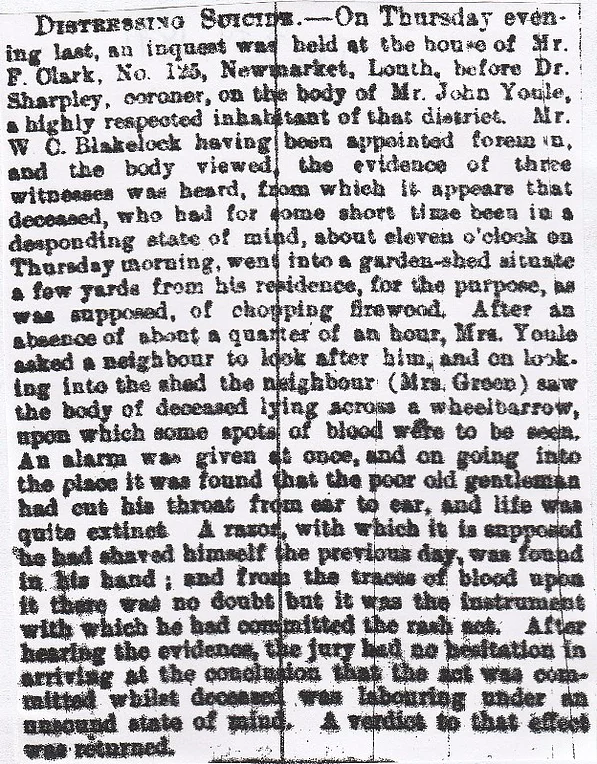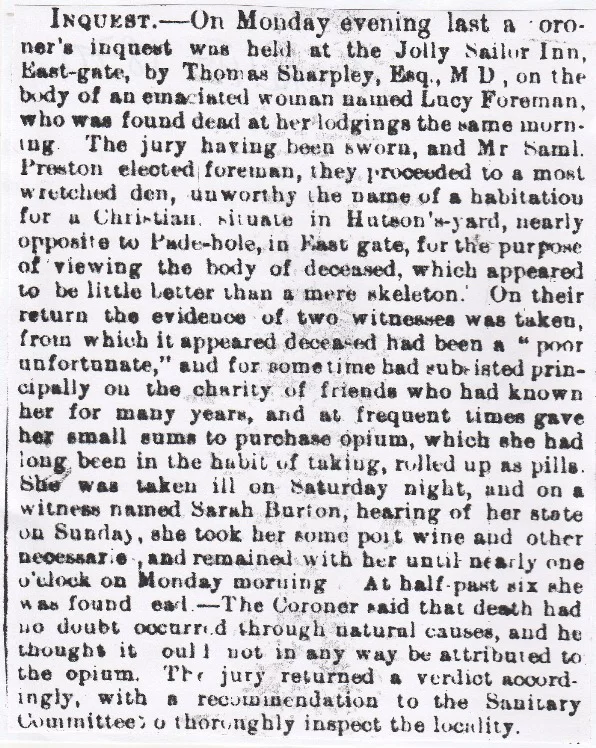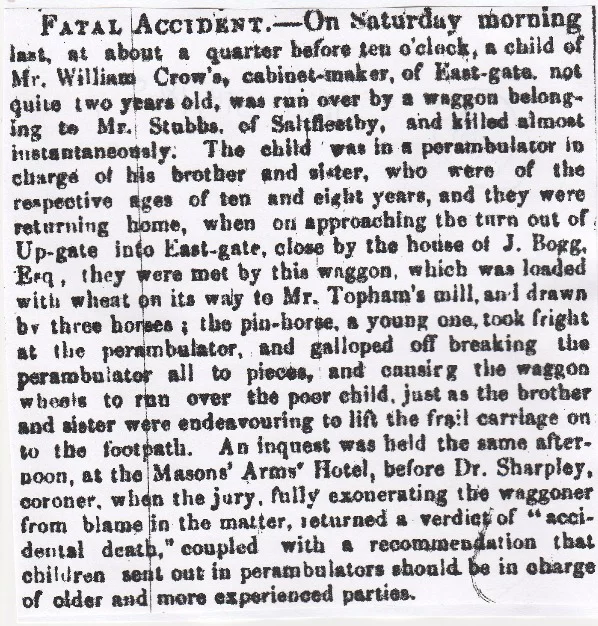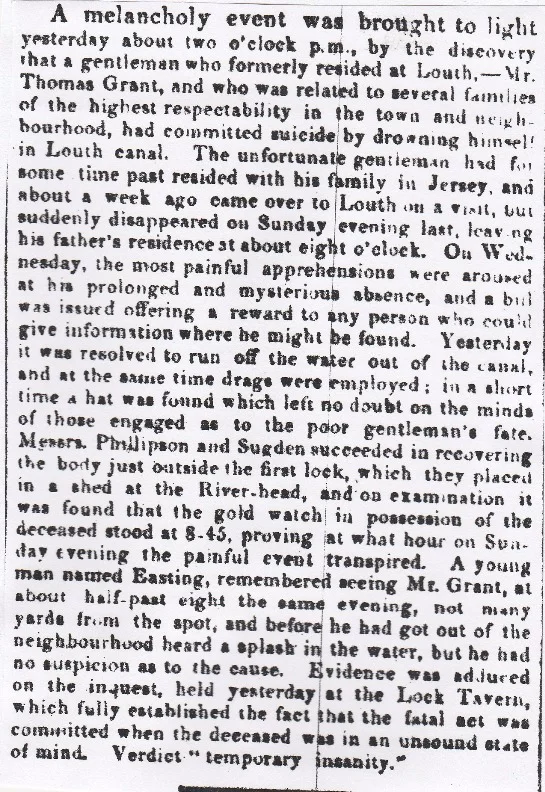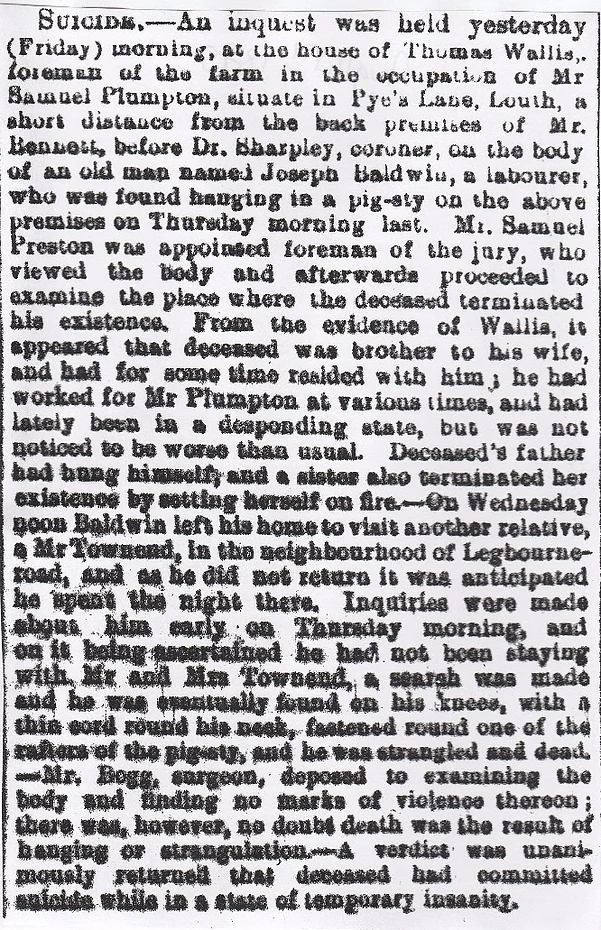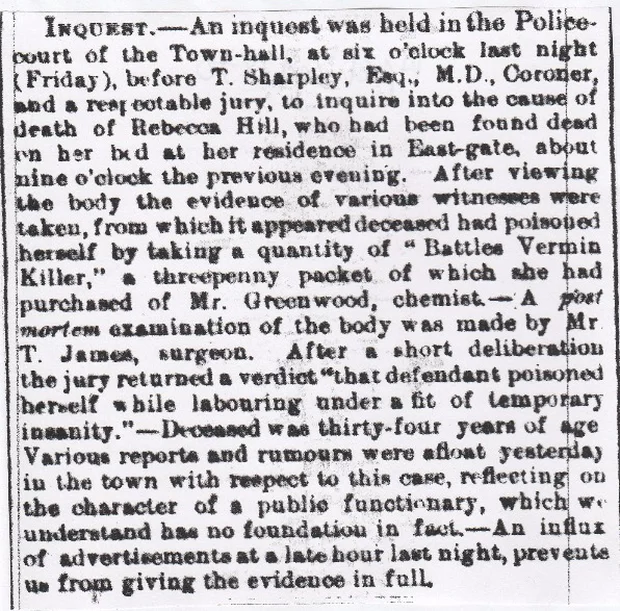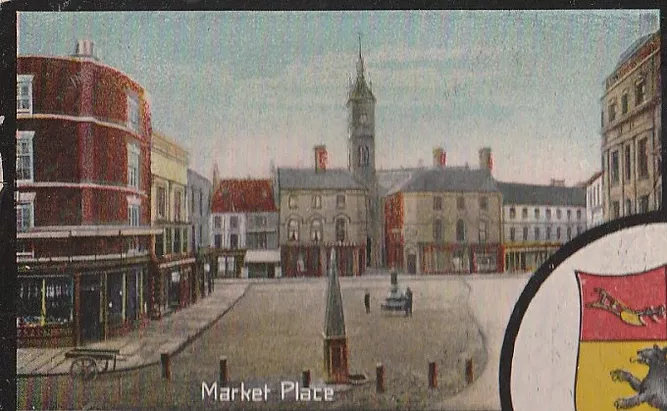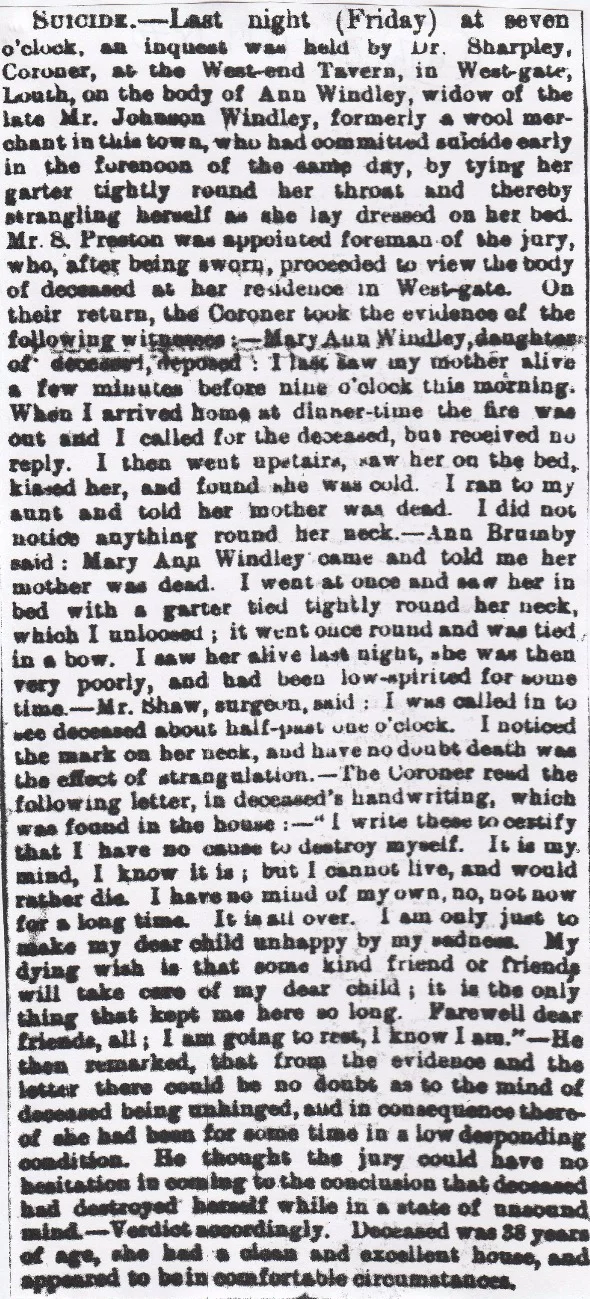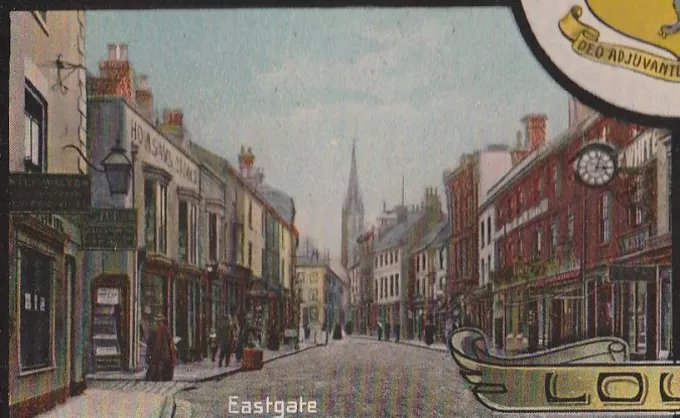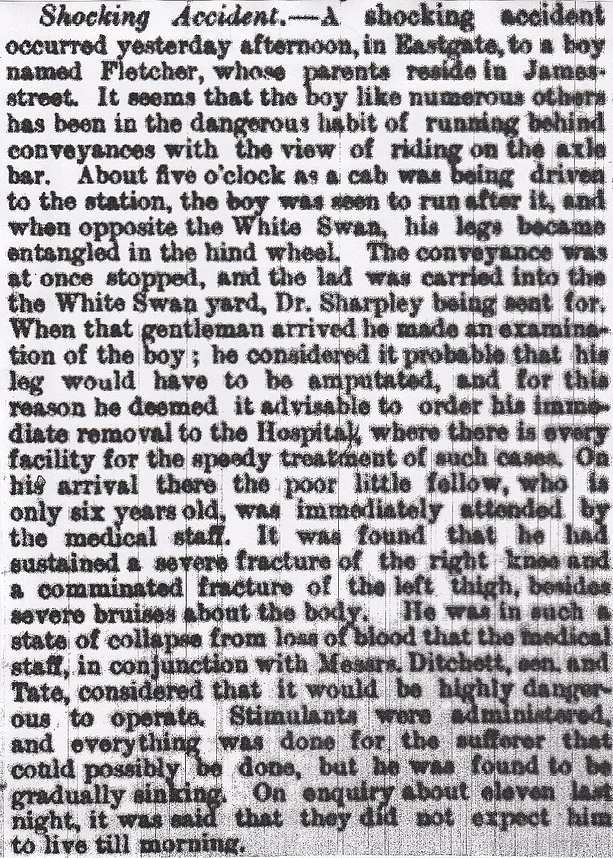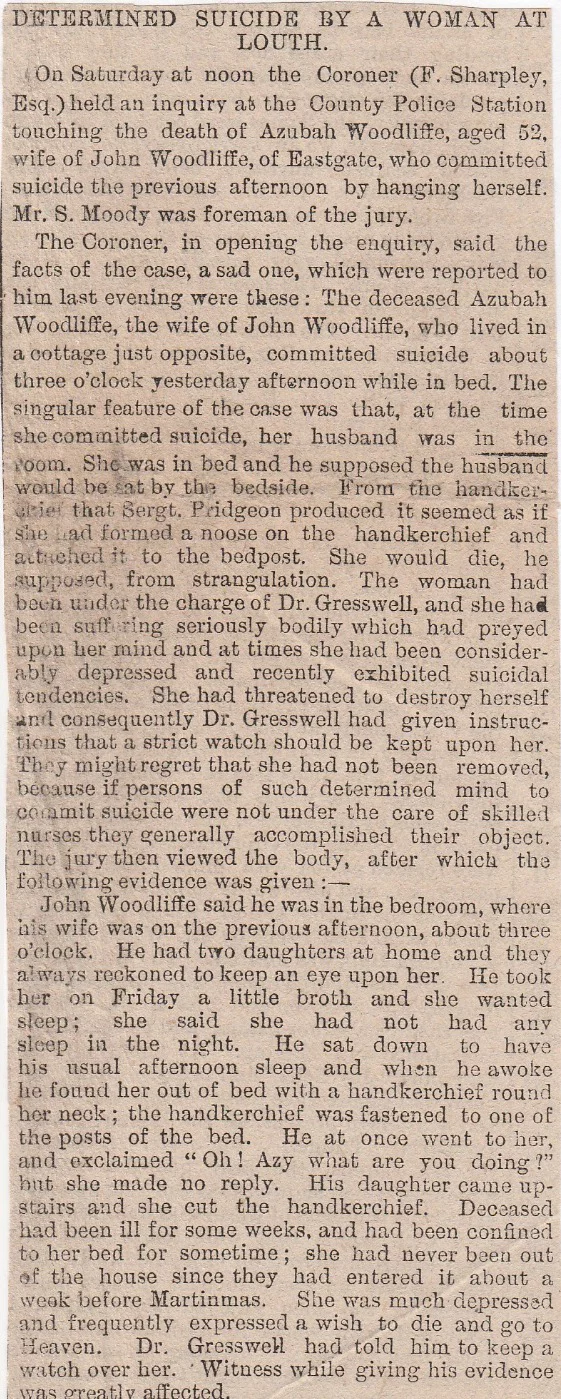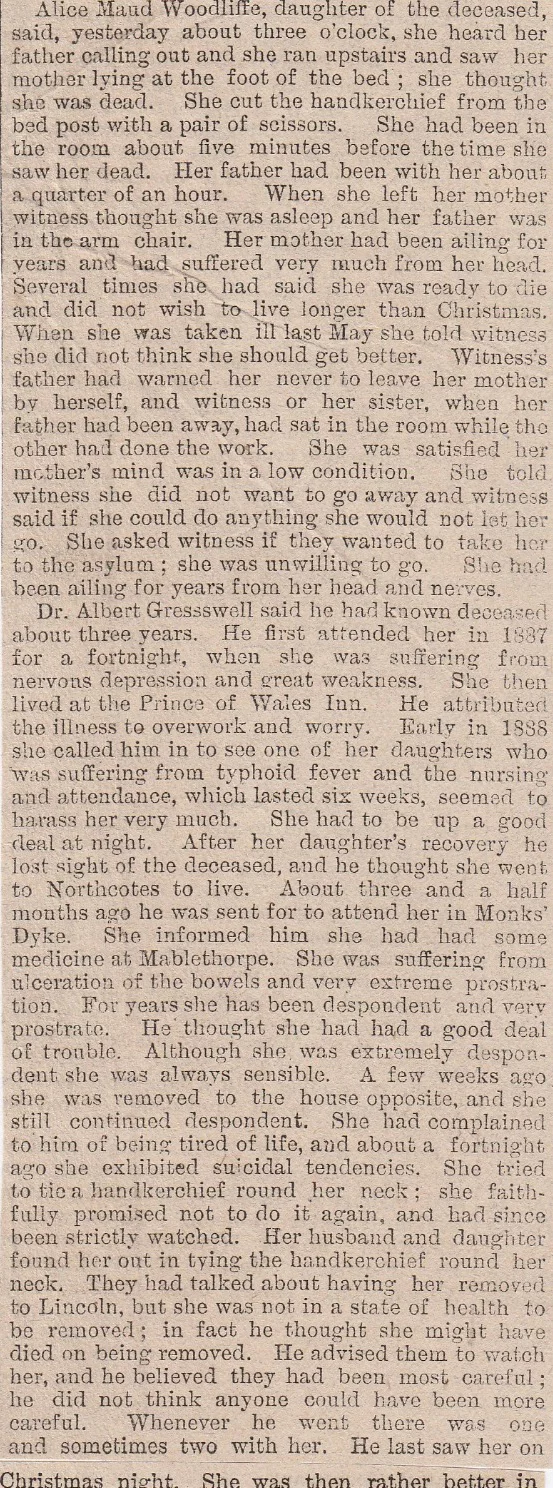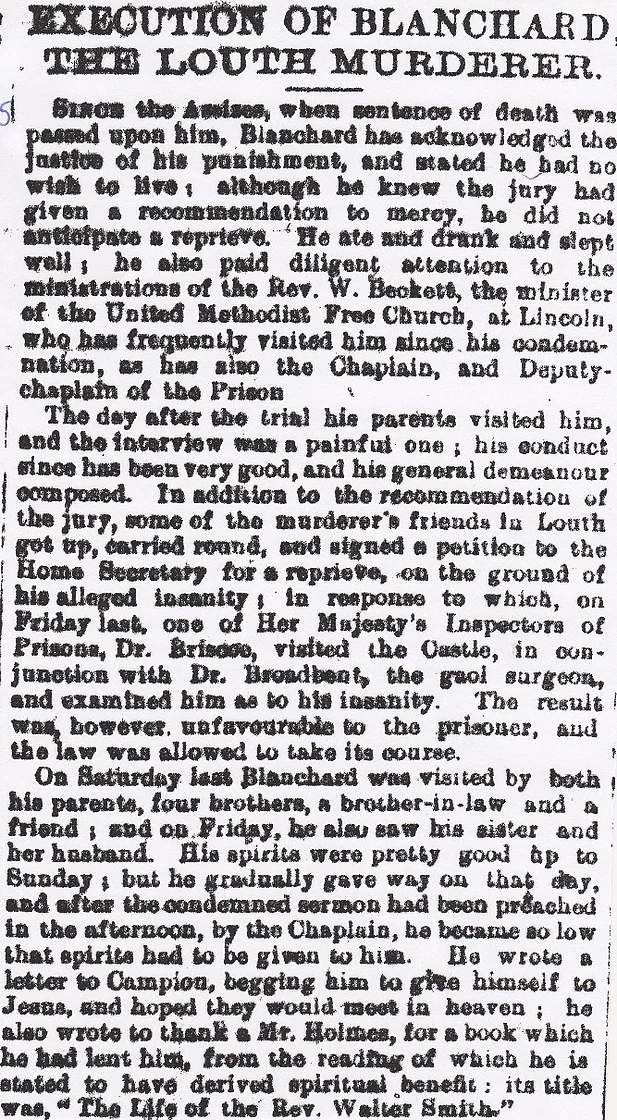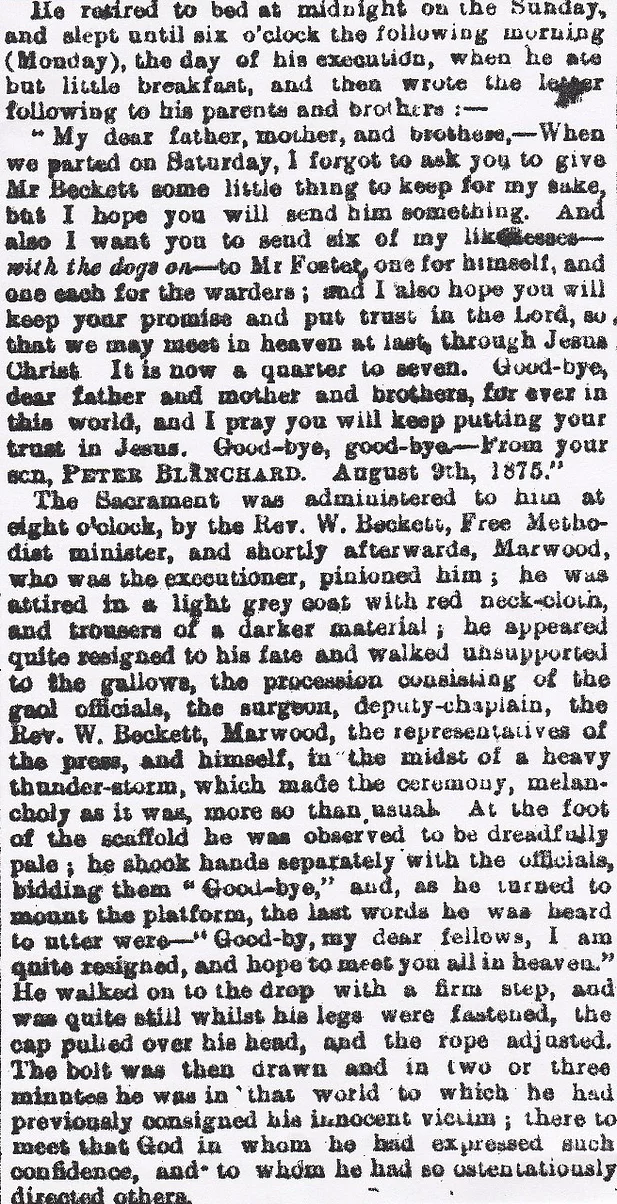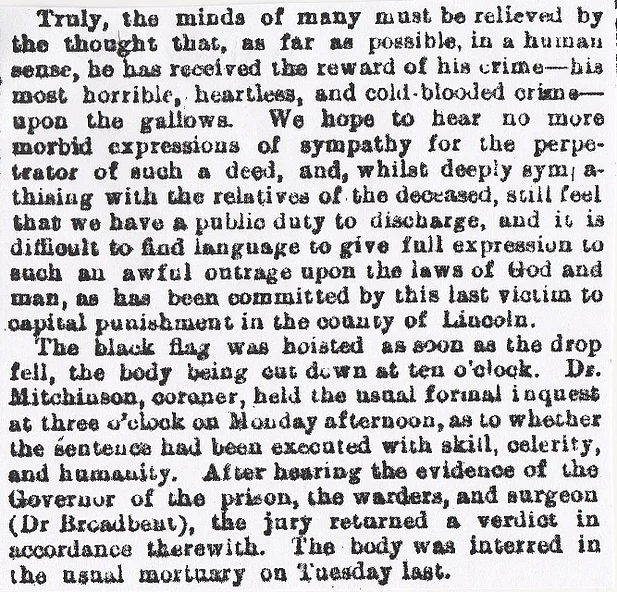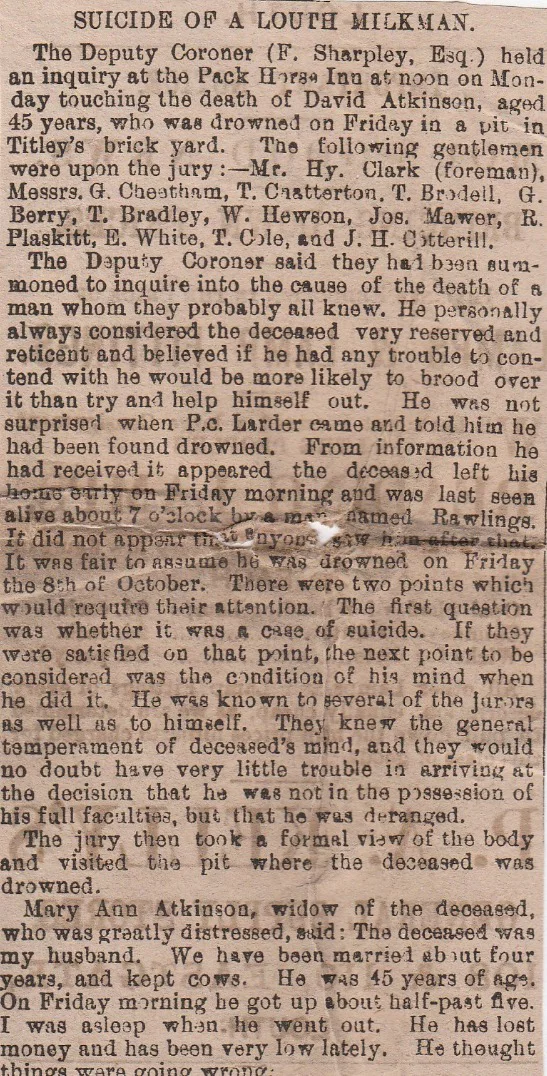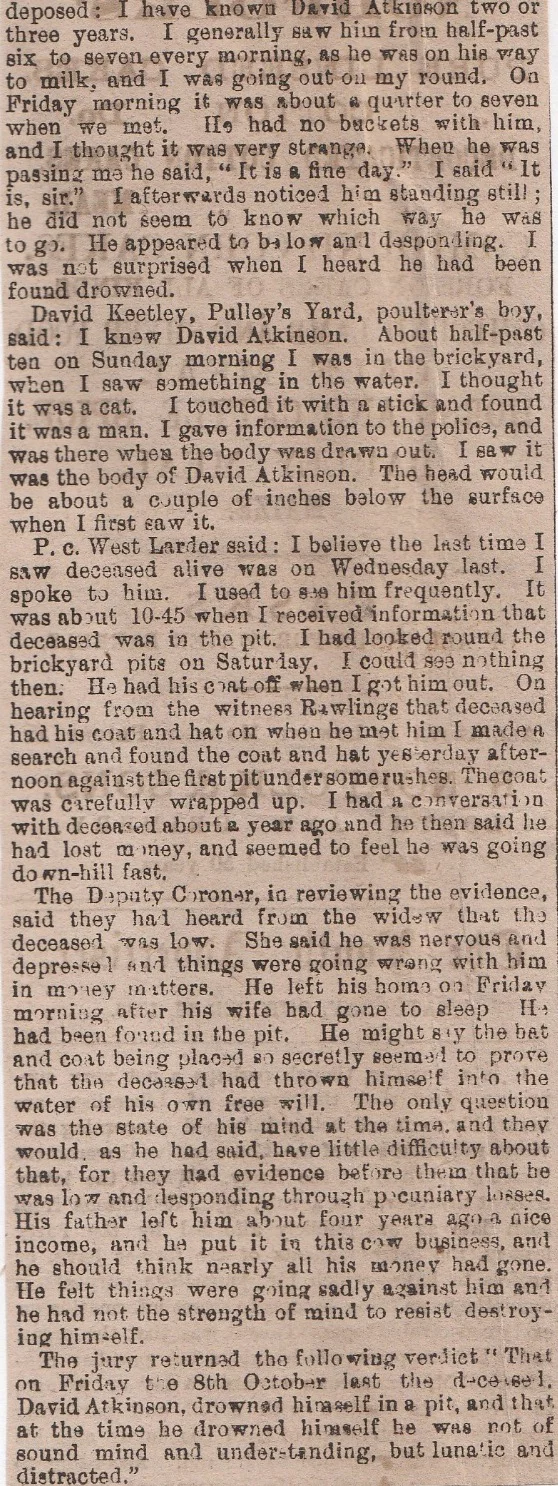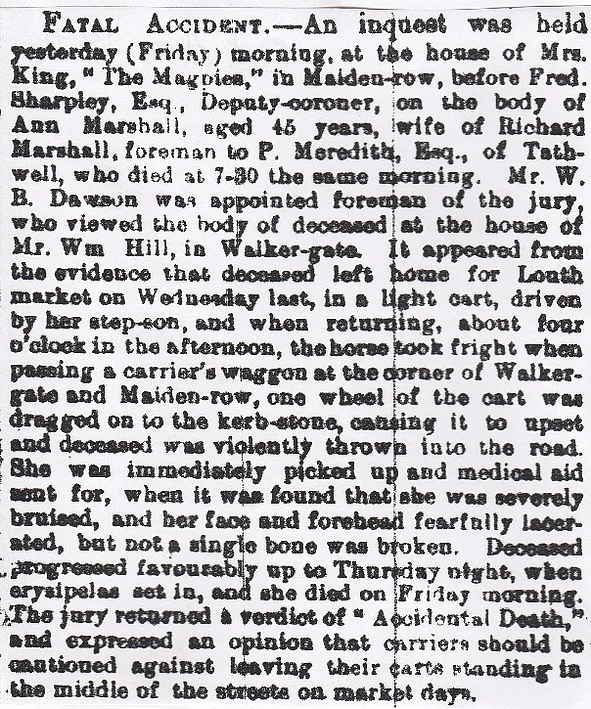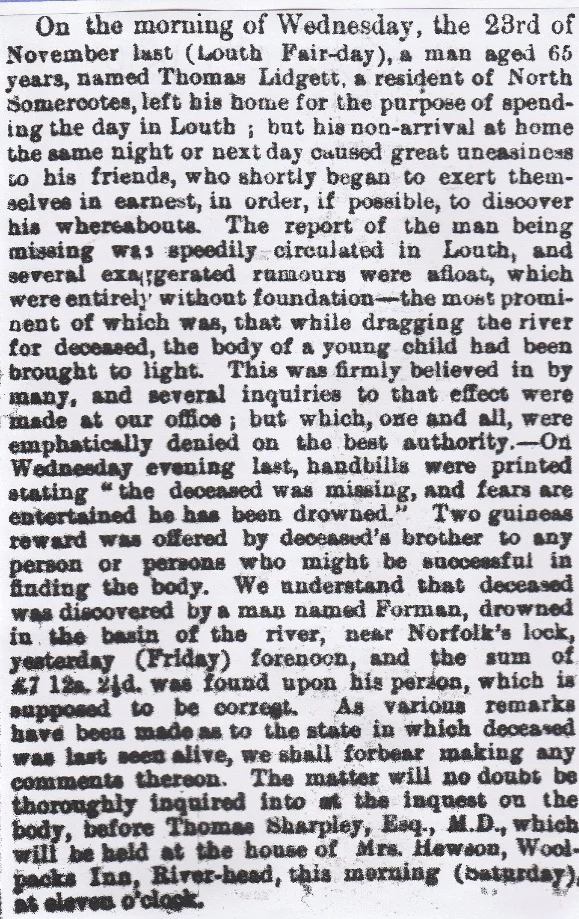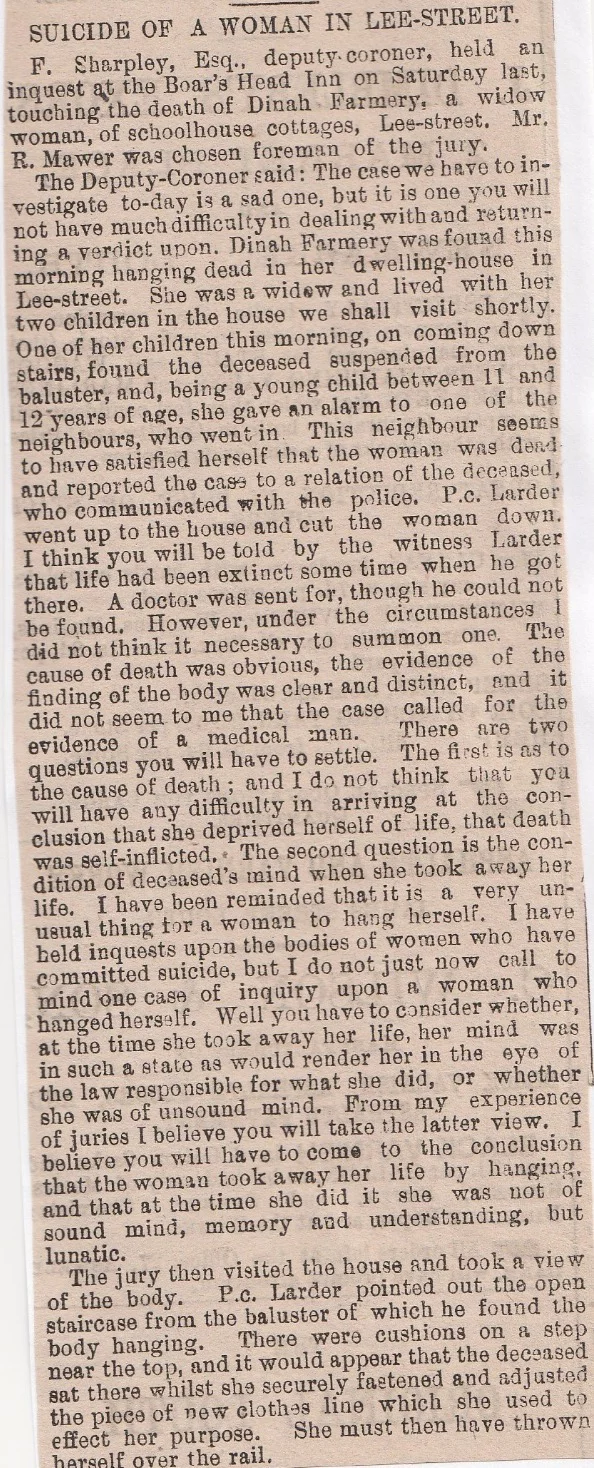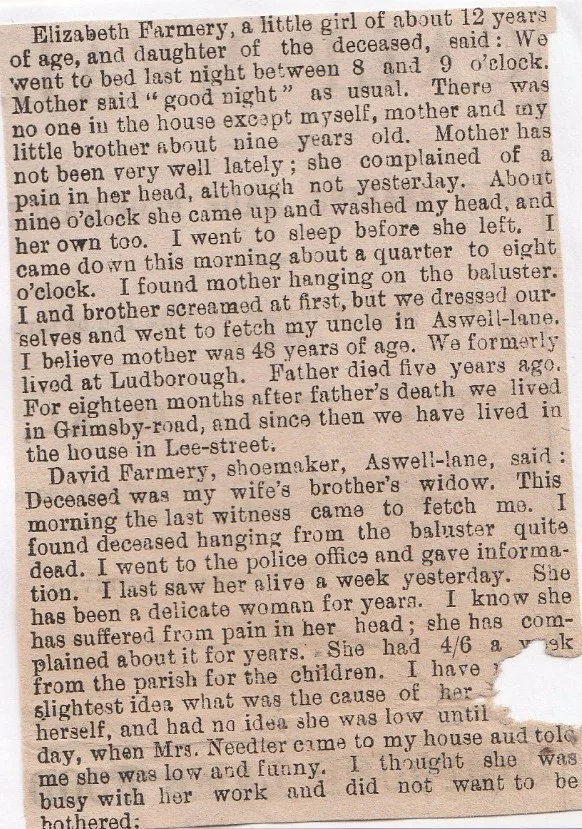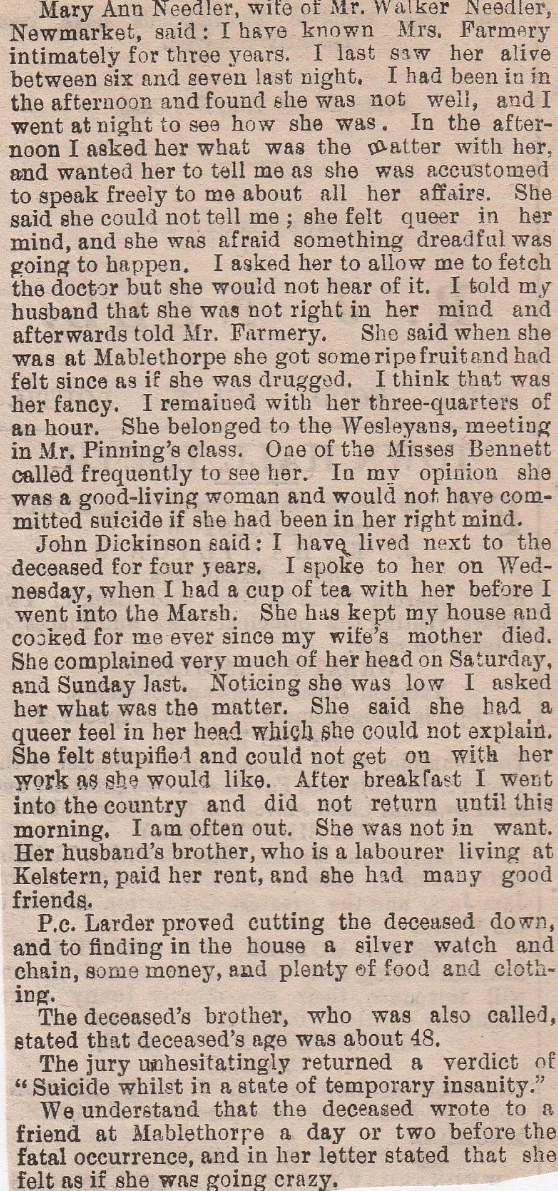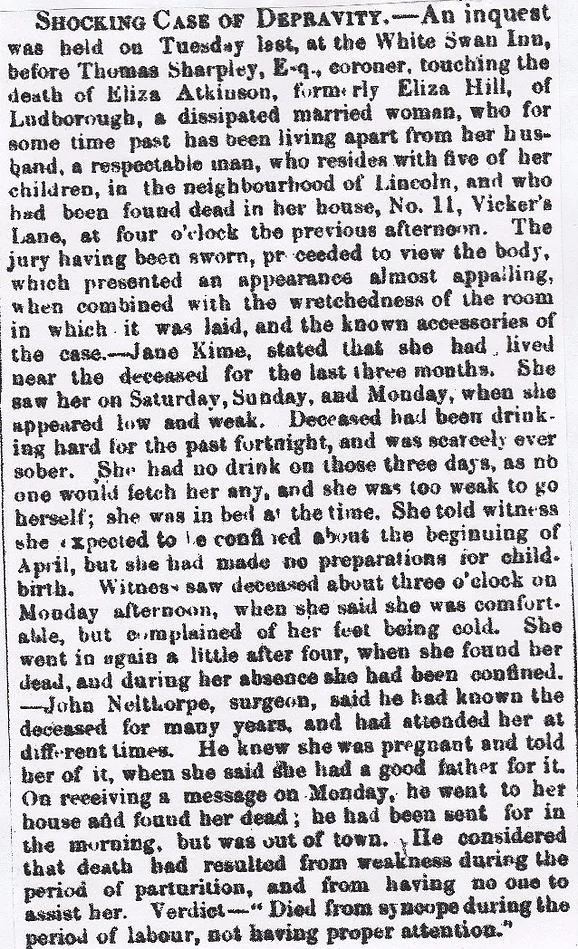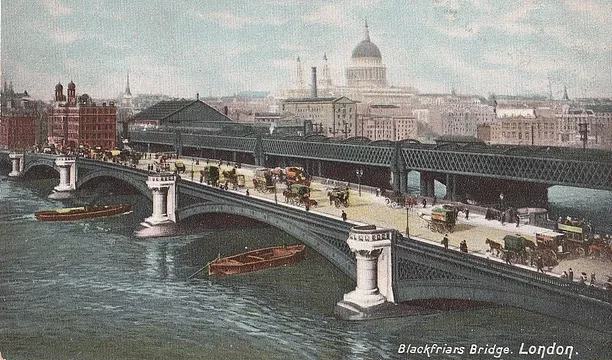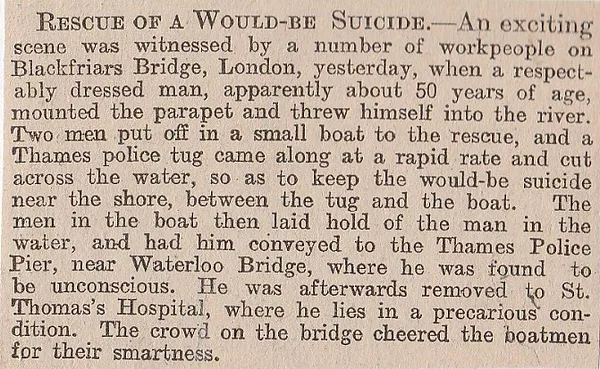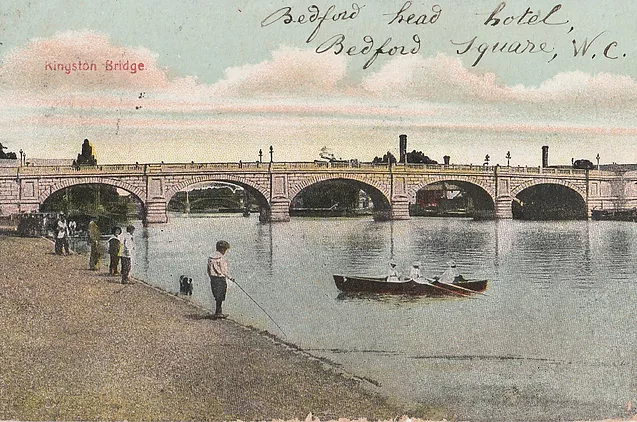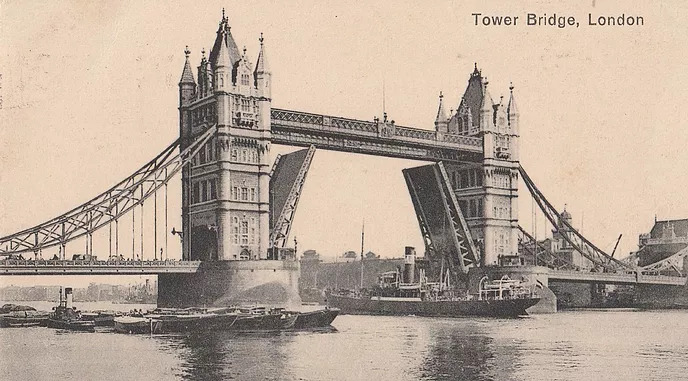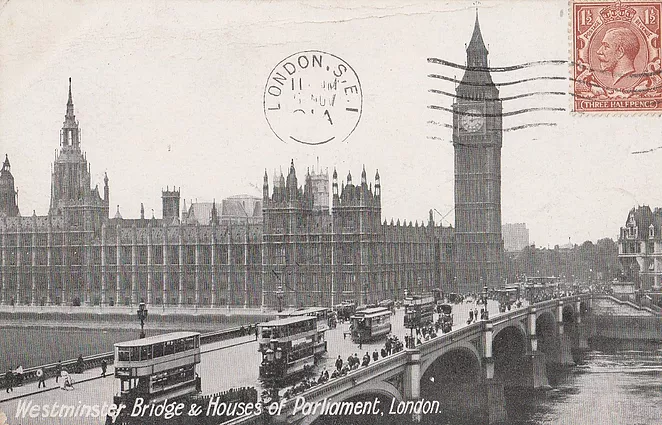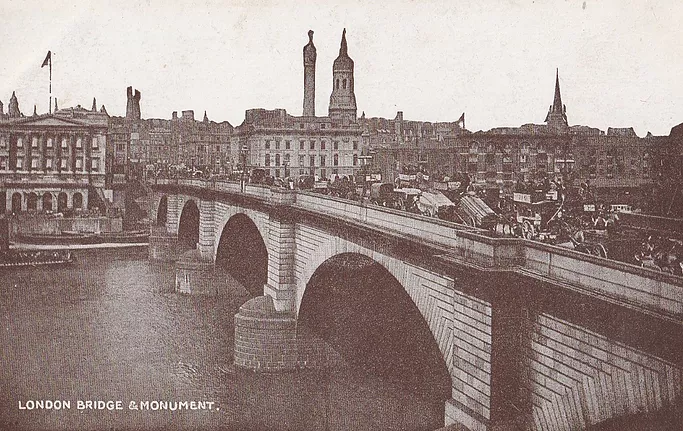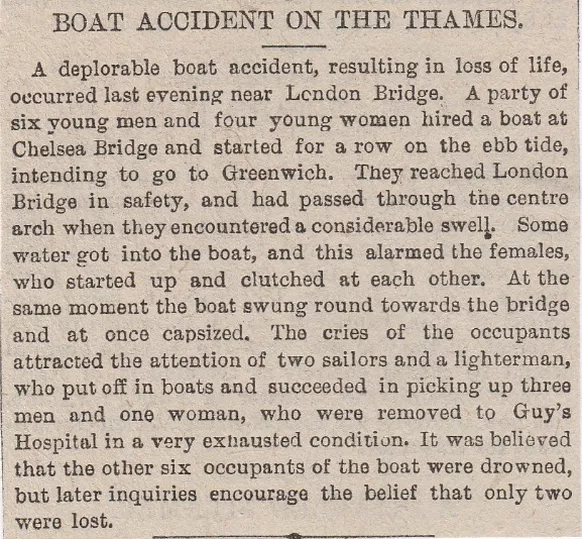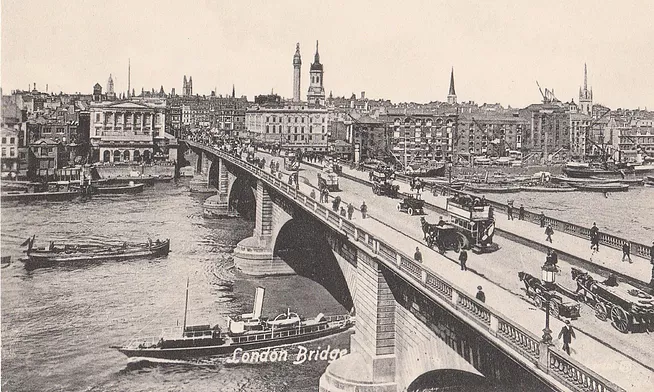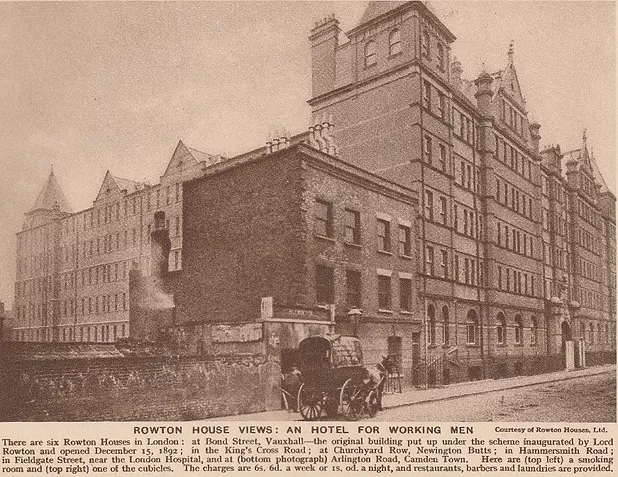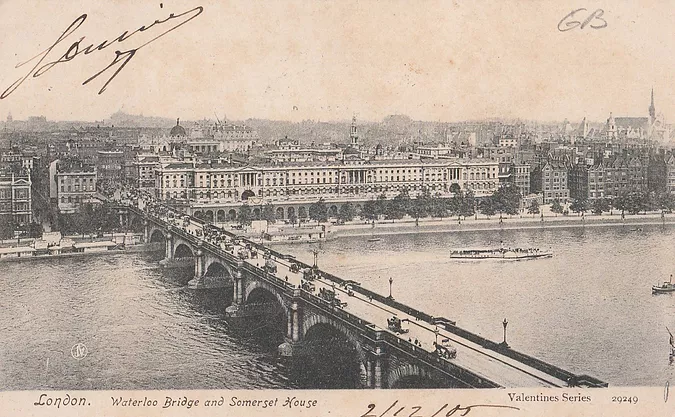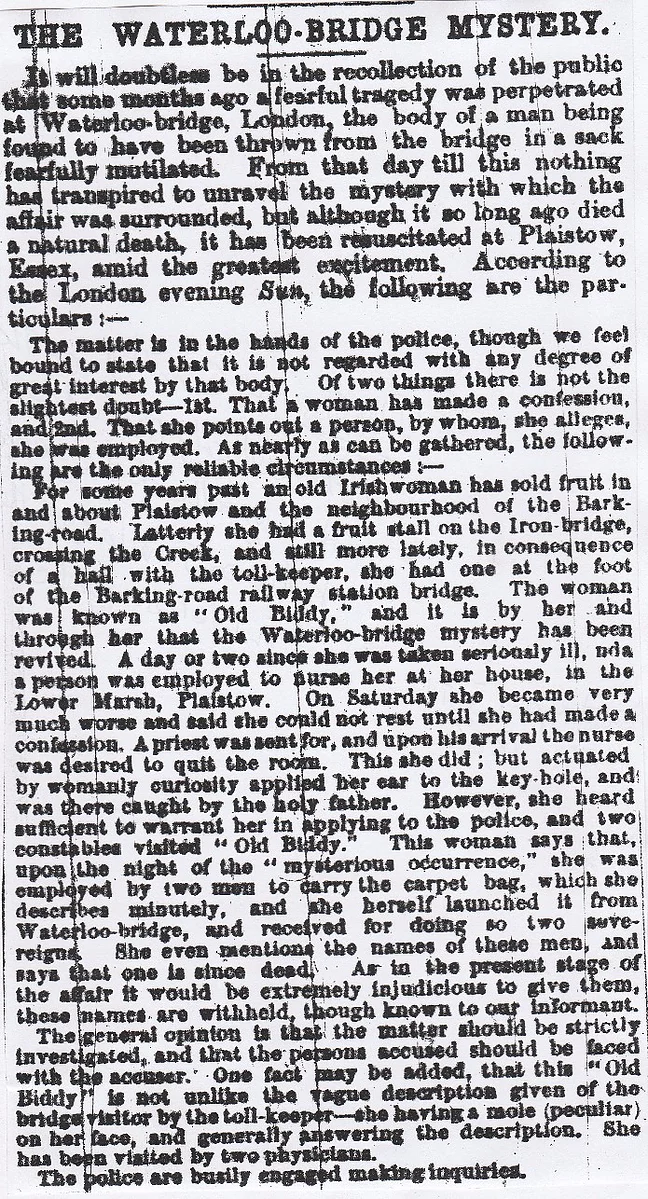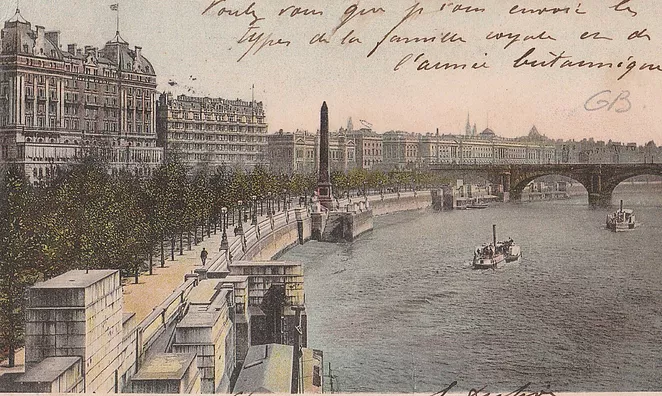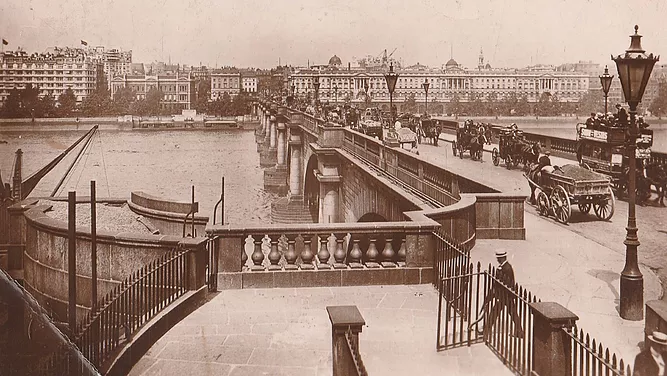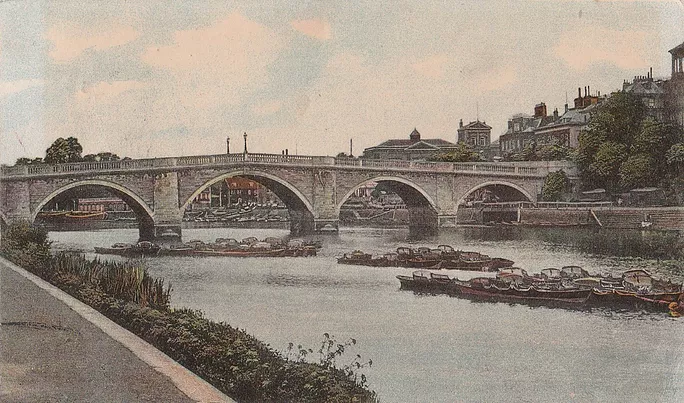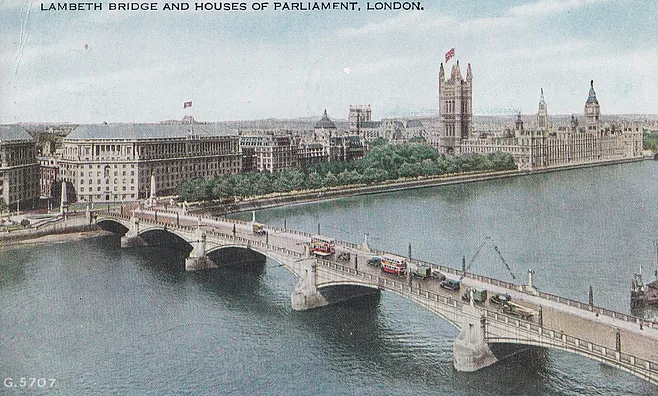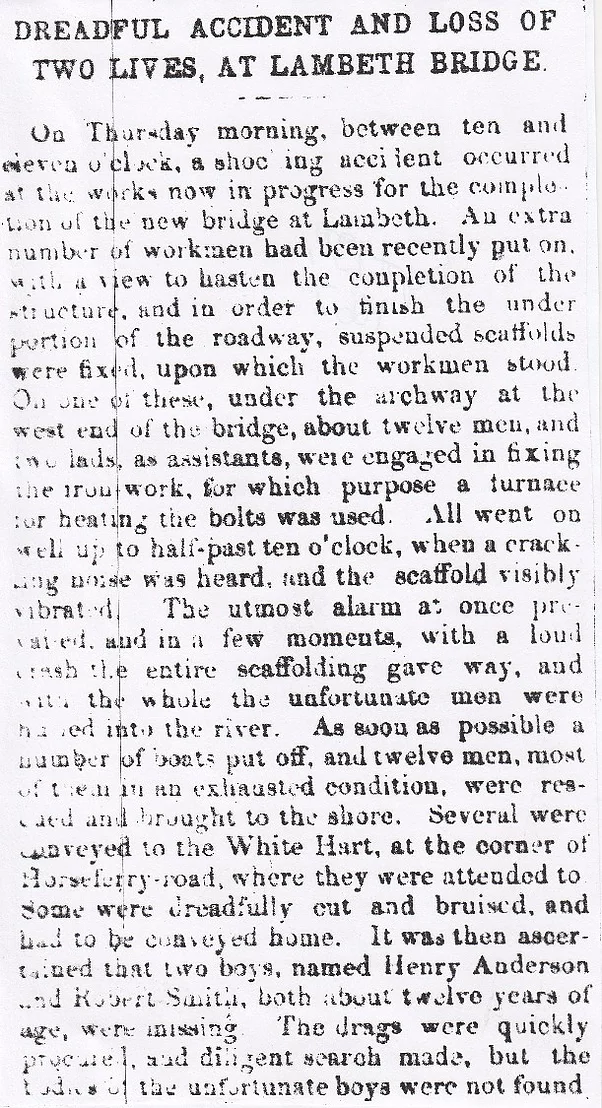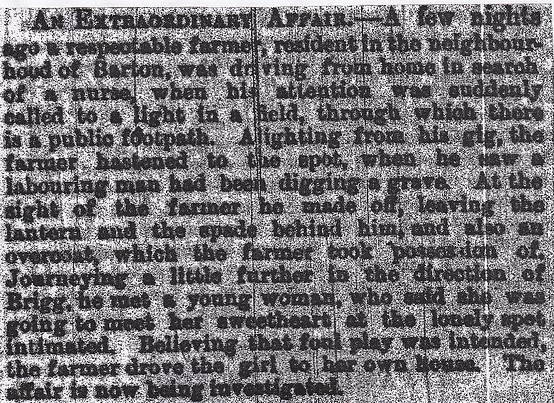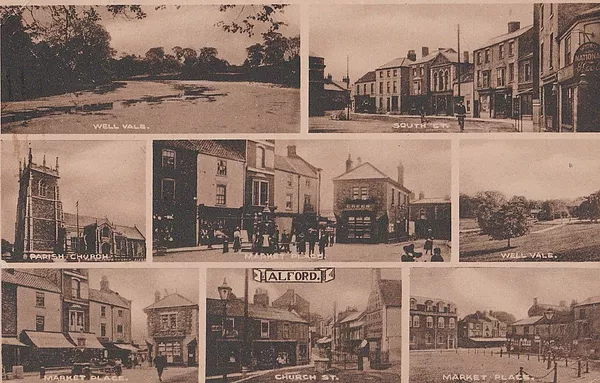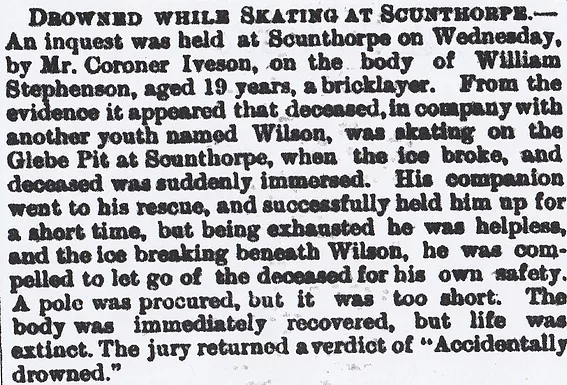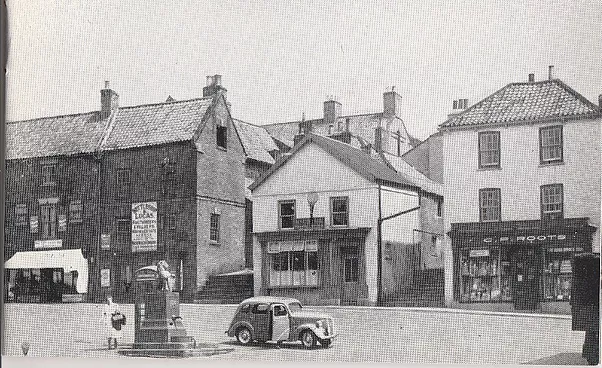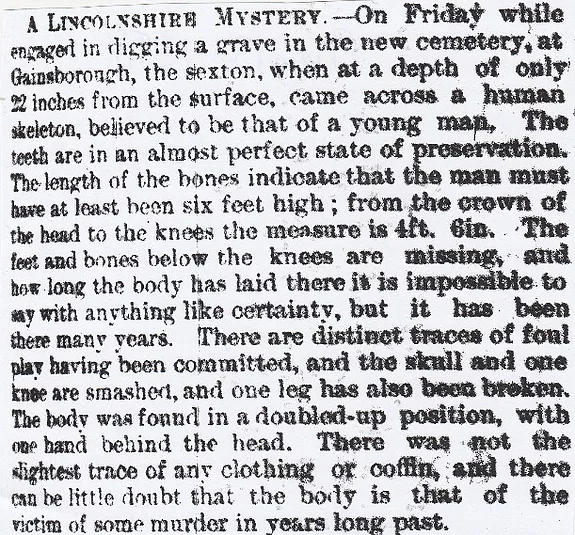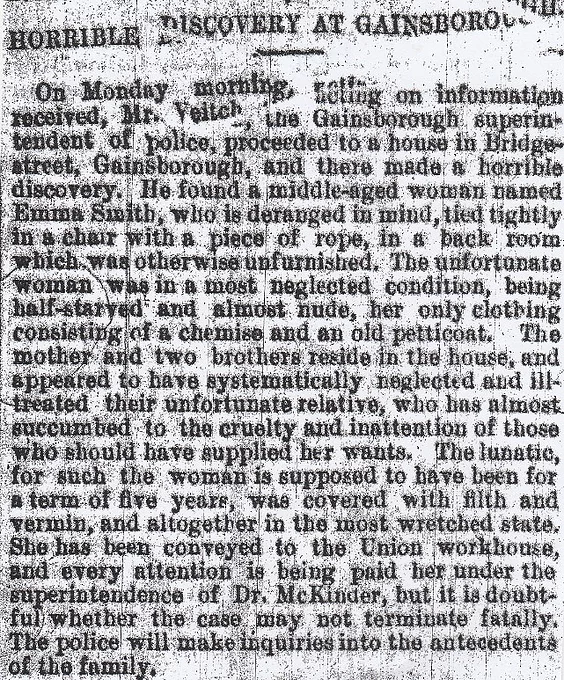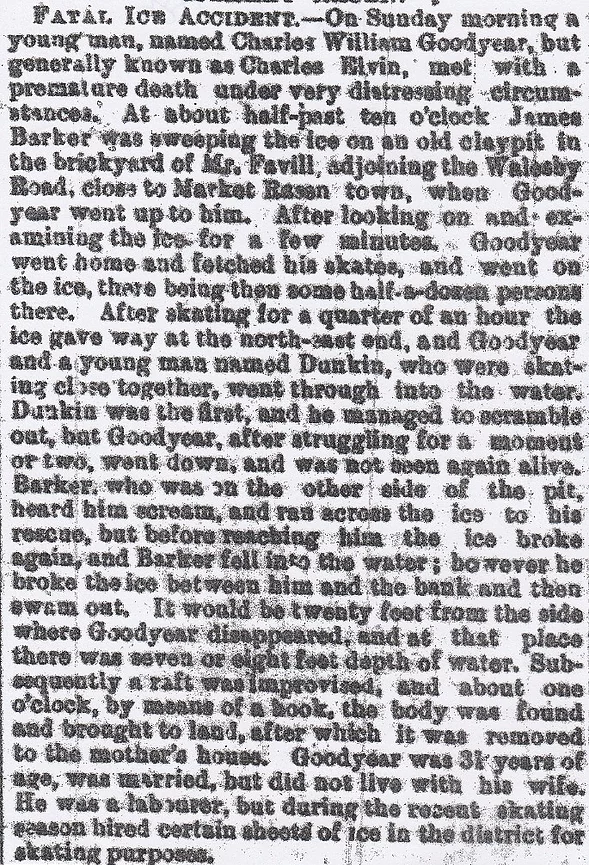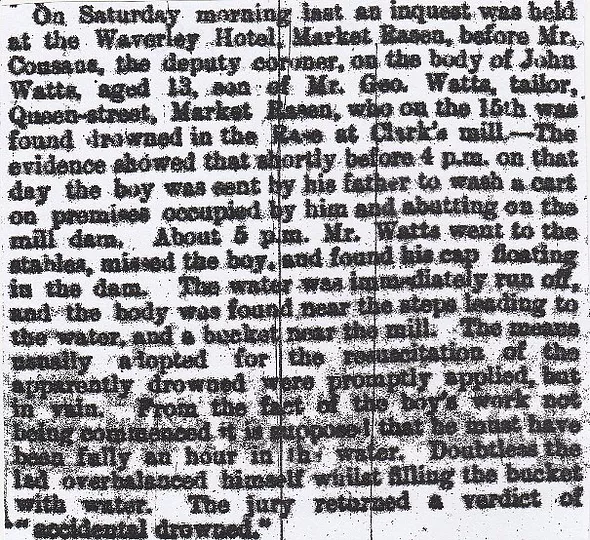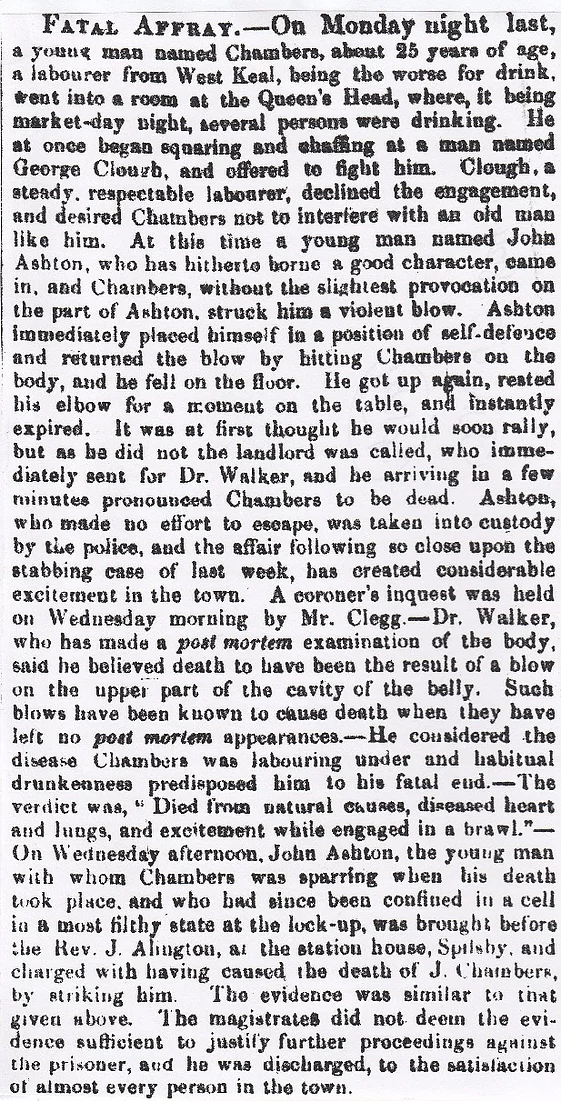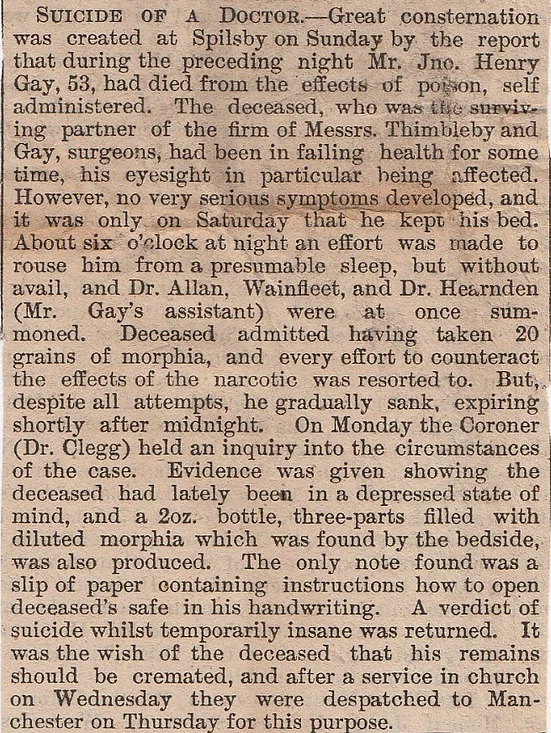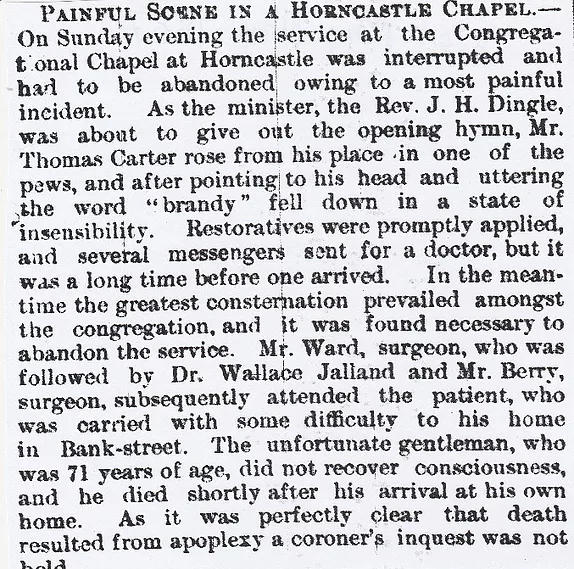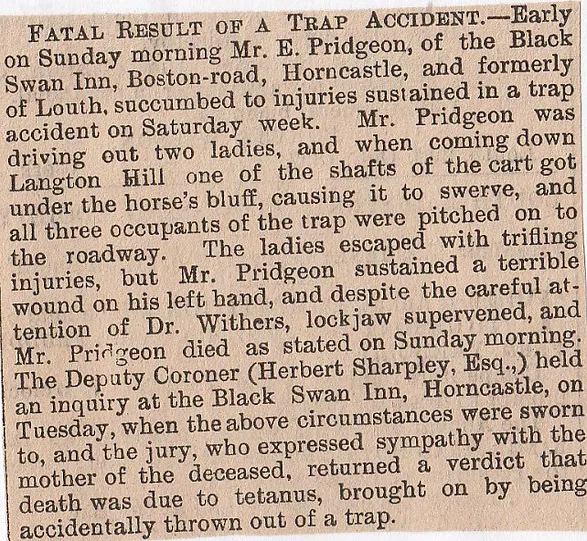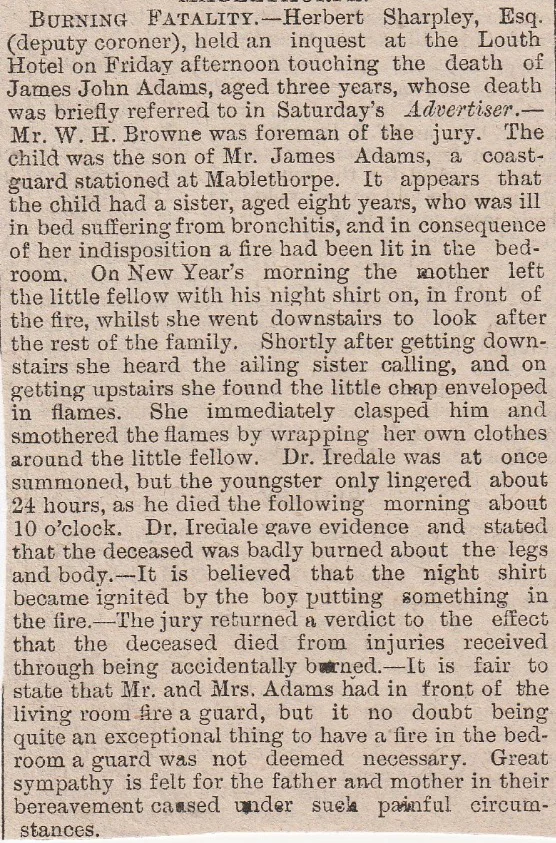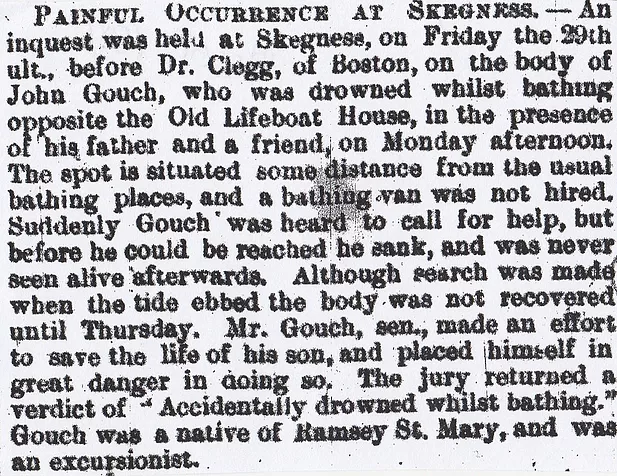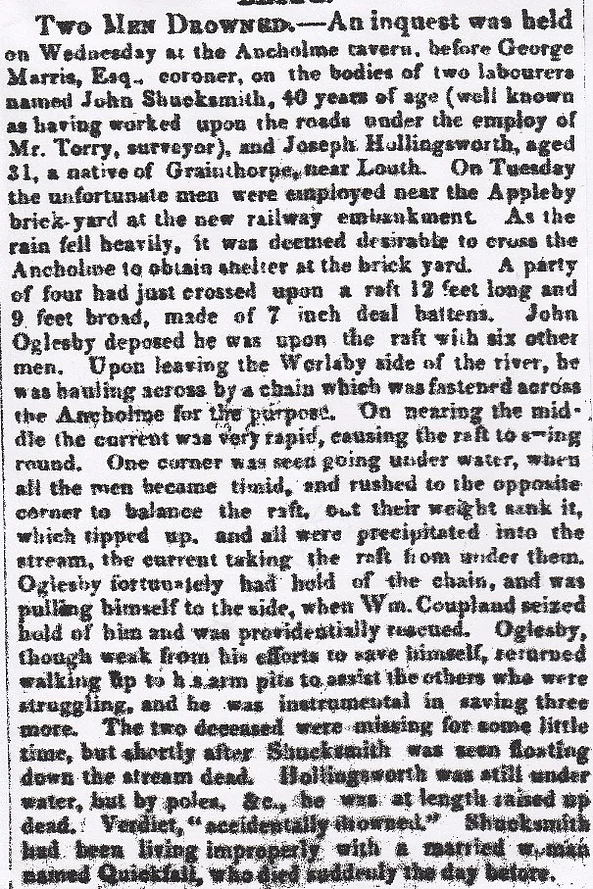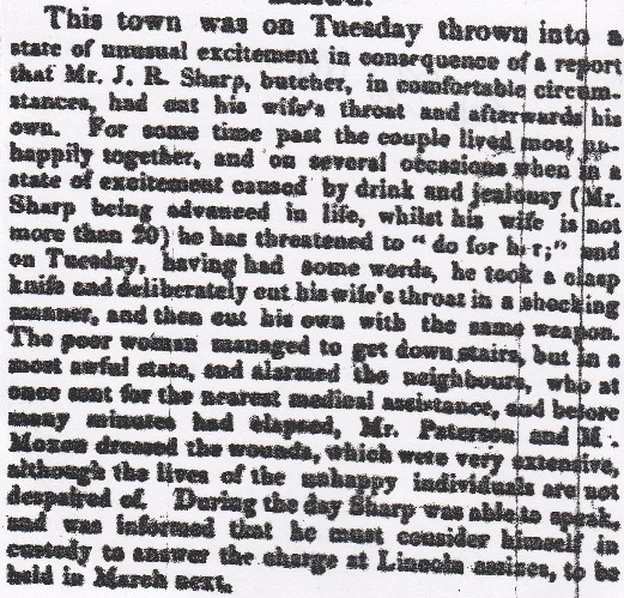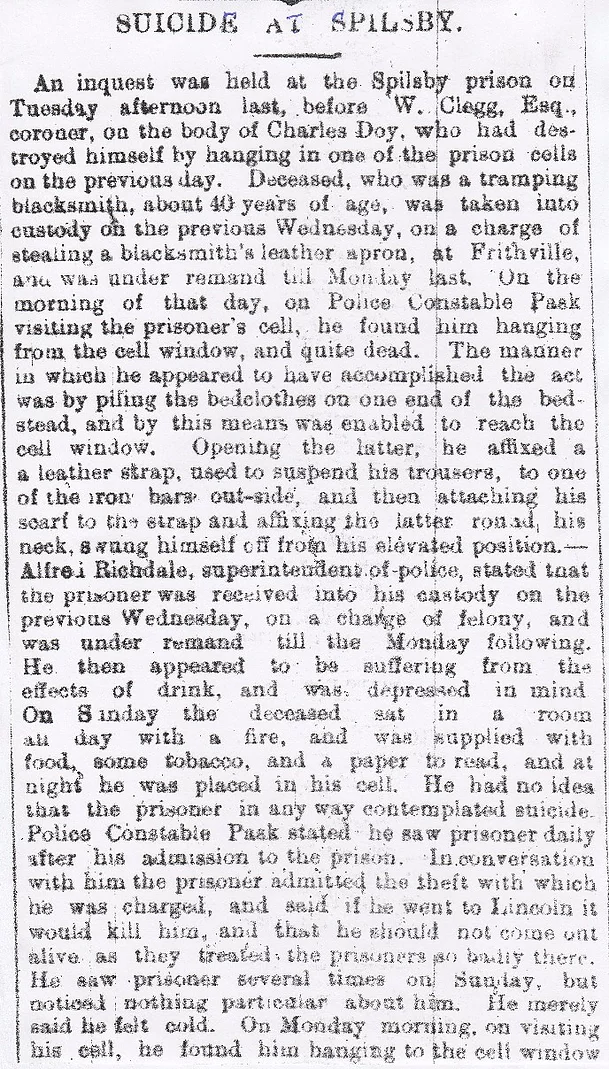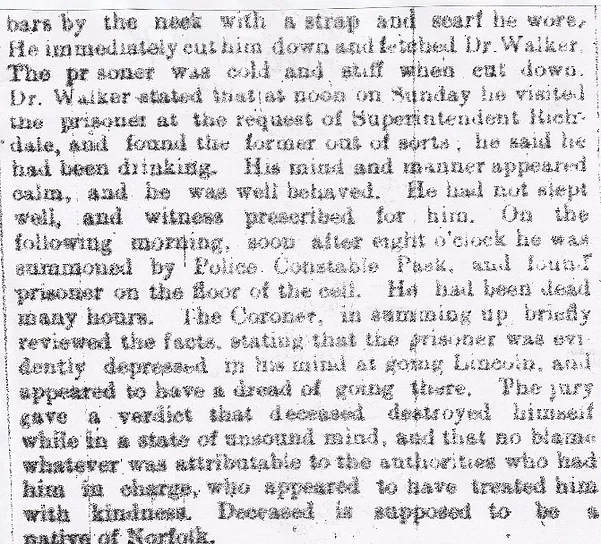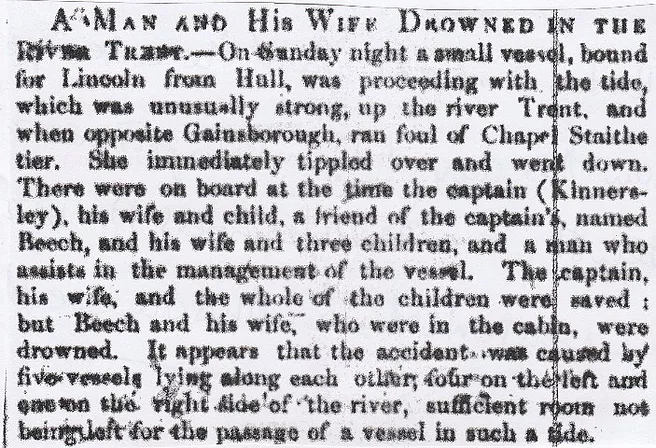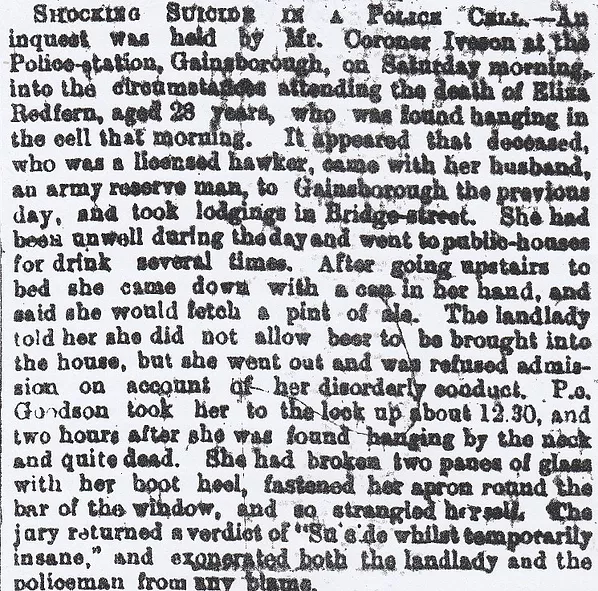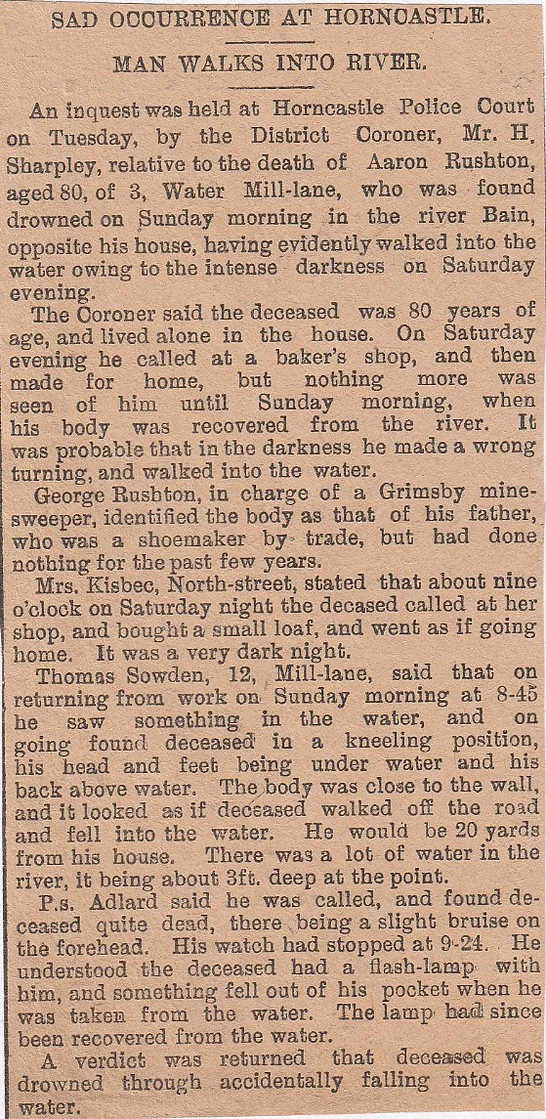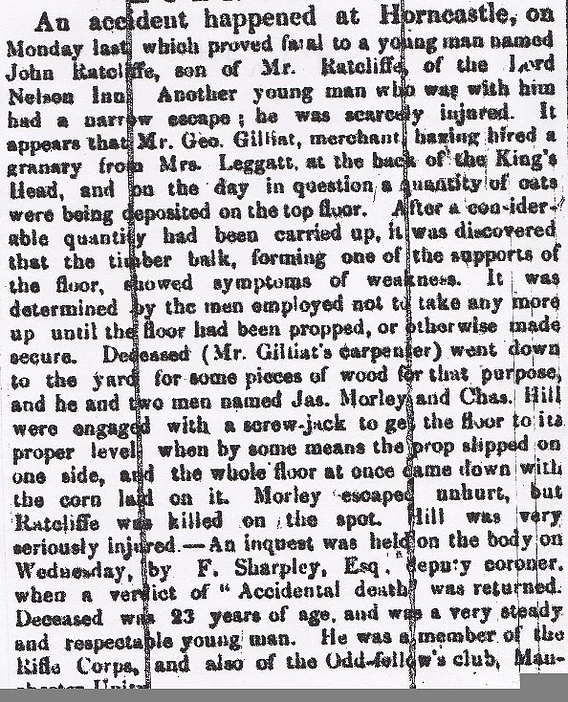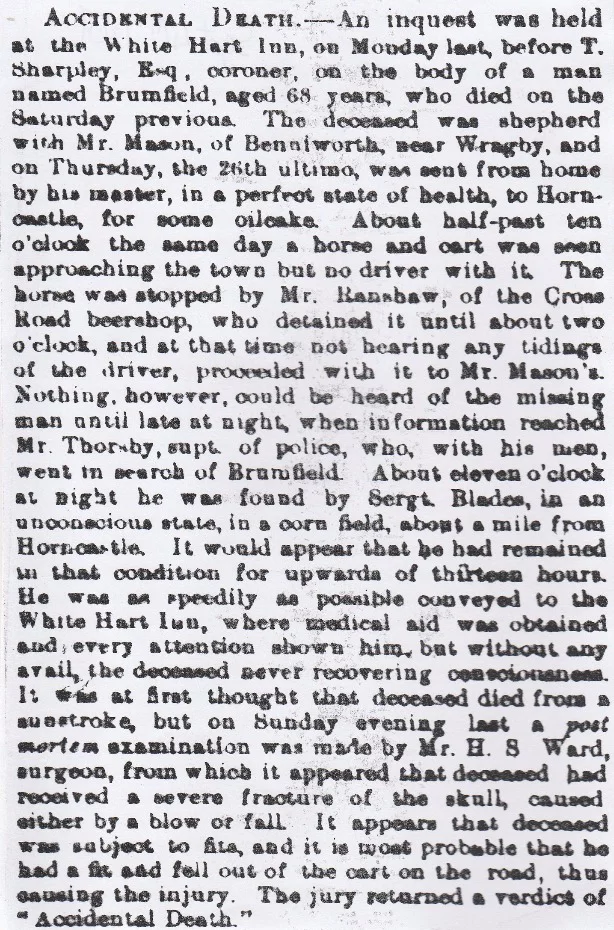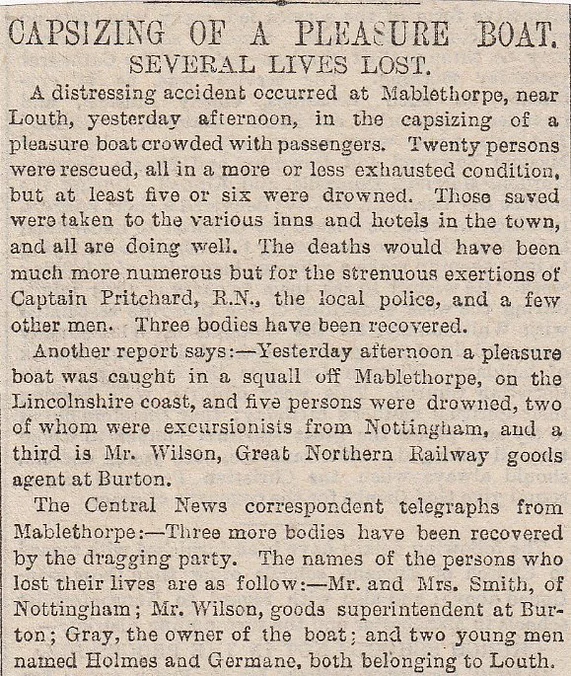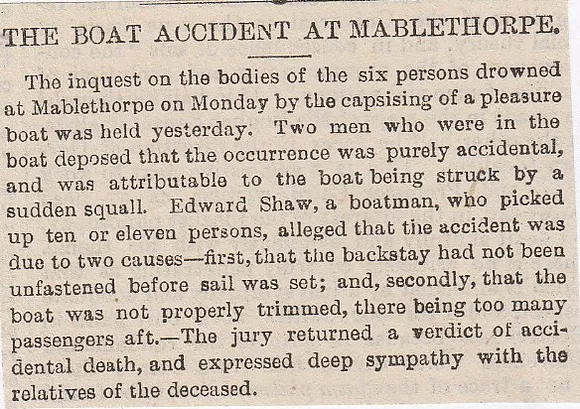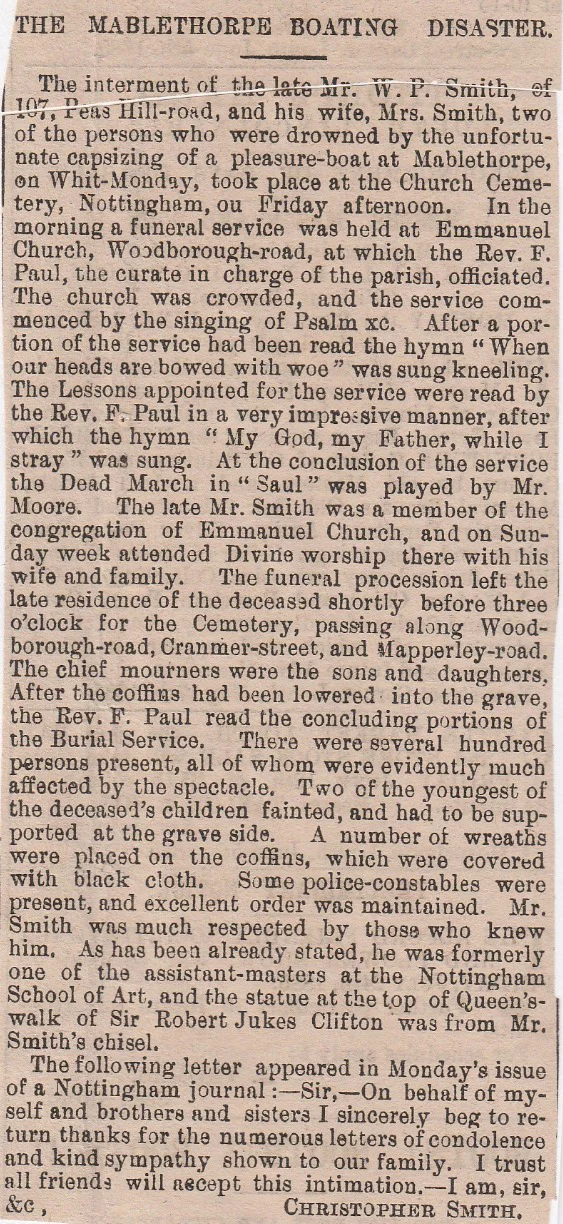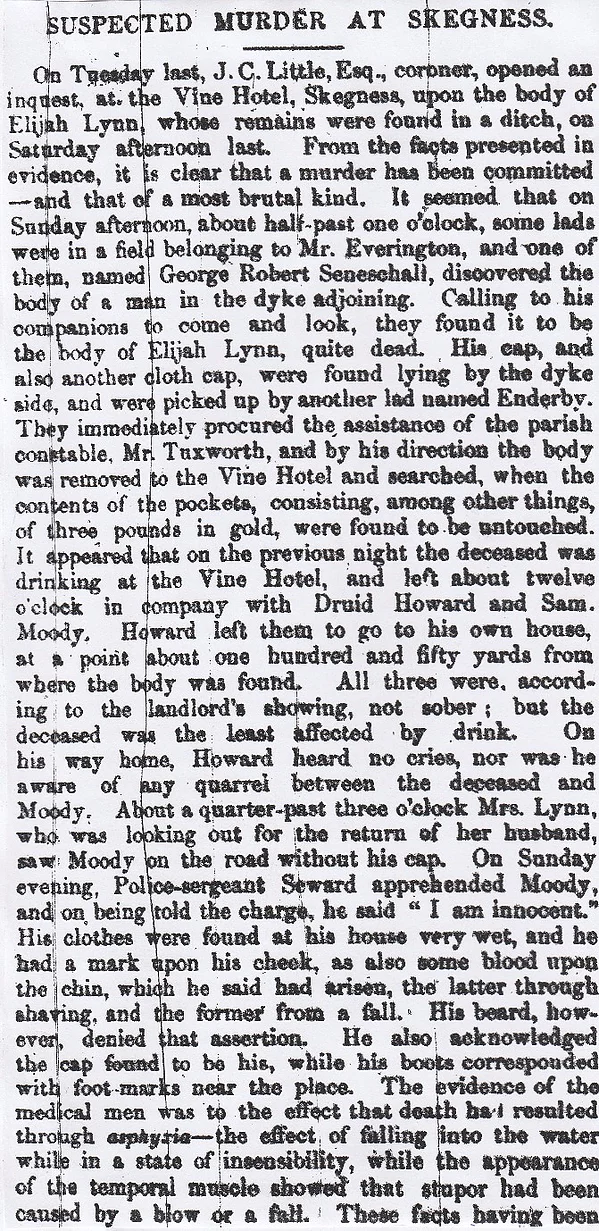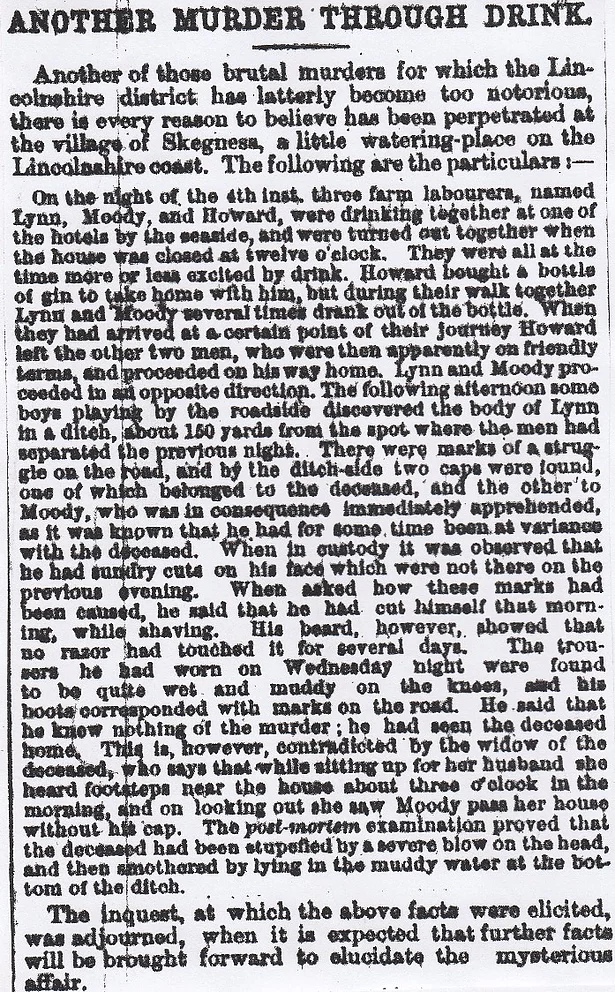1/ Prestwich Lunatic Asylum Murder, Bury, September 1882
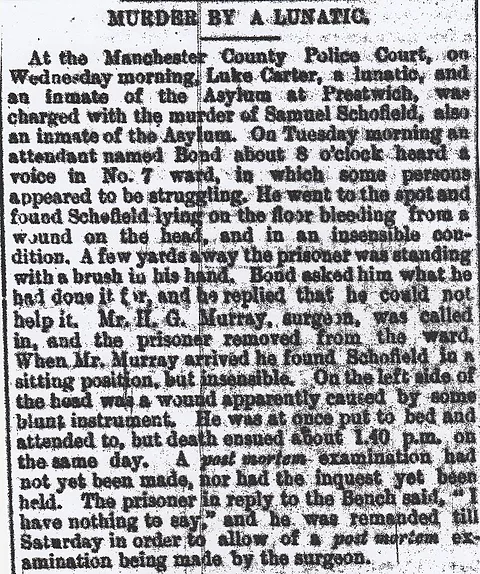
2/ Elton Vale, near Bury, (Chimney Fall Kills Three) January 1884
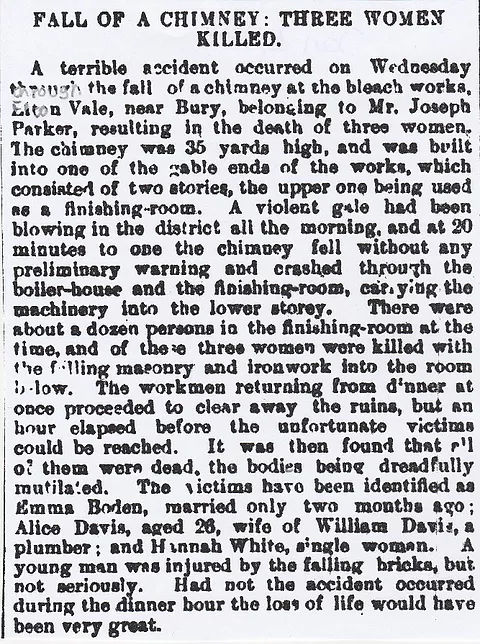
3/ Wigan, (Two Lovers Drowned) May 1886
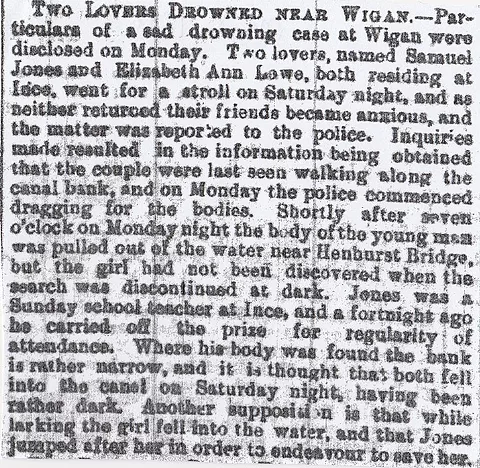
4/ Irlam Lightning Fatalities, Salford, June 1953
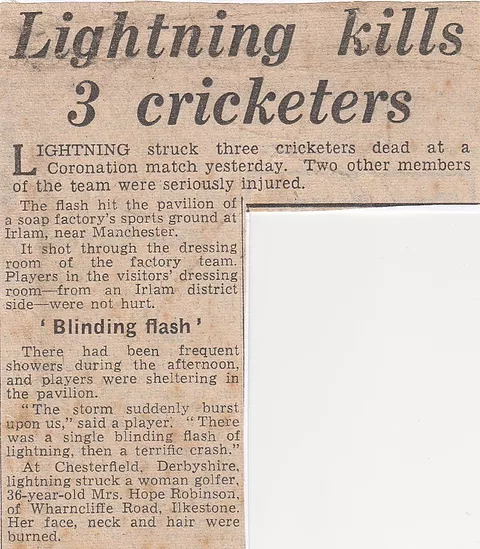
5/ Rainsough Sewer Death, Prestwich, February 1885
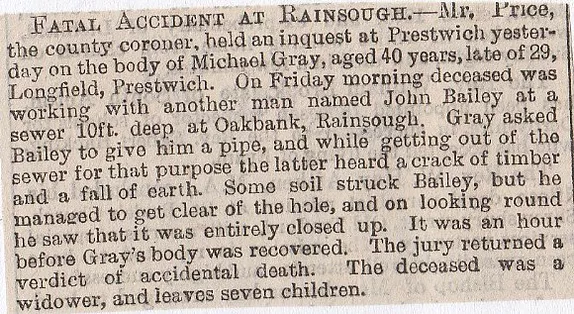
6/ River Irwell Drowning, Bolton, February 1899
Last evening the body of Stephen Settle aged eighteen of Tong Fold, Bolton, was recovered from the River Irwell at Bolton. The lad had been missing from his home for three days. He was weak-minded and of defective vision and as he was not suicidally inclined, it is believed that he fell into the river which was swollen by recent storms and that his body was carried a mile downstream.
7/ Breightmet Colliery Death, Bolton, March 1899
Francis Guffogg, a collier residing at Tonge, was working at the Breightmet Collieries, Bolton, along with three other men, when a heavy fall of roof took place. Guffogg was buried in the debris and on being extricated was found to be dead.
8/ Trinity Street Railway Station Fatality, Bolton, March 1899
A young man named Fred Atherton of Gorton slipped from the platform on to the line when a goods train was passing when part of the train went over his head and neck, killing him instantly. He had been staying at Blackpool for his health.
9/ Bradley Fold/Darcy Lever Station, (Body on Tracks) May 1899
A tragic accident occurred on the Lancashire and Yorkshire railway. Whilst a signalman was traversing the line between Bradley Fold and Darcy Lever stations he came across the dead body of an unknown man lying in the four-foot. It is supposed that he’d been struck by a passing Yorkshire excursion train.
10/ Darcy Lever Railway Death, May 24th, 1899

11/ Ladyshore Colliery Fatality, Little Lever, May 1899
A miner named William Berry was killed yesterday morning at Ladyshore Colliery, Little Lever, by some props giving way whilst he was taking a waggon down a jig-brow, the jig catching him and crushing him fearfully. His son, who was working with him had a very narrow escape.
12/ Bolton Wanderers Ground Fatality, (Burnden Park) June 1899
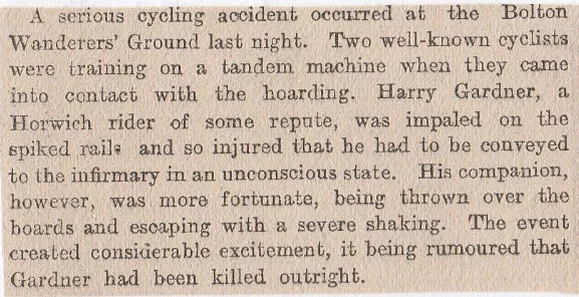
13/ Bolton Deaths, June 1899
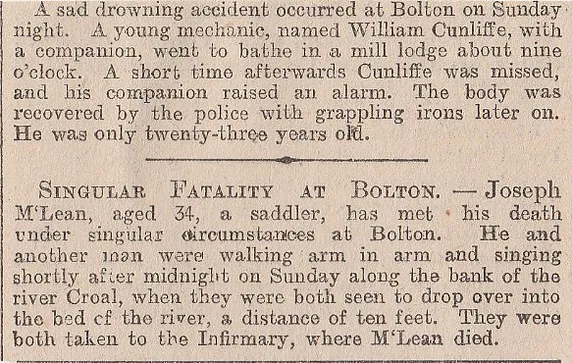
14/ Farnsworth Parish Church? (Bridegroom Lynched) June 1877 (Can’t find Tamworth near Bolton. Kersley is Kearsley.)
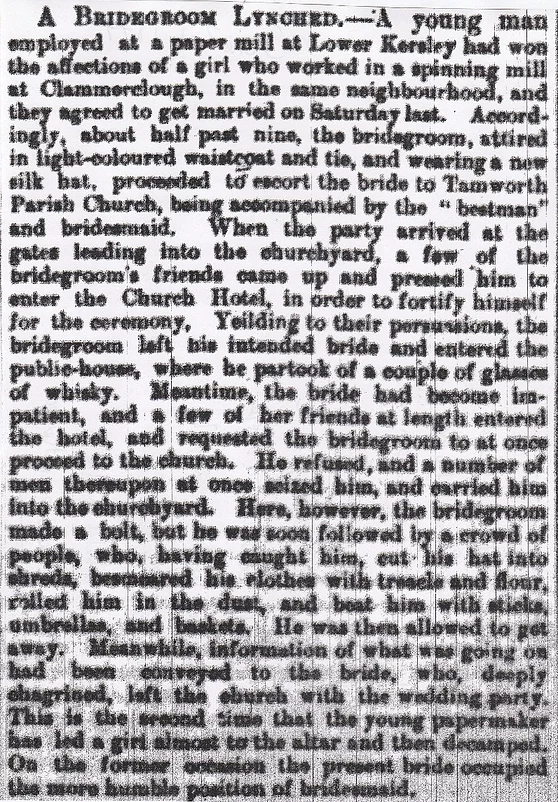
15/ Manchester/Bolton, (William Cooper Death Sentence) May 1879
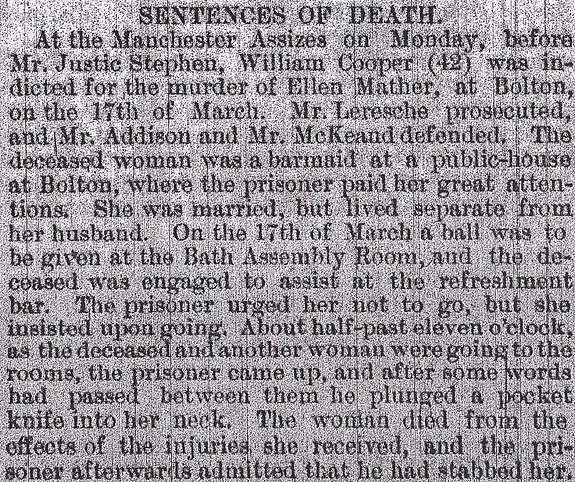
The jury found the prisoner guilty, and the judge sentenced him to death.
16/ Bromley Cross near Bolton, (Driver Decapitated) September 1867
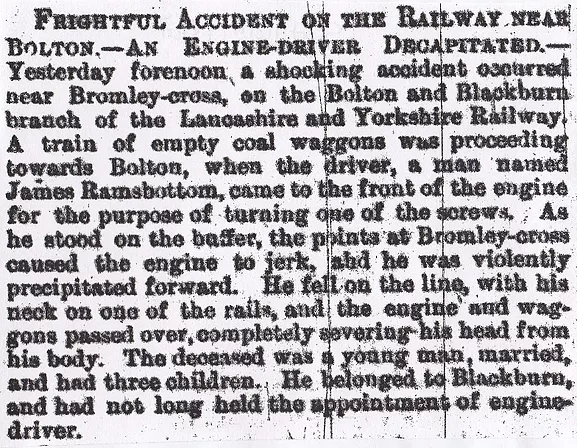
17/ Rusholme, (Bodies in Pond) November 1905 (Suicide Pact?)
The dead bodies of J.Barrett, a railway porter, aged twenty-five and his sweetheart Gwendoline Mackey who was only eighteen, were found in a pond near the Manchester Athletic Ground at Fallowfield. A young boy found the bodies and he straight away went to get the police. Could it be a young lover’s suicide pact?
18/ Derby Hotel, Bury, (Double Suicide) February 1899
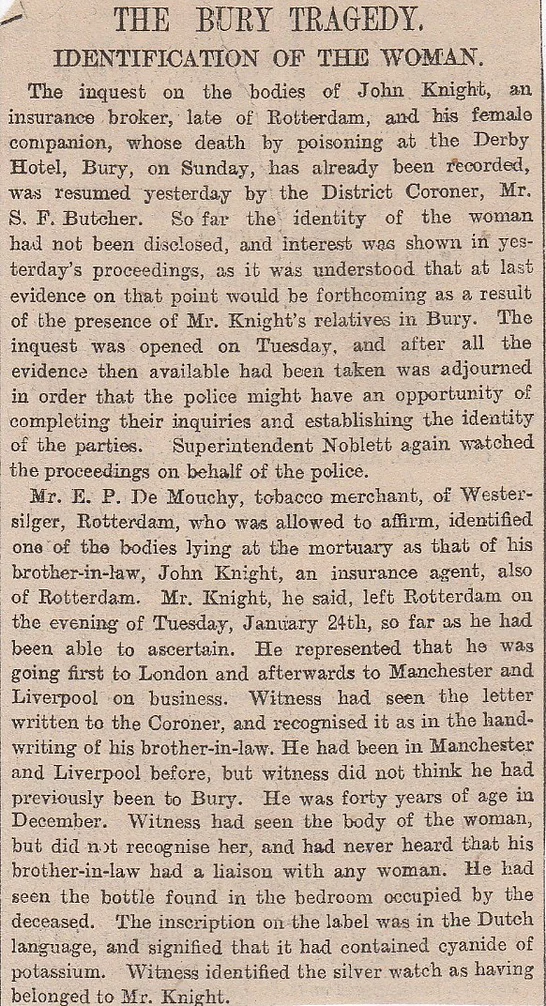

19/ Bury, (Boiled in Liquor) May 1899
Last evening a liquor mixer named John Turner aged forty-three, residing at Wood Street in Elton, died at Bury Infirmary from shock, consequent on scalds received through accidentally falling into a vat of boiling liquor at Messrs Whitehead’s Bleach Works near Bury.
20/ Radcliffe near Bury, (Canal Corpse) May 1899
The dead body of Ernest Hewart aged eleven, of No.4, Siddall Street in Radcliffe, who has been missing since Saturday, was recovered from the Bury and Manchester Canal at Radcliffe by Isaac Simm, a collier, who pulled him out with a pair of grappling irons. He was found in a canal not far from his home.
21/ Radcliffe near Bury, (Suffocation) May 1899
An inquest touching the death of William Holmes aged eleven, of 42, Lord Street in Radcliffe. Evidence showed that in July last the boy swallowed a small pink stud, suffering severely. He had an operation in November and improved but died suddenly on Saturday night. A post-mortem by Dr Sellers found the stud at the bottom of the windpipe, this had caused suffocation.
22/ The Clough, Radcliffe, February 1892 (Bridegroom Suicide)
Arnold Henry Warden, a Manchester artist, who was wed to Alice Heywood, went and shot himself the same evening. The wedding went well and all went to Mr Heywood’s (Alice’s Dad) residence, The Clough. At 10-30 Warden went to say goodnight to his sister-in-law, then went to the drawing-room, locked the door and then shot himself. Frederick Heywood, the brother-in-law, said that he had a strange look on his face. Warden was susceptible to bad migraines and had suffered a fall recently. Apparently, he was in a great mood at the wedding, singing and dancing, but something clicked in his brain and that’s when he decided to blow his brains out.
23/ Oldham Suffocations February 7th, 1899

24/ Oldham Suffocations, February 8th, 1899

25/ Wheat Sheaf Inn, Oldham, (Debauchery Death) April 1899
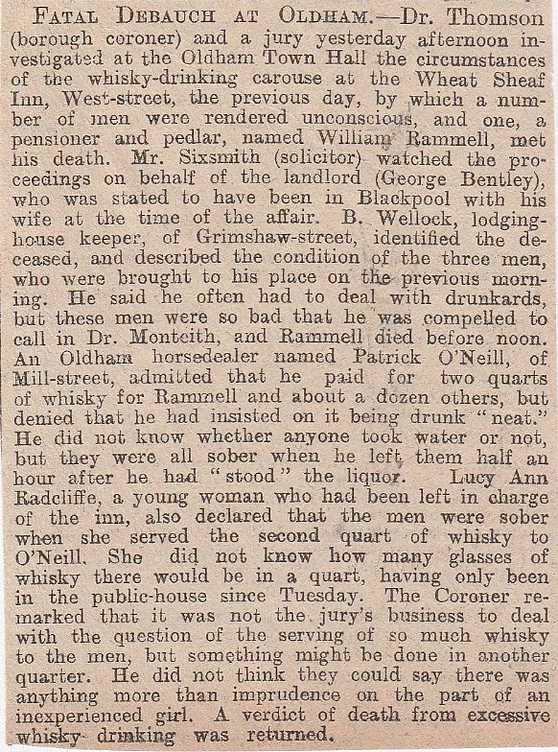
26/ Outwood Colliery, Prestwich, (Fall in Shaft) February 1899
A shocking accident occurred at Outwood Colliery when William Lowe, a 45-year-old single man of 57, Buildings Row, Ringley, was killed by falling down a shaft (No 3), a depth of 120 yards. He was a banksman and along with an under manager, Lomax of 52, Seymour Street, Radcliffe, was off to examine the shaft, which is used as an air shaft and to reach which the men had to pass along a covered passage which was in complete darkness, when by some means he missed his footing and fell to the bottom.
27/ Prestwich Asylum, (Lunatic Stomach Contents!) January 1876
A post-mortem examination of a lunatic who died at the Prestwich Asylum, led to the discovery of no fewer than 1800 indigestible items in his body. There were 1600 shoemakers tacks, six four-inch nails, nineteen three-inch nails, eighteen two-inch nails, nine brass buttons, bits of buckles, pebbles, string, shards of glass, a piece of lead and a leather strip.
28/ Agecroft Colliery Explosion, Pendlebury, February 1899
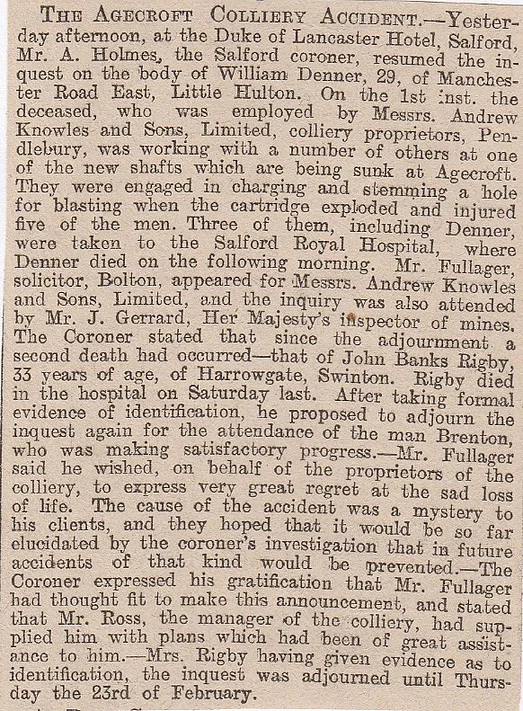
Agecroft Colliery, February 11th, 1899
Yesterday Samuel Brenton, who was injured whilst blasting in the Agecroft new sinking of Messrs Andrew Knowles and Sons, died in Salford Hospital. This is the third death from the accident. Brenton was supposed to be improving until a day or two ago and the inquest of the other two men had been adjourned in the hope of his being able to attend and throw some light on the cause of the accident.
29/ Wet Earth Colliery, Clifton (Salford), February 1899
Richard Thomas aged fifty-two-years, was killed at the Wet Earth Colliery of the Clifton and Kersley Coal Company at Clifton. The deceased man and his sons worked together. While he was in a stooping position, a fall of coal and dirt took place and buried him. His sons escaped. The verdict of the jury was “Accidental Death.”
30/ Pendlebury, (Hit by Rock) March 1899
An inquest was held on the body of Henry Yates aged thirty-five, a collier, late of New Street in Pendlebury. The deceased was employed at the Wheat Sheaf Colliery and on Wednesday whilst in the mine, a large piece of stone fell on him from the roof. He was badly injured and died the same day. A fellow workman named John Wardle stated that he thought the roof was sufficiently propped. Jury’s verdict”Accidental Death”
31/ Rochdale Workhouse Ether Explosion, March 1899

32/ Littleborough Drowning, Rochdale, June 1899
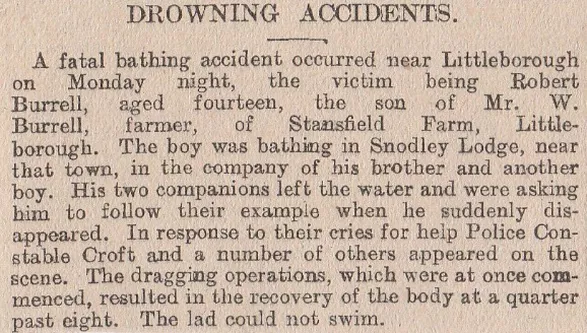
33/ Manor Road Fatal Fire, Altrincham, April 1899

34/ Ancoats Snowball Fatality, March 1899

35/ Stand Street, Ancoats, (Child Neglect) April 1899
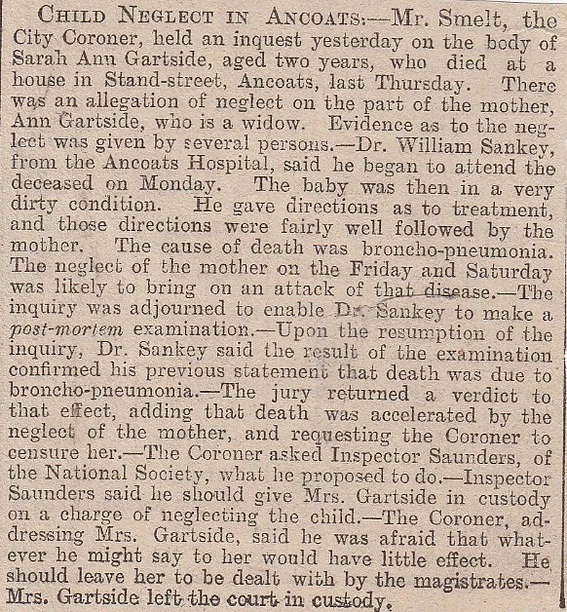
36/ Ashton-under-Lyne Town Hall, (Decomposing Corpse Discovered) January 1878
A shocking discovery was made at Ashton Town Hall, where small rooms on the upper floors are used to store ballot boxes etc.and are used very little. A lady went up there one day and was overcome by a horrendous stench. When searching about looking for the cause of it, she stumbled upon the corpse of a man in a corner. The man was dressed as a navvy and was decomposed beyond recognition, with the time of death estimated at several weeks. The room was last used in November 1877, for a municipal election. The name of the deceased is unknown and the verdict was “Death from Starvation.”
37/ Copperas House Pit Fatality, Ashton-under-Lyne, March 1899

38/ No.38, Murray Street Murder/Suicide, Higher Broughton, March 1899
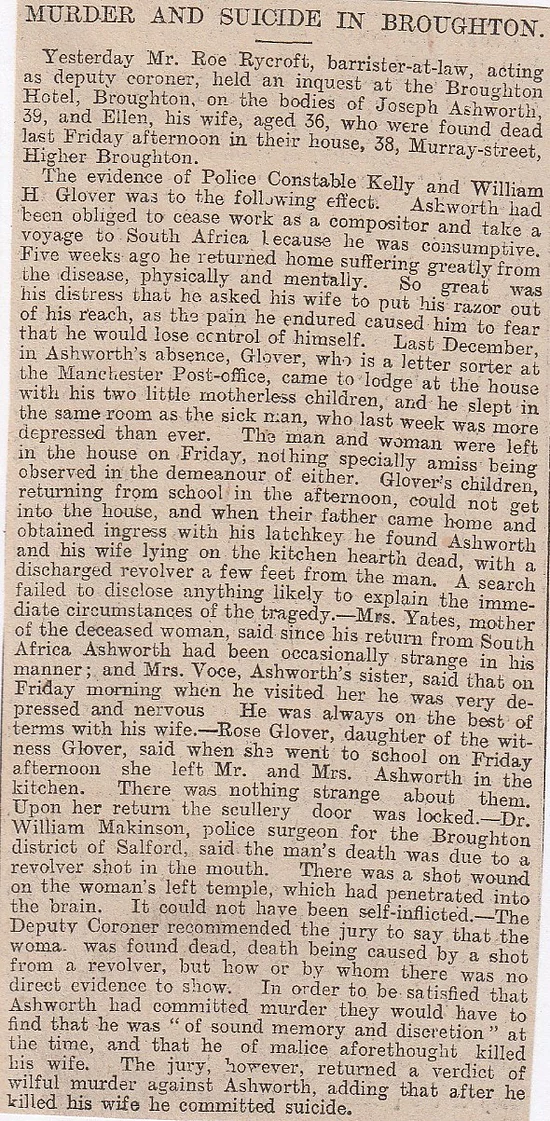
39/ Lower Chatham Street, Chorlton-on-Medlock, (Frenchman’s Suicide) May 1899

40/ Smedley Lane, Cheetham, (Fatal Accident) February 1899
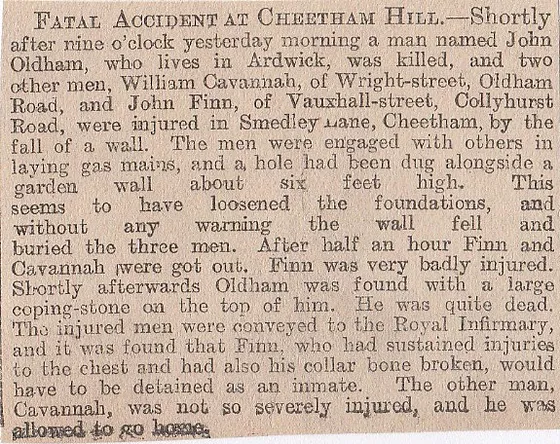
41/ Clifton Junction, Salford, (Children Deaths) March 1899
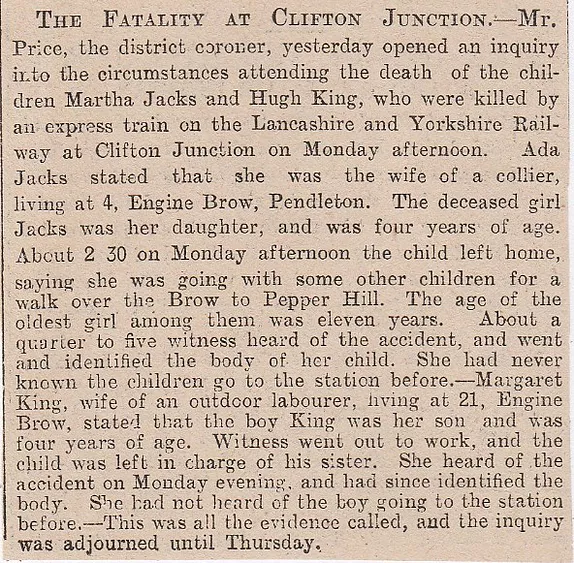
42/ Eccles Child Suicide, November 1859
An 11-year-old lad named Cameron was sacked by his employer, so he went home and told his Mum. She gave him a mouthful and told him off about his behaviour and she also stated that ” Your father will kill you when he get’s home”. This scared the living daylights out of him and rather than face his father’s wrath he went to the yard and cut the clothesline, he then tied it to the kitchen ceiling and hung himself.
43/ Lyceum TheatreFatal Accident, Eccles, February 1899
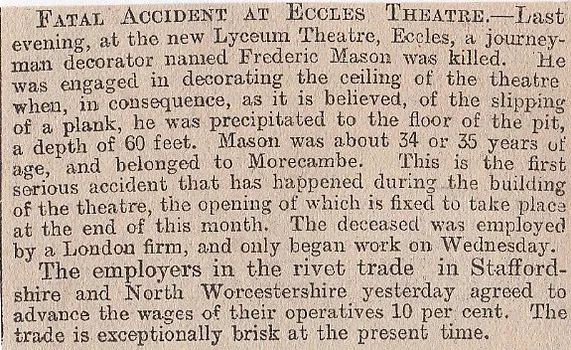
44/ Heaton Norris Junction Fatality, April 1899
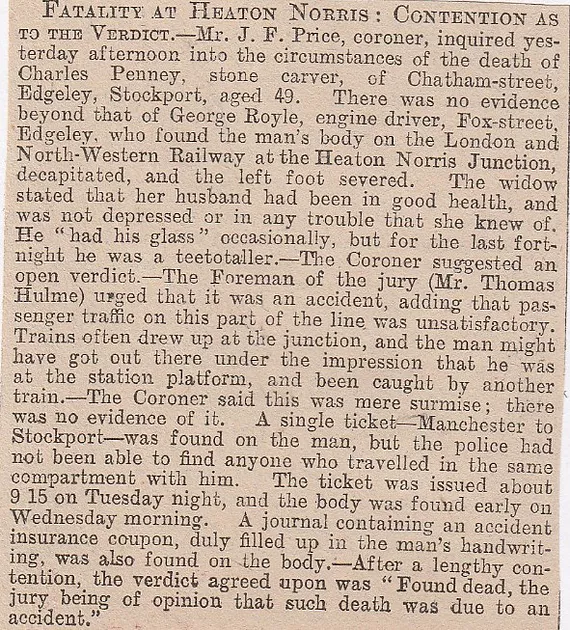
45/ Ellenbrook Station, (Killed at Level Crossing) February 1899
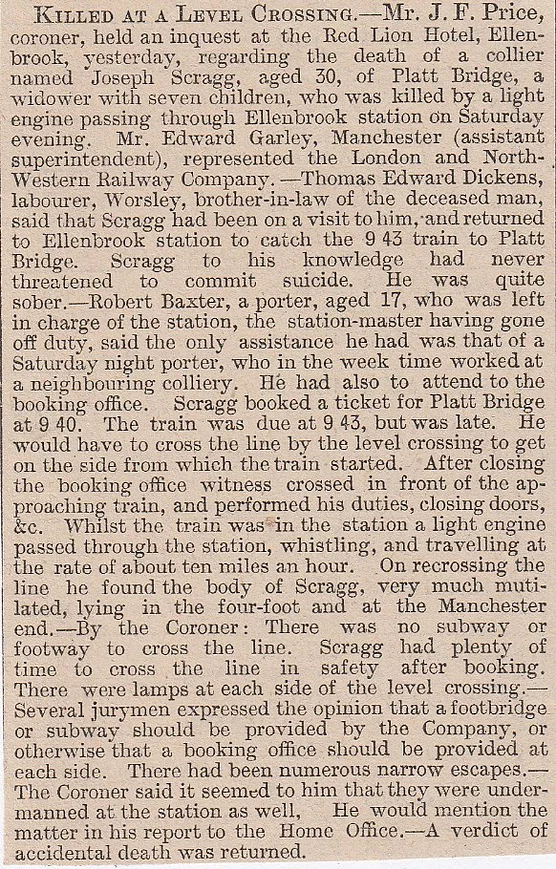
46/ Hollinwood Station, (Fatal Accident) April 1899
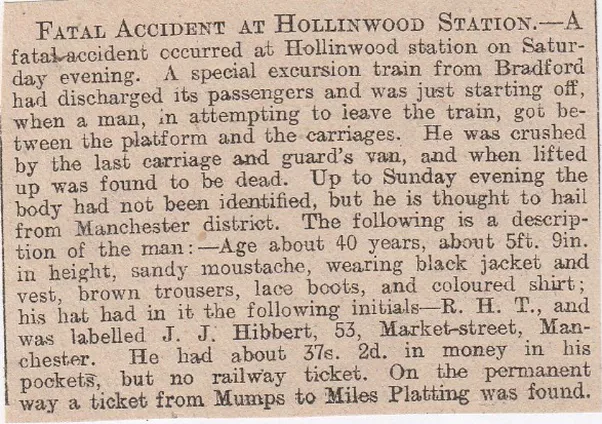
47/ Peak Forest Canal Drowning, Hyde, May 1899
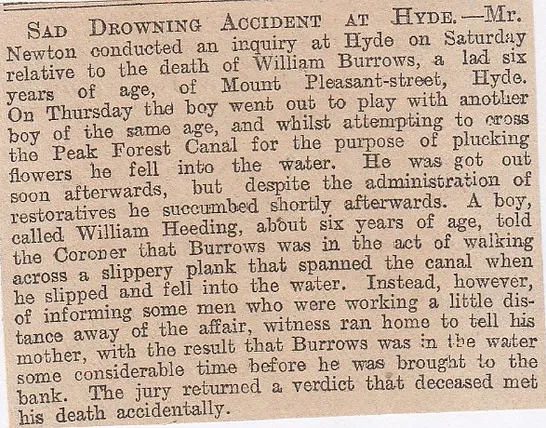
48/ Royal Oak Inn Fatal Fight, Leigh, May 1899

49/ Slattocks near Middleton, (Death in Canal?) March 1899
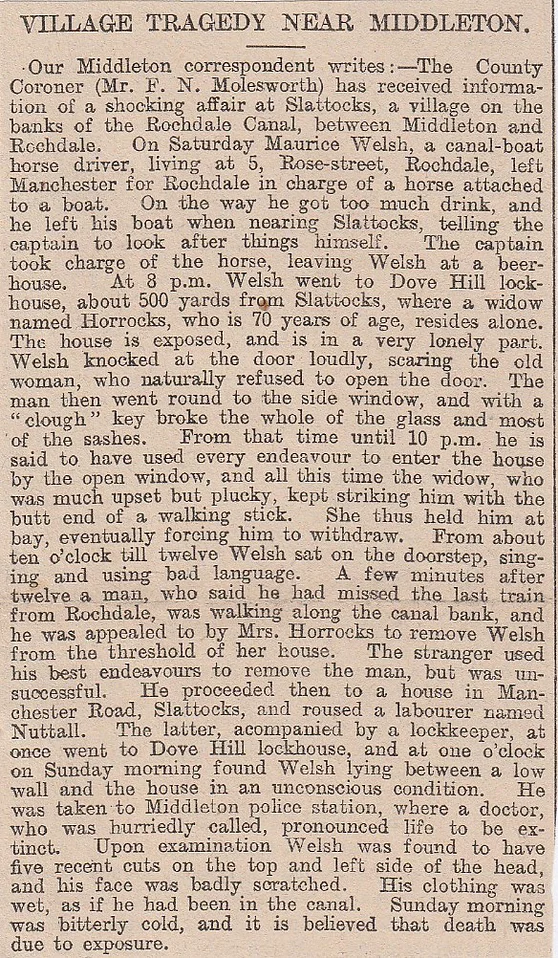
50/ Egerton Street Murder/Suicide, Mossley, April 1899
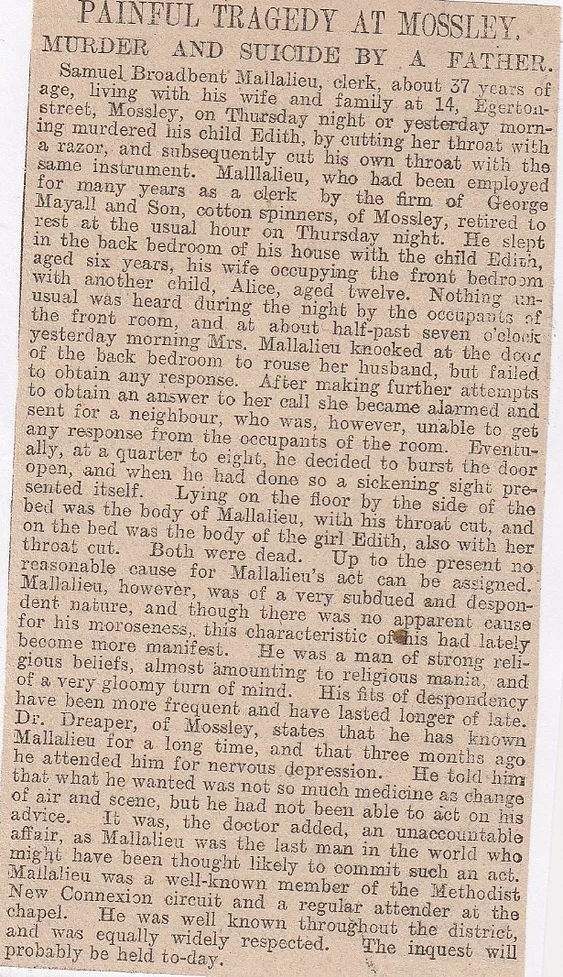
51/ Newton Heath Mysterious Drowning, June 1899
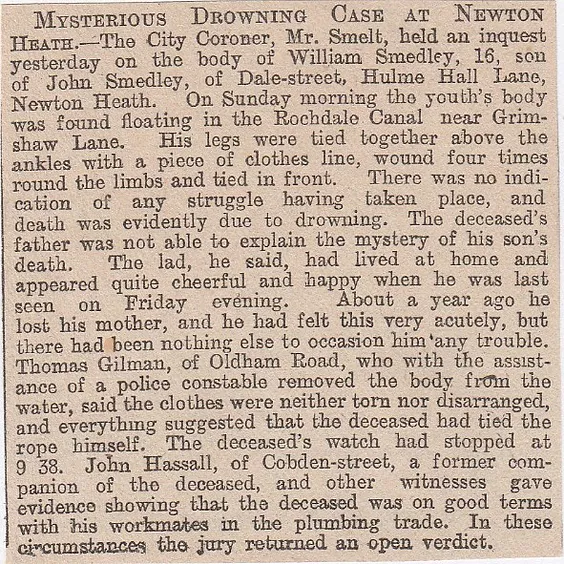
52/ Northenden Trap Fatality, May 1899
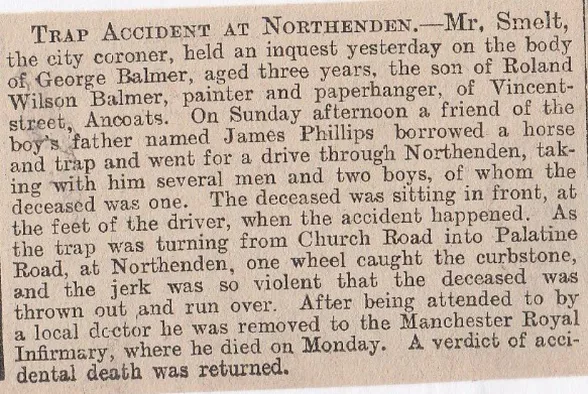
53/ Old Trafford Murder, April 1899

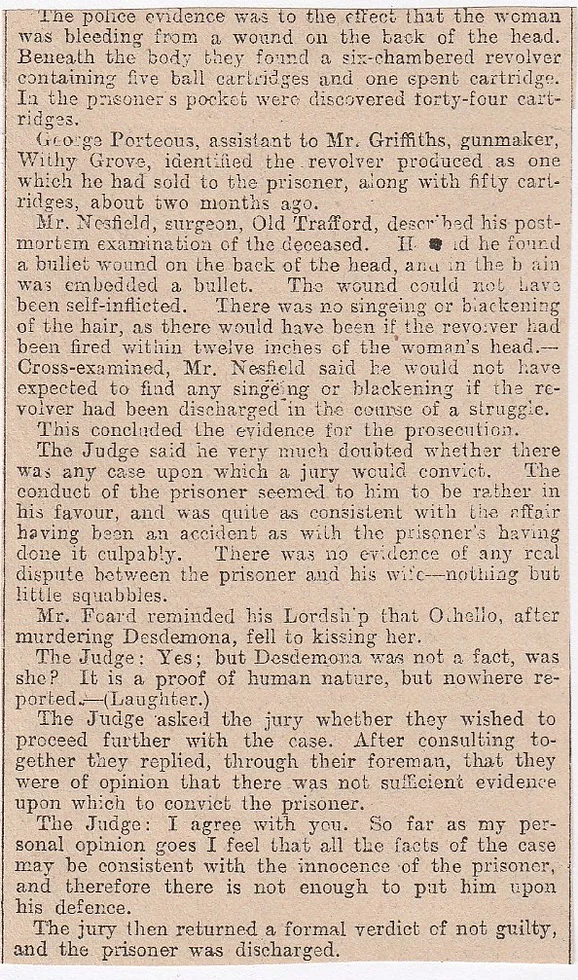
54/ Pendleton, (Caught in Machinery) February 1899
A collier named John Dobson, who resided at Whit Lane. Pendleton was in the act of crossing the engine brow at the colliery of Messrs.Andrew Knowles and Son Ltd in Whit Lane when he fell. He was caught in the engine rope and was wound around the drum. When picked up he was quite dead.
55/ Pendleton, (Child Murder/Suicide) April 1899
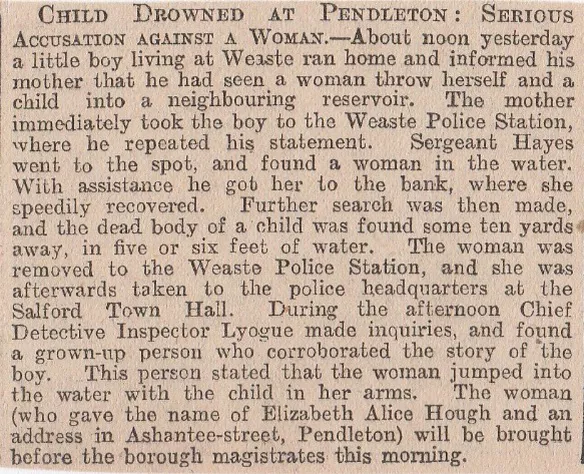
56/ Radcliffe Fatal Accident, February 1899
On Saturday morning an accident occurred in a hayloft at the premises of Messrs.Rigg Brothers, carriers, Crook Street of Radcliffe, to a boy aged ten named William Ainsworth, of 19 Crook Street, Radcliffe. He was playing with some friends in the hayloft when he was drawn between a revolving shaft and the ceiling. The engine was stopped and he was taken to Bury Infirmary, sustaining serious injuries.He died soon after. His father is away in America.
57/ Radcliffe, (Accident or Suicide?) March 1899
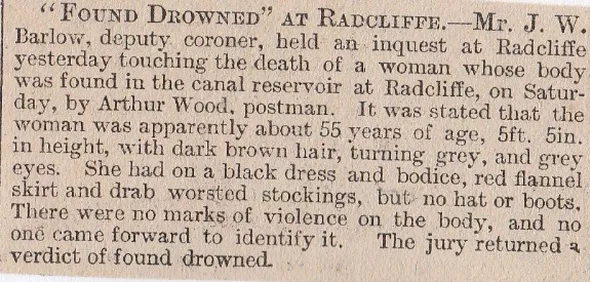
58/ Bridgewater Canal, Sale, (Boy Drowns) February 1899
On Sunday morning Peter Hobson aged nine, who lived with his parents in Roebuck Lane in Sale, was drowned in the Bridgewater Canal. He was going to Sale along the canal bank to get some newspapers, having a small canvas bag to put them in. He put the bag on his head, then accidentally walked into the canal. His elder brother aged eleven, who was with him, raised the alarm but when the little fellow was taken out of the water he was dead.
59/ Salford, (Corpse Eaten by Rats) November 1882
A carter made a shocking discovery while passing under No1.Railway Arch, Greengate. He found something lying on the road and when he got closer, it was revealed that it was the body of a man. The corpse was doubled up, head under the breast and the flesh on the neck, hands and face, having been eaten by rats. The neck appeared to be broken and in his pockets were nine shillings, three Roman Catholic medals and other bits and bobs. There was nothing to prove identity.
60/ Salford, (Mysterious Drowning) February 22nd, 1899
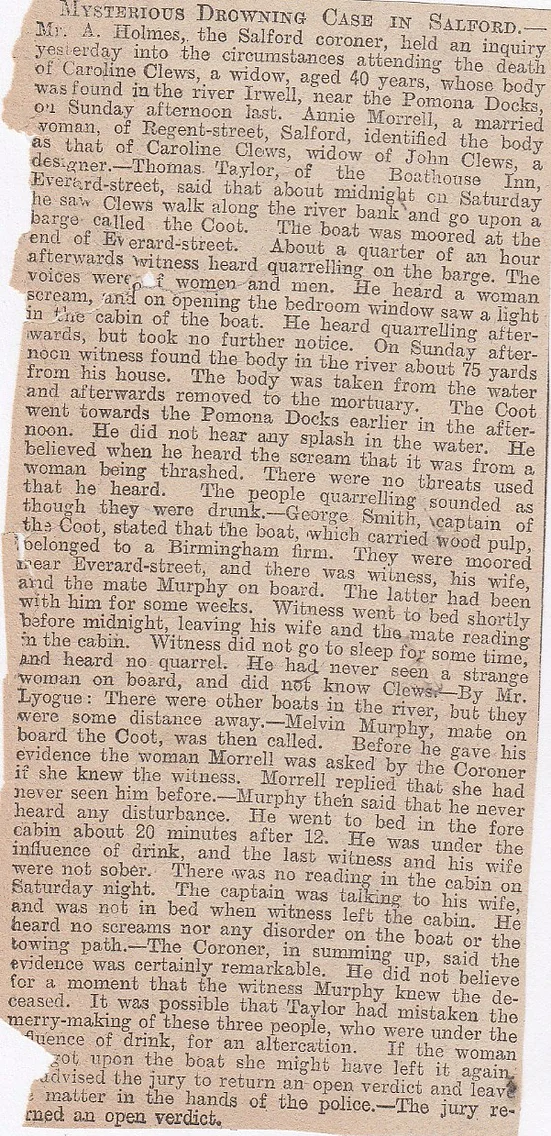
61/ Salford, (Heart attack?) March 25th, 1899
George Wilson, a negro, was committed for trial at the assizes on a charge of having caused the death of Jane Kiernan, a married woman, at a lodging-house in St Stephen Street on Saturday last. Evidence from a woman who lived at the house said deceased suffered from heart disease and that the least excitement or a blow such as was alleged to have been given by the prisoner would accelerate her death.
62/ Hope Hospital Fatal Accident, Salford, April 1899

63/ Salford Child Murder, April 1899
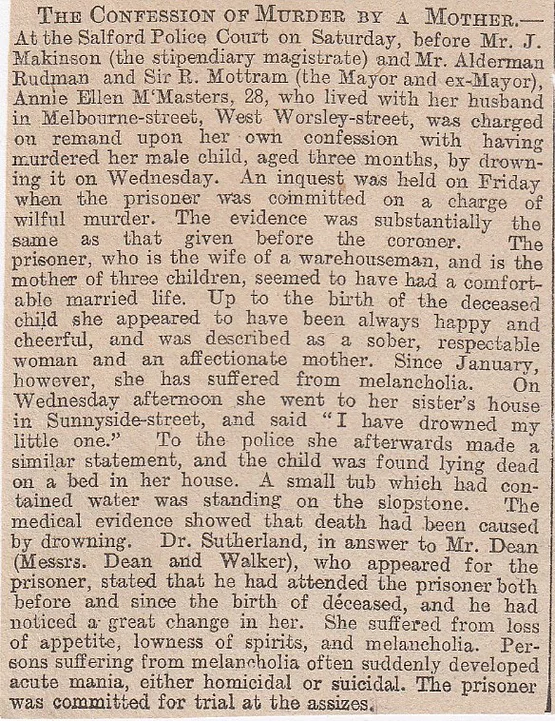
64/ Weaste Child Murder, Salford, May 1899

65/ Salford, (Lurry Boy Fatality) May 1899

66/ Salford, (Double Suicide Eaten by Rats) August 1897
In a Salford hayloft, the bodies of a young couple were found in an appalling state of decomposition. A carbolic acid bottle lay beside them and it is believed that they both agreed to suicide, in a sort of pact. This was some weeks ago, as the bodies had been nibbled at by rats and there wasn’t a lot left of them.
67/ Salford, (Teenage Revenge Suicide) June 1888
16-year-old Charles Marshall was spotted in the street with a tea-cup in his hand and said to a woman he was familiar with that he’d taken some vermin killer. He was rushed to Hospital but he died from strychnine poisoning on the way. A letter addressed to his Mum ended with the solemn words ” You will let me go out for a night now”.
68/ Mode Wheel, Salford, (Policeman Drowned) June 1899

69/ Linnyshaw Colliery Fatality, Salford, June 1899
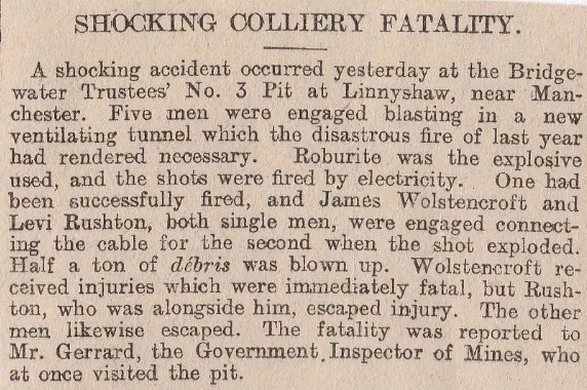
70/ Shawclough Station Rail Fatality, Rochdale, May 1899
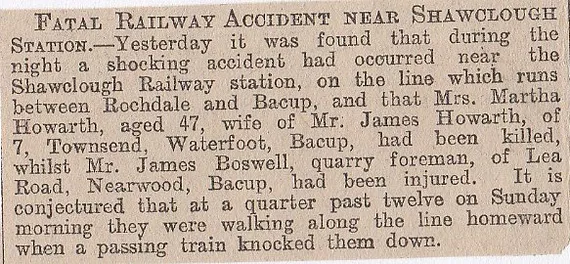
71/ Portwood, Stockport, June 1899
The death by drowning of a married man named George Ridgway was reported to the coroner. Ridgway who was a piecer aged twenty-nine, living in Pool Lane at Portwood, went to the river Goyt near his home to bathe. He was presumably seized with cramp, for he became quite helpless and shouted “Save me” several times. No assistance being at hand, he was drowned in nine feet of water.
72/ Stockport Fatal Fire, June 1899
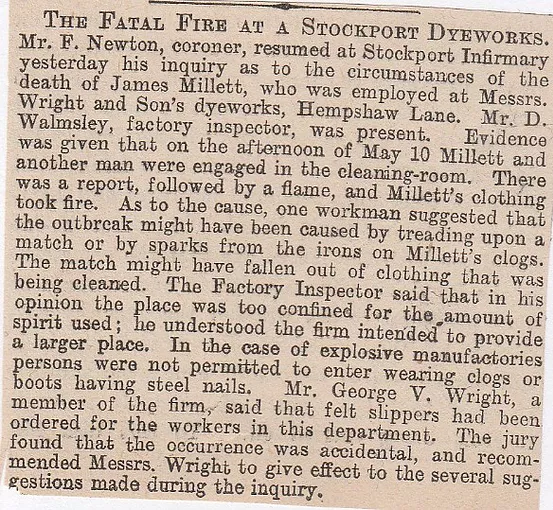
73/ Stockport, April 1850 (Bridegroom Suicide)
George Redfern, who worked at a Stockport pub, killed himself on his wedding day. Instead of getting wed, he popped into several pubs for a wee dram of Dutch Courage and in one pub he asked the barmaid if she wanted to get married. He went back to his lodgings, told his landlady that he would never get married, then he shot himself in the head. His body lay on his bed and was badly mutilated and the pistol he used set fire to the bed.
74/ Swinton, (Death of a Carter) May 1899
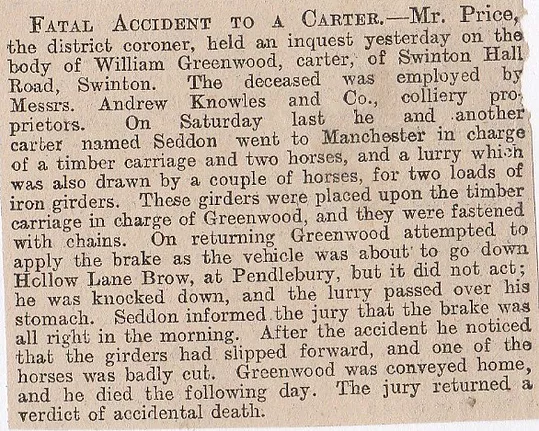
75/ Tameside Pit Fatality, (Dukinfield) May 1899
A fatal accident has occurred at the Astley Pit, Dukinfield. James Newton, a collier of Waterloo, was working in the Peacock Mine when a fall of roof occurred. Some soil and a stone weighing two hundredweight (16 stone), fell on his chest. He was extricated and found to be seriously injured. He was conveyed home on an ambulance and medically attended but died yesterday.
76/ Bridgewater Colliery Fatality, Walkden, June 1899
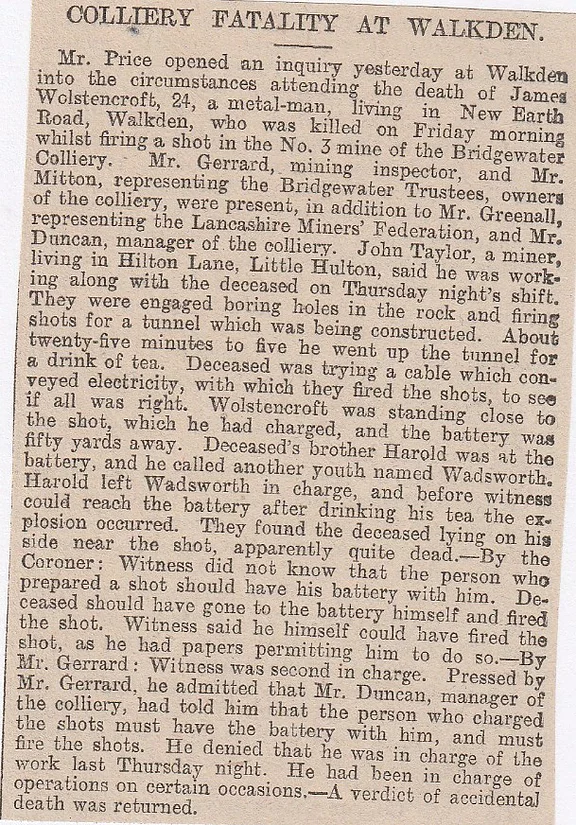
77/ Wigan, (Brandy Deaths?) December 1909
A publican took a number of men into the cellar to make arrangements for Christmas and they cracked open a barrel of brandy, then began swigging. Four men have died since, one in a pub, another went to bed in a hotel and was found dead the next morning, with a third found dead in an outhouse and the fourth died at home.
78/ Aspull near Wigan, (Murder?) April 1907
The body of a farmer, who lived at Aspull near Wigan, was found dead at his house. A couple of mates were going to his house and when they walked in he was laying on the floor, face downwards. His head had been smashed in and it seems as though an accident was not possible, due to the severity of the fractures. Verdict: “Wilful Murder against person or persons unknown.” (Who was it?)
79/ Wigan Drowning, March 1899
A man named Holding found a body floating in the Leeds and Liverpool Canal near the Lancashire and Yorkshire Railway Company’s locomotive shed at Wigan. He was identified as William Holmes aged forty-eight, of Mitchell Street, Newtown in Wigan. Holmes was an engine-driver and left the locomotive shed at three o’clock. There is little doubt that owing to the dense fog, he walked into the canal and was drowned.
80/ Wigan, (Boy Mutilated) March 1899
A youth named Thomas Wild of Lindsay Street in Wigan, was killed at the Wigan Coal and Iron Company’s Steel Works, Wigan. He was engaged letting waggons down an incline when he was caught between some waggons and a wall, his body being terribly mutilated.
81/ Moss Arley Mine, Ince, (Colliery Fatalities) June 1899
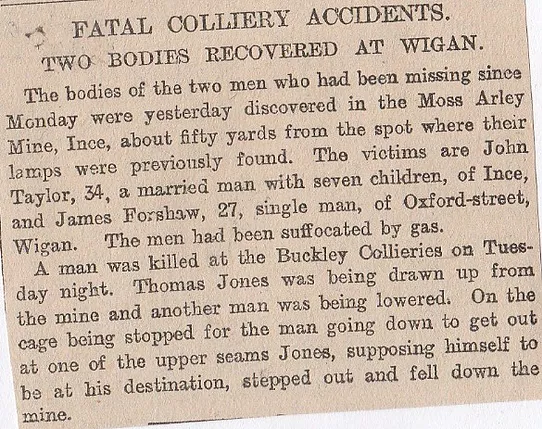
82/ Wigan Tram Death, February 1899
Eighty-year-old Annie Carr of Hindley, died from shocking injuries sustained by being run over by a tramcar, she was dreadfully mangled and was pronounced dead shortly after the accident.
83/ Wigan, (Colliery Roof Collapse) March 1899
A fatal accident has occurred at Pearson and Knowles colliery, Wigan. The victim was William Derbyshire aged forty-six, a collier, of Victoria Street in Ince. He was using a pick when a fall of roof occurred and partially buried him. He was extricated as quickly as possible by his brother and another man but expired straight away.
84/ Wigan, February 1899
Whilst shunting operations were being carried on at the St George’s siding of the Astley and Tyldesley Coal and Salt Company on Wednesday evening, John Howarth aged twenty-seven, of John Street in Tyldesley, was crushed against a wall and fatally injured.
85/ Wigan, (Man Buried Alive) February 1899
An accident resulting in the death of Richard Cox, a collier aged twenty-five, of Lower Lemon Street, Tyldesley, occurred at the Cleworth pit of the Tyldesley Coal Company. Cox stated to a man named Eckersley that he was going to knock props out and shortly afterwards there was a heavy fall of dirt and stone from the roof, Cox being completely buried under it. When extricated he was dead, the body being fearfully bruised.
86/ Wigan, (Three Die in Sewer) June 1899
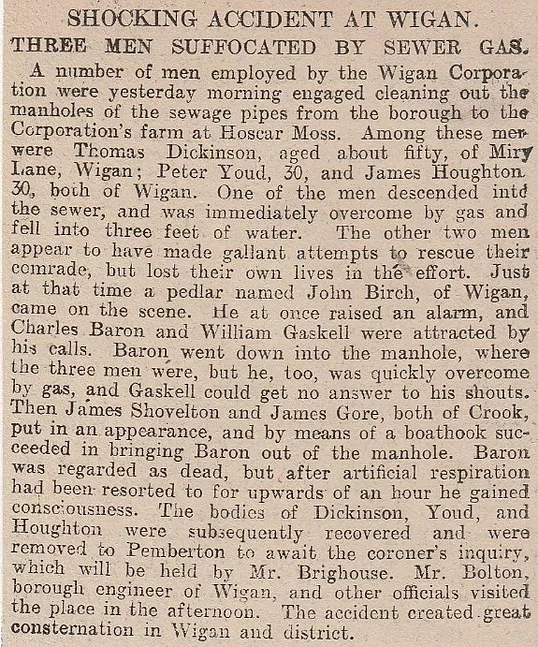
87/ Withington Church Suicide, January 1870
A body of an elderly man was found on a tombstone in the churchyard at Withington. A pistol lay by his side and with a massive wound to the head, suggesting suicide. The deceased was Mr G.Macbeth, a tailor from Stockport Road in Manchester. He had been behaving strangely recently and it supposed that the recent death of his children, had caused his deep melancholy under which the rash act was committed. (Which tomb?)
88/ Withington Child Murder, February 1899
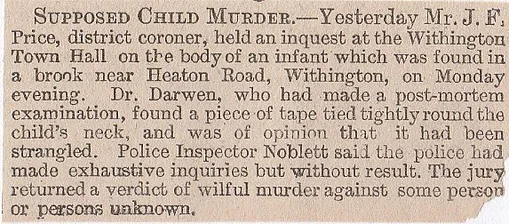
89/ Manchester Football Club, (Captain Dies Playing) December 1902
George Horwood, the captain of Manchester Football Club, died from his injuries he sustained in a footy match on Christmas Day. It was during extra-time when Horwood and another player collided and Horwood fell directly on his head and died of concussion of the brain. The verdict was “Accidental Death.”
90/ Holly Mount Convent, Tottington, (Nun Suicide) July 1893
Catherine Kepple was a nun who was staying at a convent in Killarney, but she started showing symptoms of insanity, so was ordered to be whisked off to a hospital in Belgium. Firstly she was brought to Tottington and while here she threw herself out of a third-floor window, dying instantly.
91/ Davyhulme, Trafford, (Child Body Parts) April 1895
An awful discovery was made at Manchester Sewage Works at Davyhulme, whilst workmen were going about their usual business they came upon a child’s leg. The leg looked like it had been ripped from the trunk and Manchester Police are looking into the matter. The top half of the body has not been found.
92/ Bolton, (Girl Scalded to Death) July 1889
A girl named Walker died at Bolton Infirmary from injuries received under strange circumstances. She was standing near an exhaust pump belonging to the engine room of a cotton mill, when the steam was suddenly let off, the result being that she was enveloped in steam and so scalded that her injuries terminated fatally.
93/ Rishton Lane, Bolton, (Doctors Wife Suicide) June 1889
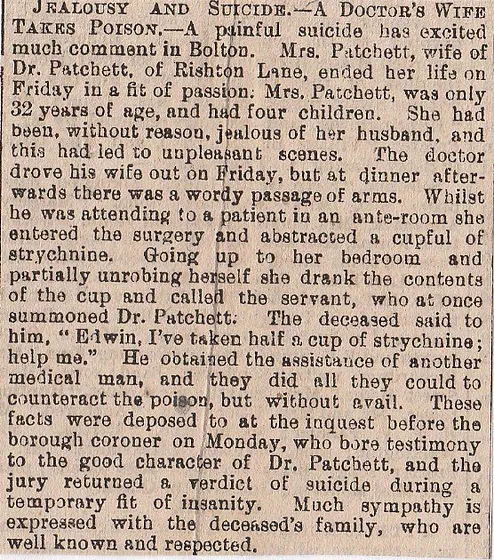
94/ Bolton, (Sweet-Tooth Suicide) January 1887
A young schoolgirl named Wharnby, who had told off for owing money for sweets, killed herself at Little Hulton near Bolton. A passer-by found her clothes next to a pond along with some cake!(Sweet tooth!) near her Dad’s house and her body was found later on.
95/ Atherton near Bolton, (Robbery/Murder) July 1889
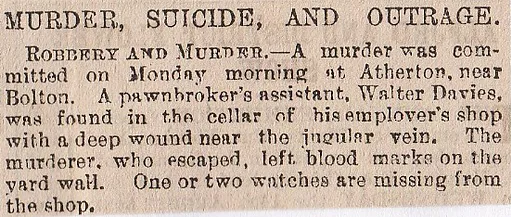
96/ Victoria Theatre of Varieties Fatality, Bolton, August 1891
A shocking fatality occurred at the Victoria Theatre of Varieties in Bolton. The performance had finished when an attendant named Chris Birch was on the balcony, covering it up with a cloth when he overbalanced and fell head first into the pit causing severe spinal injuries. He was a single man and thirty-five-years-old, but weirdly not one person saw the actual fall and he never let out a scream. (Is it still there?)
97/ Bolton, (Boiled to Death) April 1892
The body of a man whose identity is unknown was found in the hot water lodge of Messrs Thomas Cross and Co., bleachers of Mortfield. The chap had been literally boiled to death and it was also thought to have been an act of suicide, the reservoir being away from the road.
98/ Eltonfold Landslip, near Bury, October 1896

99/ Bury, (Caught in Machinery) December 1833
Alice Crossley, a widow, died a violent death under the following circumstances. Alice worked for a Mr Nicholas Hoyle as a winder in his woollen mill and she worked in the basement area. At three p.m. on Monday afternoon she descended the excavation on the outside of the back part of the building to clean her window. While doing this, her shawl got tangled in an iron shaft that ran through a gap in the window, to turn the machinery in the mill, and it wrenched her neck tightly to the shaft. She was rotated round with such violence that death was the obvious outcome. A painter working nearby tried to help her, but if he had tried to untangle he too would have met the same fate. The engine was stopped and she was cut free and taken home, where “after a faint sob, she expired.”
The shaft was travelling at sixty r.p.m. and as she was a tall girl, her limbs flailed around like a rag doll and she was badly mutilated in the accident. The verdict was “Accidental Death.”
100/ Stretford Child Murder, January 1921
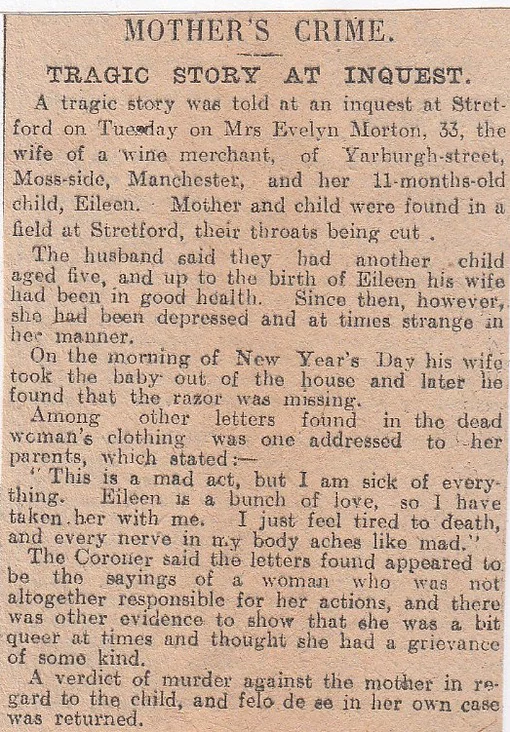
101/ Angel Inn Suicide, Oldham, July 1857
The landlord of the Angel Inn at Oldham, William Heginbotham, committed suicide on Sunday night by hanging himself from a kitchen roller towel.
102/ Oldham Station Suicide, May 1892
Fourteen-year-old newsboy, Ernest Jones, killed himself by throwing himself under a passing train at Oldham Station. Jones had been reading “pernicious literature”, which I can’t work out if it’s porn or occult material. Anyway, before he died, he told a mate of his “This is the last time you will see me alive.”
103/ Oldham Workhouse, (Body in Cistern) June 1871
A thirty-six-year-old man named Richardson, who used to be a painter, was admitted to the imbecile ward at the Oldham Workhouse. He been on the bottle for quite a while and had been suffering from delirium tremens (shakes from alcohol withdrawal), and had threatened to kill his wife and himself on a few occasions. Richardson and another bloke, who was in the same condition as he was, was left to keep an eye on him but Richardson went missing. It was thought he’d escaped and gone on a bender to the pubs. After a couple of weeks went by a nurse told the governor that the water was had a strange stench and inmates were getting sick as a result. He told them to clean the cistern, so they went to examine it and found a man’s legs protruding from it. It was rotten and gave off a chronic odour and was identified as that of Richardson. Due to his threats of suicide, they assumed it was self-inflicted, and also down to his delirium tremens, he thought he’d be better off dead.
104/ Oldham, June 1876
Mrs Dodd was on a downer since her sister committed suicide around six months ago. She was kept under watch, but one day she sent a servant on an errand and while he was out she hung herself from the bed-rail with a silk scarf. Wanted to be with her sister?
105/ Royton Matricide, near Oldham, August 1892
Patrick Gibbons, a labourer, was sentenced to death for the murder of his mother at Royton near Oldham. The prisoner lived with his father and mother and on July 9th, when under the influence of drink, quarrelled with his mother, who was afterwards found with her throat cut.
106/ Oldham Coalpit Suicide, March 1852
Spencer Suthers, a cotton spinner, living at Oldham, killed himself by leaping down a coalpit which was owned by Messrs.Evans, Barker and Co. He suffered from rheumatism and was only in his late fifties and it was the pain from this that made him go to the mine in the morning. While the men were near the pit mouth, he clasped one of the two ropes of the cage, then leapt into the abyss. The pit is 150 yards deep and he landed upright, while on his descent one of his legs was cut off, coming into contact with the lift cage top. Four men went to his aid but he was already dead. He leaves a widow and three children.
107/ Burns Mill, Heywood, (Crane Fatality) August 1892
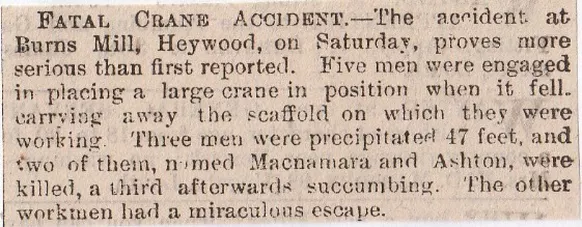
108/ Heywood Tram Deaths, Rochdale, June 1897
Two boys were killed in tram accidents at Heywood. The boys named Wood and Moffitt were run over on the Bury, Heywood and Rochdale tram system within quick succession of each other. Wood was dreadfully mutilated, his brains were scattered all over the pavement. Moffitt’s suffered severe spinal injuries and was already dead when he prized from underneath the tram.
109/ Littleborough, Rochdale, (Brother’s Suicide as Sister Throws Child in Canal) September 1861
Concealment of birth was a common crime in Victorian England, but the outcome of this one caused more than one death. A lass named Hill, bore the illegitimate child at Littleborough. She was one of two sisters and had a brother too. When this brother found out that his sister had tossed the dead child in the canal, he, stricken with grief, drowned himself in Manchester. The mother of the child was charged with concealment of birth.
110/ Horse Shoe Inn Fatality, Rochdale, December 1858
A nasty accident took place at the Horse Shoe Inn at Rochdale, when James Schofield was helping to put a hearse under a cover, he was squashed between the vehicle and the wall and died a few hours later.
111/ Rochdale, (Lad Mutilated in Machinery) January 1834
Fifteen-year-old Thomas Rhode worked in a factory as a woollen feeder at Mr Schofield’s factory, Canal Side, Rochdale. A strap from the engine came off and trying to put it back himself, the strap caught hold of his ankle and carried him up. Rhodes screamed out for help and a couple of workers went to his aid, but he was taken around the drum and was forced through a ten-inch gap and his head and legs were ripped off and his innards spread about.
112/ Ashworth Haunted Vicarage, Rochdale, November 1907
The Rev.J.E.Floyd, who is the vicar of Ashworth, had been hearing strange voices at the vicarage and now the local belief is that it is haunted. At 1-30 a.m. some sounds were heard by the entire family and the voices of three or four people arguing were clearly audible. This was interrupted by the calming voice of a woman saying “Home Sweet Home!”, then after that a mumbling voice was heard. Inquiries have turned up nothing as of yet. (Zack Bagans where are you?)
113/ Belfield Hall Suicide, Rochdale, August 1835
Edward Clegg Esq. of Belfield Hall near Rochdale killed himself at his home. It appears that inquiries were being made into the affairs of J.Schofield Esq., his father-in-law. Clegg had some interest so he sent offers of help to his solicitor on how he could bail him out, or vice versa. The offer was rejected and this made him angry and twisted, so he went to Belfield Hall and told his missus “It’s all over. It’s all over!”, legged it upstairs and slit his throat. Mrs Clegg tried to stop him and she got a few razor slashes for her trouble. (Now Clegg Hall- restored?)
114/ Crofts Bank/Patricroft, (Fatal Ice Accidents) January 1885

115/ Victoria Street Music Hall Tragedy, (Twenty-Four Dead) July 1868
The music-hall in Victoria Street, known as “Ben Lang’s” was the scene of a great calamity on Friday night. It was a benefit performance and it was during this, that some lads in the pit area stood up on the benches. To stop themselves from falling they grabbed hold of a gas pendant, this snapped off and then the gas began to escape. Cries of “Fire” got the audience into a mass panic and people were trampling and treading on each other in a bid to get to the exits. There was a huge crowd on the stairs and this gave way, throwing them on to the stone floor below. When the carnage was surveyed they pulled out twenty-three dead bodies and dozens of injured. After the word got around, literally thousands gathered, some rubber-necking and some to find relatives or friends who may have been there. A boy died the following day from concussion of the brain, making the death toll twenty-four.
116/ Deansgate Fatal Accident, February 1885
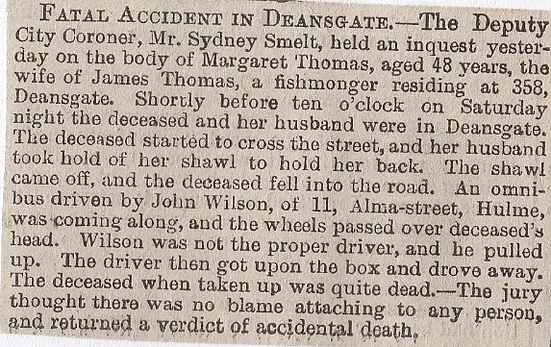
117/ Spread Eagle Hotel Suicide, November 1888
This is one of quite a few that feature on this website that still exists and the Spread Eagle Hotel is on Wilbraham Road.
A man entered the hotel, told them he’d be staying for a week or so and gave the name of Morris. He had been there nearly a week and on the morning he was given some refreshment, then he went on his way. He wasn’t seen until that night when his door was pried open and he was there, sitting in an armchair with a gun in his hand and a large hole in his temple. A letter addressed to his brother asked him to tell his wife what had happened, suggesting this act was premeditated. His real name turned out to be William Morris Pugh. (Does anyone from the Hotel know anything about the room number?)
118/ Exchange Station Fatal Accident, (Closed 1969) April 1885
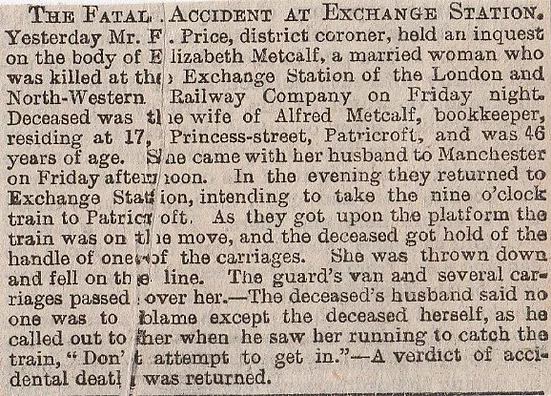
119/ Carter Street Child Murder, Chorlton-on-Medlock, April 1885
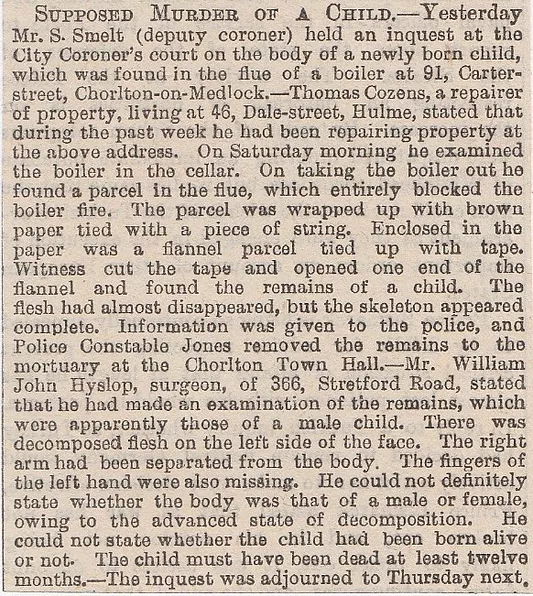
120/ St Ann’s Square Suicide, November 1871
At about five a.m. on a Sunday morning, a young lass threw herself from a window at Mr Furniss’s jewellers, opposite St Ann’s Church. The victim was a niece of the shop-owner and she landed on the flags below the shop. Death was instantaneous. She had been in a lunatic asylum recently and also depression had been a problem. (What was her name?)
121/ Crown Inn, Rusholme, (Drayman Crushed by Barrel) May 1885
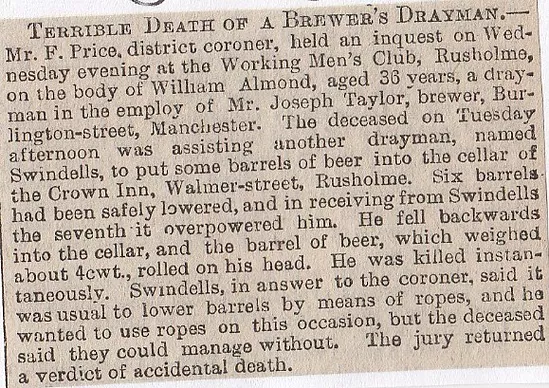
122/ Ancoats, (Torture then Murder) April 1905
The body of a youth was found in an abandoned house at Ancoats. Post-mortem results reveal that the lad was tortured; his mouth was filled with paper and tied with a handkerchief to prevent the boy screaming. His face was smashed in with a brick, which was found near the body and was daubed in blood. Later on, the mother of the victim identified him as Thomas Smith of Wood Street, Clarendon Street in Chorlton-on-Medlock. He had been missing for about a week, but no reason can be assigned for the crime committed on the poor boy.
123/ Rochdale Canal, (Two Bodies Found) June 1885 (Chorlton Street – next to Manchester Met.University)
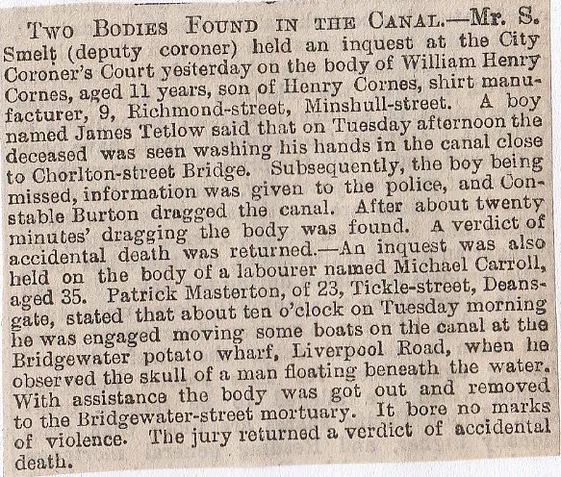
124/ Gorton Child Murder, June 1885
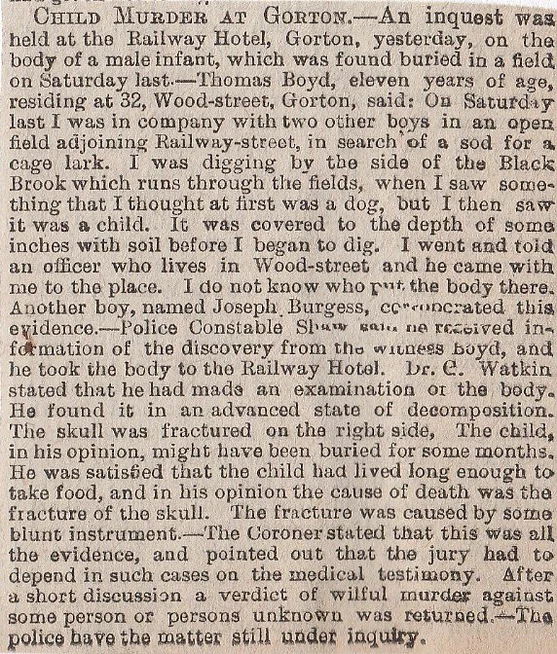
125/ Lower Broughton, (Rotten Male Corpse Found) April 1890
A group of boys were playing near the factory of Messrs.Dewhurst and Co., Hough Lane in Lower Broughton when one them climbed on the roof which is divided and slope towards the centre, forming a gutter and here found the remnants of a male corpse. It had been there for some time, it was badly decomposed and post-mortem results say he been dead for several months. He was estimated to be thirty-five-years-old and quite short in stature, about five feet tall.
126/ Victoria Station, Manchester, (Fatal Accident) September 1885
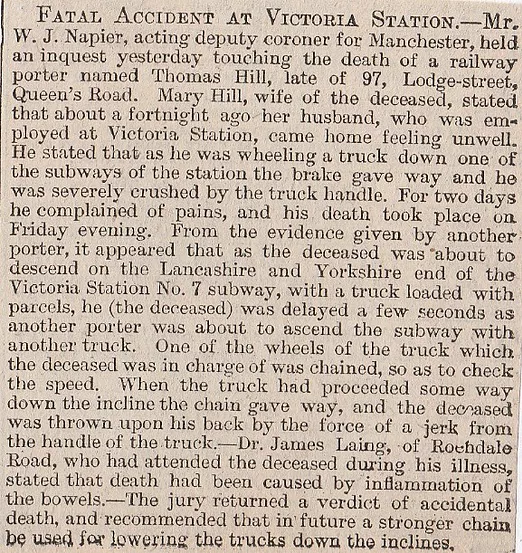
Victoria Station, Manchester, (Boy Crushed) September 1885
An inquest was held yesterday on the body of Ernest Stanley, eight-years-old, who lived with his parents at 59, Edward Street, Lower Broughton. On Tuesday afternoon, just before two o’clock, he accompanied his brother, a lad of fourteen, to Victoria Station. Whilst playing on the metals in the old London and North-Western portion of the station he was crushed by some waggons which were being shunted and was killed. “Accidental death.”
127/ Rochdale Canal, Ancoats, July 1885
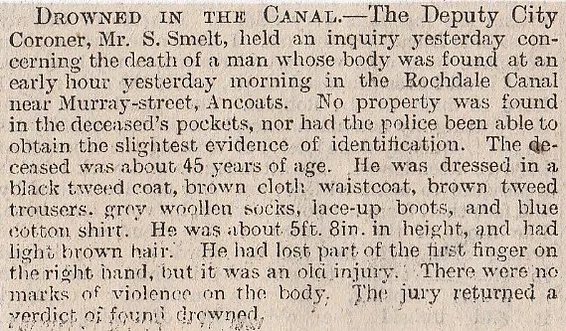
128/ Clarendon Inn, (Body in Cellar) June 1885 (Used to stand where Manchester Met.University entrance is now. Closed in 1964.)
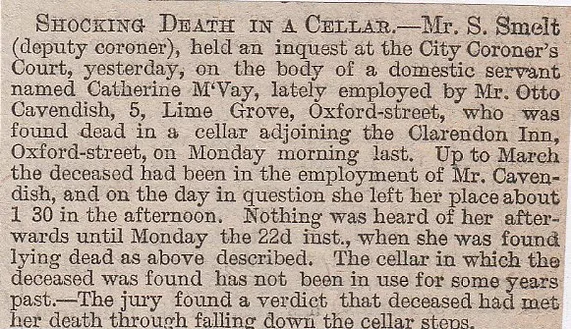
129/ Gorton, May 1909 (Man’s Head Blown Off)
William Lees, a sixty-six-year-old from Gorton, who was a labourer at an engineering works, was discovered with the top of his head blown off, done by some liquid explosive such as nitroglycerine. He woke up at five a.m. and went down the stairs, then his wife heard a muffled explosion. The force was great enough to smash all the kitchen windows. When she found her husband, he was sat down but with the top of his skull missing and a bottle of liquid on the floor, with the man’s fingers missing on his hand. (Deliberate or Accident?)
130/ Gorton Tank Works, (Deadly Explosion) September 1885

131/ Victoria Station Fatality, Manchester, November 1885

132/ London Road Station Fatality, (now Manchester Piccadilly) October 1885
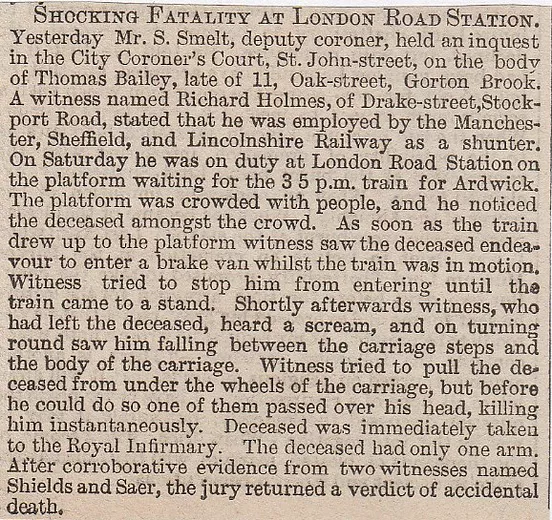
133/ Manchester Post Office, (Infant in Box) April 1891
On the 24th of April, a parcel was posted from Westgate-on-Sea near Margate and addressed it to “Mr Warton, No.2, Grove, Ambleside”. There was no such address, so it was placed in the “Dead Letter” department at Manchester Post Office. The package was opened and inside was the body of a new-born infant. The box it was wrapped in was a lady’s boot box and the marks on it could lead to the identity of the sender.
134/ Moss Side Child Murders, June 1885
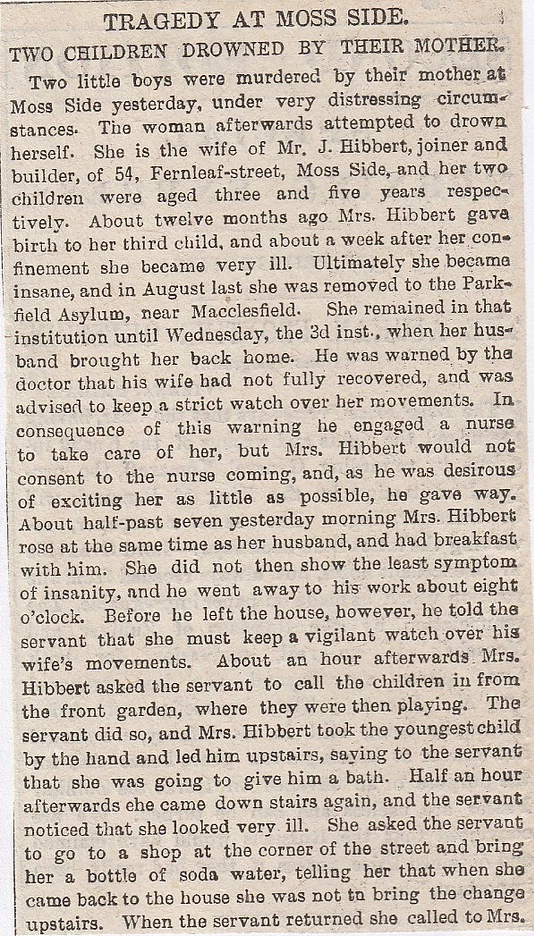
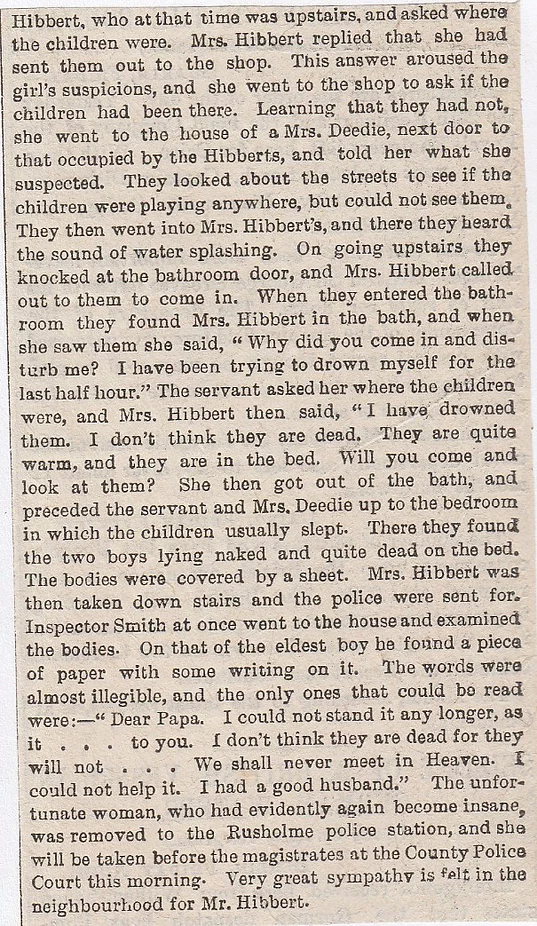
135/ Edward Street, Moss Side, August 1902 (Haunted House)
An electrical engineer and his wife and family moved into one the houses on Edward Street in the Moss Side district of Manchester. They kept hearing strange noises in the night, taps running, doors banging and furniture being moved around accompanied by a groaning sound. The neighbours thought he was barmy, but when he took them in to experience the haunting they soon changed their minds. While the mother was singing a lullaby to her child one night, the figure of a man was seen coming along the lobby. When she turned away and then turned back, he’d disappeared. The woman’s sister has observed a small boy in the same lobby. Locals say that nobody has lived in the property for more than a couple of weeks.
136/ Strangeways Prison Suicide, December 1885
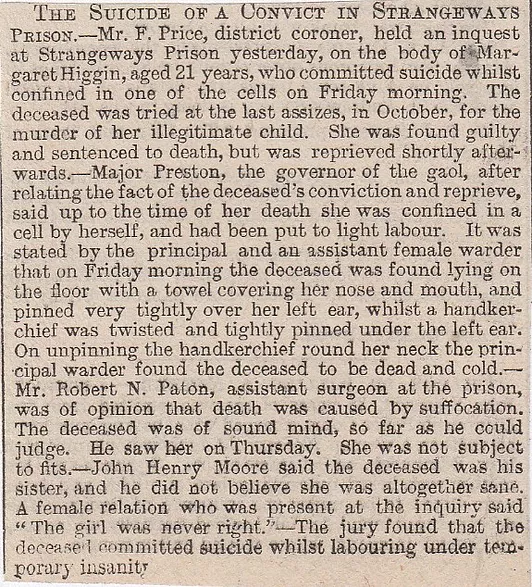
137/ Pendlebury Suicide, (Salford) March 1894
The body of twenty-four-year-old Robert Whittle from Moss Lane, Pendlebury, was found in a clay-pit. The bizarre thing about this story is that he wrote his suicide note on a starched cuff. It read:
“Dear Father and Mother, sisters and brothers- Don’t weep for me. I have been wronged. you will find my body in that hole opposite Tom Jones’s hen-cote. Goodbye. Bury me beside mother in Ringley Churchyard. You will find more about me at Cardwell’s Old Beerhouse. Don’t think I’m insane. I am all right. You will find two pounds in the lower drawer of my bedroom, which will help you to bury me. Goodbye- ROBERT WHITTLE.” (The sentence about “being wronged” is said to refer to his sweetheart.)
138/ Hope Street, Salford, (Oil Lamp Death) January 1885
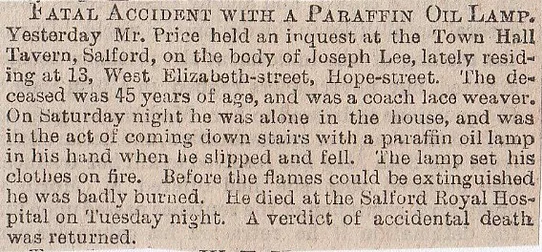
139/ Hope Street, Salford, (Four Crushed by Ten Ton Box) September 1909
At George Leek and Sons, Hope Street, a number of men were hoisting a ten-ton moulding box when something gave way and the box fell and crushed to death four workmen. The box was lifted and they were taken to Salford Royal Hospital. Two of the men, Catlow and Dutton, were dead on arrival, with the other two, Dimlow and Leek dying half an hour later. Dead were:-
John Dutton, 27, foreman of Seedley; Robert Catlow, 51, labourer, from Salford; Thomas Dimlow, 19, labourer, Salford; and James Henry Leek, 31, moulder, from Seedley.
140/ Blackleach Lodge, Little Hulton, Salford, (Ice Fatalities) January 1885
An inquest on the bodies of William Baxendale Partington aged eight and Frank Williamson aged six, who lost their lives on Wednesday by the breaking of the ice on Blackleach Lodge, Little Hulton. They were both sliding when the ice broke and they were drowned before they could be rescued. Verdict “Accidental Death.”
141/ Regent St.Ragged School, Salford, (Tea-Party Fatalities) January 1885
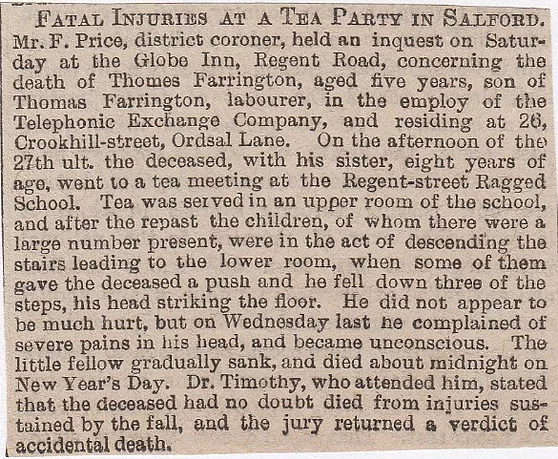
142/ Eccles, (Ice Fatality) January 1885
A young man named William Henry Ashworth of Patricroft, at between nine and ten last night was skating on a frozen pond at Fox Hill when the ice broke, he sank and was unable to reach the bank. There were seven or eight other people on the pond at the time. It was some time before his body was recovered.
143/ Eccles, (Child Burns to Death) January 1885
A child named George H.Gratrix, aged two years and five months, residing in Ellesmere Street in Patricroft, has met with a shocking death. On Saturday night he was playing in the kitchen and while trying to reach a piece of cake pulled over the table, on which stood a paraffin lamp. In the fall the lamp was broken and it set fire to his clothes and burnt him shockingly about the head, arms and face. He died later at Eccles and Patricroft Hospital.
144/ Bridgewater Canal Drowning, July 1885
John Frederick Crowley aged seven was drowned at Bridgewater Canal bank, near Royle’s Farm. He was rescued and attempts made to resuscitate him for twenty minutes, but he eventually died. He had been gathering flowers. The verdict was “Accidental Death.”
145/ Regent Road Bridge, Salford, (Body in Irwell) March 1885
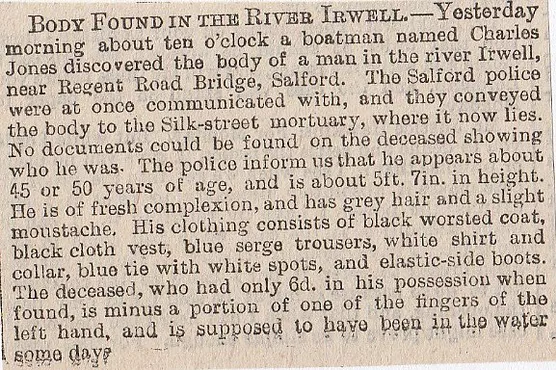
146/ Salford Hospital Suicide, April 1885
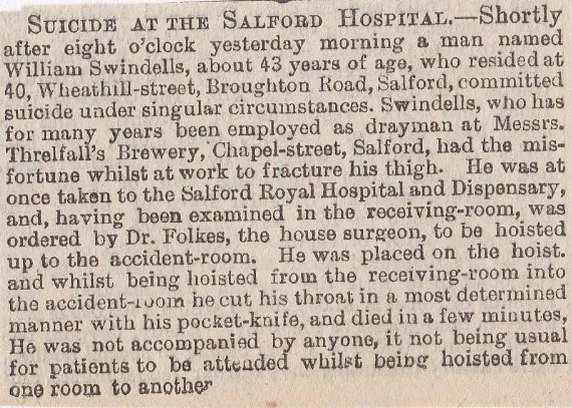
147/ Waggon and Horses Inn Suicide, Back Bridge St., July 1885
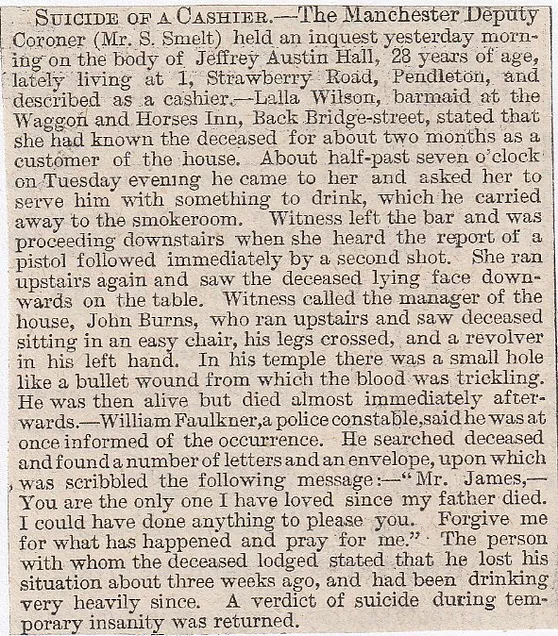
148/ Clifton Hall Colliery, Pendlebury, (Fatal Accident) August 1885
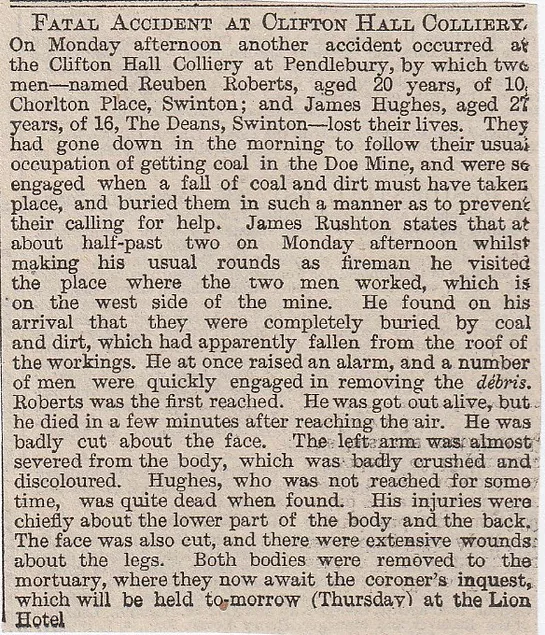
149/ Mode Wheel, Salford, October 1859 (Woman Posing as Man for Forty Years) HOW!
The coroner at Salford got the word that the body of a man had been discovered at Mode Wheel on the Irwell. At first glance, the body was that of a 50/60-year-old male and it was found by a man named Yates at the Mode Wheel Works in an upright position in the sluice leading from the Irwell. He got another person, James Moyles, to help him get the body out and take it to the Swan Inn at Pendlebury. Mary Gorton of the Swan Inn said this was the guy who spent a couple of hours drinking there, smoked his pipe, then left stone cold sober. Before leaving he asked what time the gates of the lodge leading to Mode Wheel were closed, but he seemed upset to the landlady. The man was known as Henry Stokes, but HER real name was Harriet Stokes and had lived as a man for forty years or so. Employed as a bricklayer for several years, helping build houses, chapels and warehouses in the area. The body was examined by two women and it was confirmed she was a woman. Apparently, she even married a woman quite a while ago and lived as husband and wife in Quay Street in Manchester.
150/ Salford, (Fatal Street Row) December 1885
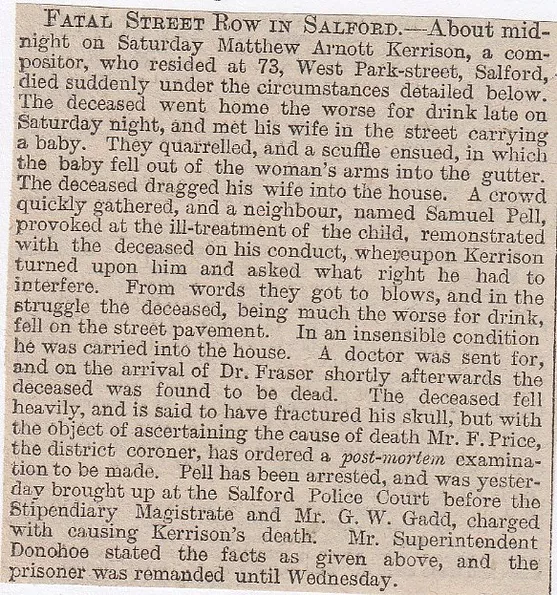
151/ Oldfield Road, Salford, (Woman Killed by Bull) December 1885
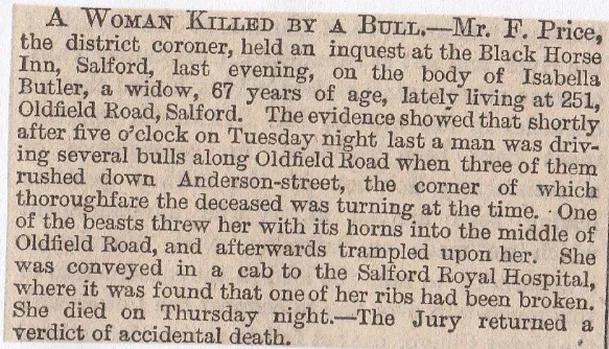
152/ Marple, Stockport, (Infant Mutilated) February 1881
The corpse of an infant was found under the railway viaduct at Marple by a group of lads. It was wrapped in a Punch newspaper and had one arm broken, the skull was bashed in and a big hole in the back of its head, through which the brains had gone. Police are investigating the possibility that it had been thrown from a Manchester train.
153/ Stockport Railway Station Fatality, September 1885
On Friday night a domestic servant named Martha Bennett aged twenty-three, living at Hill Top in Cheadle Hulme, tried to get on a train at Edgeley Station at Stockport whilst it was in motion. She slipped and fell between the train and the platform, receiving such injuries from several carriages passing over her that she died in the Stockport Infirmary early Sunday morning.
154/ Tiviot Dale Railway Station Death, Stockport, April 1885
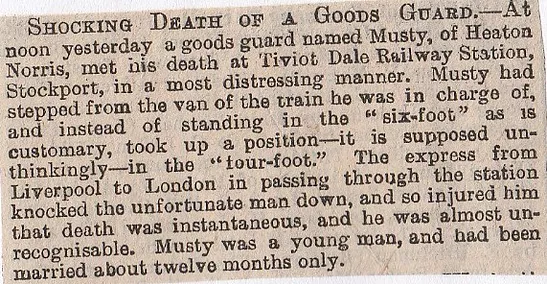
155/ Peak Forest Canal Suicide, Stockport, September 1885
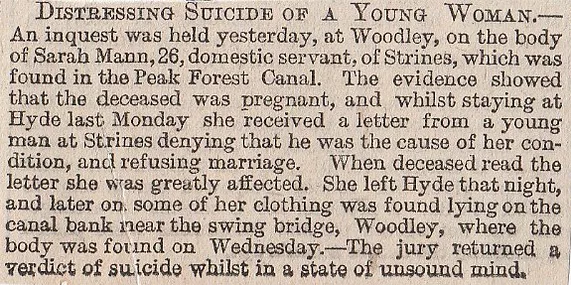
156/ York Street, Edgeley, Stockport, (Miracle Cure Side-Effects) January 1885
George Henry Barlow, a forty-nine-year-old clerk, killed himself by shooting himself in the temple at his house in York Street, Edgeley. His wife said he had seen an advert for a medicine that “reduces corpulency”. He bought some and he lost nearly five stone, but his nerves became frail and this was the cause of his self-destruction.
157/ Hulme Child Murder, November 1885
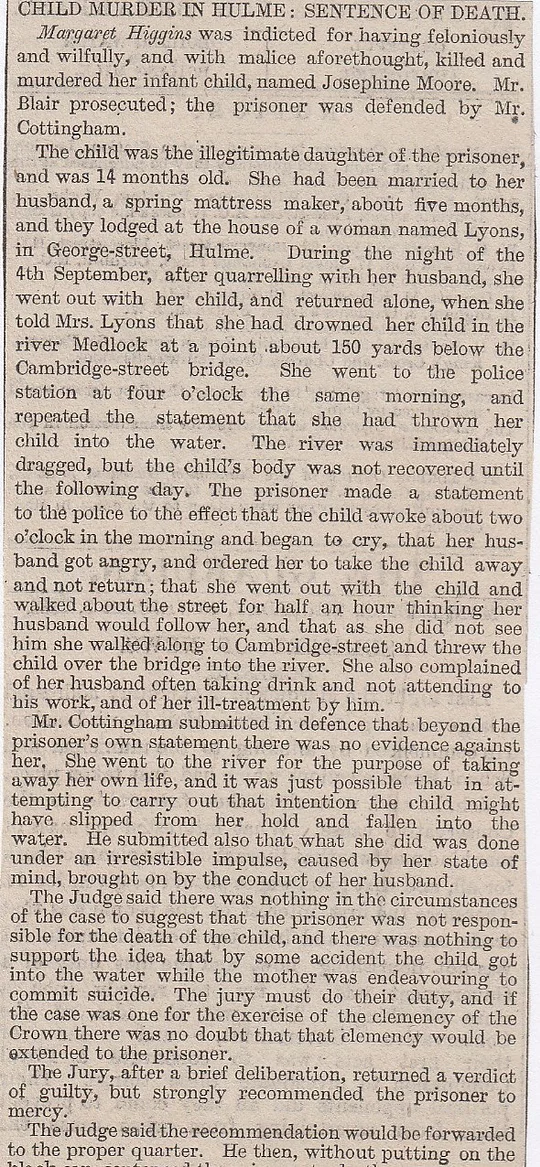
black cap, sentenced prisoner to death. The Court adjourned to this morning.
158/ Sandy Lane, Stockport, (Fatal Mill Fire) December 1885

159/ Stalybridge Pub Suicide, Tameside, December 1895
Linton Ives, a professional singer, went into a pub at Stalybridge and killed himself by drinking an amount of opium. He had been a soldier, then a baritone singer of good renown, and was now in the Livermore troupe of minstrels. (What pub was it?)
160/ Near Smallshaw Bridge, Tameside, (Railway Death) August 1885
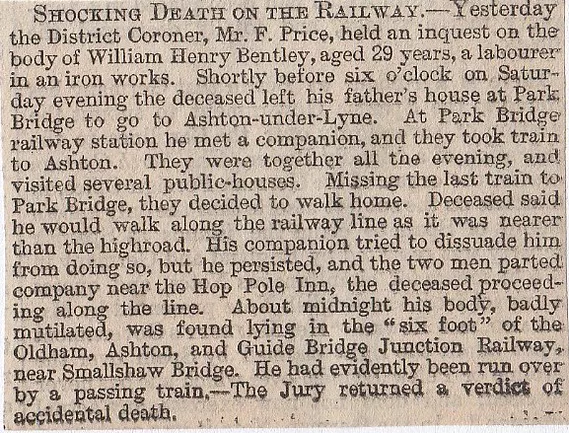
161/ Stalybridge Mineshaft Suicide, February 1855
An innkeeper named Edward Lilly from Stalybridge killed himself by walking to a coal-pit and falling backwards into the mine shaft, around a 100 yards deep. His business was on the rocks and his drinking had got heavier and suicide was suspected of him, as he mentioned it beforehand.
162/ Miles Platting, (Railway Death) October 1885
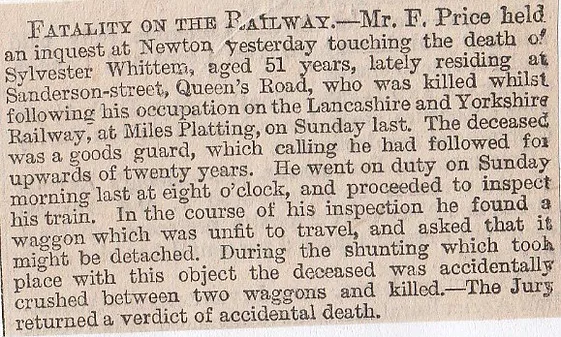
163/ Fairfield Infanticide, Tameside, December 1885
An inquest was held an inquest on the body of a newly-born male child found in the Manchester and Ashton Canal at Fairfield. A piece of twilled sheeting was tied tightly with a piece of tape around the child’s neck and the loose part of the sheeting thrown over its head. Post-mortem testified that death was from strangulation and a verdict of wilful murder against some person or persons unknown.
164/ Hulme Hall Road, Trafford, (Canal Drowning) June 1885
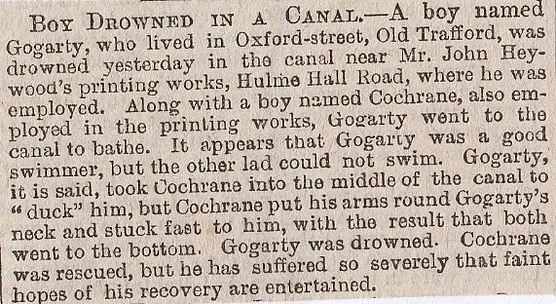
165/ Altrincham Fatal Accidents, November 1885
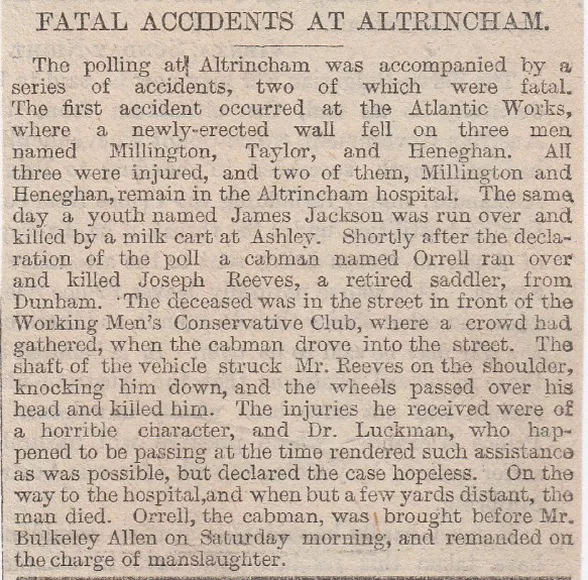
166/ Bolton Druggists Explosion, (Three Dead) July 1866
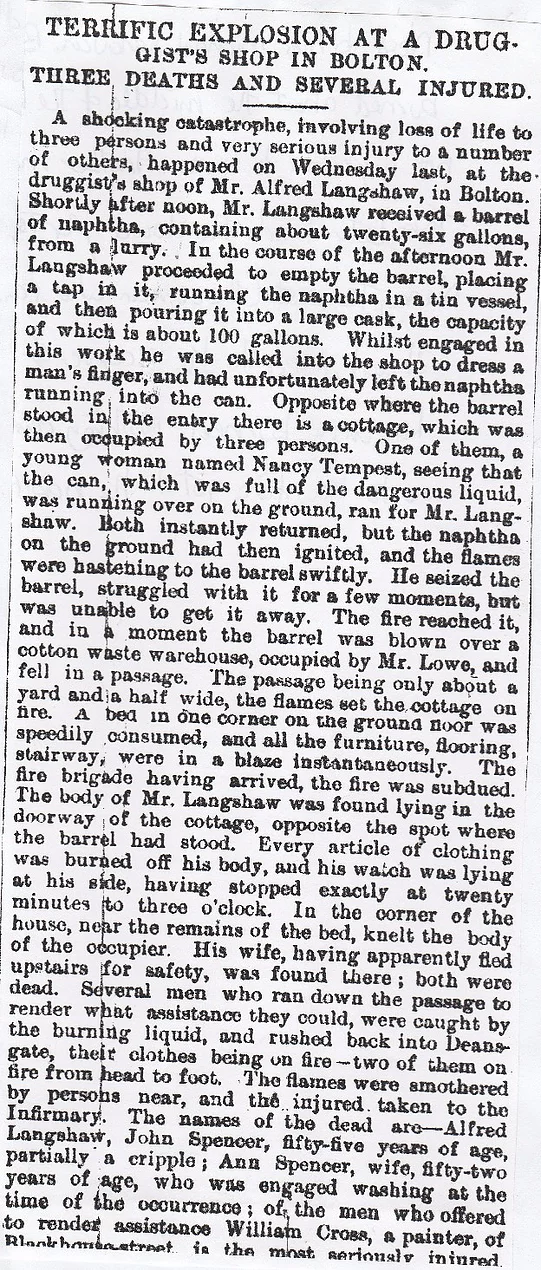
Next to him Michael Canavan. Both are badly burned about the middle of the body, Cross is not expected to live.
167/ Bolton, (Machinery Death) September 1885
On Monday an engine minder named Amos Yates aged thirty-three, of Tonge, employed at Toothill Bridge Bleach Works, Breightmet, was loosening a crank when the key slipped and he fell into the wheel pit and was carried around by the fly-wheel several times and he was quite dead when the engine was stopped.
168/ Bolton, (Abandoned House Suicide) October 1885
An inquest on the body of Thomas Bailey aged thirty-three, who worked as a newsagent. He was troubled owing to financial difficulties, went to Manchester on Friday, then returned to Bolton during the day but did not go home. Early next morning he was found in an unoccupied house, hanging from a rail. He had climbed through the back window, adjusted the cord and jumped from a pair of steps after tying his hands together.
169/ Rothwell Reservoir Fatality, Bolton, December 1885
On Sunday afternoon James Yates, a piecer, eighteen-years of age, of 10, Howard Street, Bolton, was skating on the Rothwell Reservoir between one and two o’clock. The ice being unsound it broke. Yates was immersed in the water and drowned. The reservoir is connected with the bleachworks of Messrs T.Cross and Co, Mortfield and is a dangerous place for skaters, the water being constantly drawn from underneath the ice for bleaching purposes.
170/ Knowles Mill, Bolton, November 1885
At the mill of Messrs.G.Knowles and Sons, Bolton, William Smith, the engine tenter, living at 94, Waterloo Street, heard the engine making a peculiar noise. He was proceeding to shut off the steam when the crankshaft broke and the piston drove out the end of the cylinder. The place instantly filled with steam and Smith was so badly scalded that he died soon after. The mill will now be stopped for a fortnight, throwing 225 hands out of work.
171/ Halliwell Child Murder/Suicide, near Bolton, April 1885

172/ Farnworth, (Ice Accident) January 1885
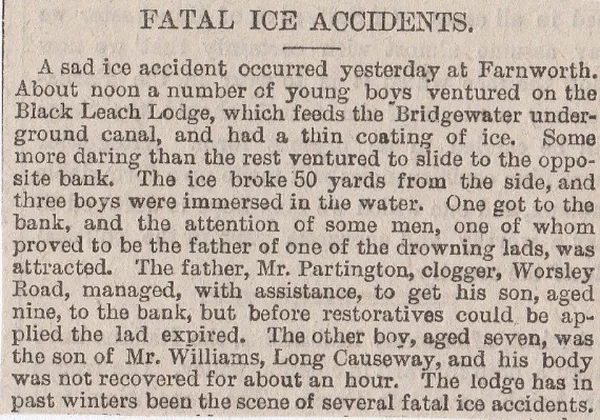
173/ Bury Ice Fatality, January 1885
On Wednesday evening Frederick W.Wyer, about nine years old, was sliding upon the ice on a lodge of water belonging to the Bury Papermaking Company, Gigg Mills, with two other boys when the ice broke. He fell in and was drowned. Although he sank only two yards from the edge his body was not recovered for two hours.
174/ Ainsworth, (Fatal Wrestling) August 1885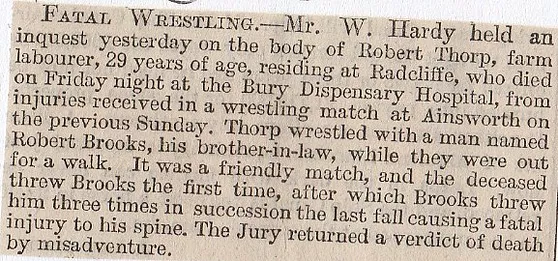
175/ Radcliffe Suicide, August 1885

176/ Oldham, March 1885
James Taylor, an engineer at the Textile cotton mill near Oldham, met with a dreadful accident. He was oiling the governors attached to the engines when his jacket was caught. His body was drawn between two pinion wheels. He was dreadfully injured and died almost immediately. The cog wheels were broken and the accident necessitated a total stoppage of the mill machinery.
177/ Oldham Wife Murder, June 5th, 1885
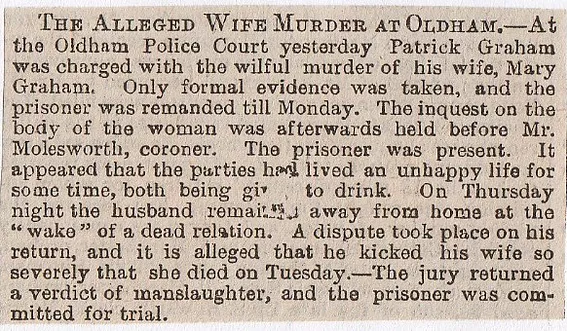
178/ Book Street, Oldham, (Four Children Die) March 1885
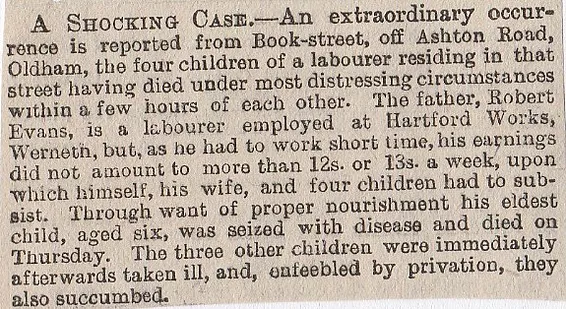
179/ Saddleworth, (Driver Killed) July 1885
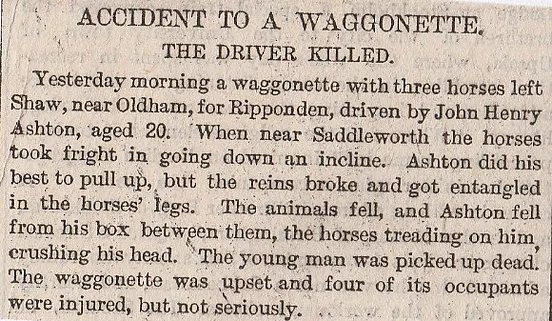
180/ Middleton Junction, December 1885
Yesterday morning the body of a man was seen floating in the Rochdale Canal at Middleton Junction and it was found to be that of Thomas Skellern, master painter and plumber of Middleton, who left home at six o’clock yesterday morning to attend to some business at Middleton Junction. It is supposed that whilst going along the towing path he lost his footing owing to the slippery state of the ground caused by frost.
181/ Hollinwood, (Three Men Killed) May 1885
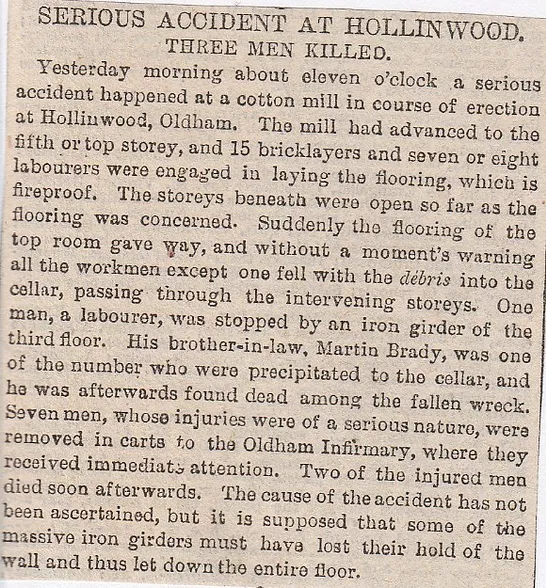
182/ Heywood, Rochdale, (Messy Suicide)January 1894
An Irishman named Freeman was found in the Queen’s Park at Heywood with half his face blown away with a shotgun. The blunderbuss was found nearby and pieces of his skull were fully forty yards away. Brain matter was also discovered some distance away. He was a native of Ballina, where his widow and kids still reside.
183/ Smithy Bridge Suicide, near Rochdale, January 1885
The body of Abraham S. Wild, a flannel merchant from Wardle near Rochdale had been missing since the 8th of December. His body was found on Wednesday evening in the Rochdale Canal at Smithy Bridge. There were no marks of violence upon the remains.
184/ Castleton Child Murder, February 1885
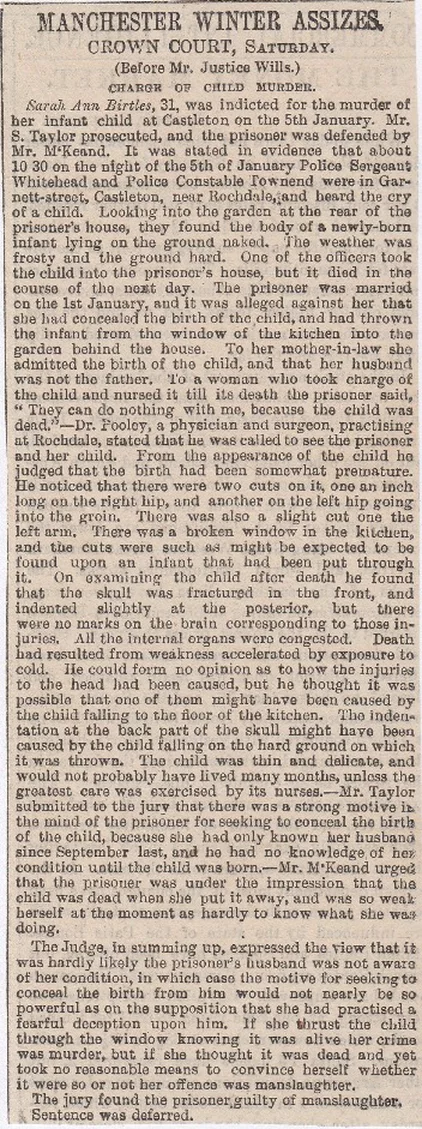
185/ Rochdale, (Fatal Joke) July 1885
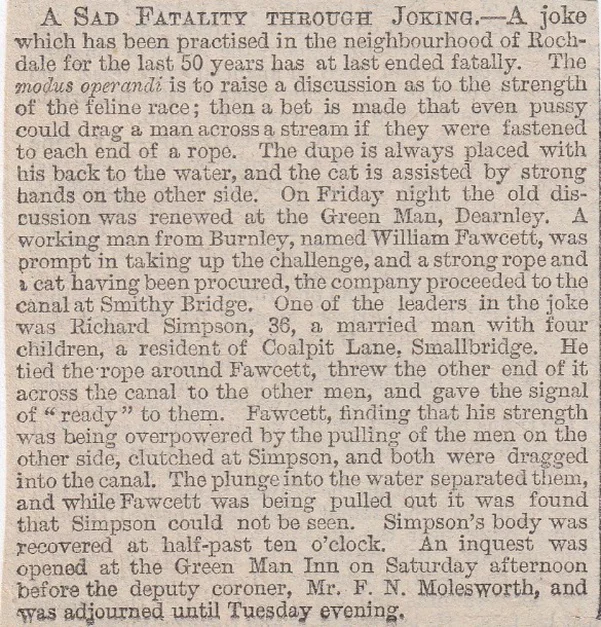
186/ Greenfield, (Two Lads Drowned) July 1885
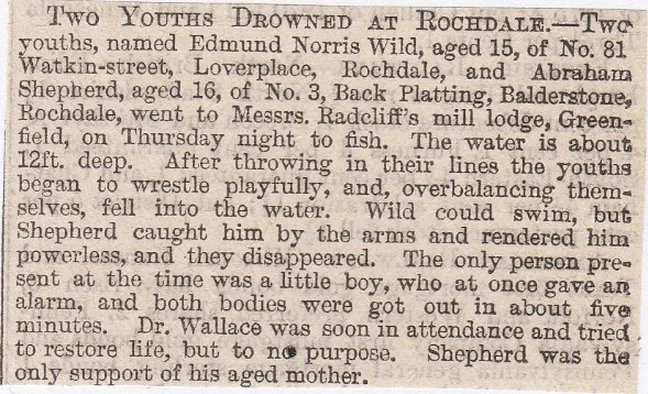
187/ Strangeways Hall Colliery, near Wigan, (Fatal Explosion) February 1885
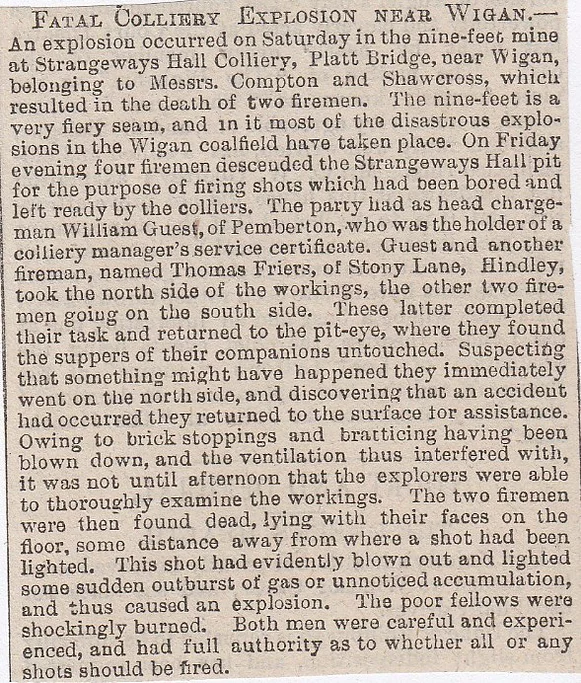
188/ Winstanley Hall Fatality, near Wigan, August 1885
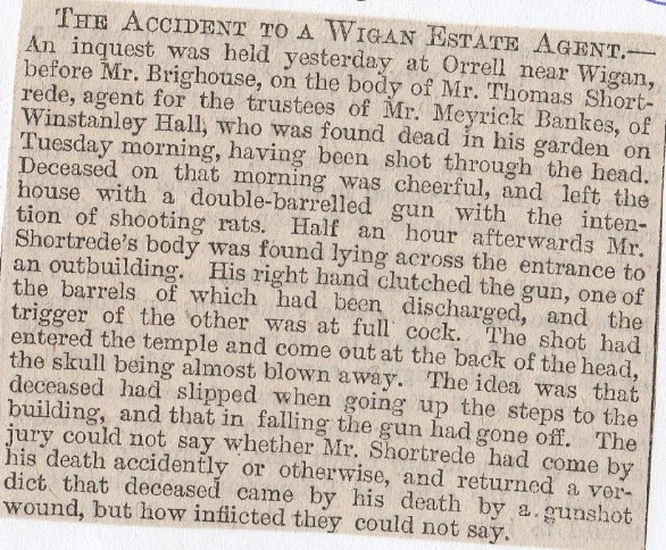
189/ Bradford Colliery Fatality, Manchester, April 1899
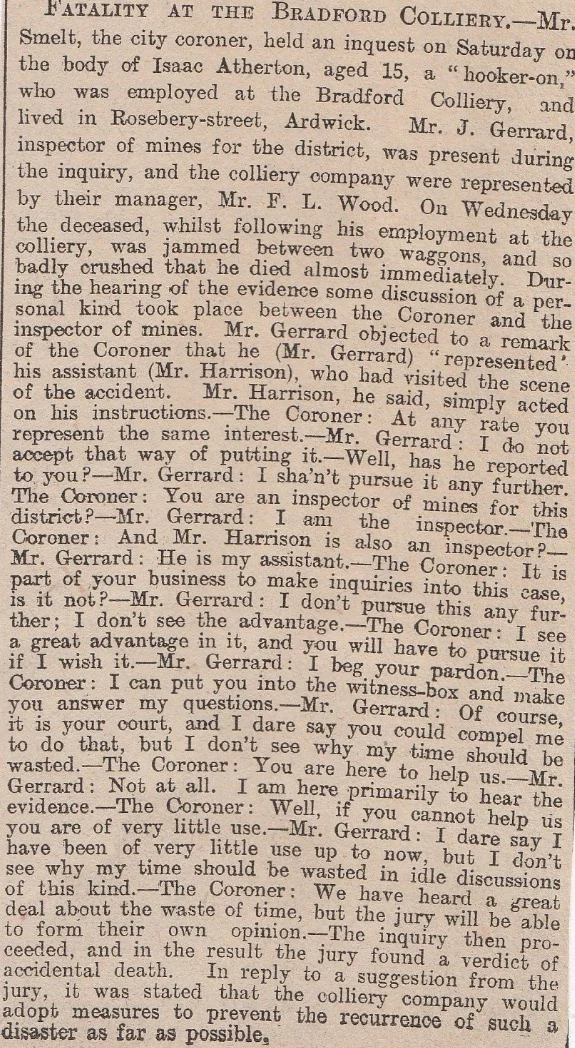
190/ Milton Street Triple Murder, Bury, December 1884

191/ Train Suicide, Manchester. July 1870
On Friday an inquest was held at the Oxford-road Inn, Manchester, on the body of Mr. E.T. Heslop, of Sale, stock and share broker, formerly a member of the Stock Exchange, Manchester, who shot himself in the forehead while travelling in a train on the Manchester, South Junction, and Altrincham Railway between Sale and Stretford stations on the previous day. Financial difficulties had preyed heavily on the mind of the deceased, and the jury returned a verdict to the effect that he shot himself in a fit of temporary insanity.
192/ Boothstown (Sunstroke Death) July 1870
During the oppressive heat of Tuesday a girl, three years of age, the daughter of Mr Crompton, of The Greyhound Inn, Boothstown, near Bolton, was seized with sunstroke and died immediately afterwards. Several persons have fainted in the harvest field near Warrington from the extreme heat, but they have since recovered.
193/ Little Lever, September 1870
During a severe thunderstorm which passed over the neighbourhood of Bolton on Tuesday afternoon, a travelling pedlar, named John Morris, was struck by lightning and instantly killed, in Marsh Fold Lane in Little Lever.
194/ Orrell Station (Tunnel Deaths) September 1870
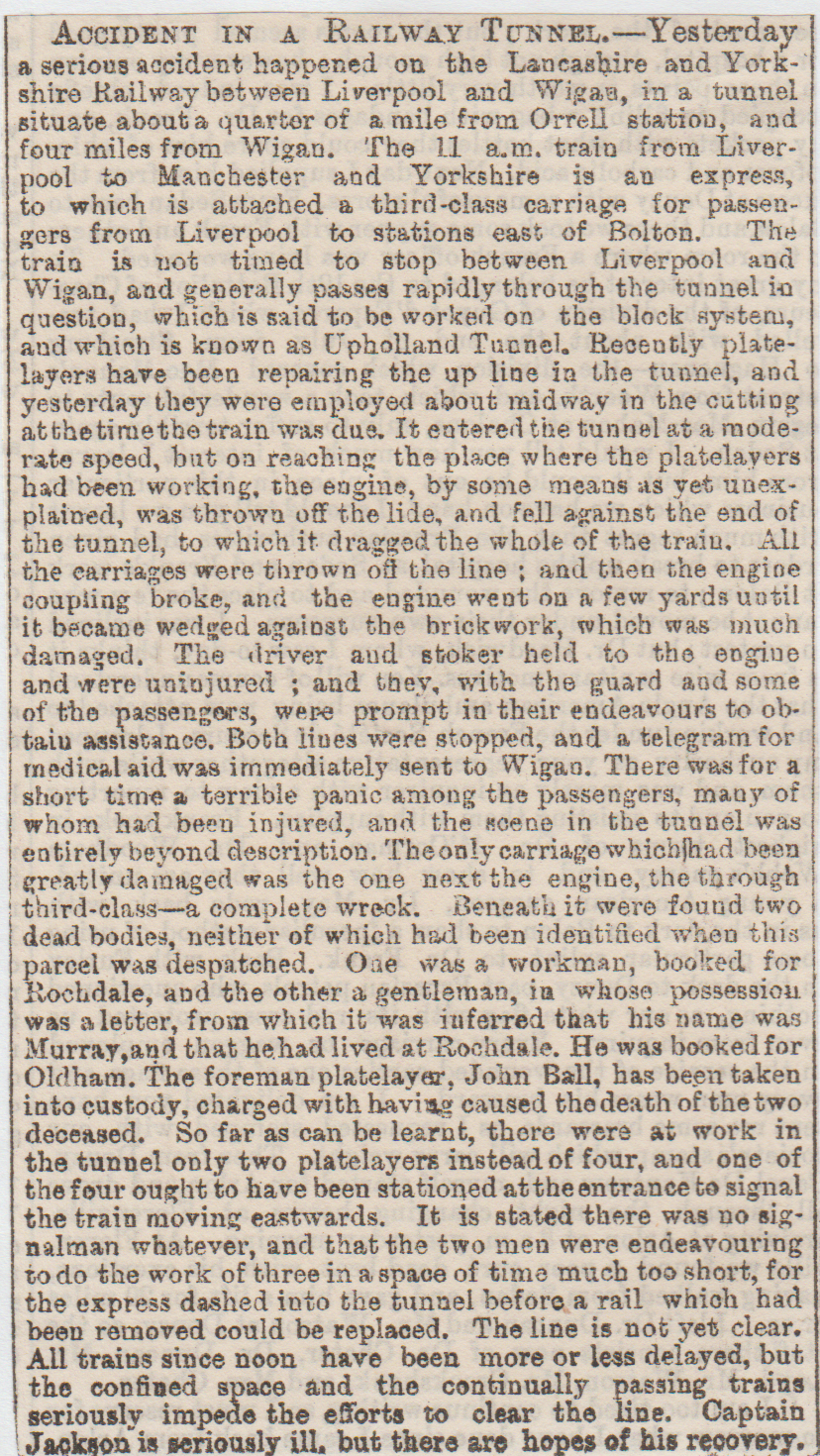
195/ Portugal Street, Manchester (Weaving Shed Collapses) September 1870
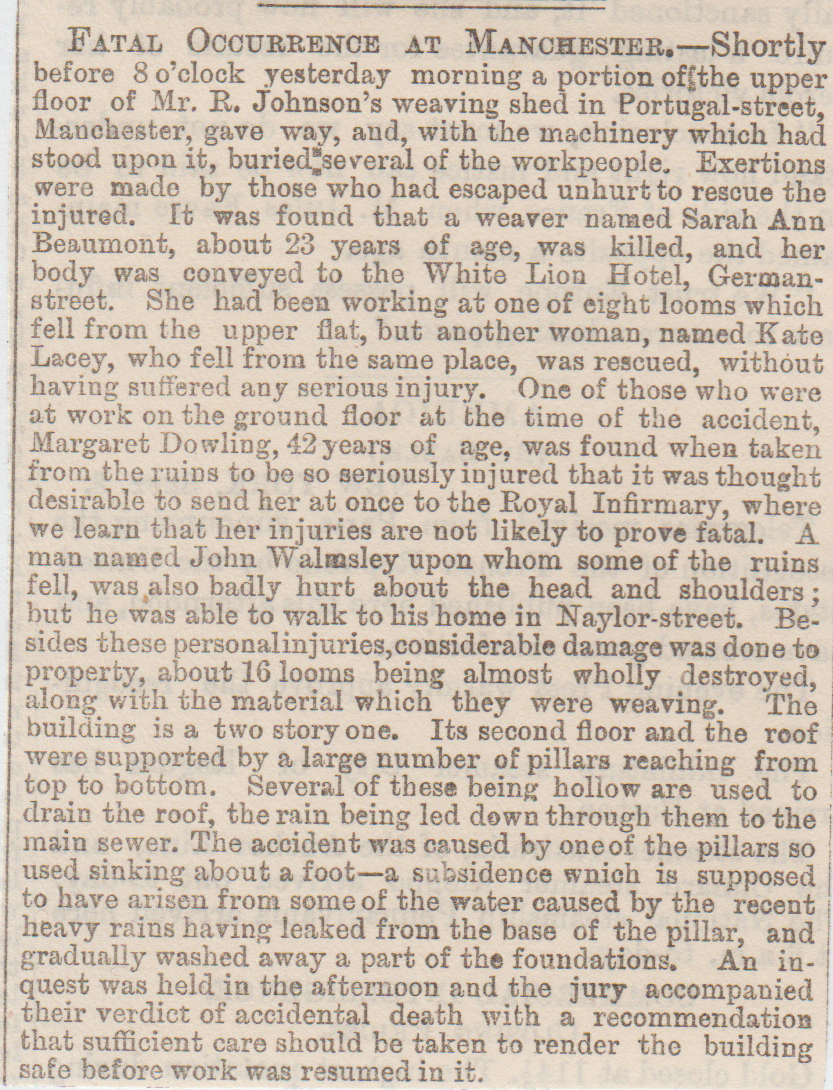
196/ Alexandra Music Hall Accident, September 1870
An accident occurred on Monday night by which a dancer was severely burnt, at the Alexandra Music Hall, in Peter Street, Manchester. A new ballet had just been performed for the first time, and a set scene towards its close was being completed by raising Miss Lucelle, the leading danseuse, into view in the centre of the tableau, when the support on which she stood slightly lurched, and she fell forward upon a row of gas jets, by which her muslin dress was at once ignited, and she was severely burnt. She was conveyed home in a cab.
197/ Openshaw (Three Children Killed) August 1870.
On Thursday night, three children were killed in Openshaw, near Manchester, by a singular accident. Five children were playing in a large sand-hole near the railway works, when the side fell in and totally buried three of them-namely Hannah Timperley aged ten; William Wild, aged seven and Thomas Owen, aged four. The other children, one of them a brother of the boy Wild, were also partially buried, and so much injured that they were not able to get themselves out or raise an alarm for nearly an hour. Some little time elapsed before the buried children were recovered, and then they were all dead.
198/ Manchester Fatal Shooting, September 1870.
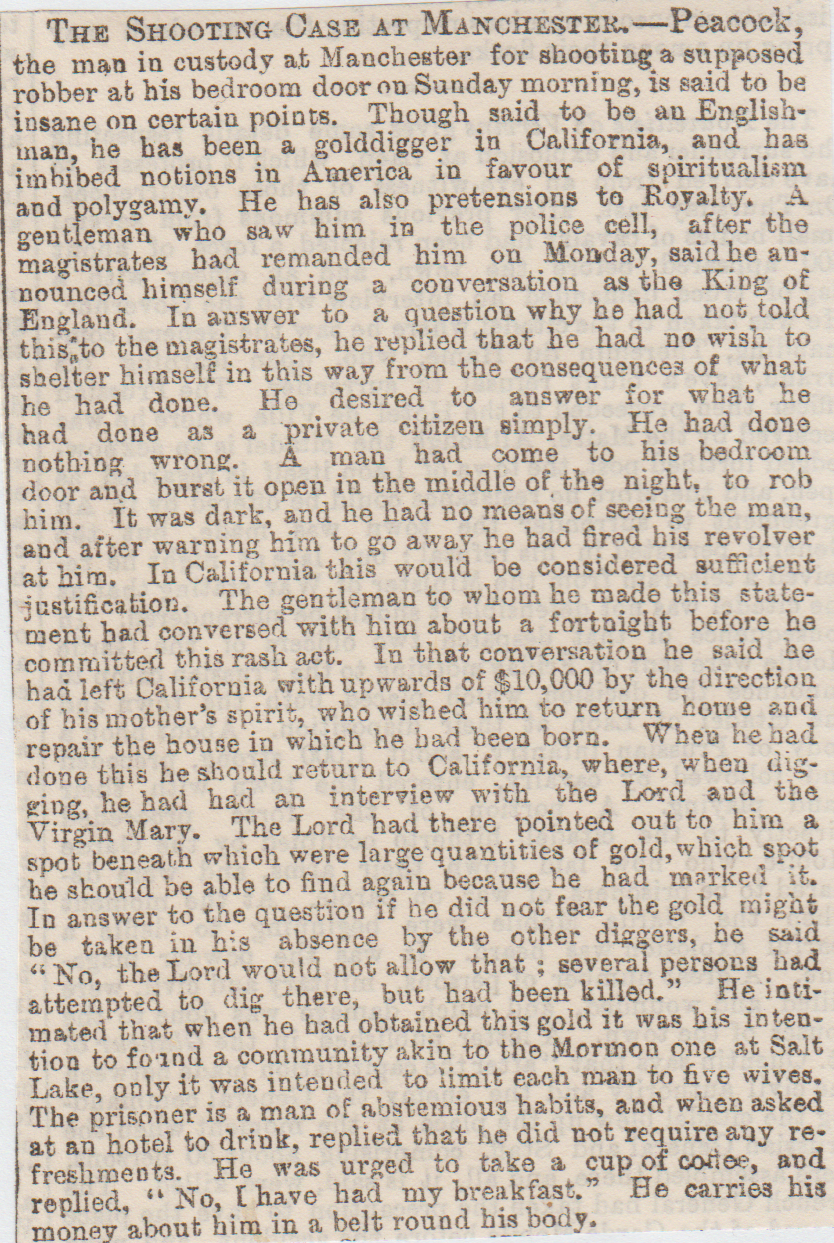
199/ Pendleton Colliery Fatality, Salford. August 1870. (Engine driver named William Cooper got drunk and fell asleep while at work. Thomas Collinson tried to jump free when Cooper was awoken and put the cage in motion but was crushed beneath the cage. Cooper was put on trial for manslaughter. He got three months imprisonment)
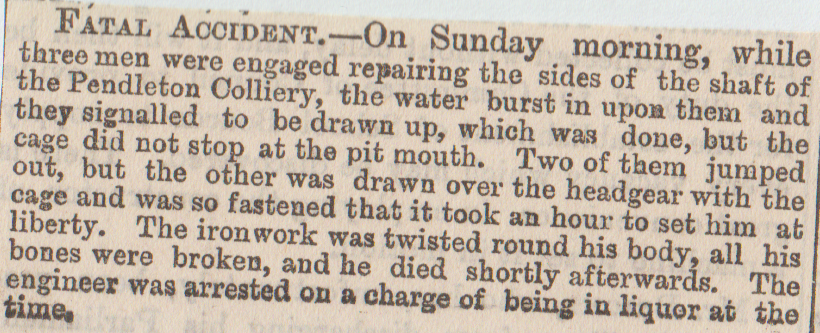
200/ Brynn Hall Colliery Explosion, near Wigan. August 20th, 1870

Brynn Hall Colliery Explosion August 25th, 1870. (The final death toll was twenty)
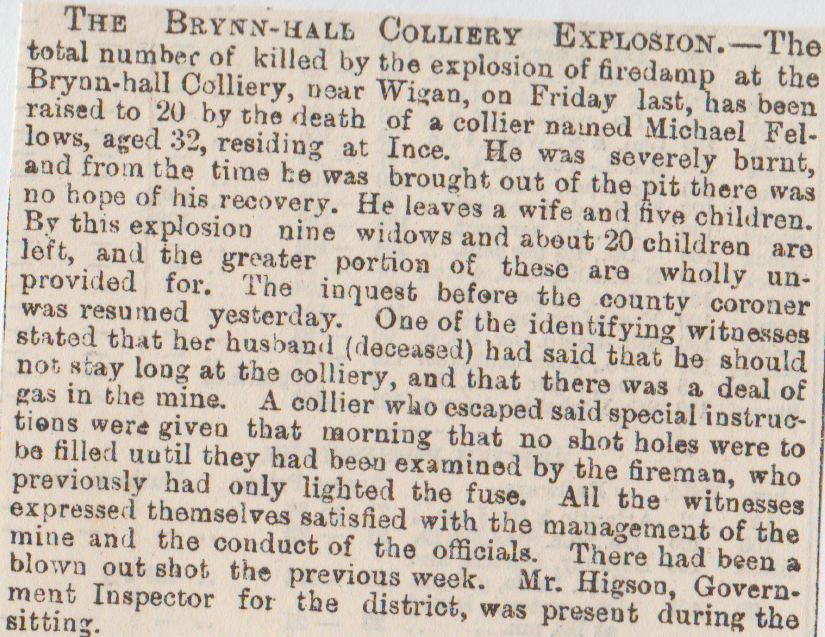
201/ Salford Wife Murder, November 1870
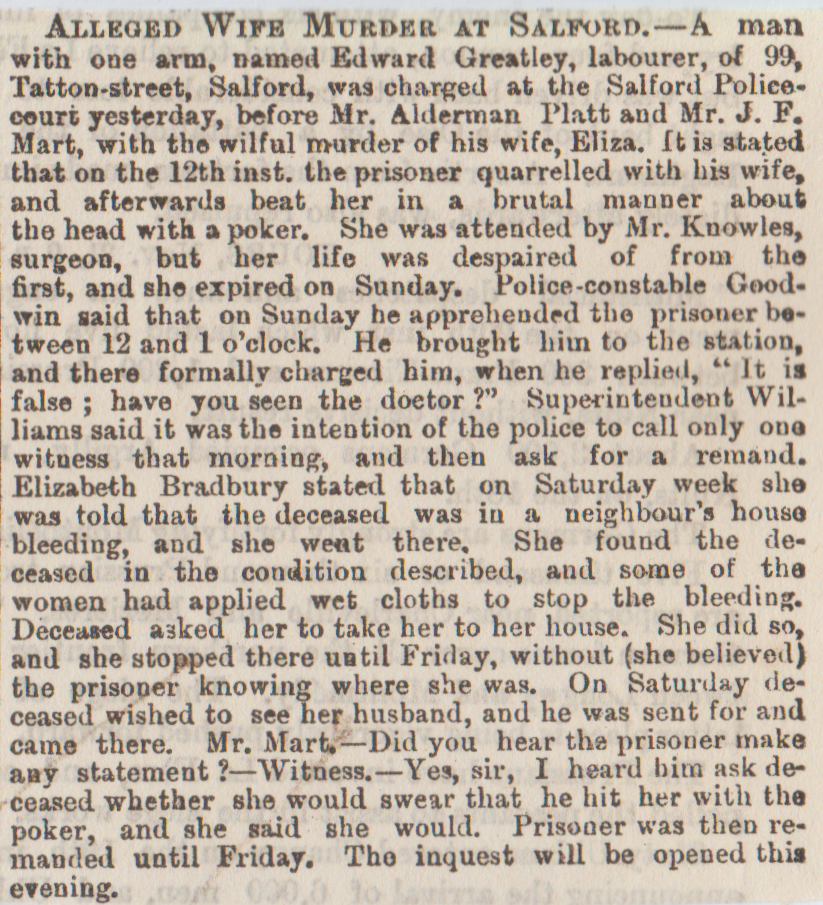
December 8th, 1870 (The Verdict)
Edward Greatley was charged with the murder of his wife at Salford on November 12th. The prisoner and his wife were heard arguing on the day in question, and the woman was seen to come out of the house with her nose bleeding and a severe wound on her head. She went to a neighbour’s house where she died on the 20th of November. It is alleged the wounds were caused by a poker. Evidence was circumstantial, except a statement made by the deceased, which the prisoner contradicted at the time it was made. Mr Justice Brett, in summing up, said this was not a case in which the jury could, according to law, reduce the crime to manslaughter. It was either murder or not guilty. They consulted together, without leaving the box, and returned a verdict of Guilty. The judge then sentenced him to death in the usual solemn form.
202/ Withington Wife Murder, December 1870.
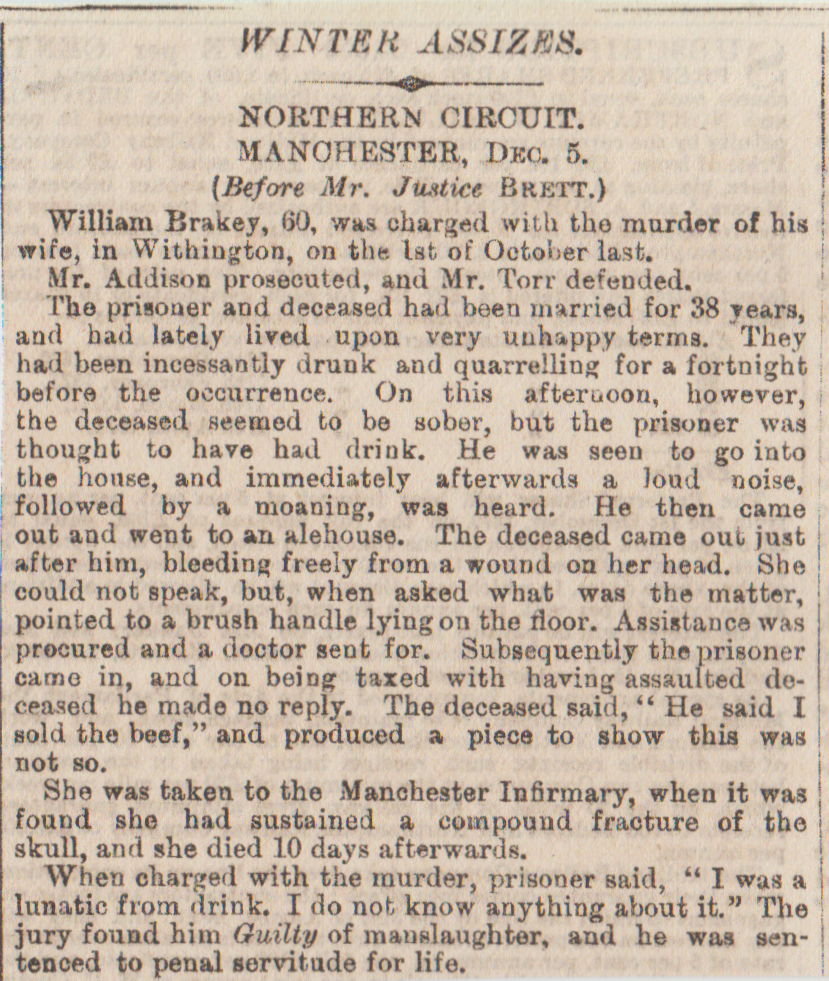
203/ Winstanley Colliery Accident, December 1870
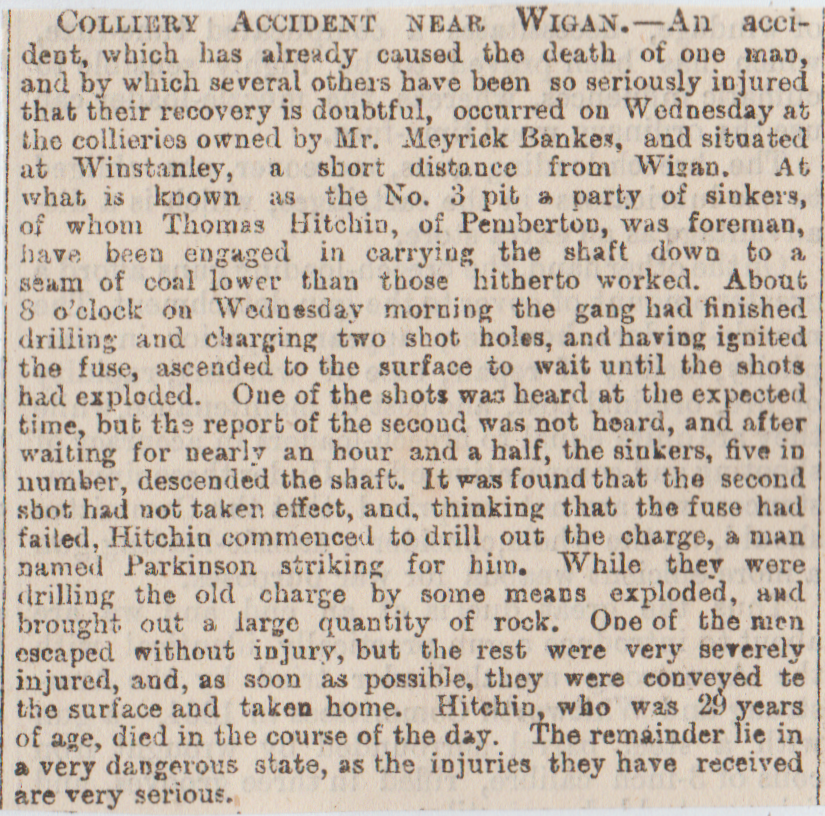
204/ Irlam-o-th’-Heights Murder, December 1870

205/ Wigan Railway Fatality, May 1902.
A fatality occurred on the Lancashire and Yorkshire Railway at Wigan, on Saturday, the victim being Richard Young, aged thirty, of Baldwin Street in Wigan. Young was a goods train guard and was engaged in shunting operations at Wigan Station. It is supposed he was knocked down by waggons and run over. When found he was alive, but so seriously injured that he died soon afterwards.
206/ Oldham Volunteers Attempted Murders, April 1902.
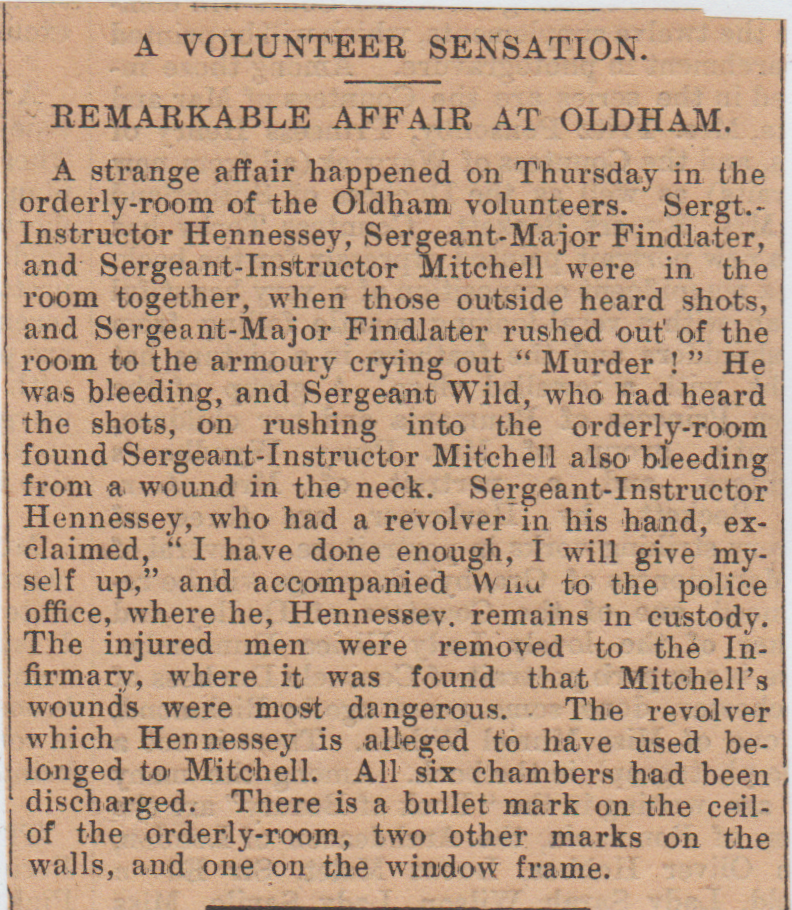
207/ Execution at Manchester (Henry Mack) December 1902
